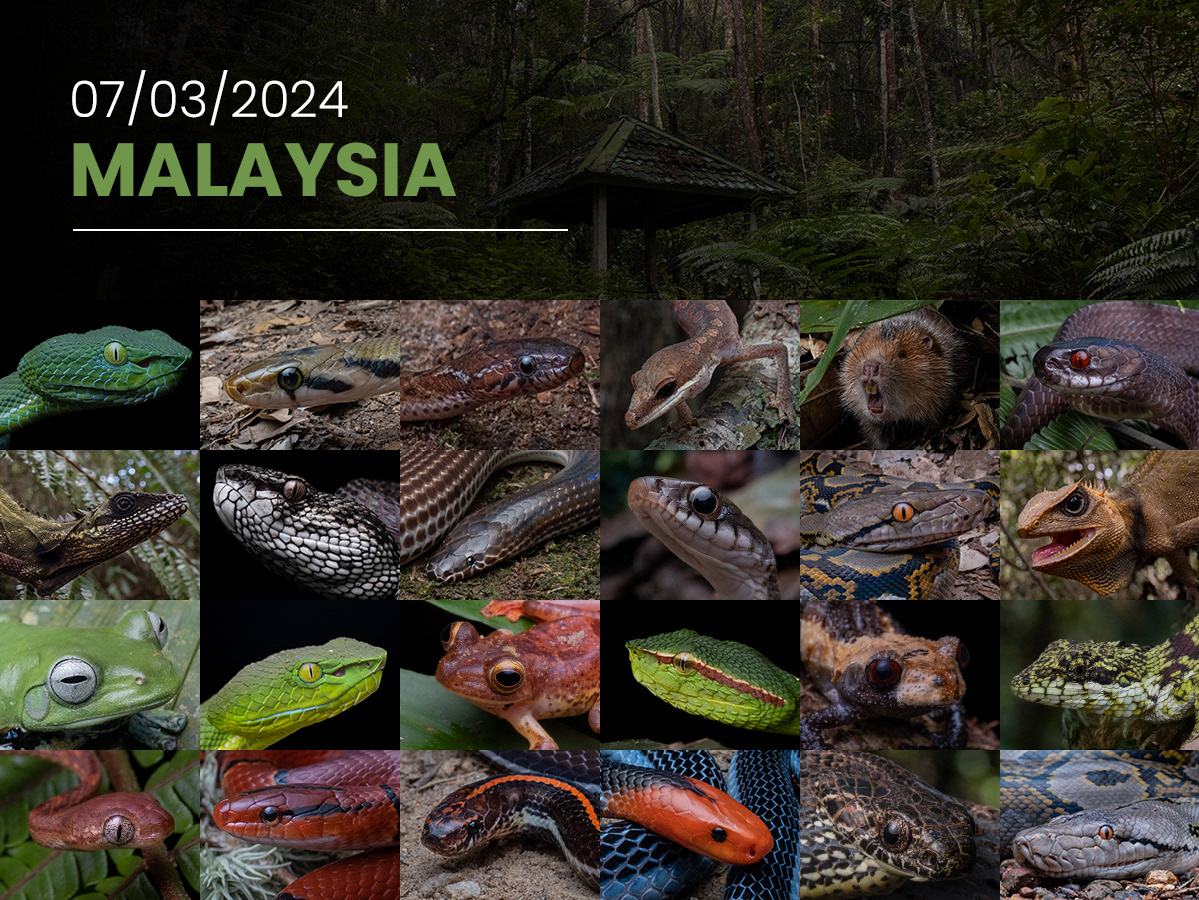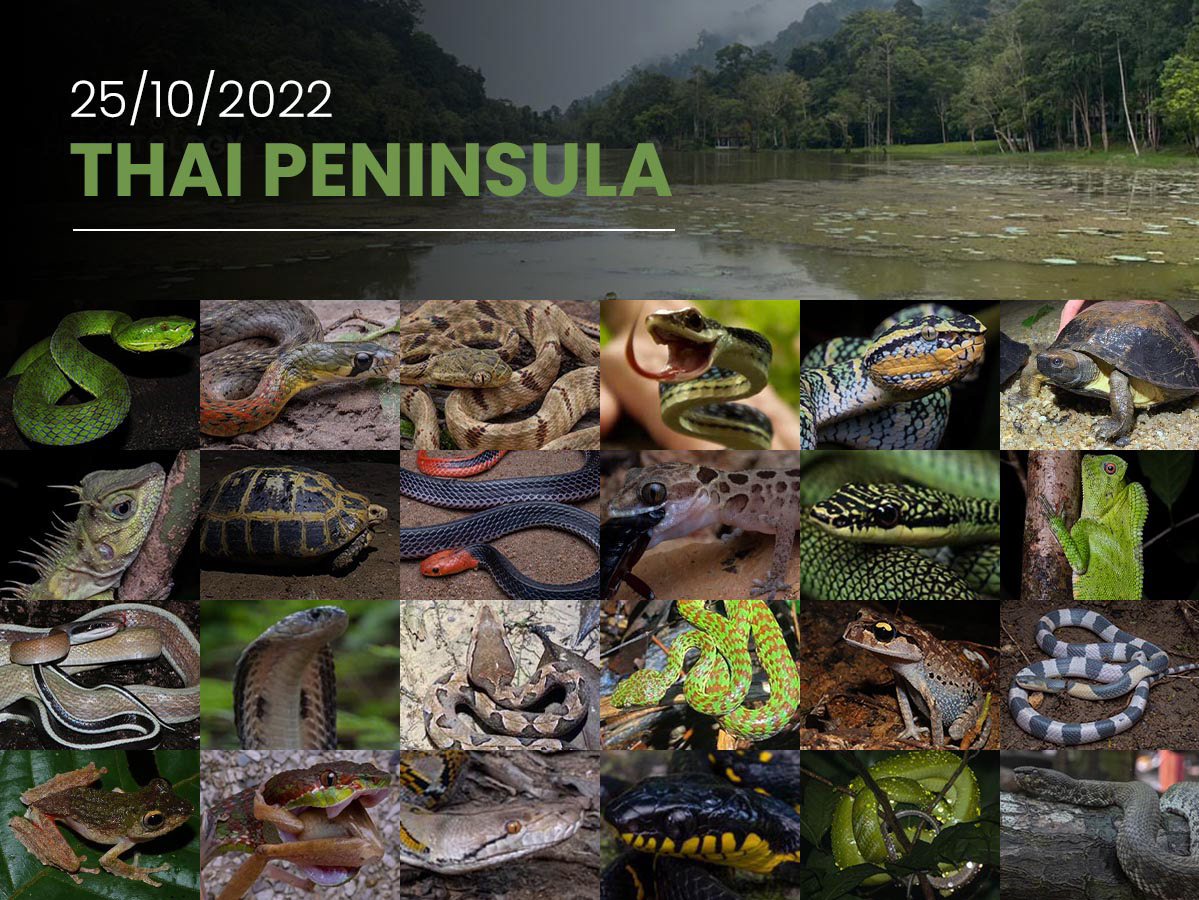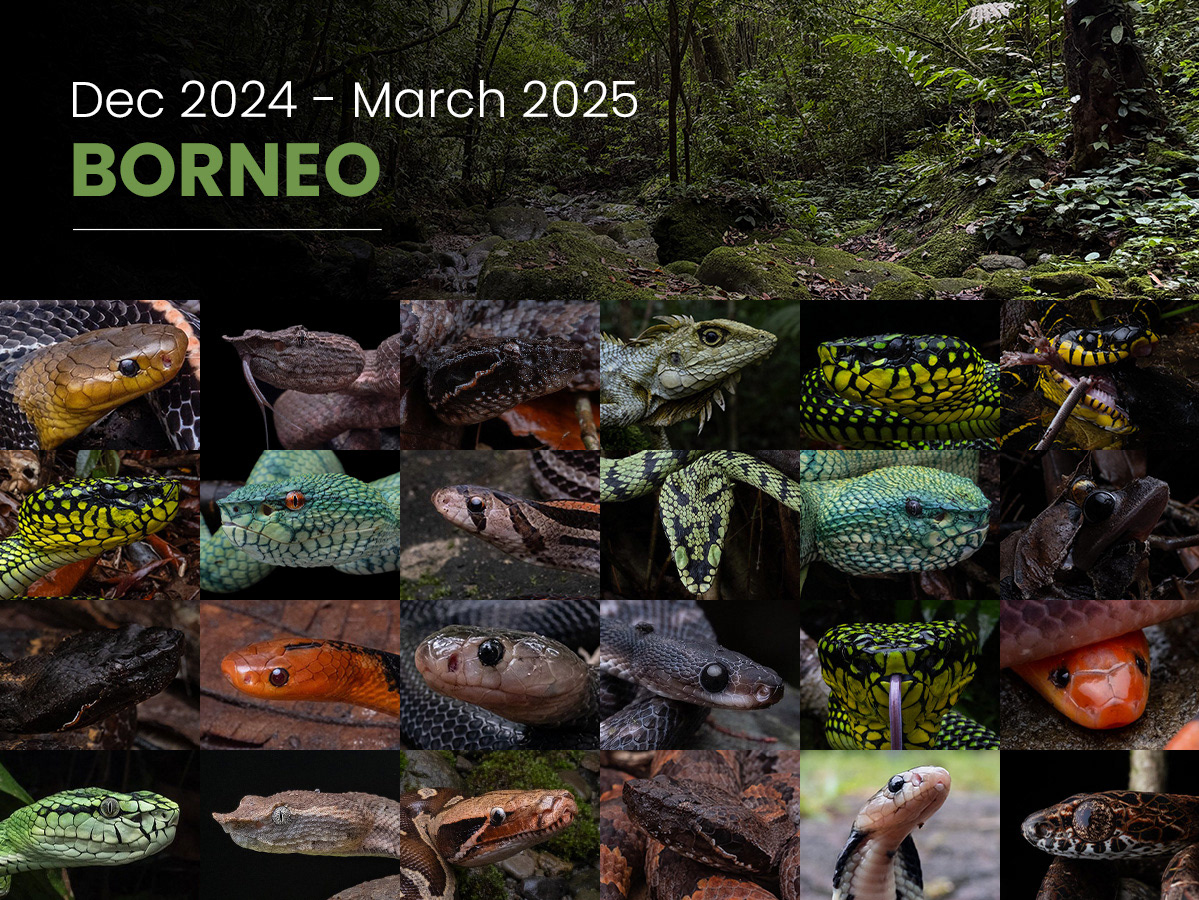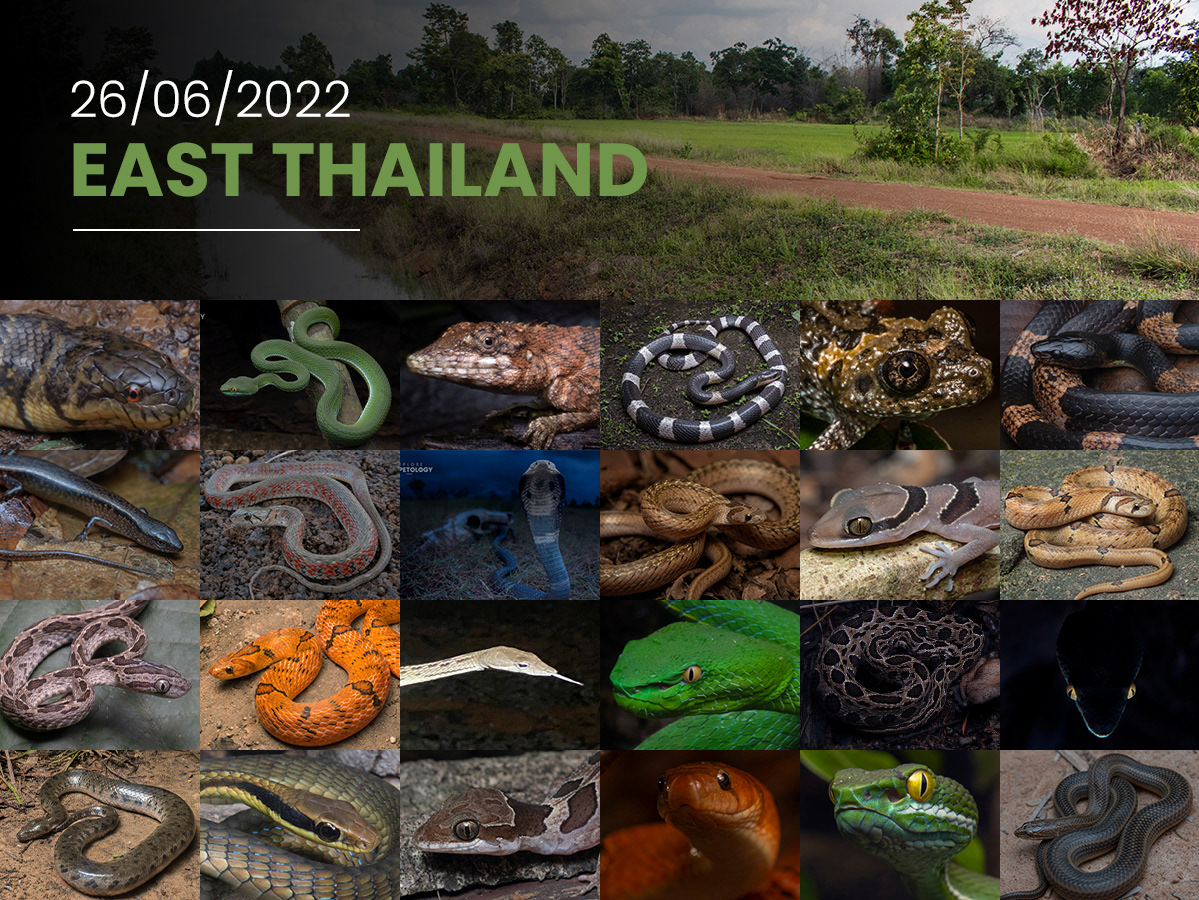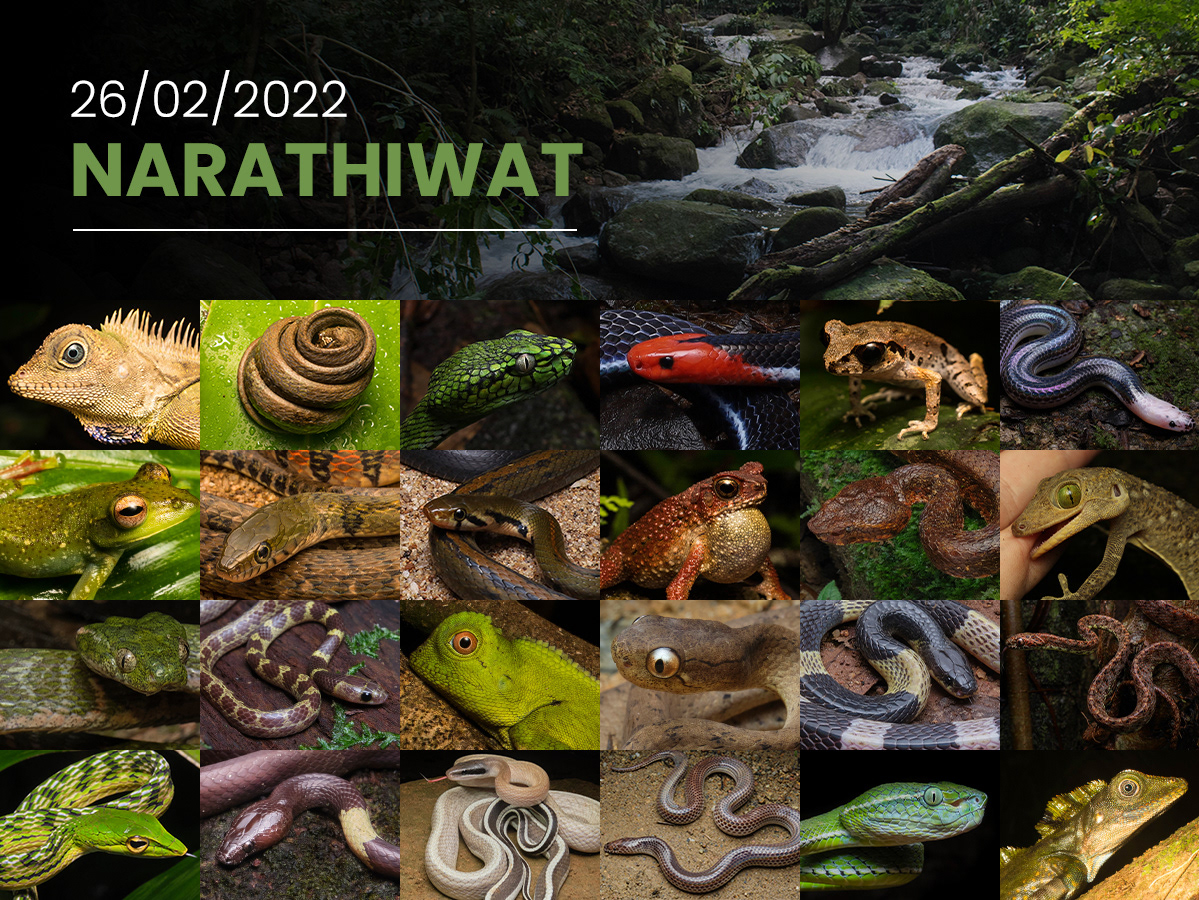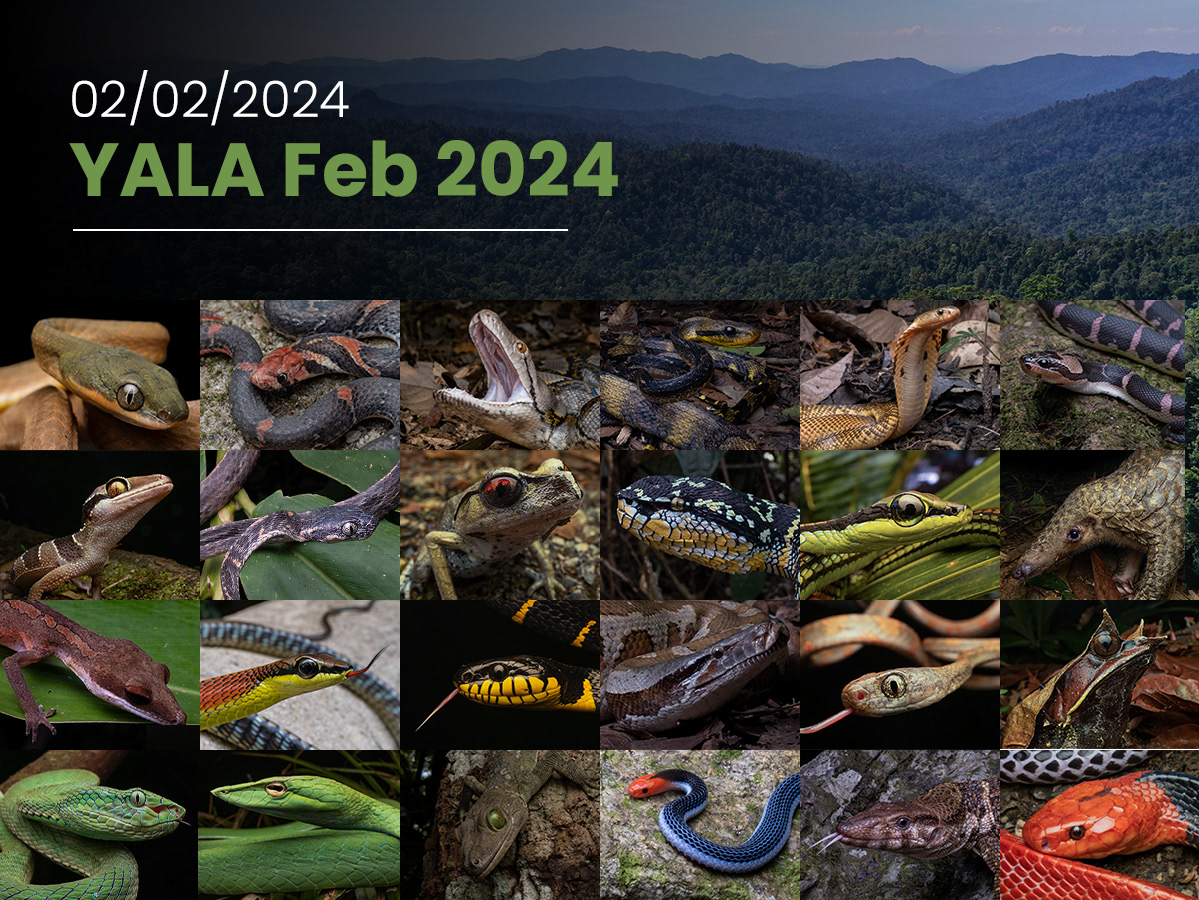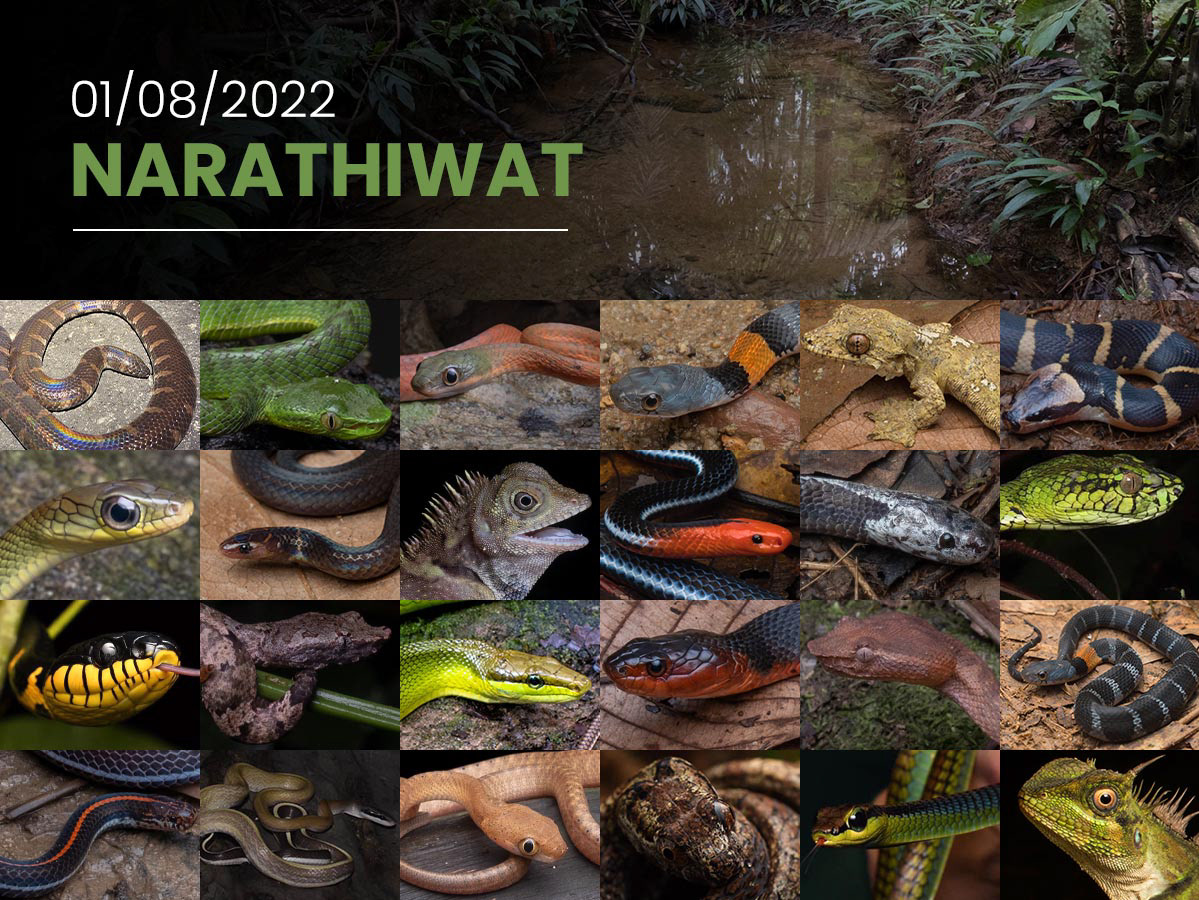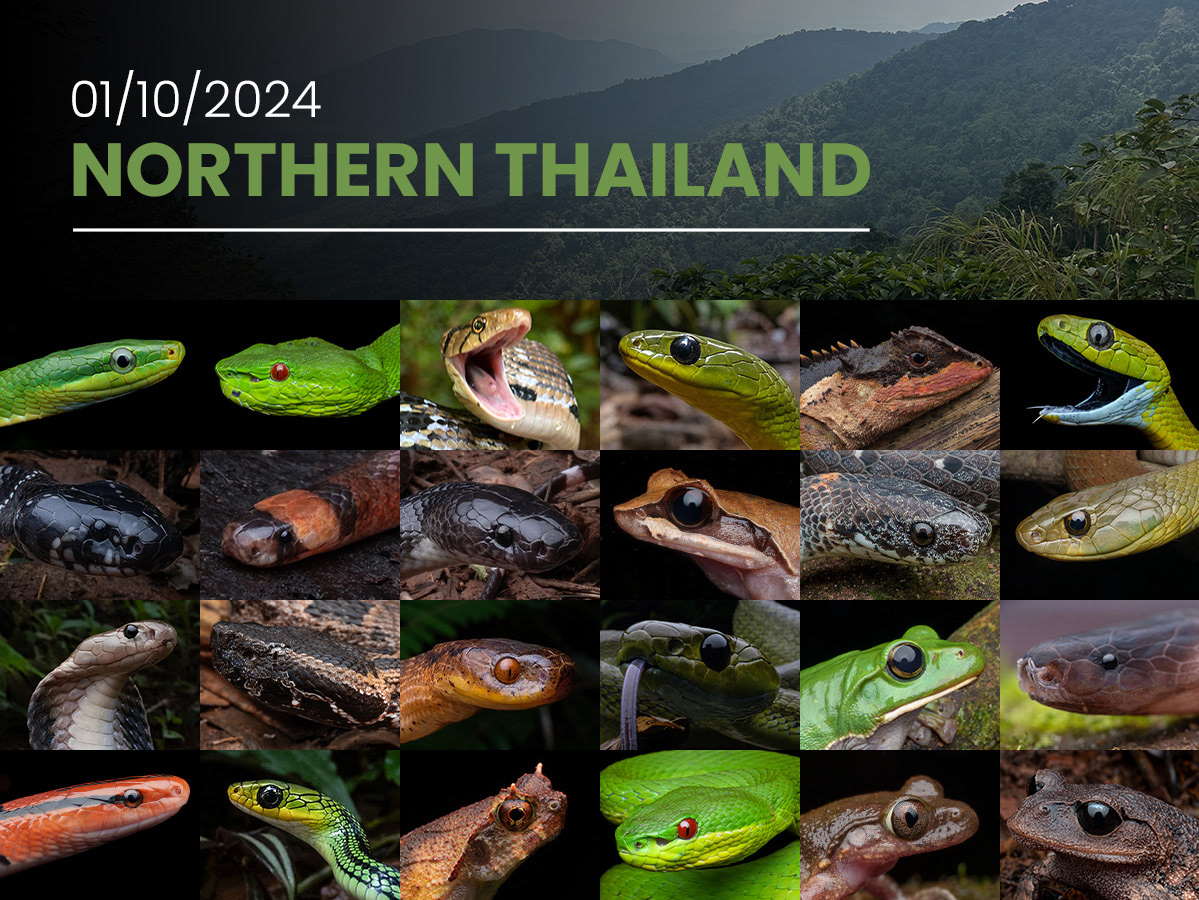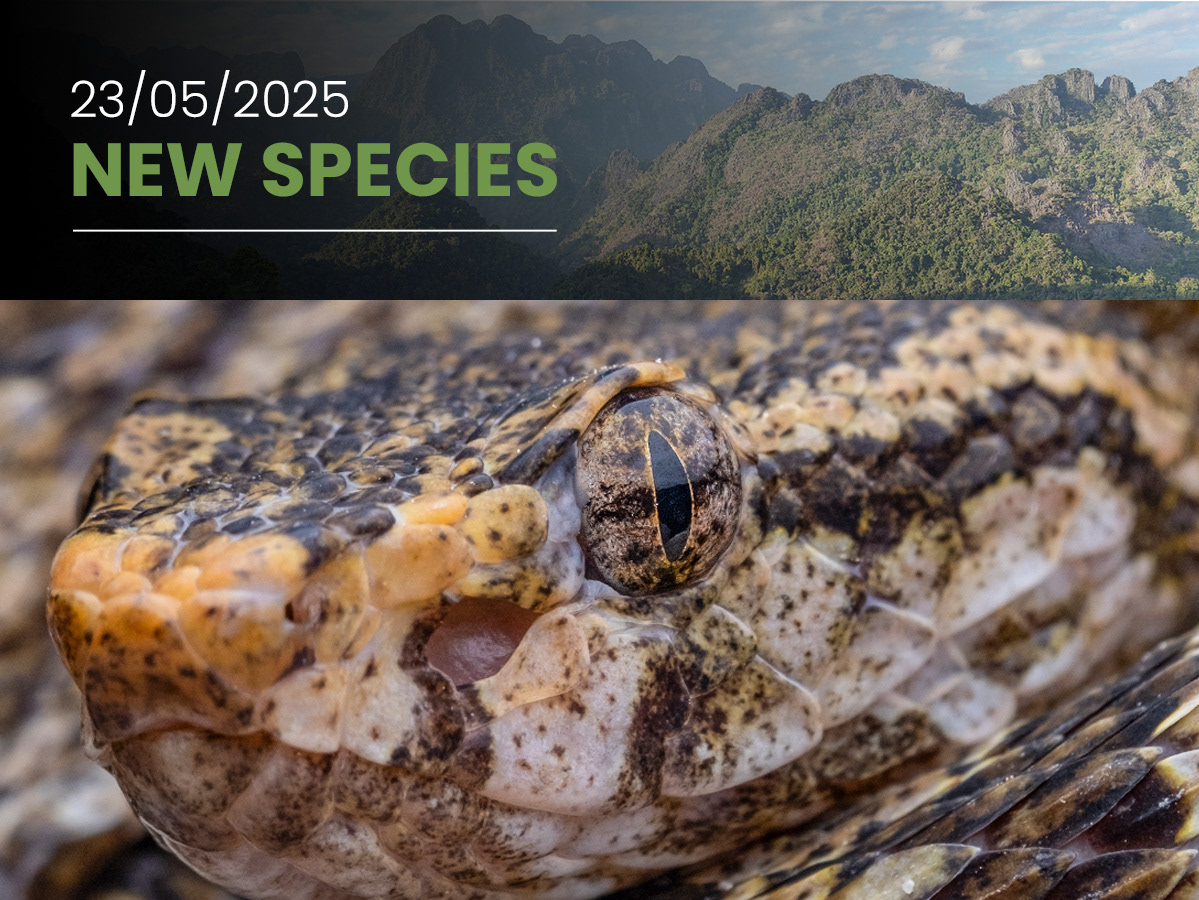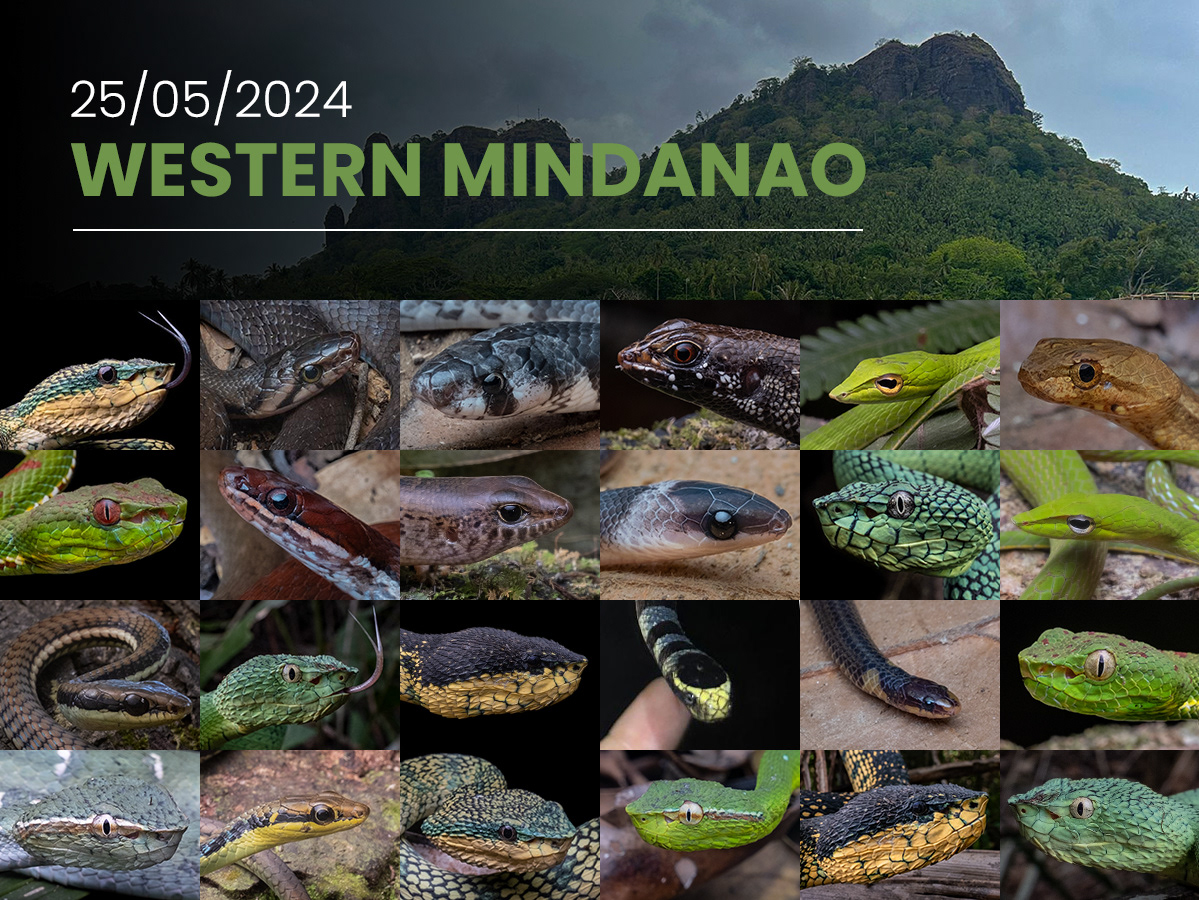Introduction
Explore Herpetology's flagship Thai herping expedition returned in Summer 2024 with an extended 14-day itinerary, scheduled during the peak of rainy season in peninsula Thailand. The group consisted of 10 people from 7 different nationalities. The goal was the surpass 2023's record-breaking haul of 47 snake species, and find as much herpetofauna as possible within the timeframe.
Click here to book Expedition Thai Peninsula 2025!
Phuket (27th - 29th)
The trip began with a 2 nights in Phuket, which had been hit by some extremely heavy rains prior to our arrival. Landslides were rife across the island and parts of the city had been completely flooded. Fortunately, where we were staying was unaffected and the first daytime excursion was not interrupted by rain at any point, despite dark clouds threatening to open up the entire time.
With such damp conditions and relatively 'cold', windy weather, we did not expect to find any snakes during our walk. However, we were treated to our first snake encounter of the trip within minutes when David retrieved a beautiful radiated ratsnake (Coelognathus radiata) from the roof of an abandoned tin hut in a plantation. Aaron also miraculously spotted a Cambodian gliding gecko (Gekko tokehos) which was well camouflaged against the trunk of a large tree. Other species seen included some forest crested lizards (Calotes emma), many-lined sun skink (Eutropis multifasciata) and a juvenile green crested lizard (Bronchocela rayanensis).
Come nightfall, ominous clouds had congregated above the mountains where we would be heading shortly. However, the rain held off and we were able to complete our first walk and remain dry. The best thing seen was definitely the very rare green morph of the speckle-headed vine snake (Ahaetulla fasciolata), already an uncommon species. We also saw a few regular oriental vine snakes (Ahaetulla prasina) and a cinnamon frog (Nyctixalus pictus).
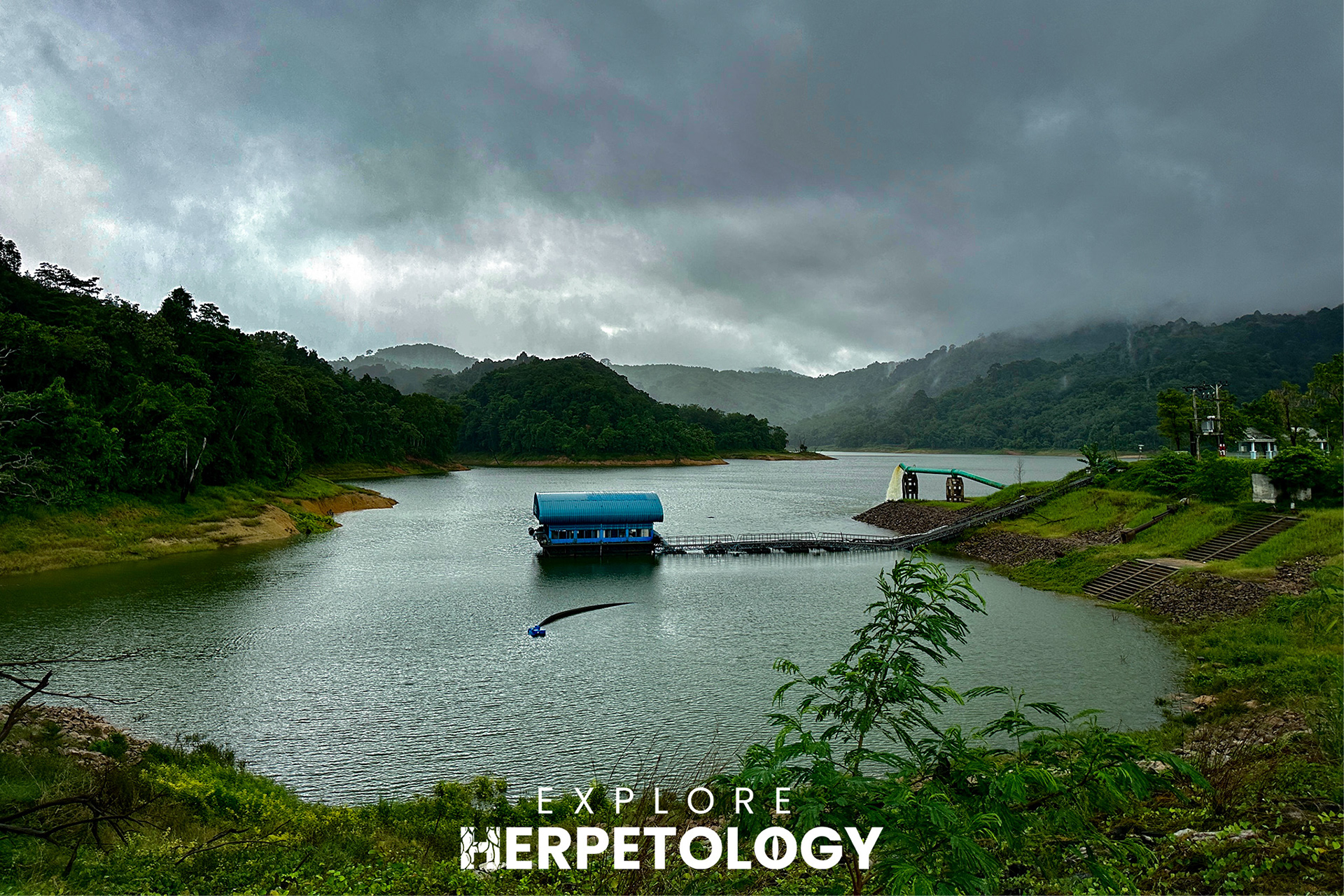
View of our herping location for day 1.
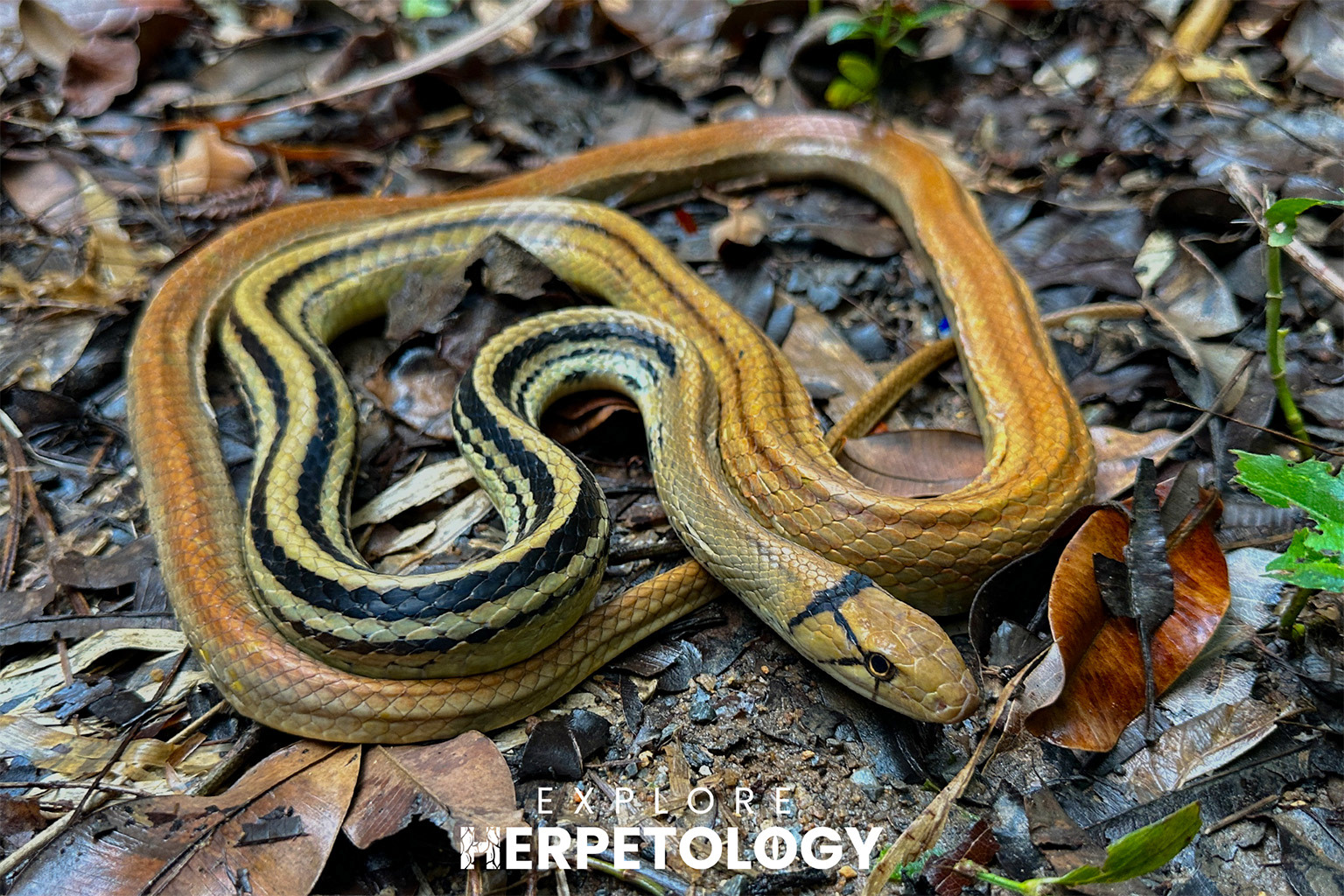
Radiated rat snake (Coelognathus radiata)
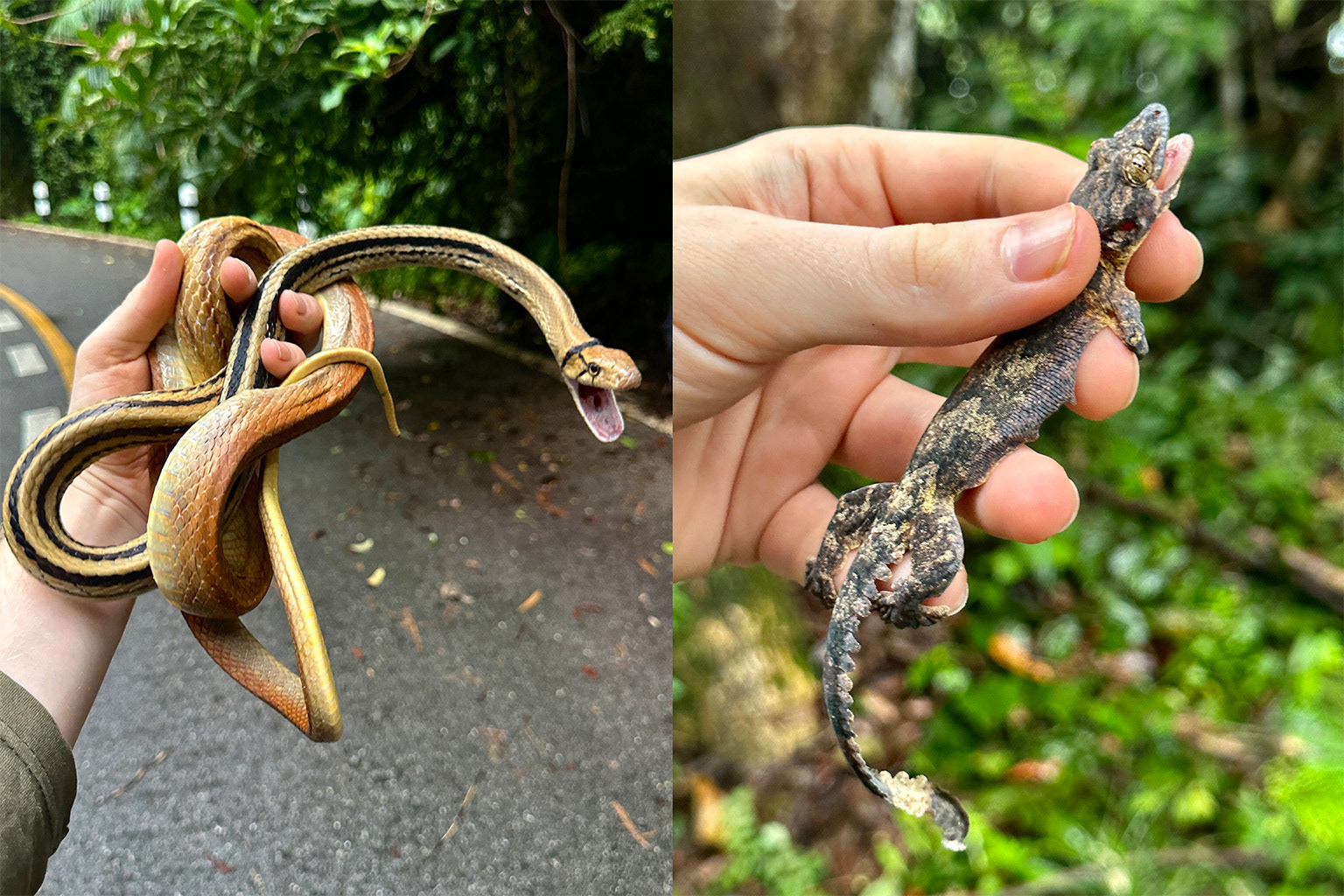
Radiated rat snake (Coelognathus radiata) & Cambodian gliding gecko (Gekko tokehos)
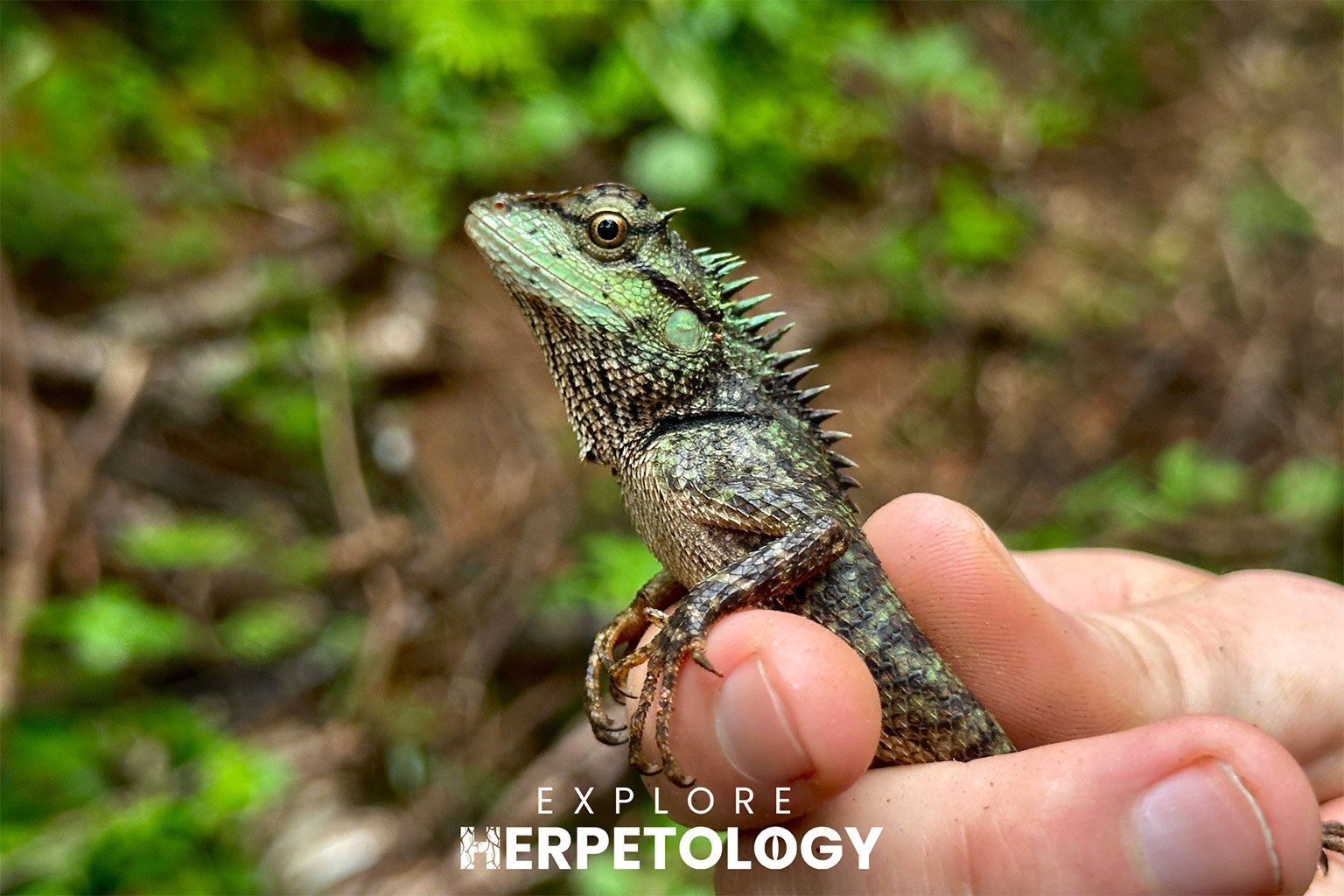
Forest crested lizard (Calotes emma)
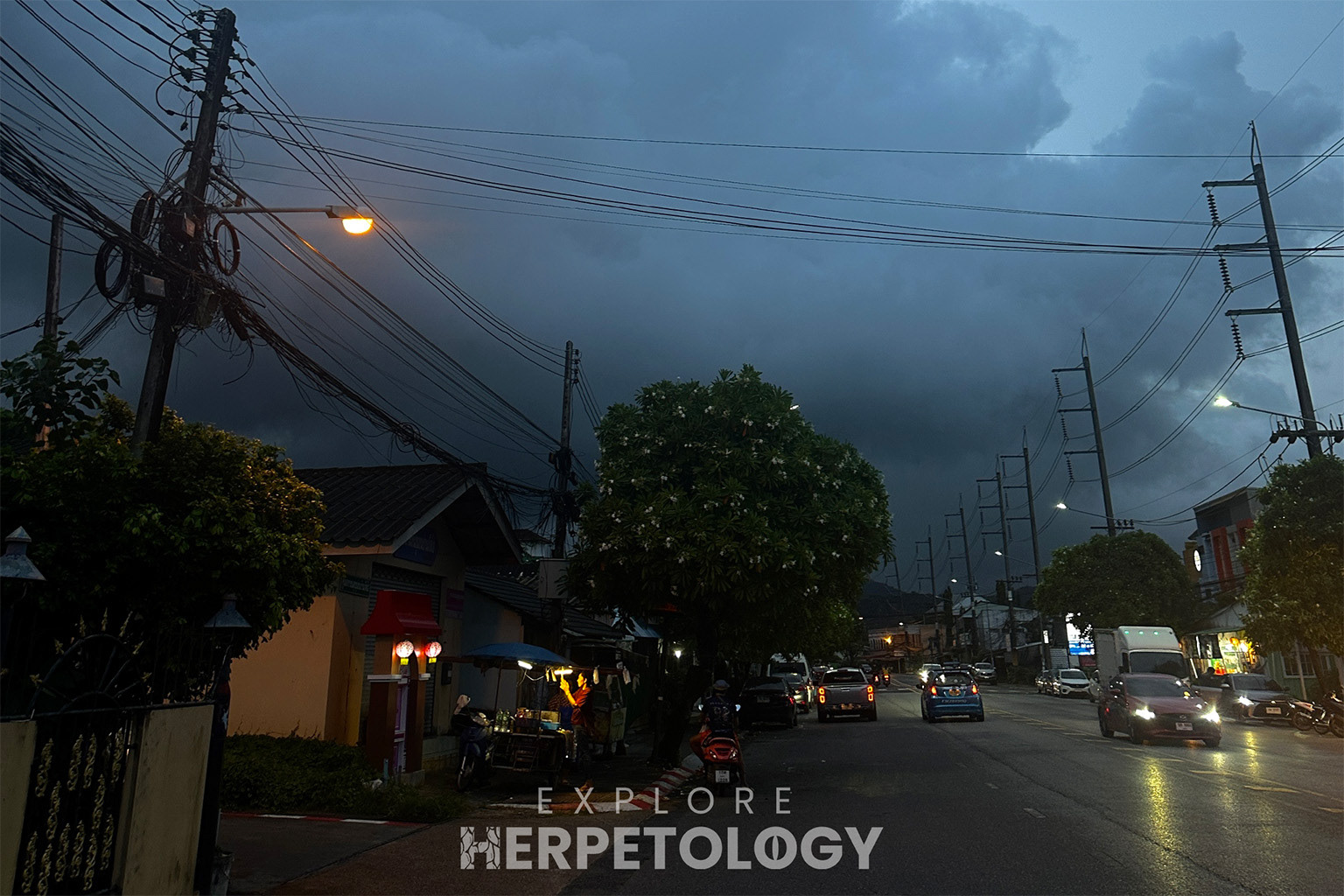
Dark clouds over Kathu district.
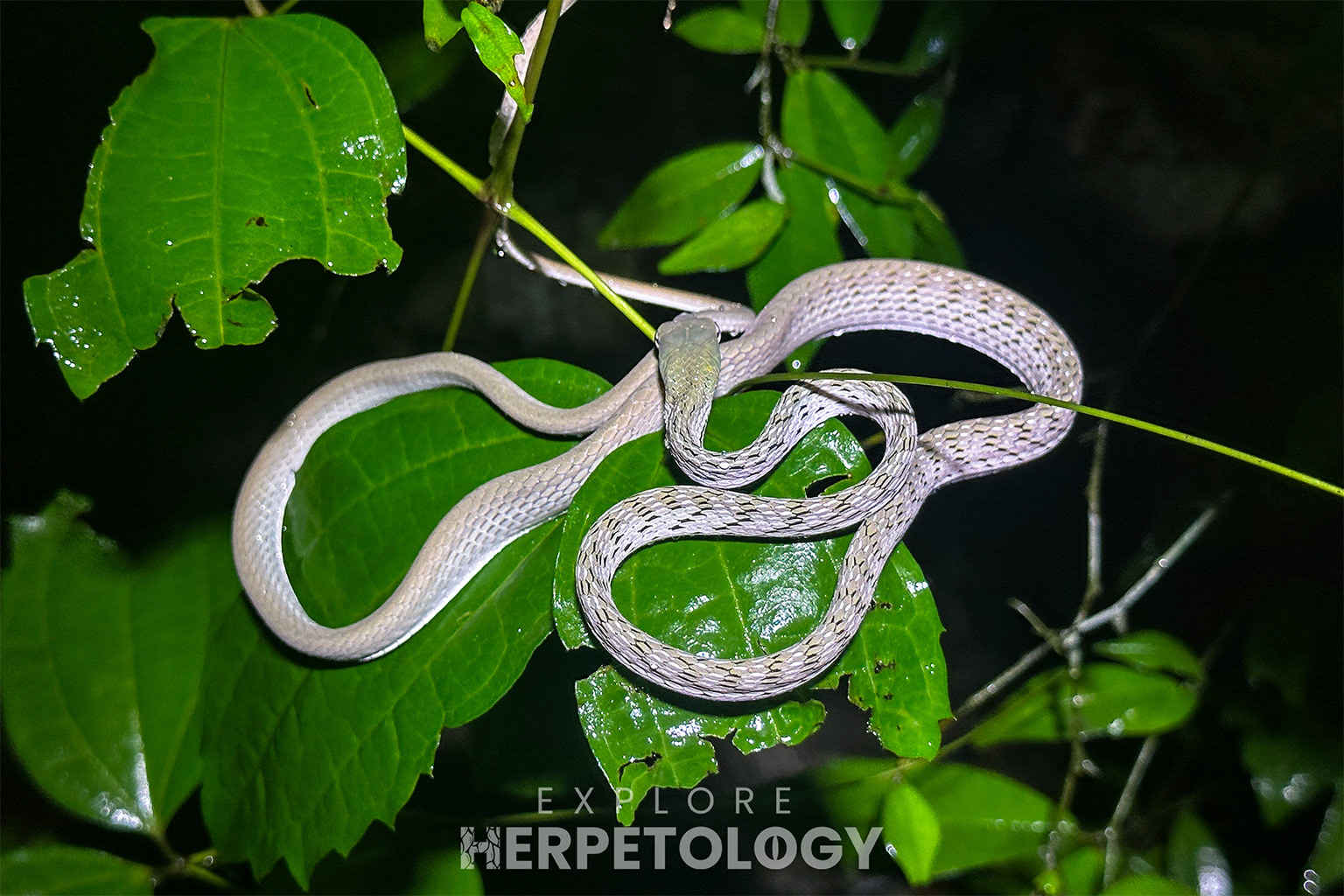
Juvenile Ahaetulla prasina.
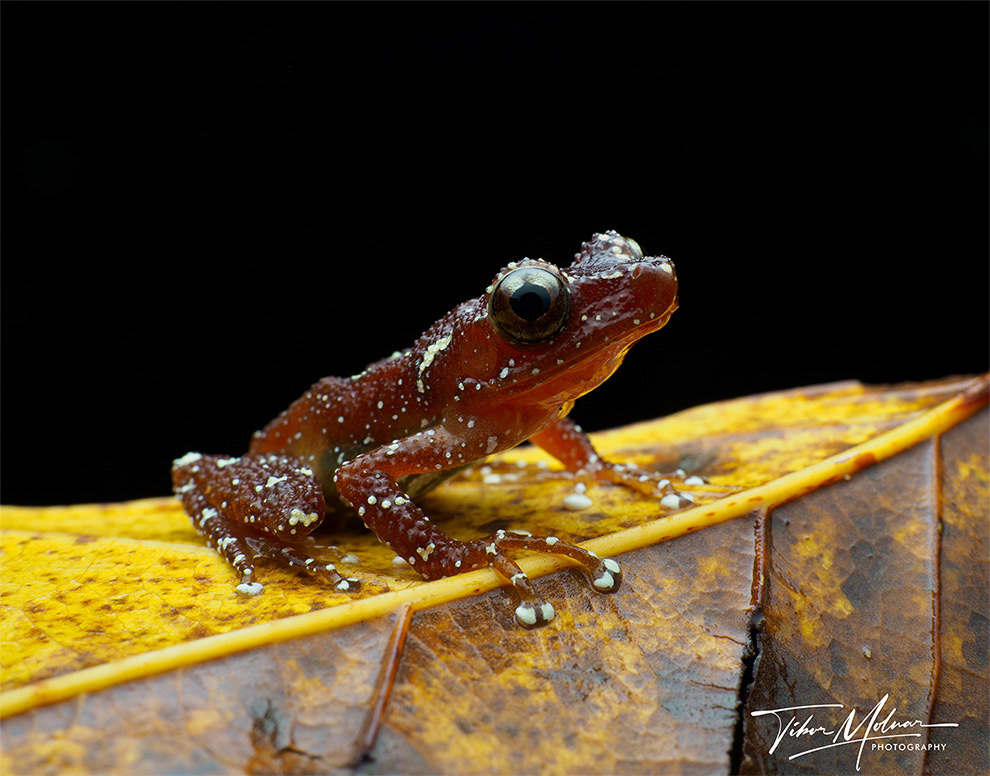
Cinnamon frog (Nyctixalus pictus).
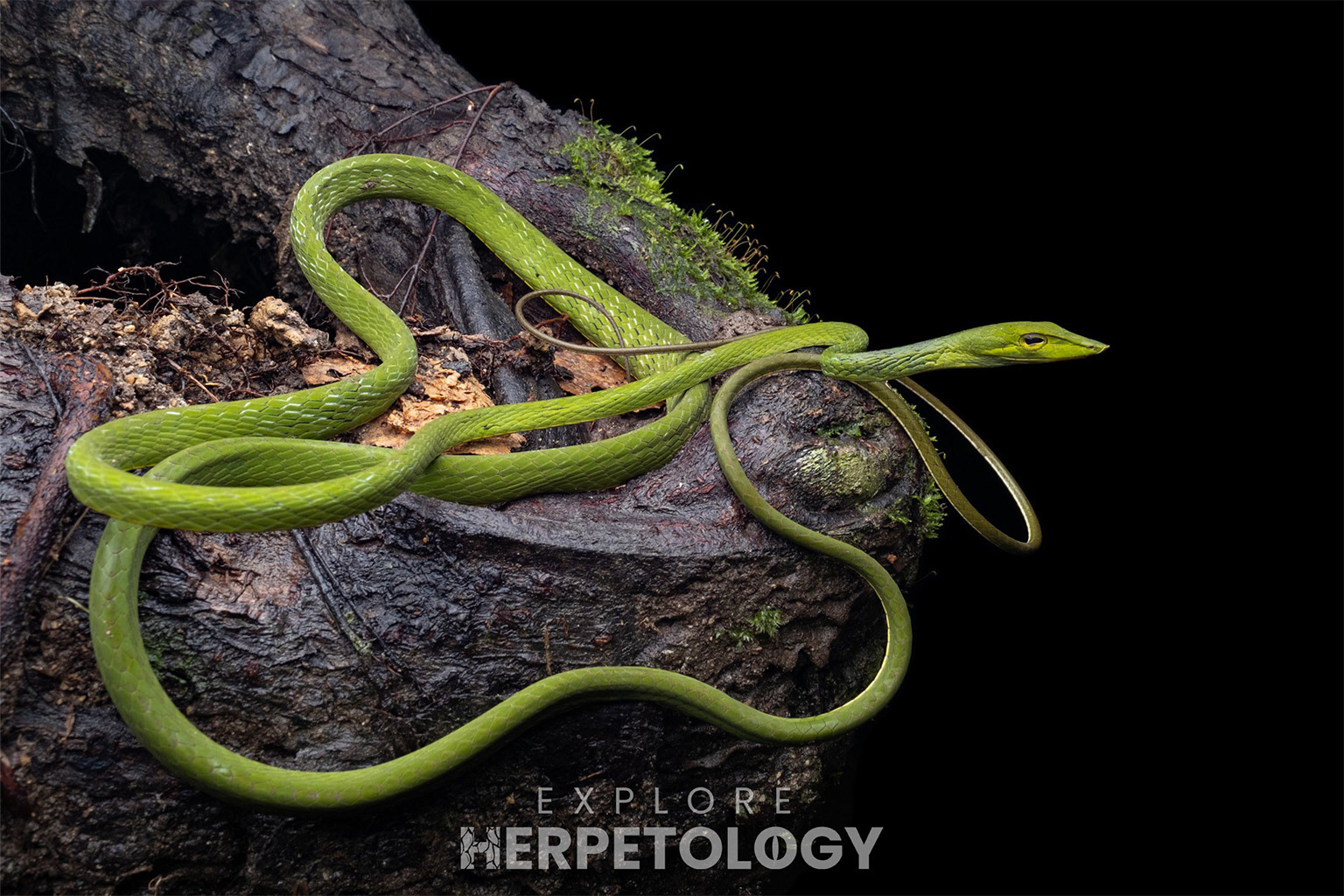
Green morph of the speckle-headed vine snake (Ahaetulla fasciolata).
After we finished our quick loop at the first herping site, we decided to drive to a nearby stream where we would target Wagler's pit viper (Tropidolaemus wagleri). Unfortunately, this was when the heavens opened and a truly torrential downpour began. The dirt road which led uphill to the site quickly became a river, with branches and logs being washed downhill, and we were very concerned about landslides, so we abandoned this venture and headed to another site.
Shortly after arriving, we found two Phuket pit viper (Trimeresurus phuketensis) females around a small temple, but then the heavy rain returned and did not stop for the rest of the our herping session. Most activity was suppressed, but we still found a juvenile spiny turtle (Heosemys spinosa), a male waglers pit viper (Tropidolaemus wagleri) and some friends herping in the same area that night caught a young blood python (Python brongersmai).
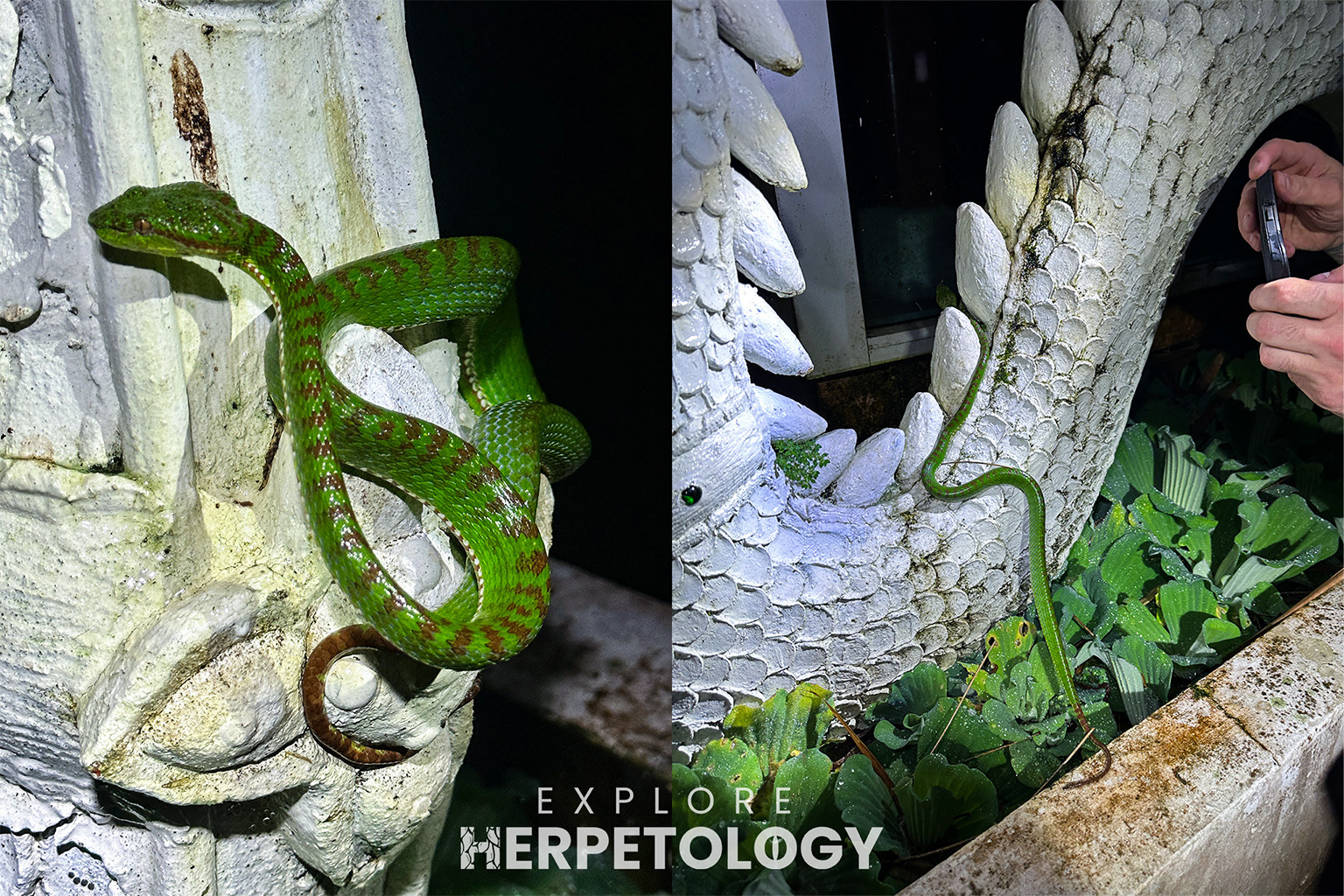
Phuket pit viper (Trimeresurus phuketensis)
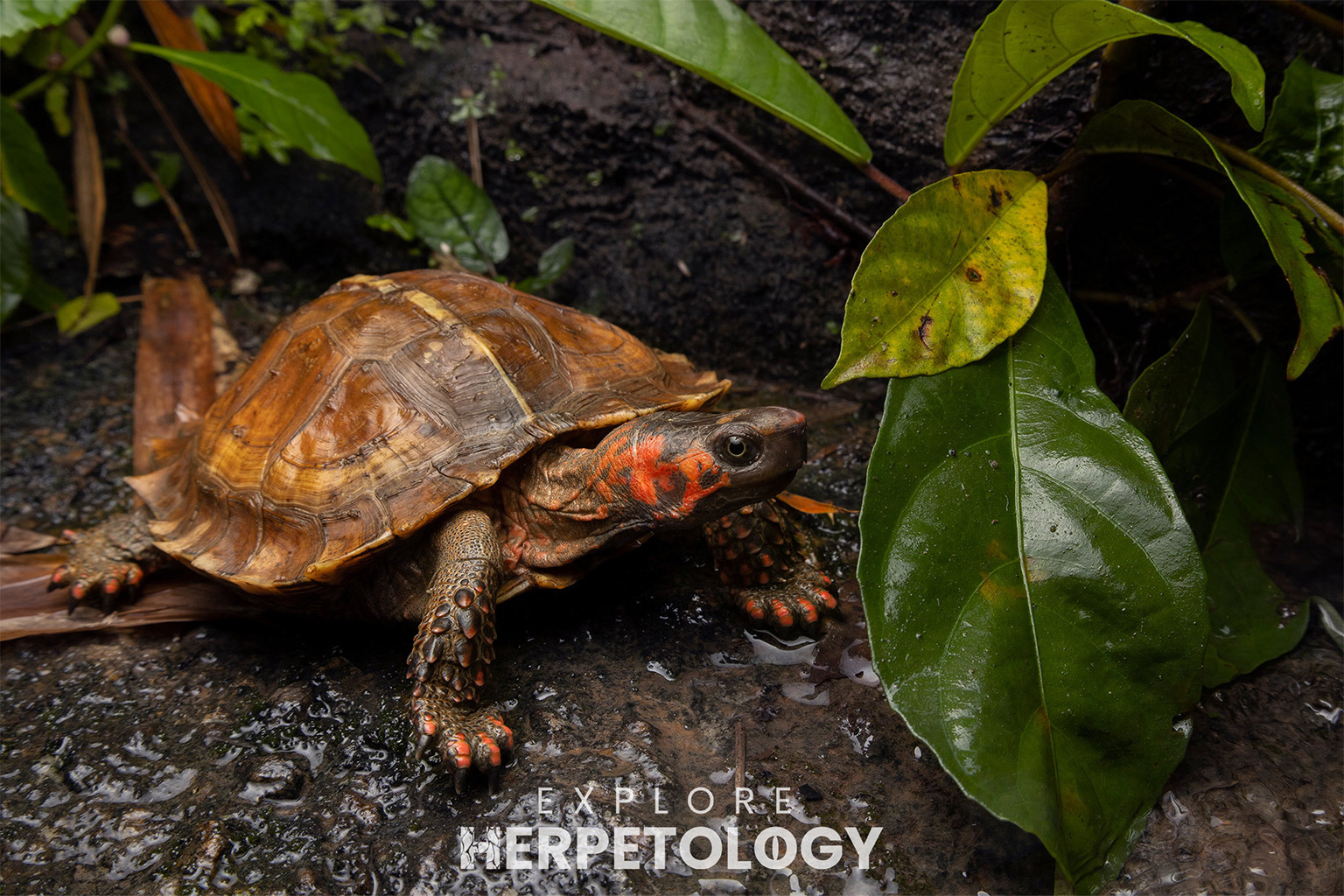
Spiny turtle (Heosemys spinosa)
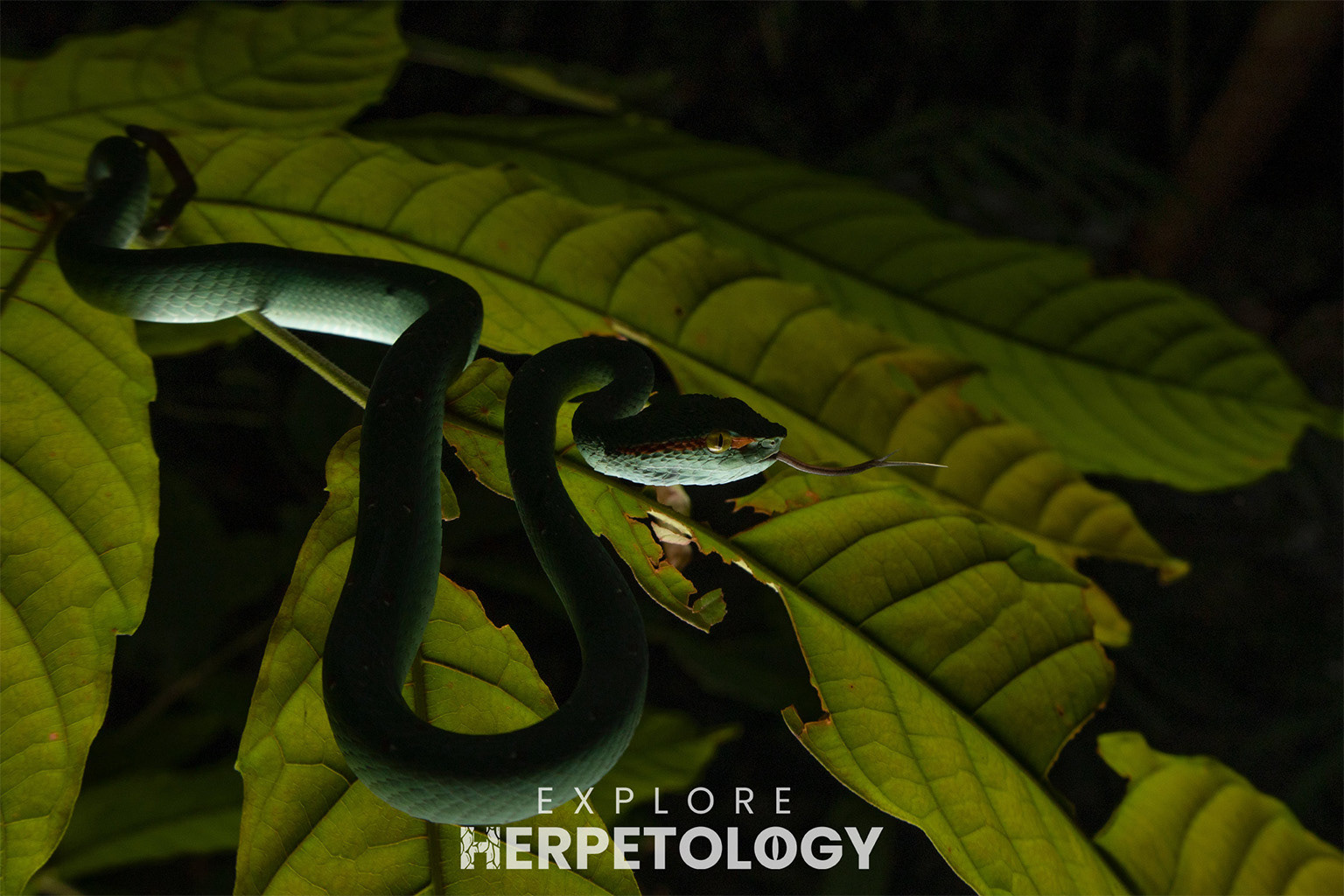
Male Wagler's pit viper (Tropidolaemus wagleri)
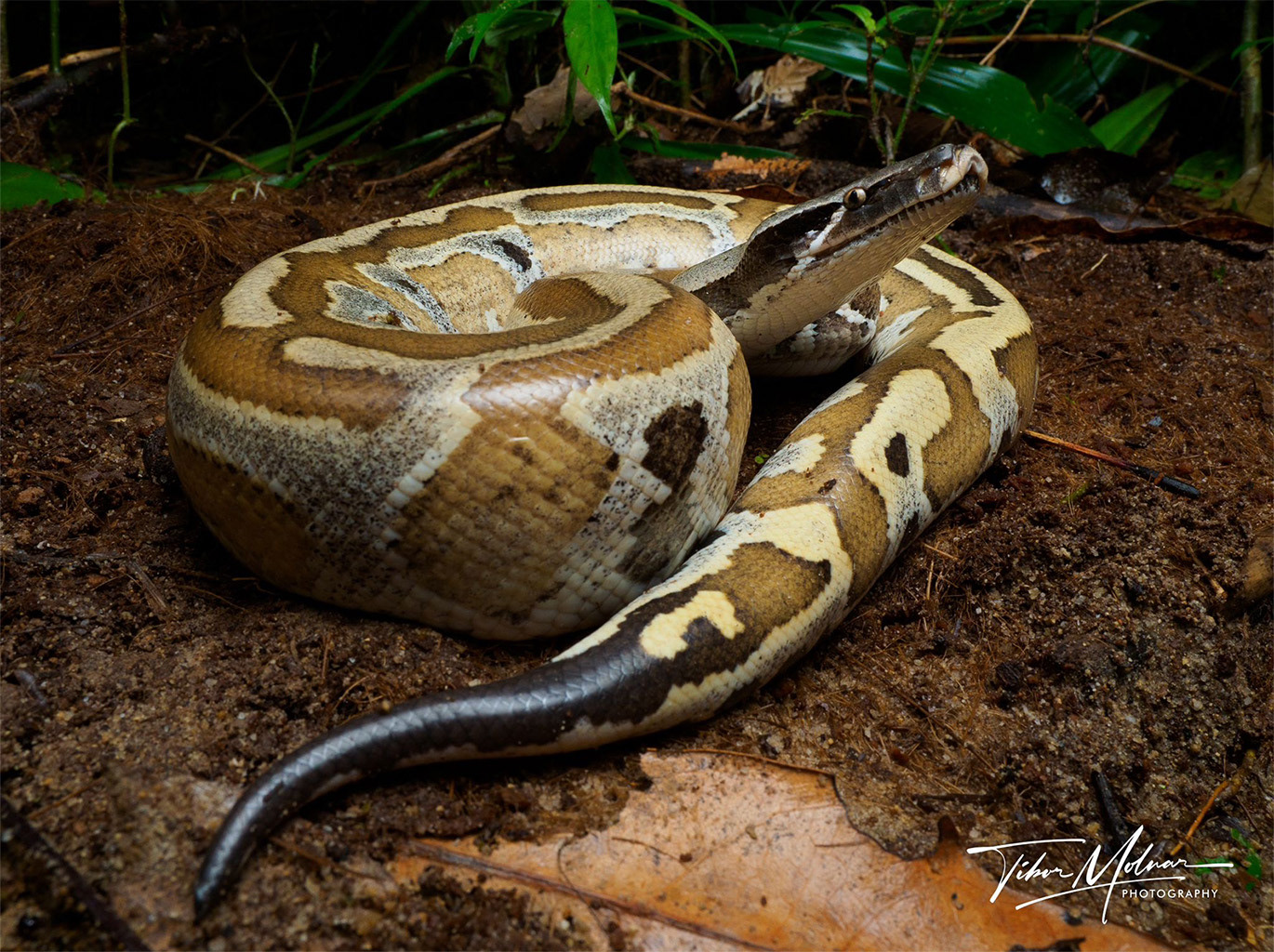
Blood python (Python brongersmai).
The following day, we went for a daytime hike during a break in the rain and saw a large white-bellied rat snake (Ptyas fusca) which unfortunately escaped into some dense vegetation. Come evening, the rain held off and led to an extremely productive night of searching, starting with two black-barred keelbacks (Rhabdophis nigrocinctus) which were resting around a pond. Several more female Phuket pit vipers (Trimeresurus phuketensis) were also observed, along with a juvenile male which was sadly in slough. We also saw many of Phuket's interesting smaller herpetofauna, including endemics such as Ansonia phuketensis, Cyrtodactylus thalang and Cnemaspis vandeventeri. We even glimpsed the head of another blood python (Python brongersmai) which quickly retreated into its hole.
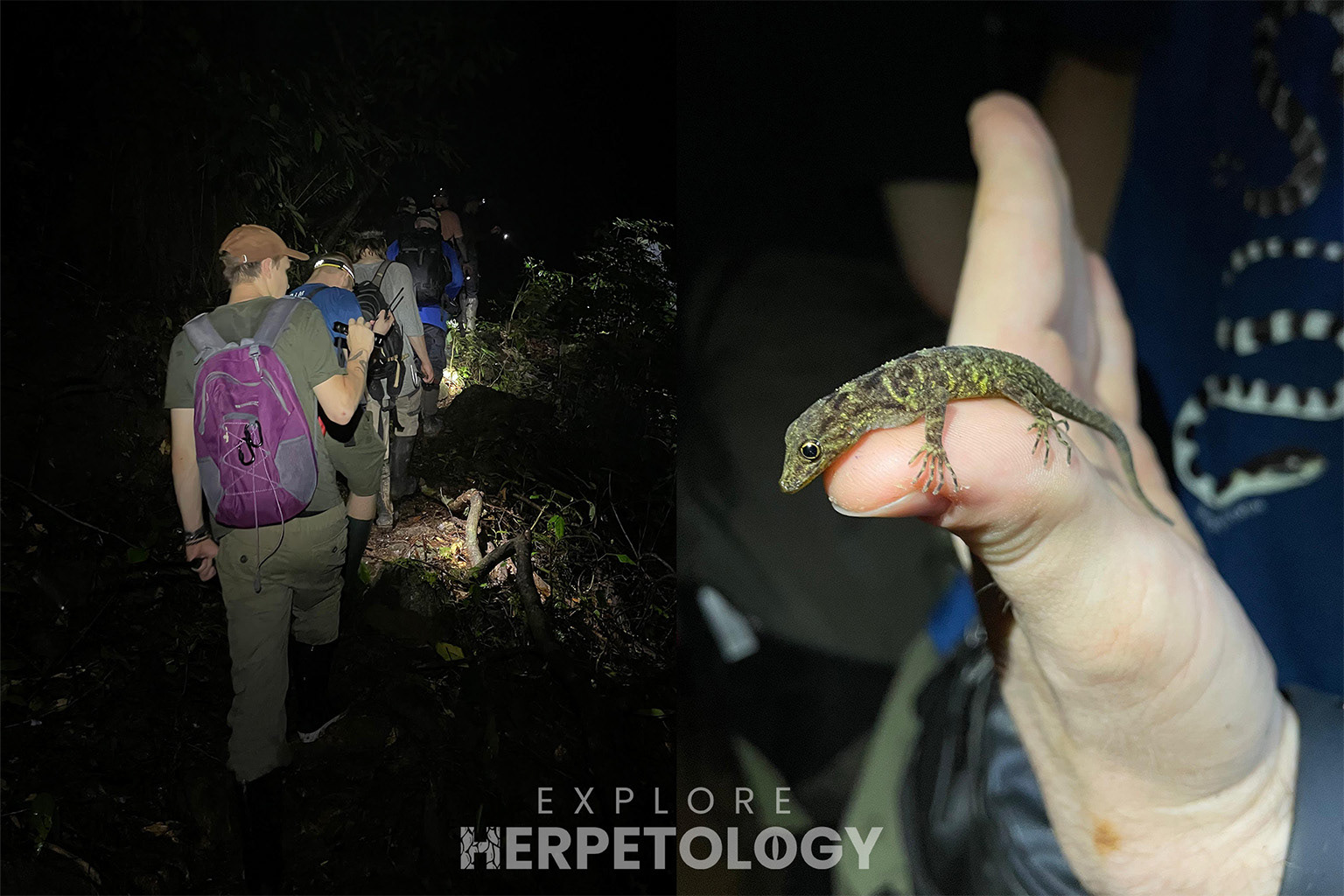
Cnemaspis vandeventeri (endemic)
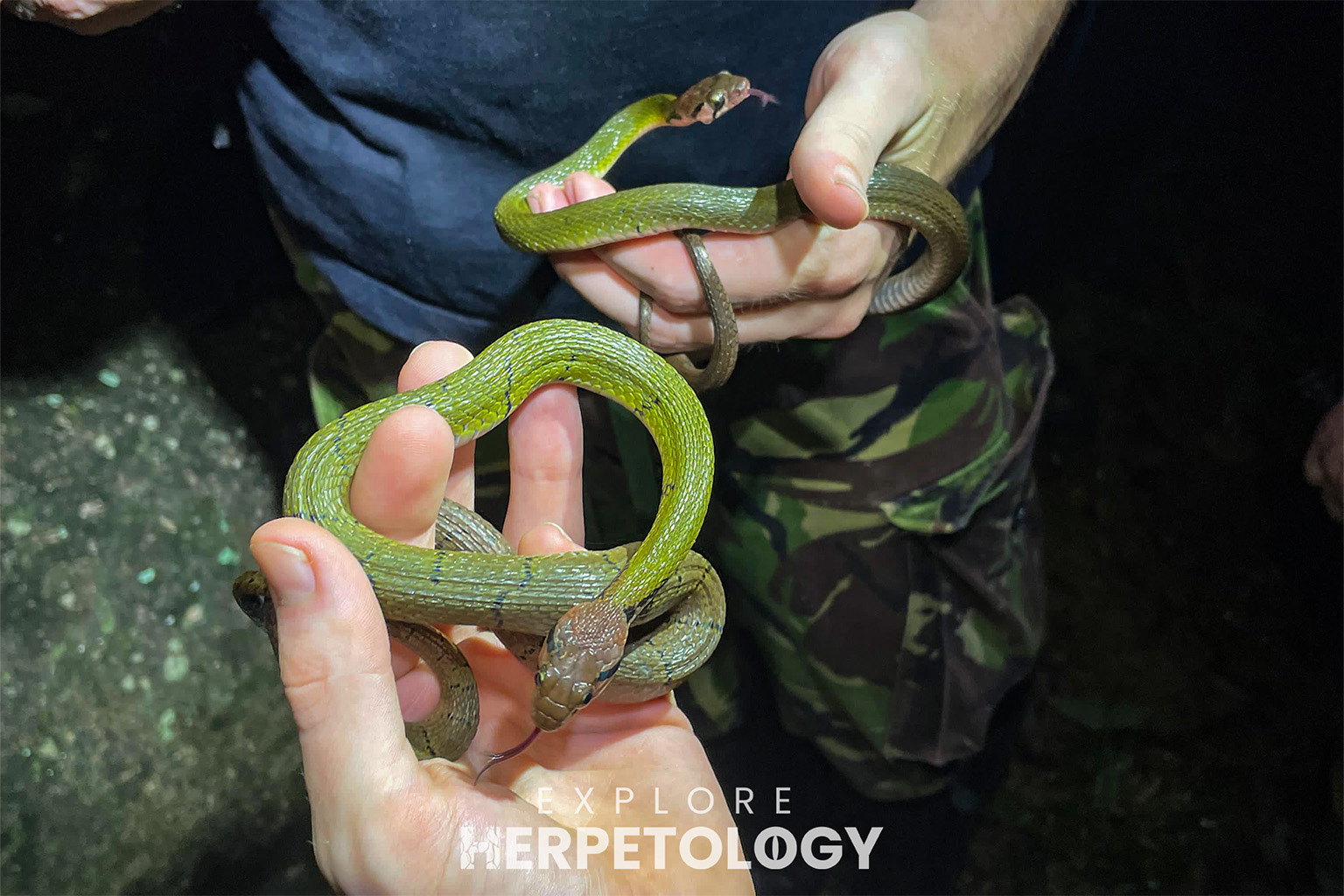
Black-barred keelback (Rhabdophis nigrocinctus)
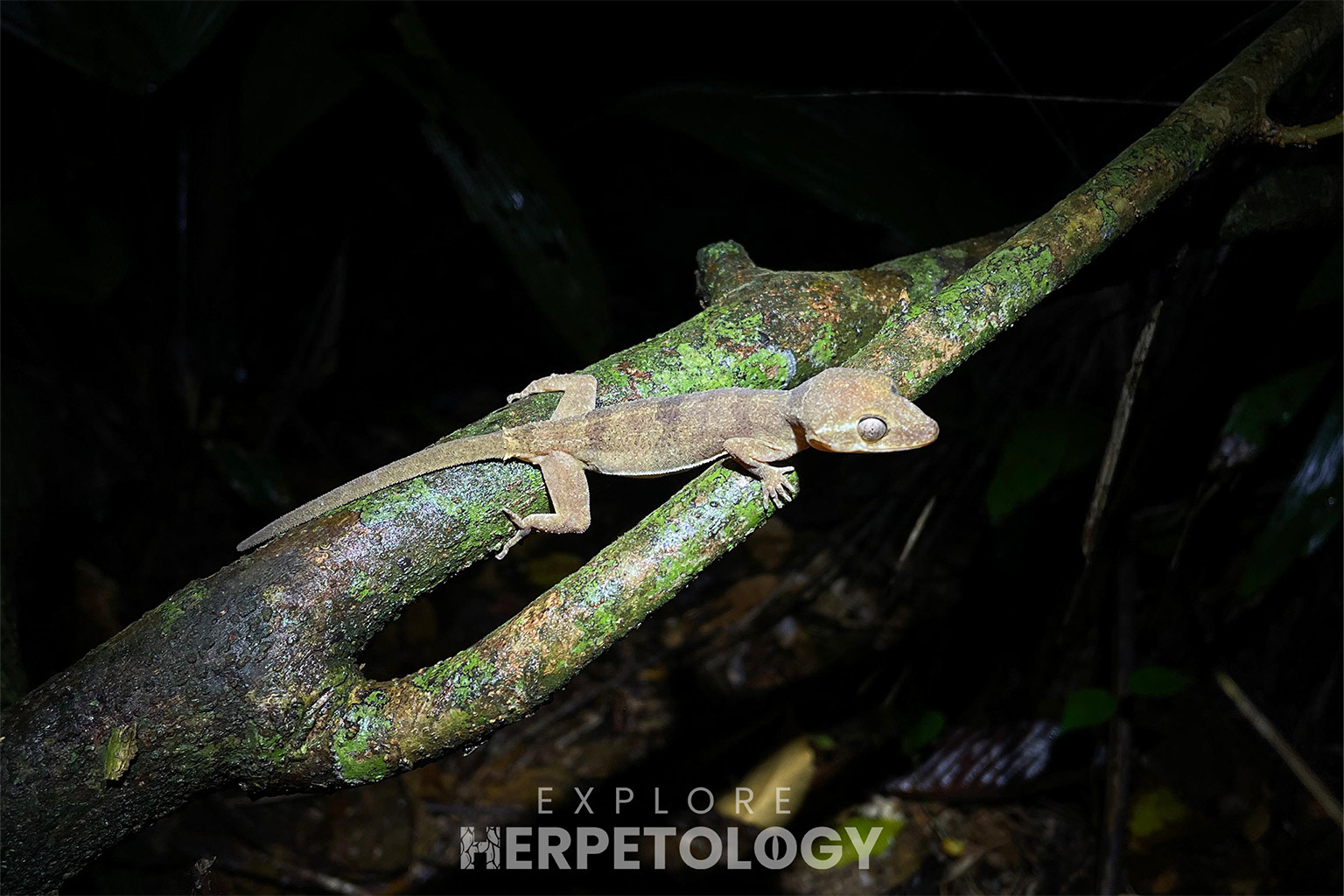
Cyrtodactylus thalang (endemic)
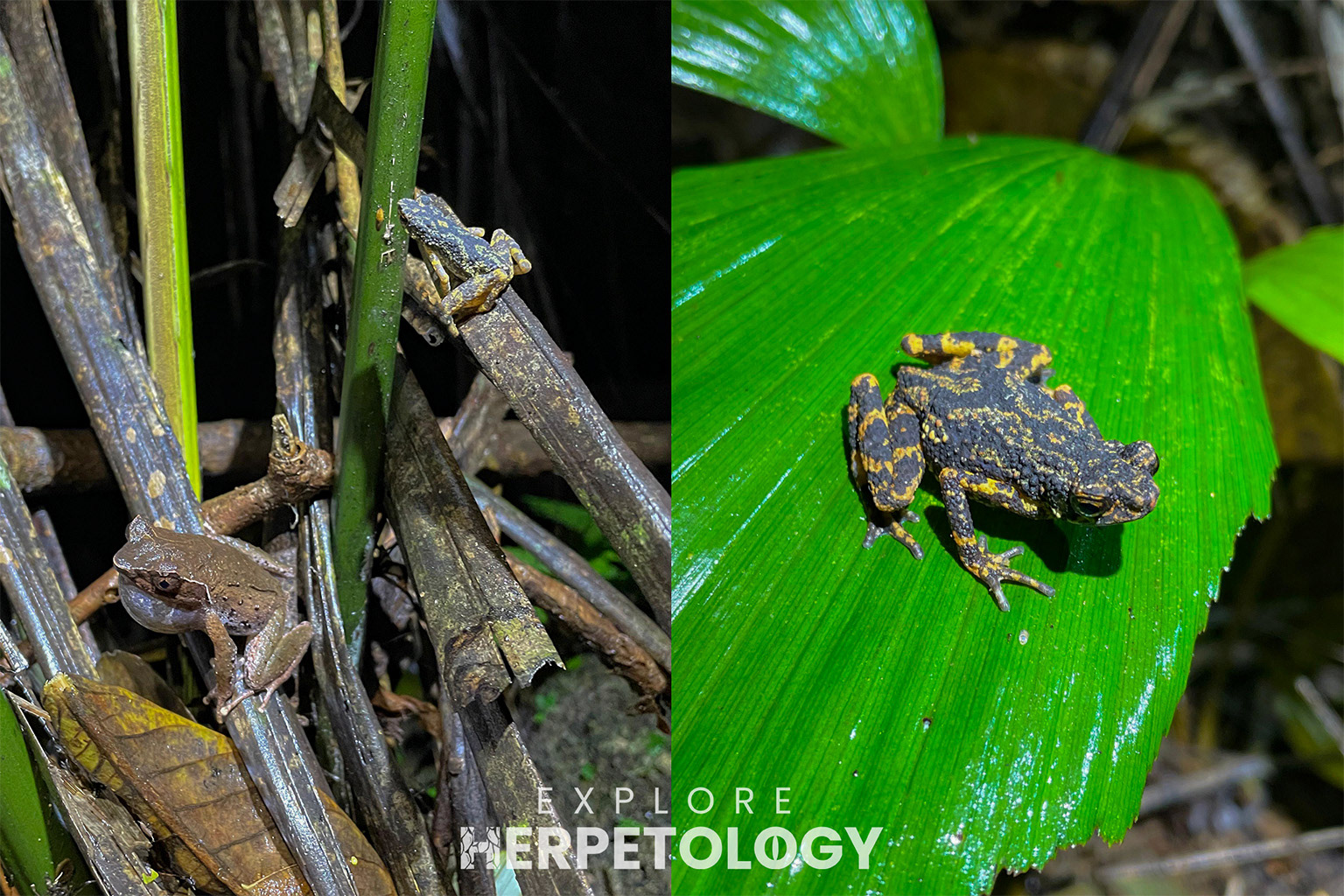
Megophrys cf. parva & Ansonia phuketensis (endemic).
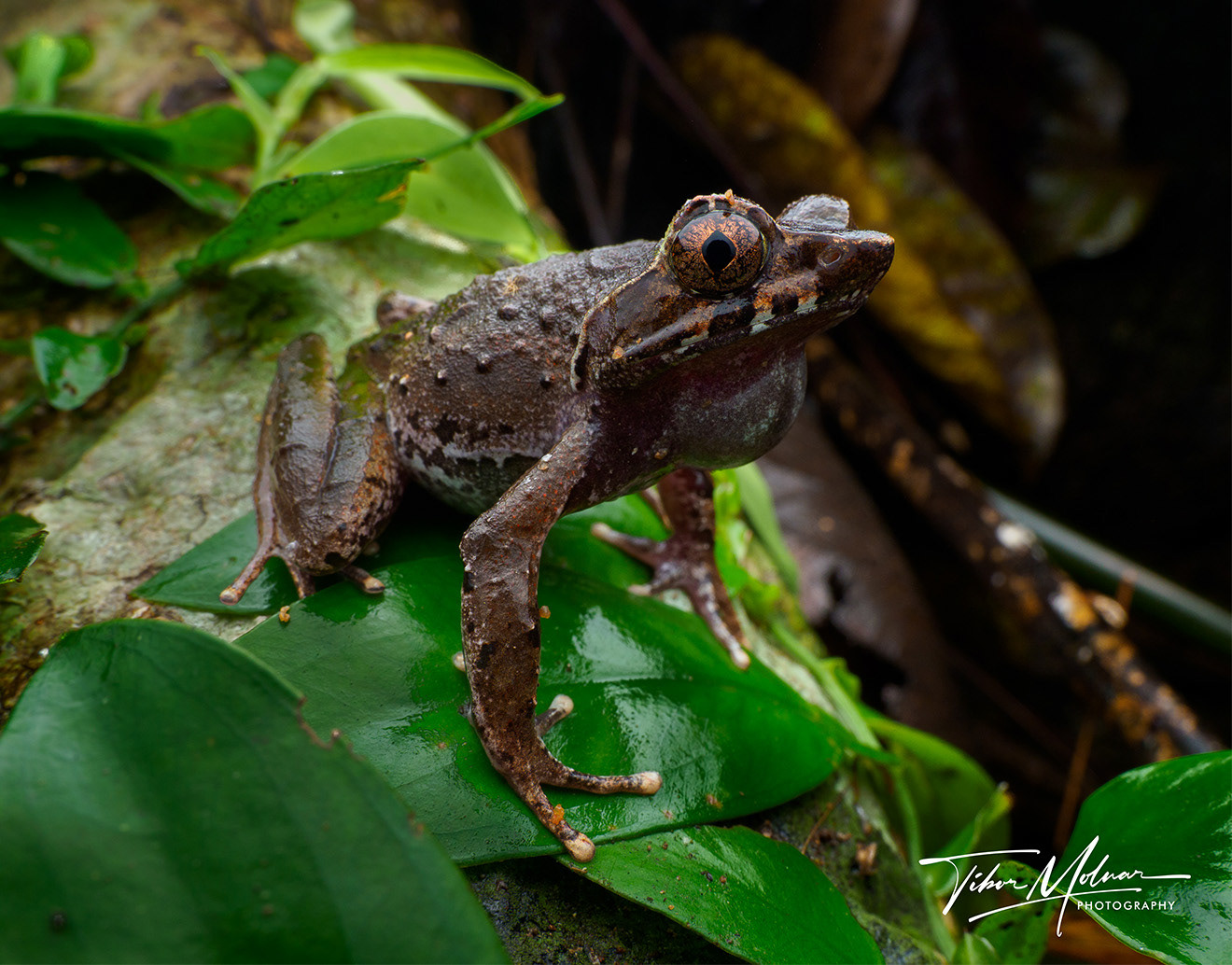
Megophrys cf. parva.
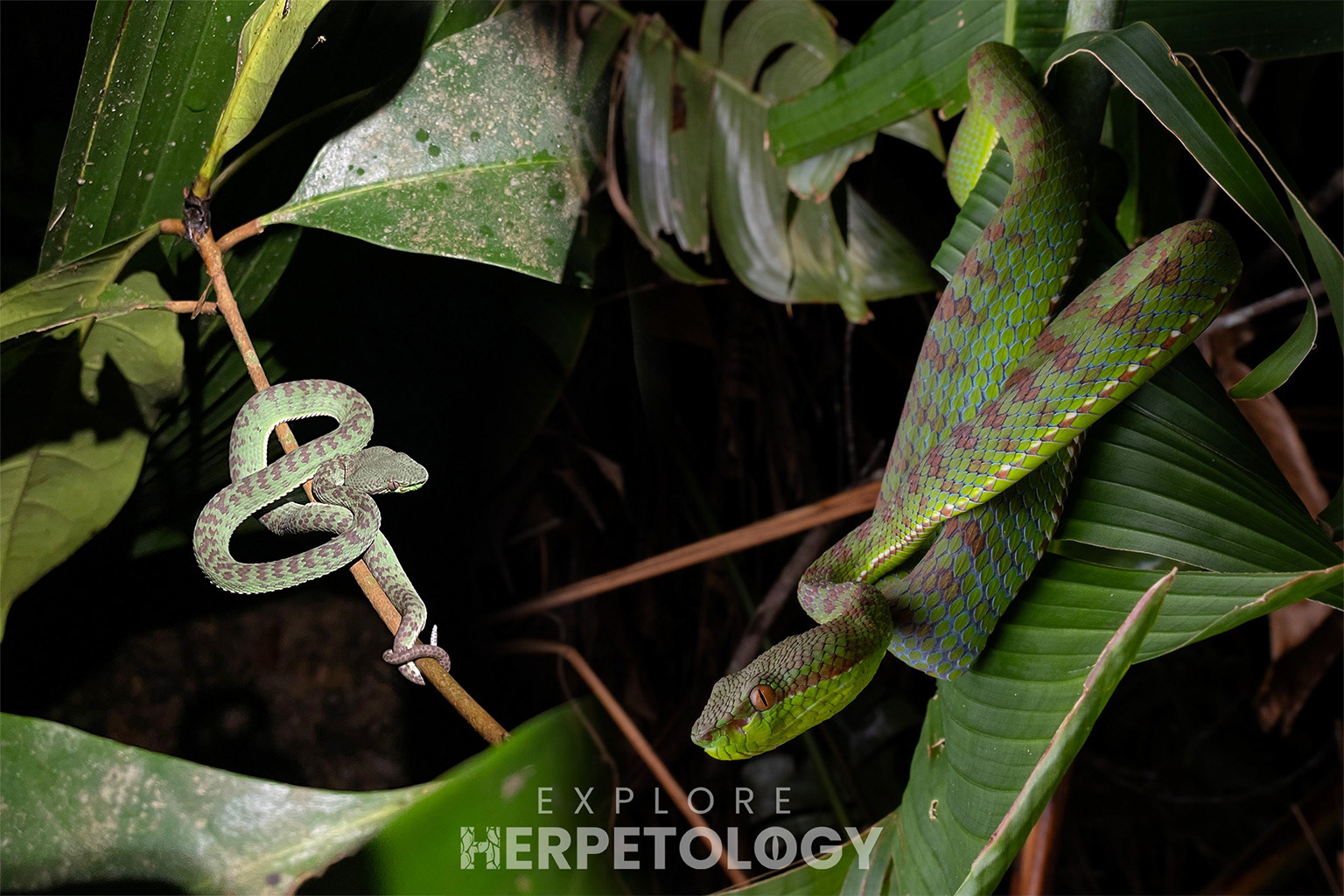
Phuket pit vipers (Trimeresurus phuketensis).
As we continued along the same trail, Aaron called out that he'd seen a monitor lizard sleeping on the side of a tree. Closer inspection revealed it to be a beautiful individual of the rarely seen Dumeril's monitor lizard (Varanus dumerilii). We used teamwork to bring it down and a truly unexpected showstopper was under the belt!
From here, we began to search almost exclusively for an adult female Wagler's pit viper. 5 males showed up on the way, along with a juvenile Laotian wolf snake (Lycodon laoensis) and a juvenile elegant bronzeback (Dendrelaphis formosus). It was not until we almost returned to the car when Rupert spotted what we believed to be a Wagler's pit viper (Tropidolaemus wagleri) female high in a tree. Some climbing efforts revealed it to be a truly stunning adult female, one which had retained a striking amount of green for its size. The population of T. wagleri in Phuket undergo their colour transition at a much smaller size than other locations, but this one was large enough that it should have lost most of its green colouration by this point. A really remarkable individual.
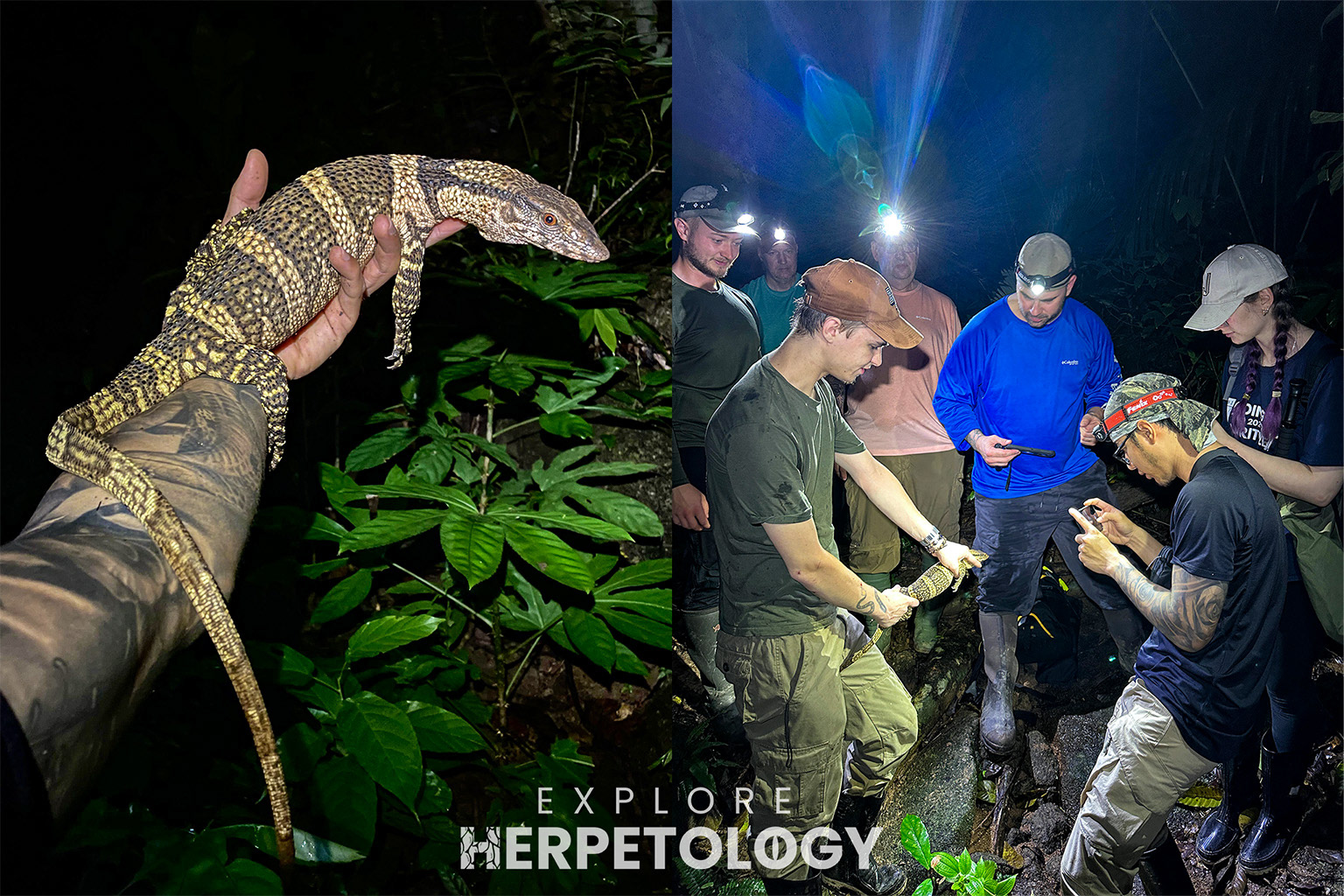
In-hand and group pic of the Dumeril's monitor (Varanus dumerilii)
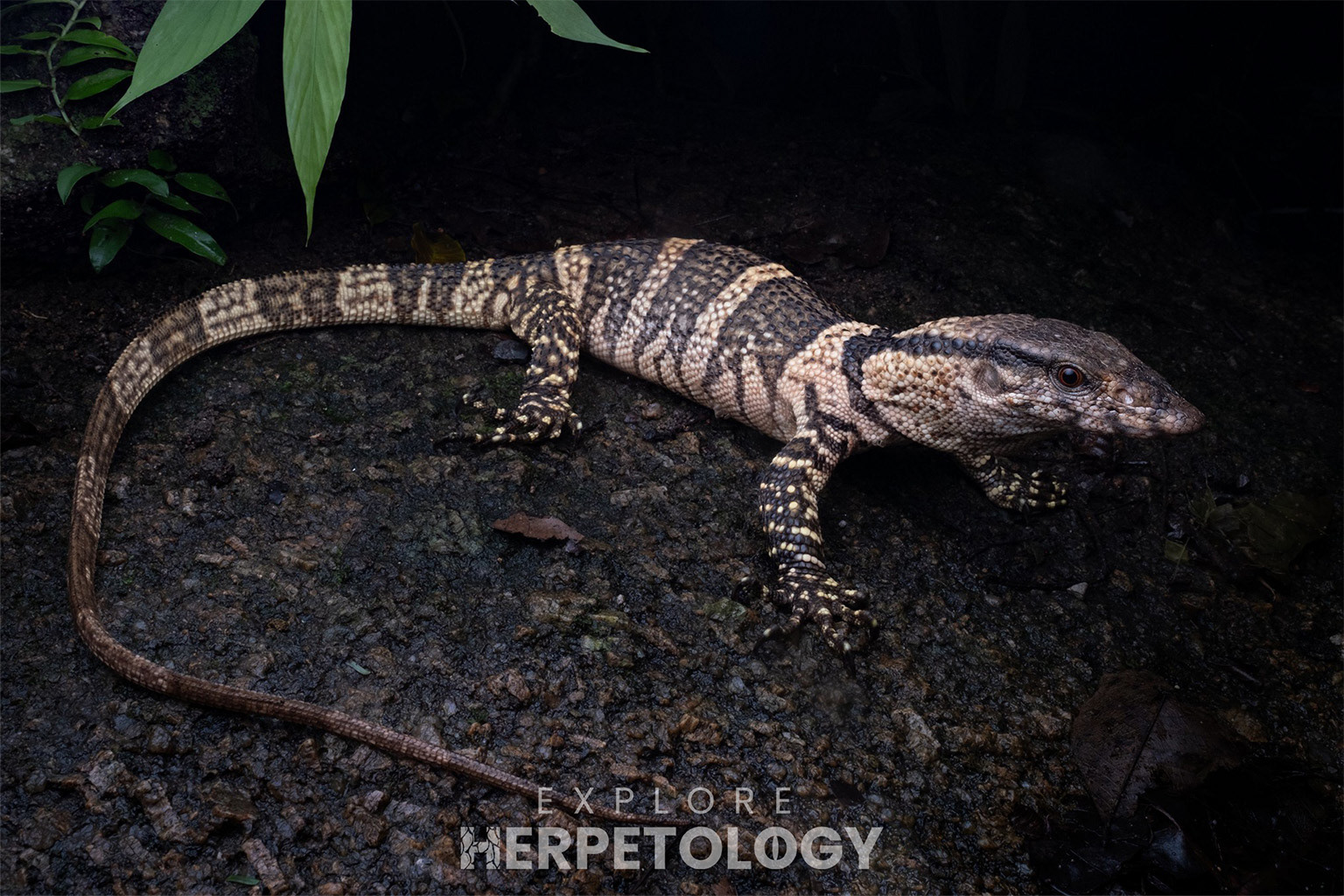
Dumeril's monitor (Varanus dumerilii)
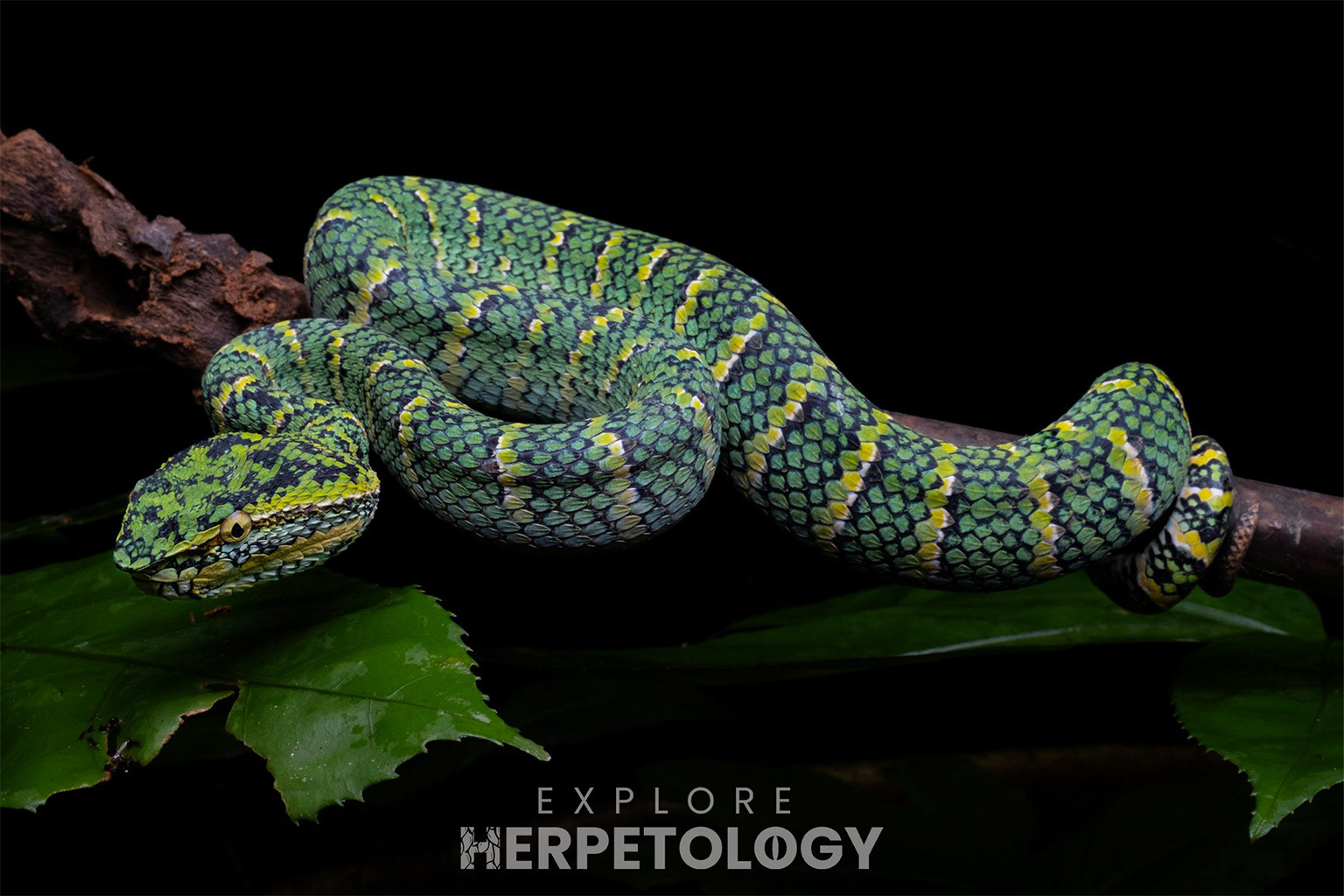
Wagler's pit viper (Tropidolaemus wagleri)
KRABI (29th - 1st)
We left Phuket the following morning and drove to Krabi, where we would spend 3 nights exploring different locations near the city. We started with an afternoon walk at one of our favourite karst valleys, which is usually very good for diurnal observations of the beautiful pit viper (Trimeresurus venustus). This time, we only saw elongated tortoise (Indotestudo elongata) and and south-east asian box turtle (Cuora amboinensis).
We began our nighttime herping at a limestone hill road, which quickly produced our two viper targets; a Malayan pit viper (Calloselama rhodostoma) and multiple individuals of beautiful pit viper (Trimeresurus venustus), including a 'large' female, some smaller males and a juvenile. A large and very colourful reticulated python (Malayopython reticulatus) was the real highlight of the night, while we also caught two Davison's bridle snakes (Lycodon davisonii) which were engaging in male combat, not far from a solitary common wolf snake (Lycodon capucinus). Upon returning to our resort, we caught a speckle-bellied keelback (Rhabdophis chrysargos) in the garden.
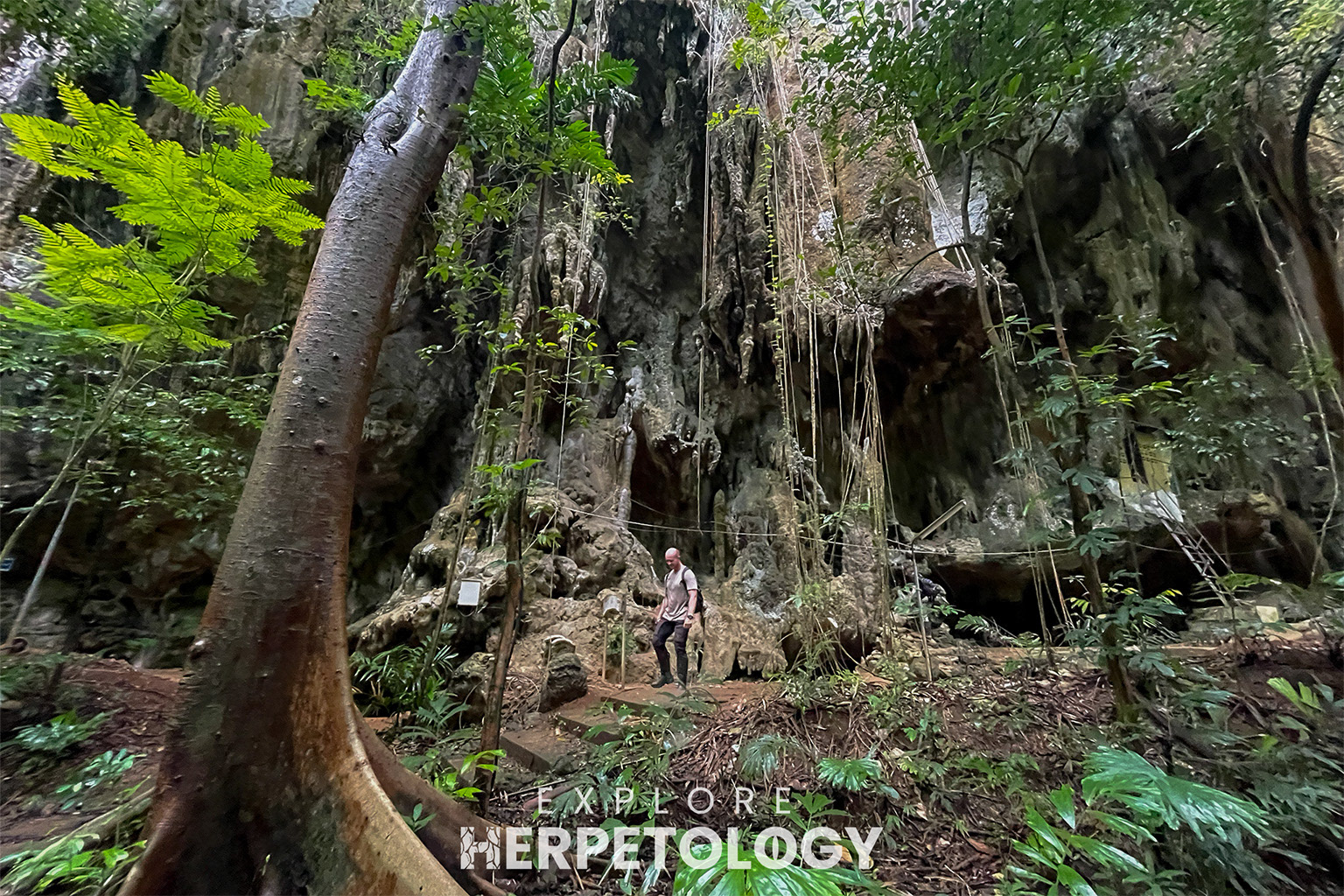
Limestone karst valley in Krabi.
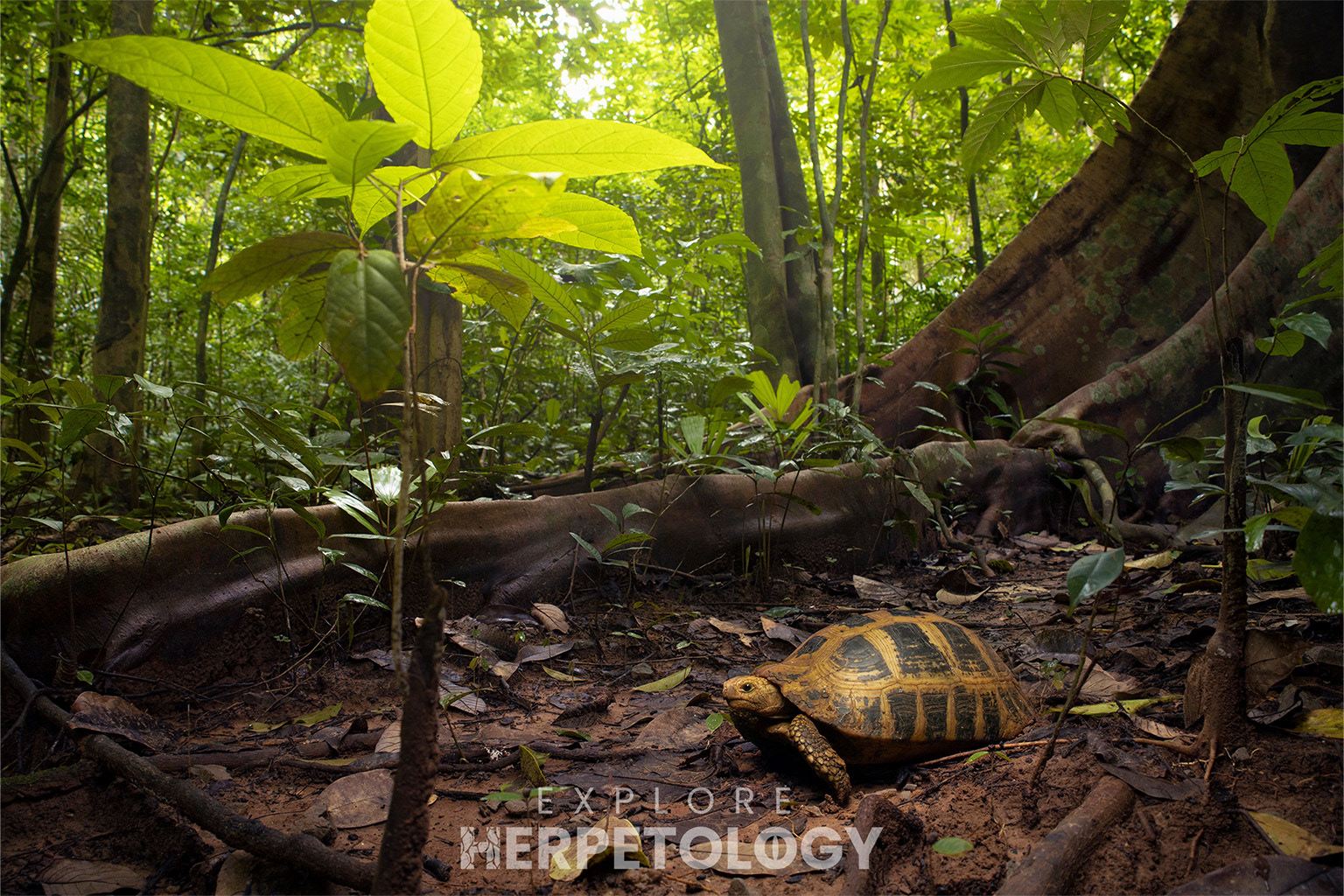
Elongated tortoise (Indotestudo elongata).
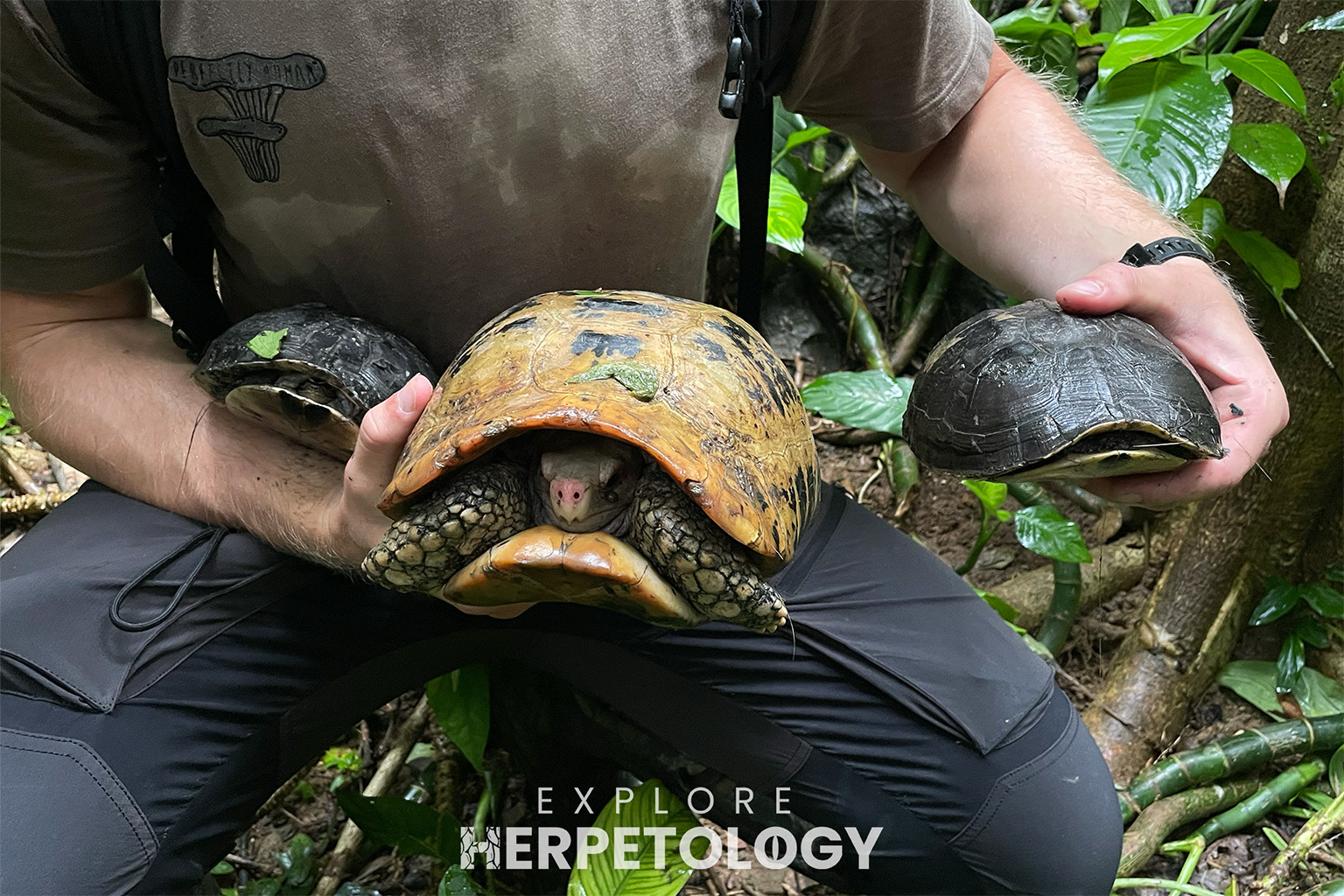
Cuora amboinensis & Indotestudo elongata.
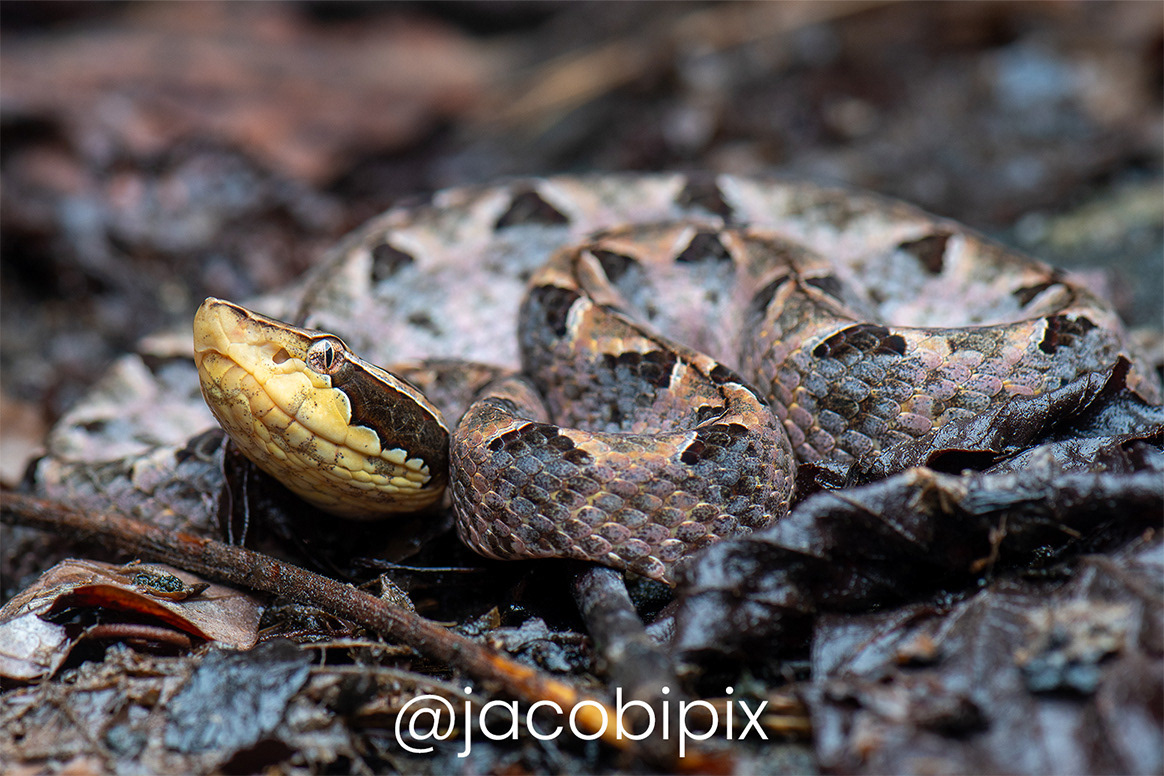
Malayan pit viper (Calloselasma rhodostoma).
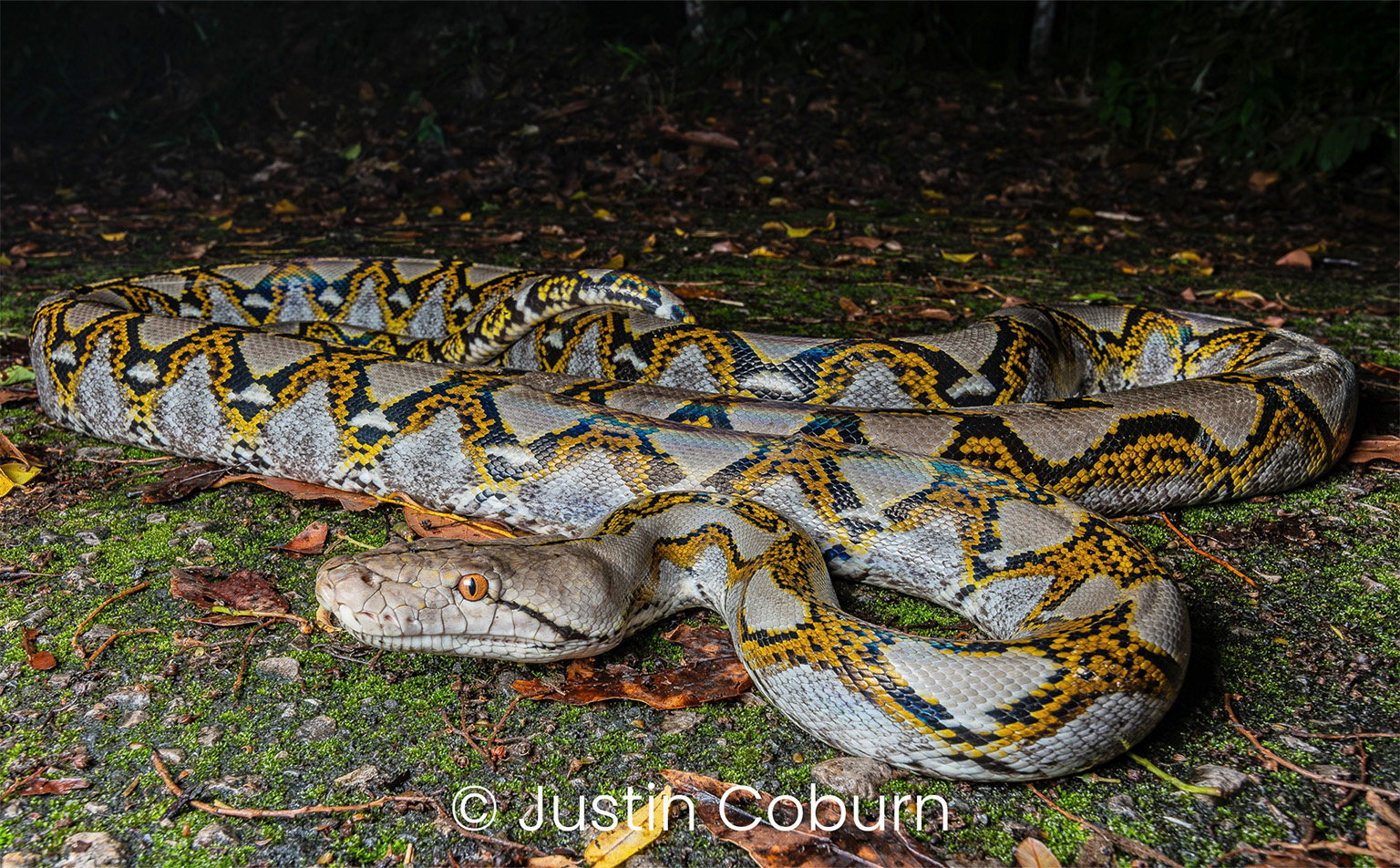
Reticulated python (Malayopython reticulatus).
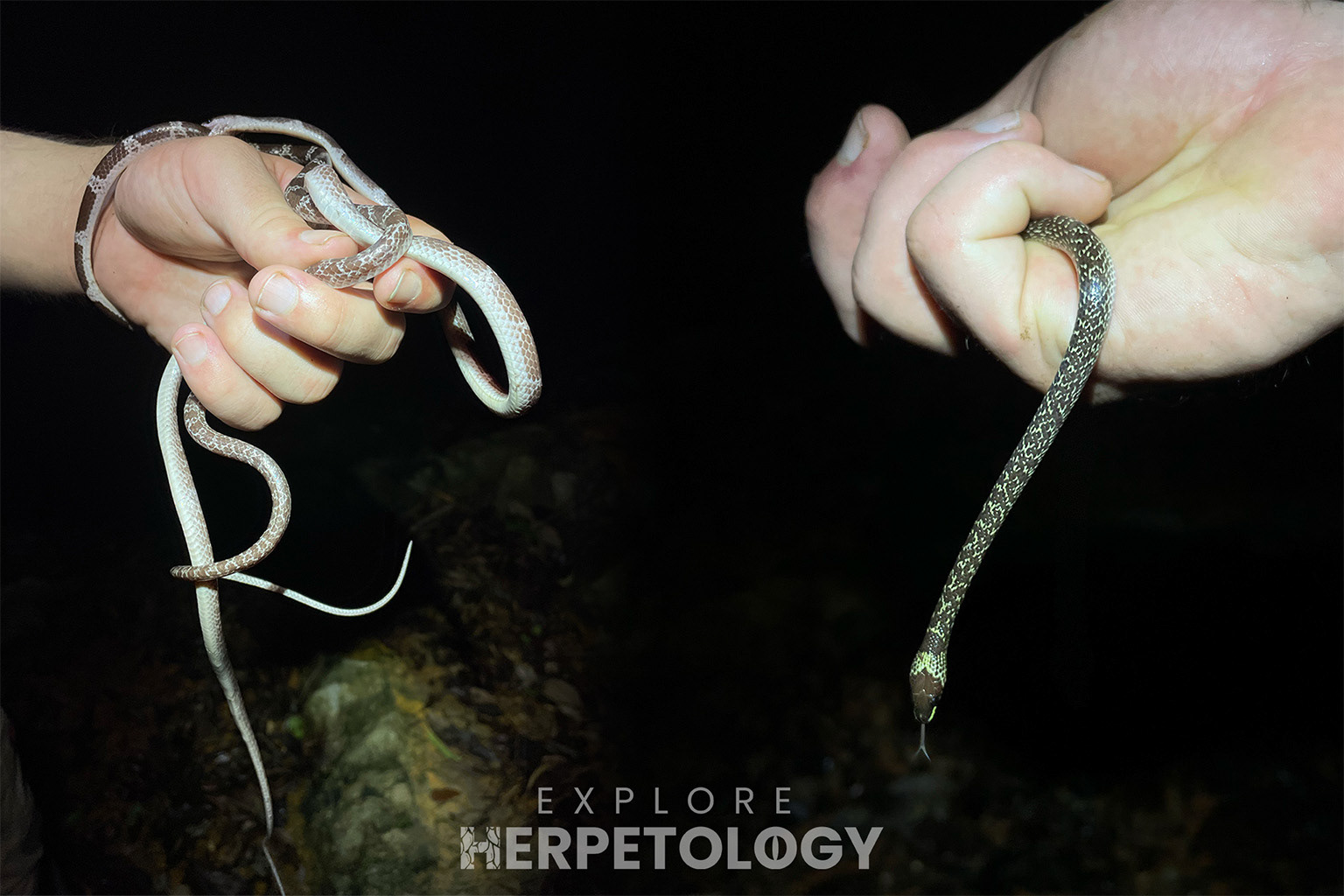
Left: Lycodon davisonii. Right: Lycodon capucinus.
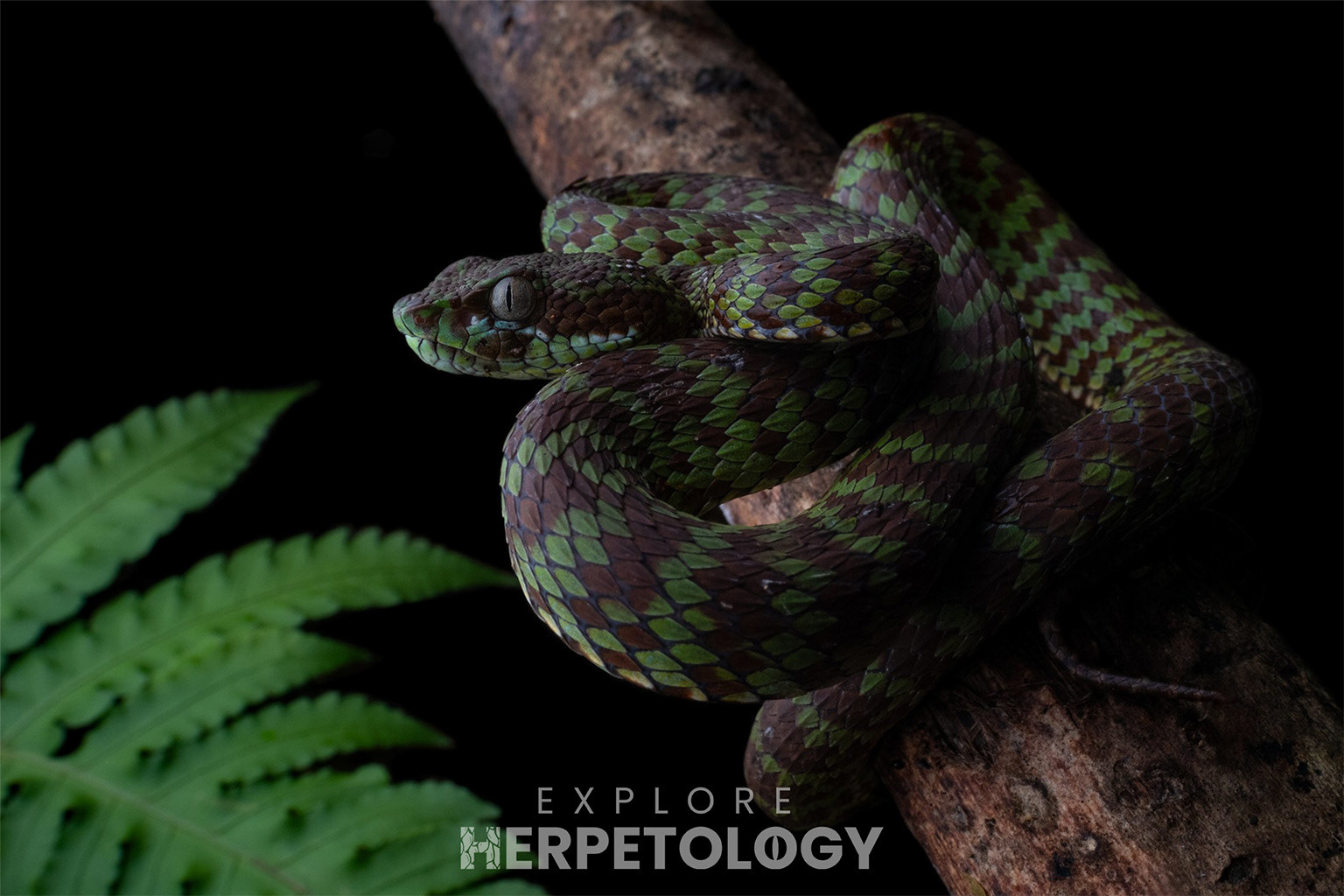
Beautiful pit viper (Trimeresurus venustus).
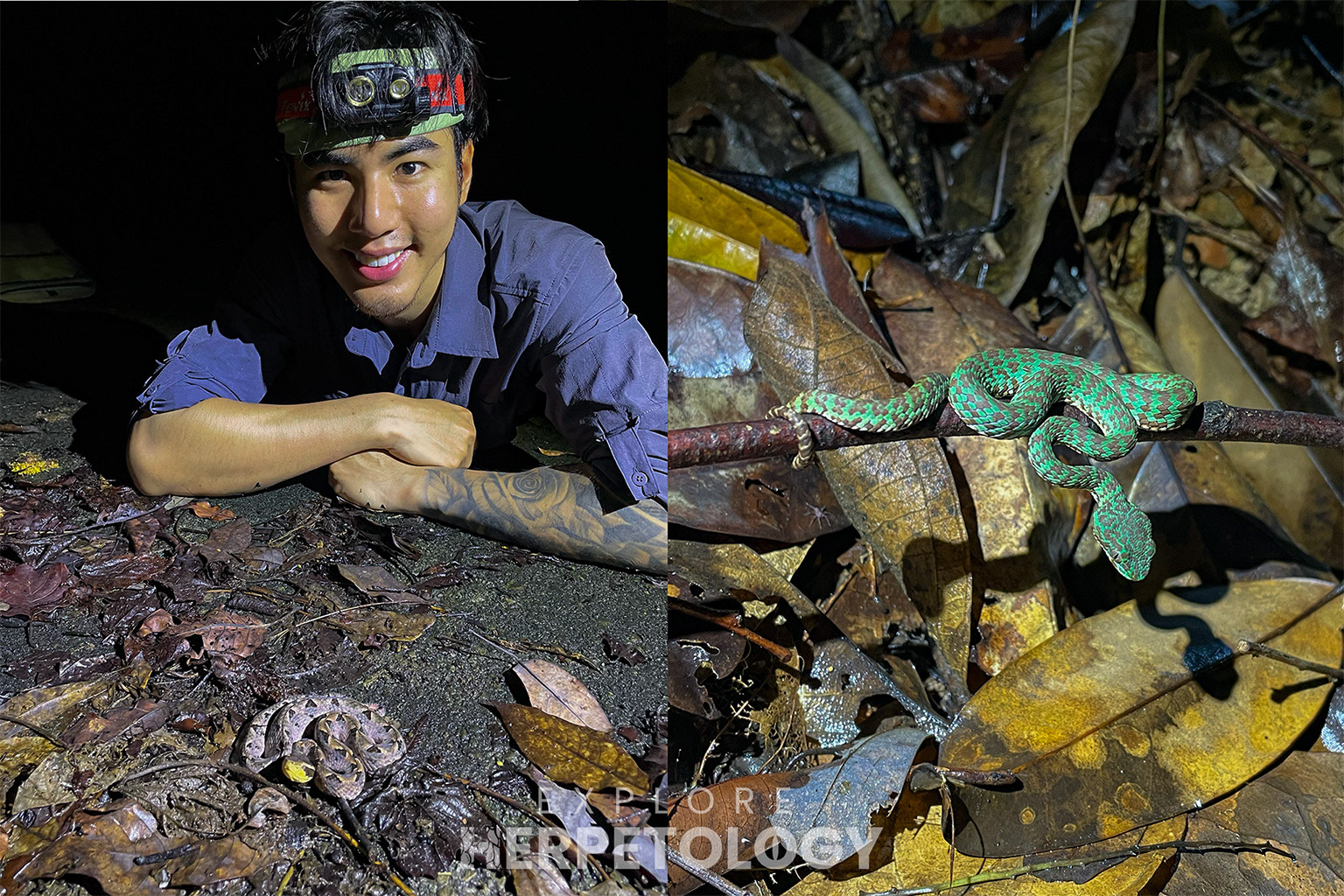
Left: Our guide Bank with the MPV. Right: Trimeresurus venustus juvenile.
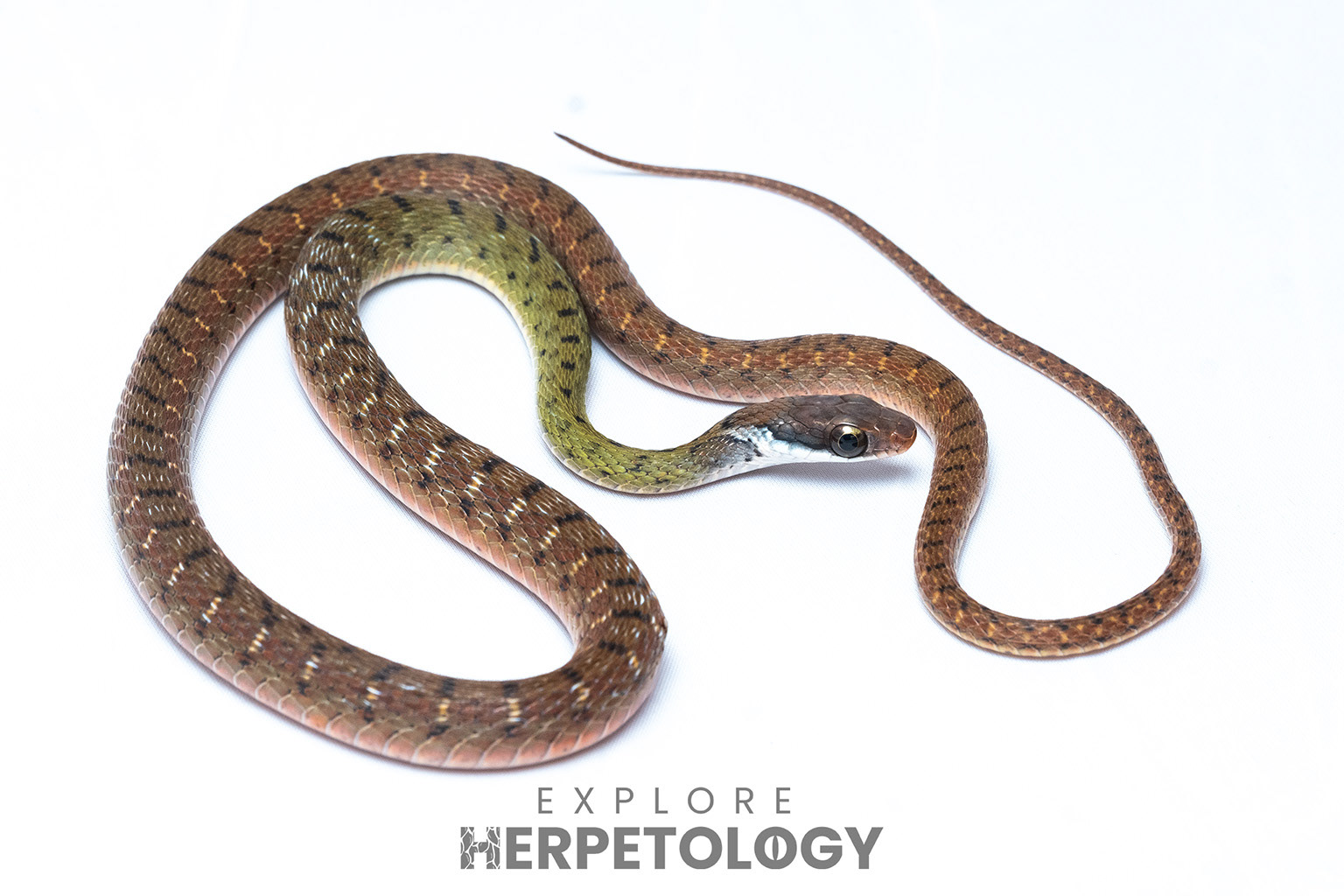
Speckle-bellied keelback (Rhabdophis chrysargos).
The following morning, we caught a golden flying snake (Chrysopelea ornata) directly outside our bungalows. This has become a regular feature of staying at this resort, and we were very happy to get a daytime snake so early in the day. We also got hands on with a Sumatran gliding lizard (Draco sumatranus). The rest of the day was spent resting.
Night 2 was dedicated to exploring the mangrove ecosystem, which we began with a boat ride targetting marine file snake (Acrochordus granulatus) and mangrove pit viper (Trimeresurus purpureomaculatus). We saw none of the latter, but were able to get hands on with 3 file snakes during our time on the water. Catching these as they come to the surface for air is much easier said that done, and Magnus dived into the water to get hands on with our first individual. The final one, an adult, was caught simply with a net we found lying in the boat. Once back on the shore, we walked a mangrove boardwalk and found 2 Malayan kraits (Bungarus candidus), our first elapid species for the trip. The second individual was the largest Malayan krait we have ever seen in our time herping South-East Asia.
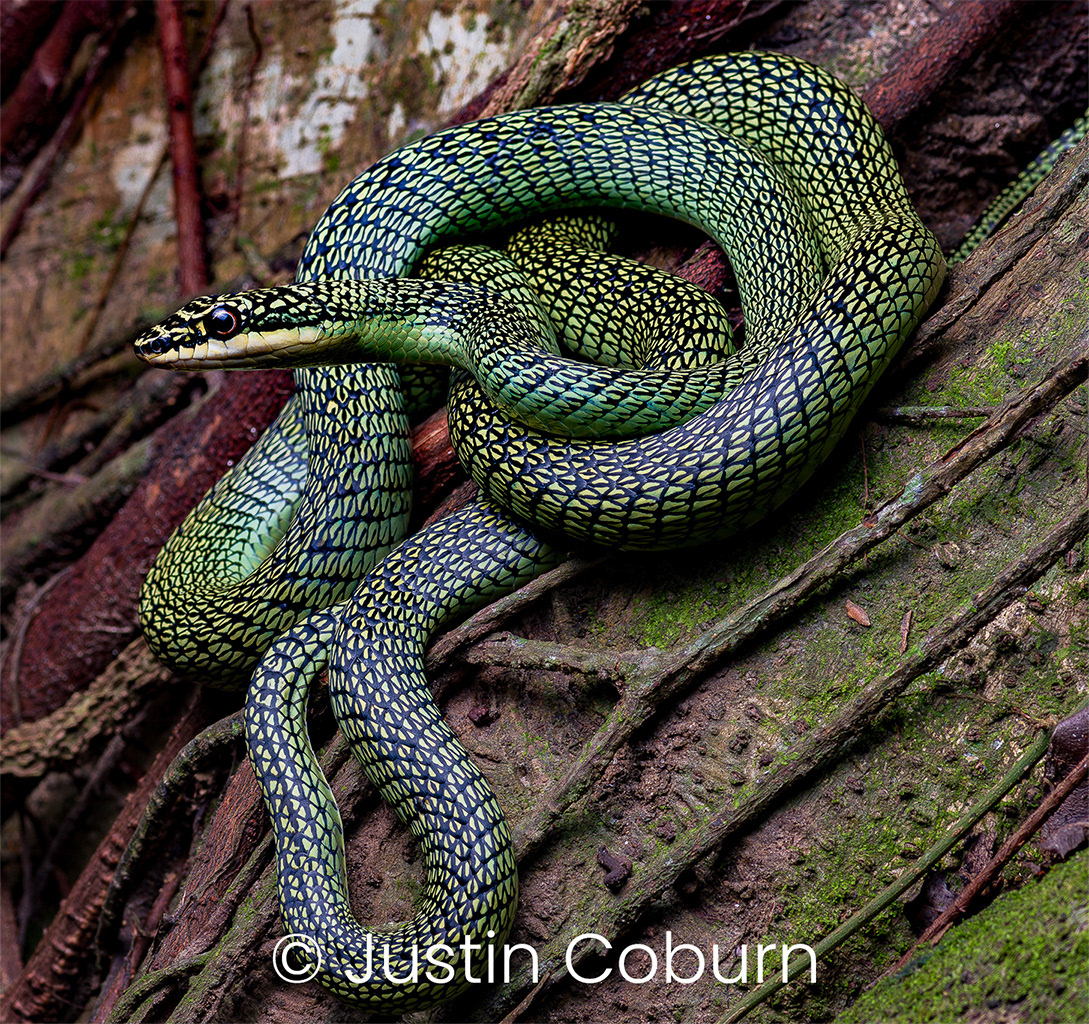
Golden flying snake (Chrysopelea ornata).
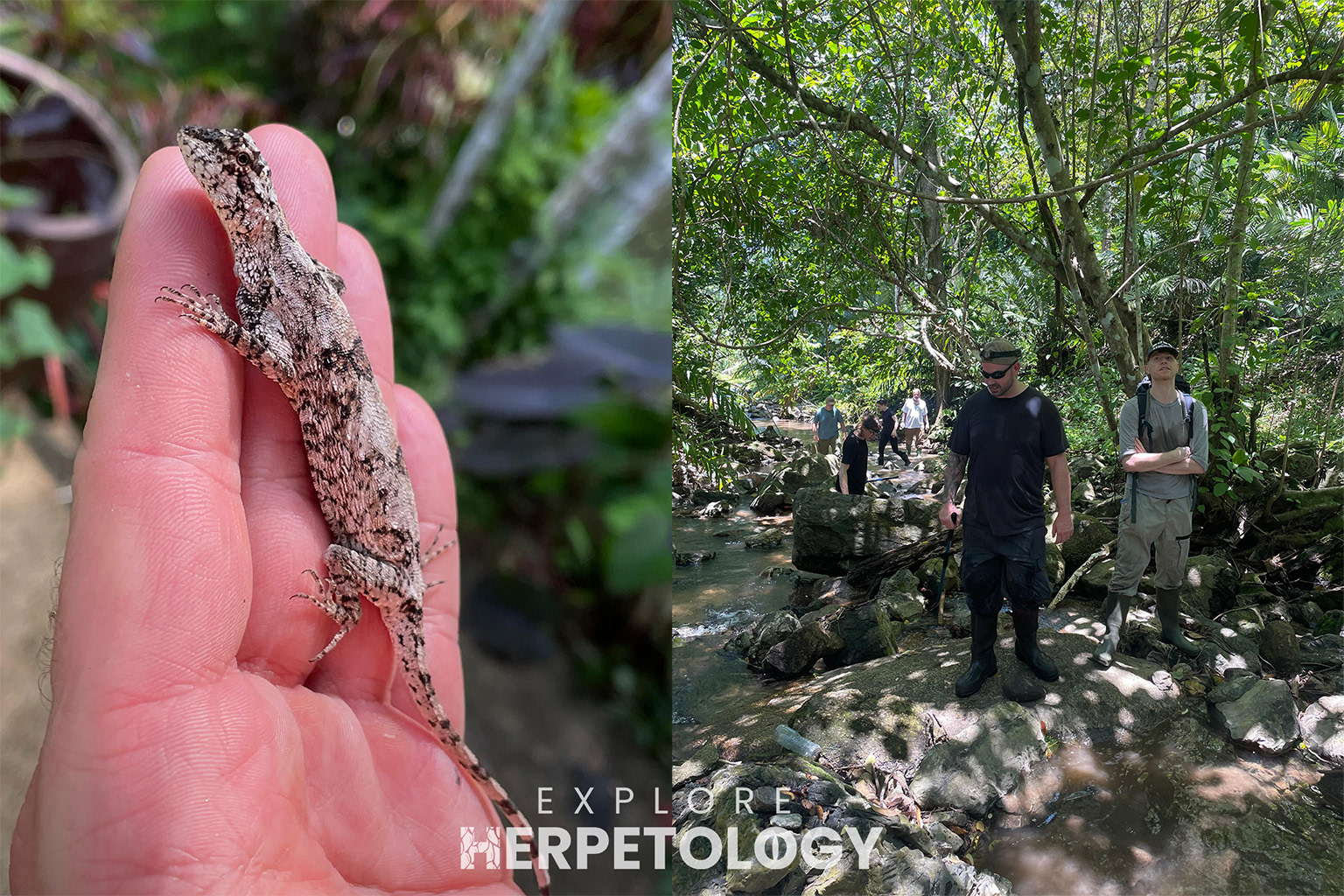
Draco sumatranus.
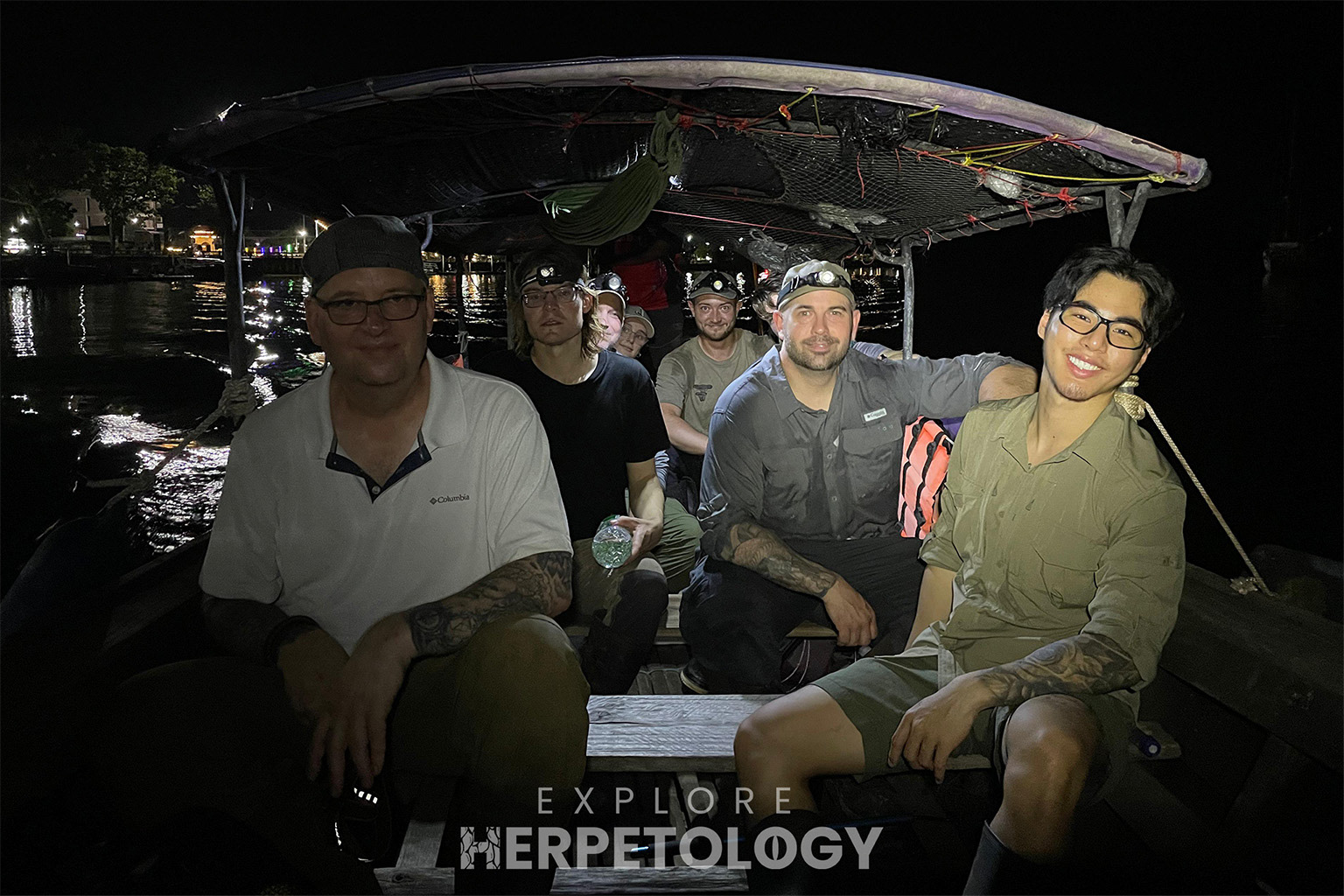
Beginning the mangrove boat tour.
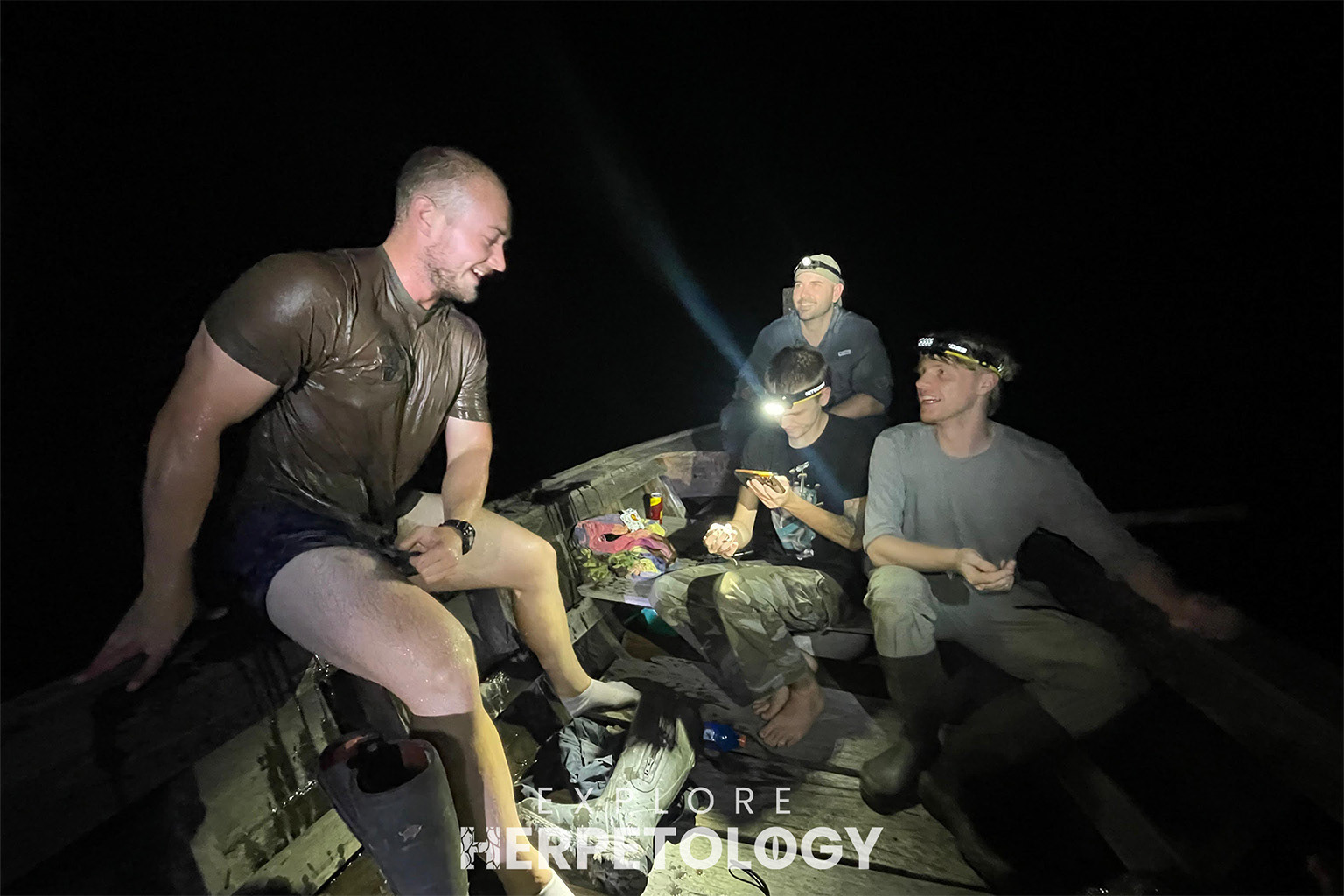
Magnus after climbing back onto the boat with our first Acrochordus.
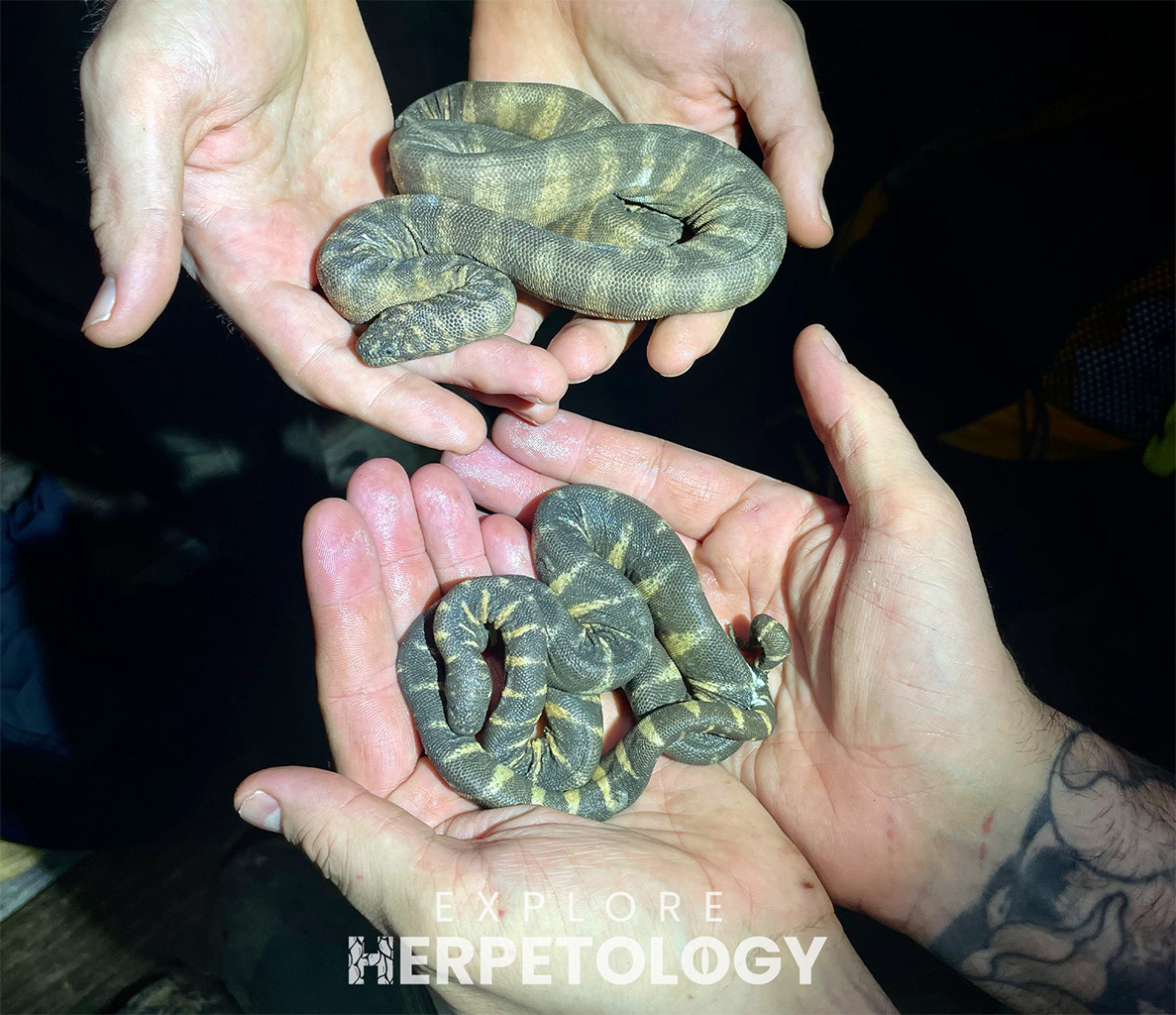
Acrochordus!
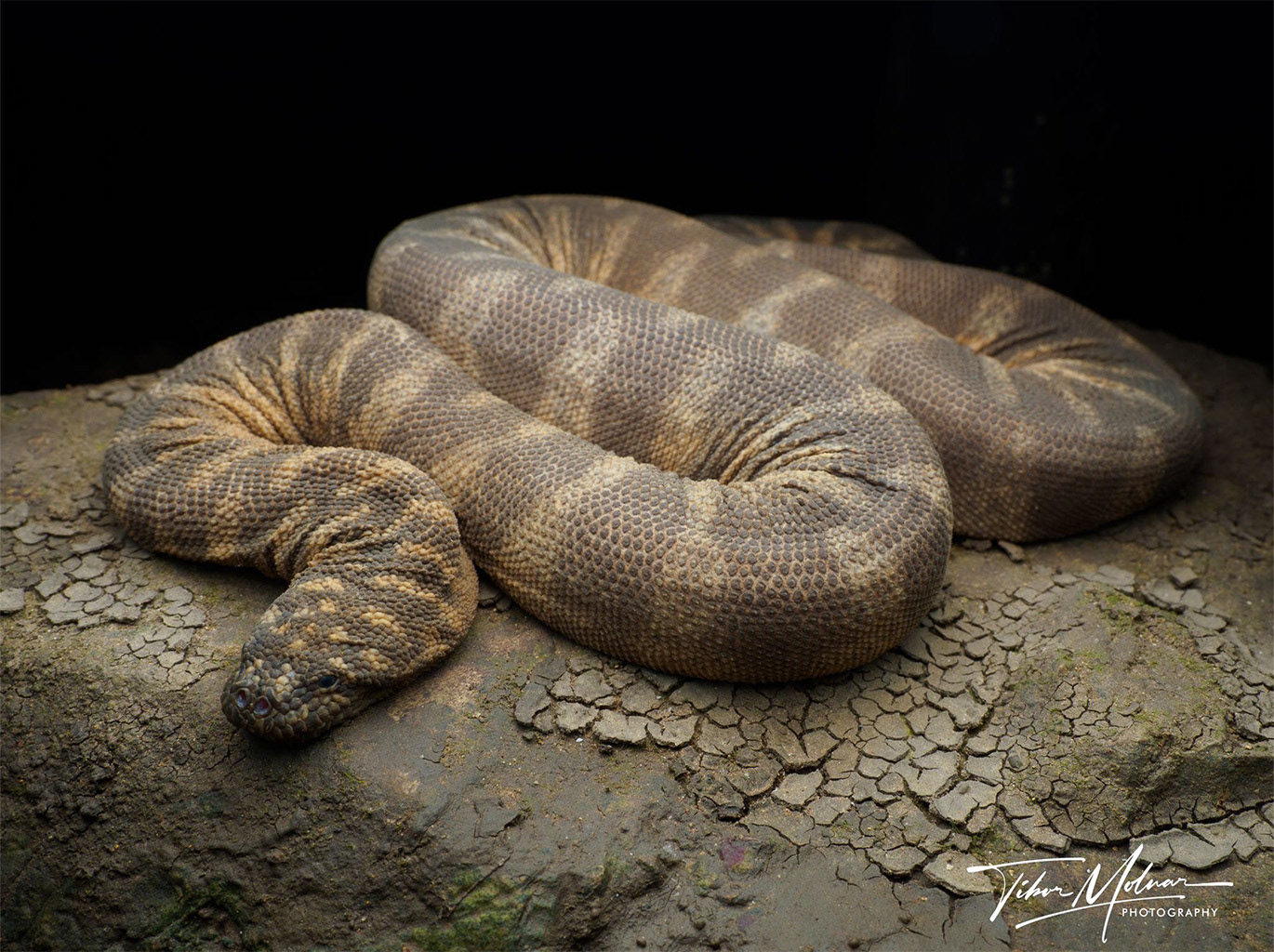
Adult marine file snake (Acrochordus granulatus).
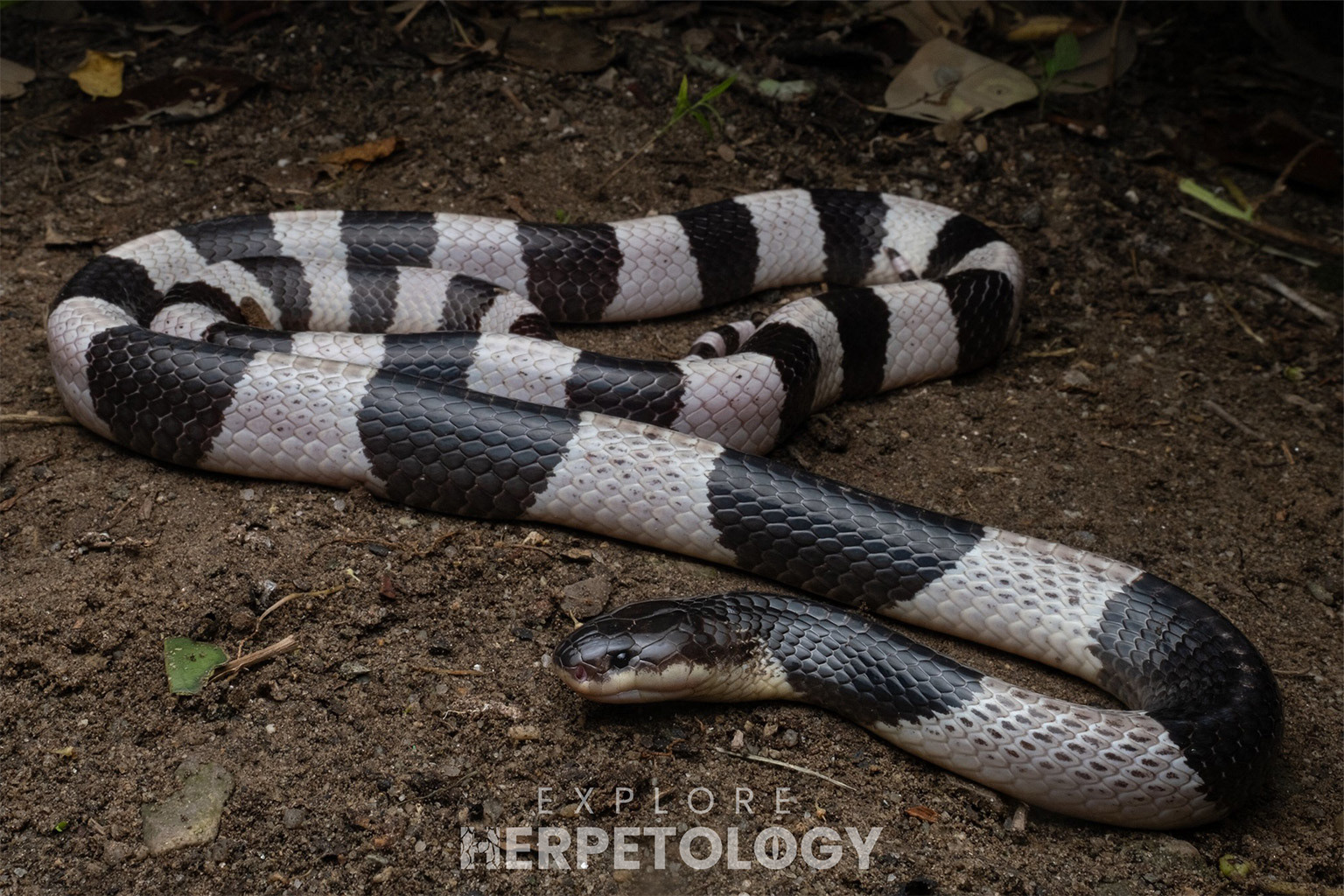
A truly giant malayan krait (Bungarus candidus).
On our last day in Krabi, we explored more limestone karst formations during the daytime, and some of our group braved wading into a cave in waist high water. This was well worth it as David retrieved our first Ridley's cave racer (Elaphe taeniura ridleyi) of the trip. Otherwise, nothing showed up until after dinner, where we chose to explore an inner-city park with a high population of Malayan pit viper. We found 2 individuals within a few minutes, as well as an oriental vine snake (Ahaetulla prasina) and a Malayan snail-eating terrapin (Malayemys macrocephala).
Further searching on the same limestone hill as the first night revealed 3 more MPV, along with a Trimeresurus venustus crossing the road - probably the most colourful individual seen on this expedition. A walk around our hotel before bed turned up one more common wolf snake (Lycodon capucinus) and an asian water monitor (Varanus salvator).
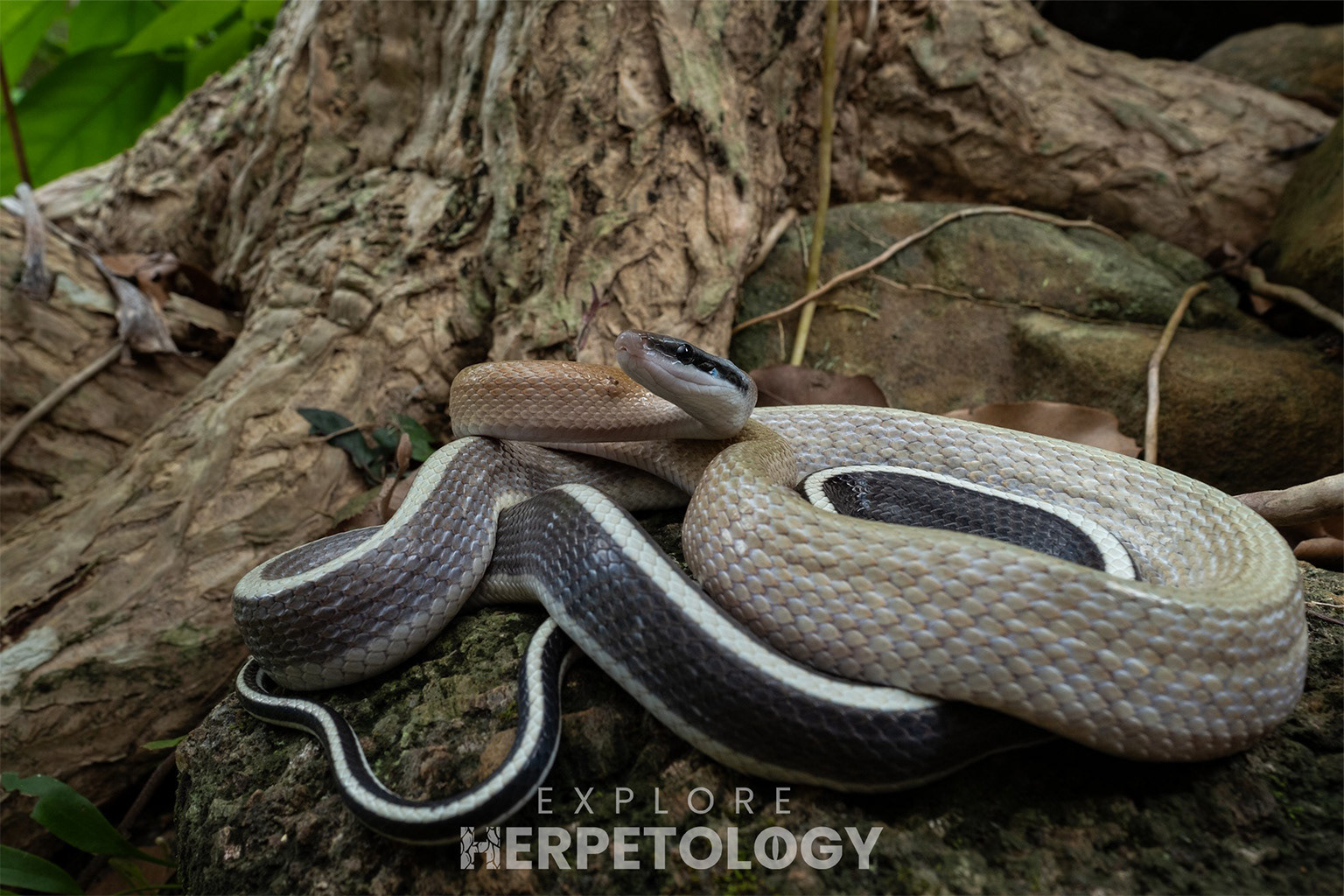
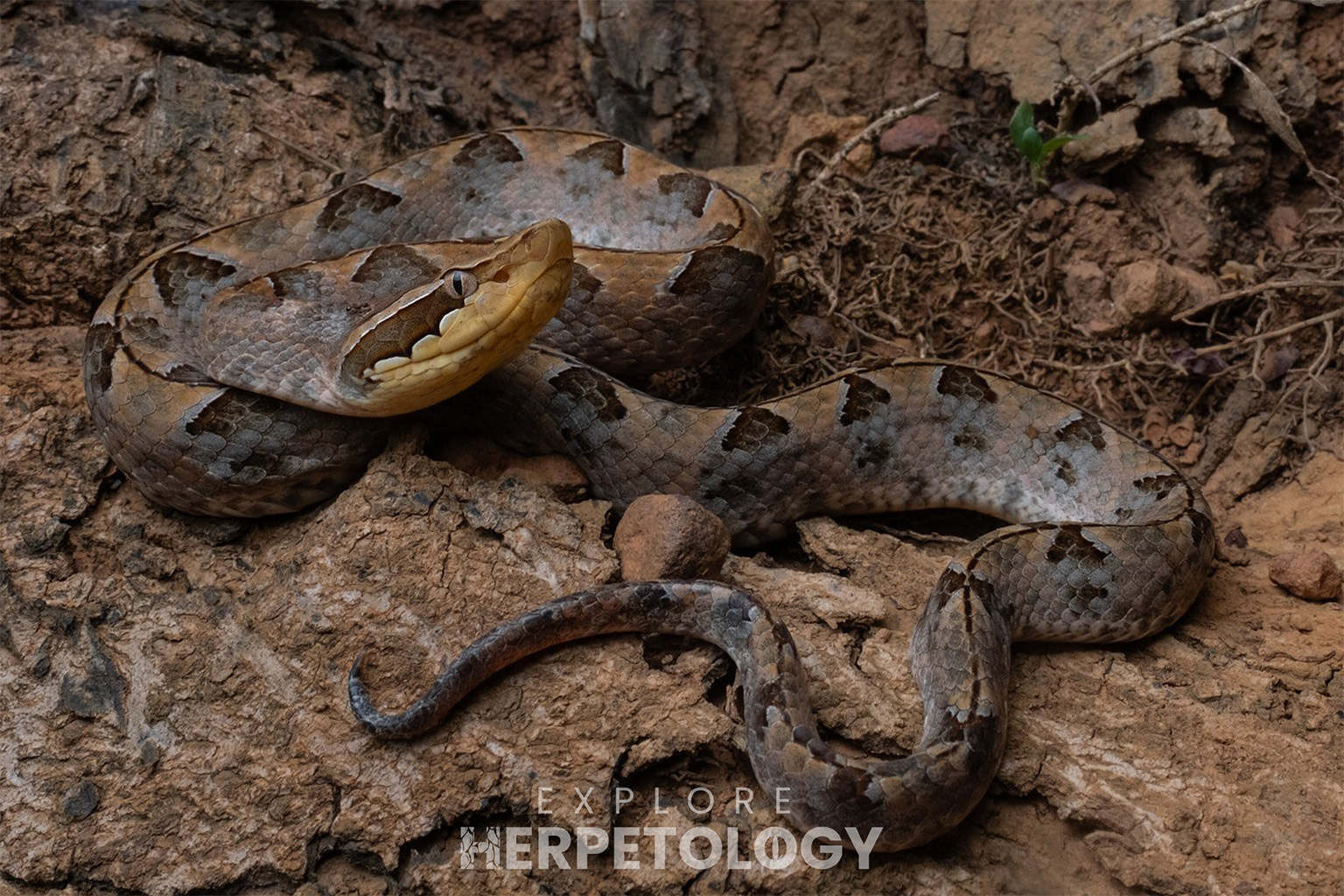
Malayan pit viper (Calloselasma rhodostoma).

Oriental vine snake (Ahaetulla prasina).
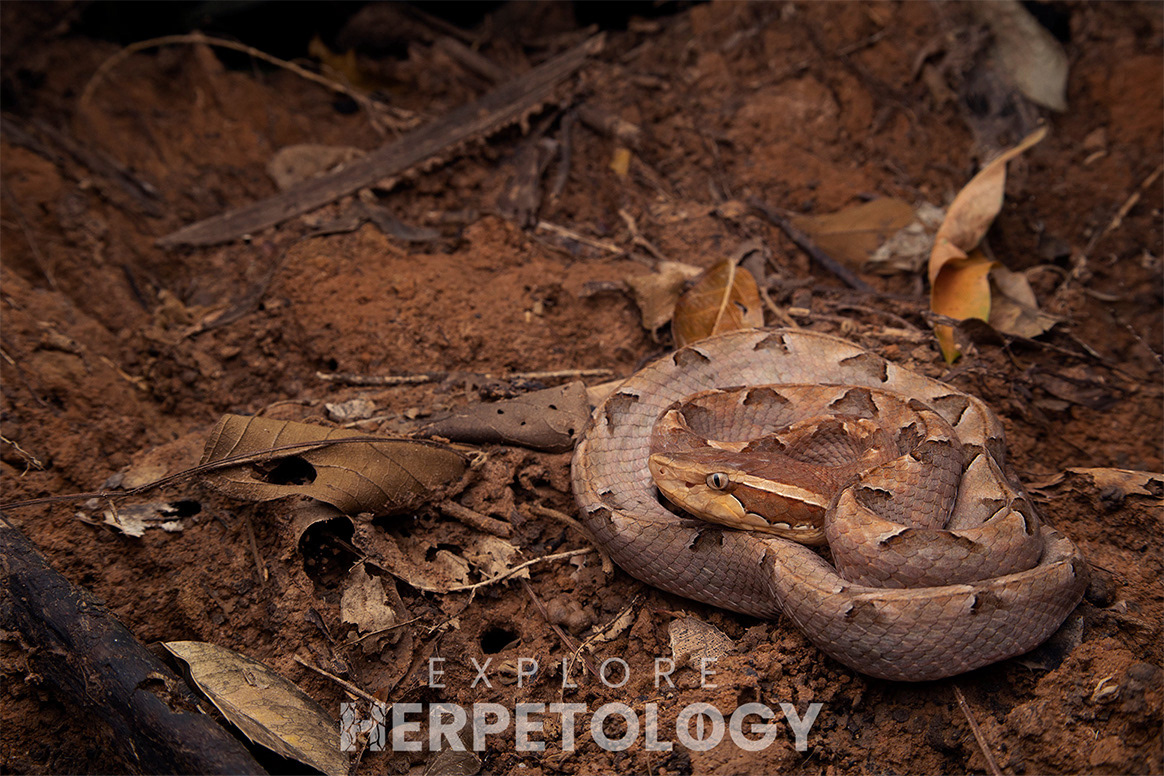
Malayan pit viper (Calloselasma rhodostoma).
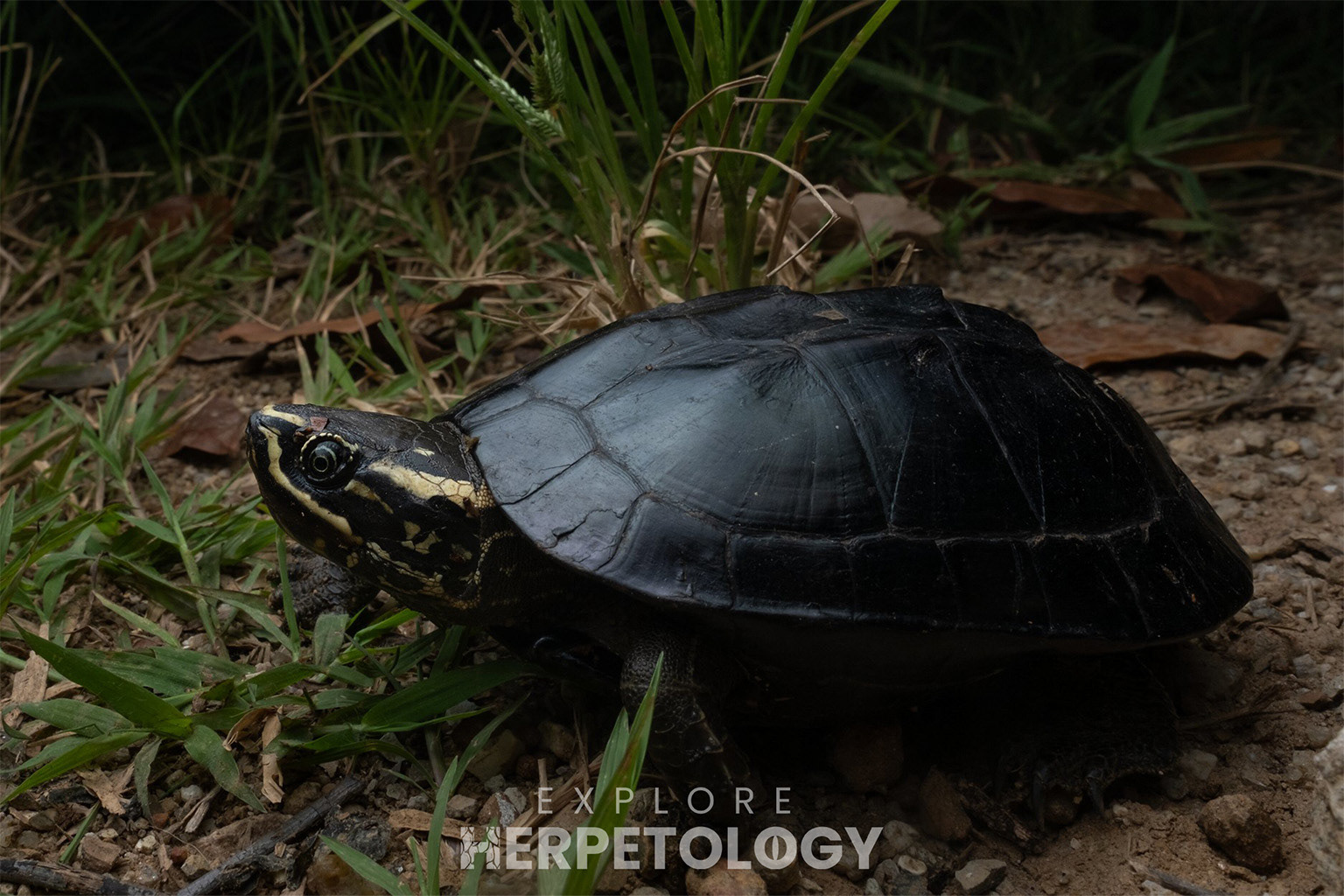
Malayan snail-eating turtle (Malayemys macrocephala).
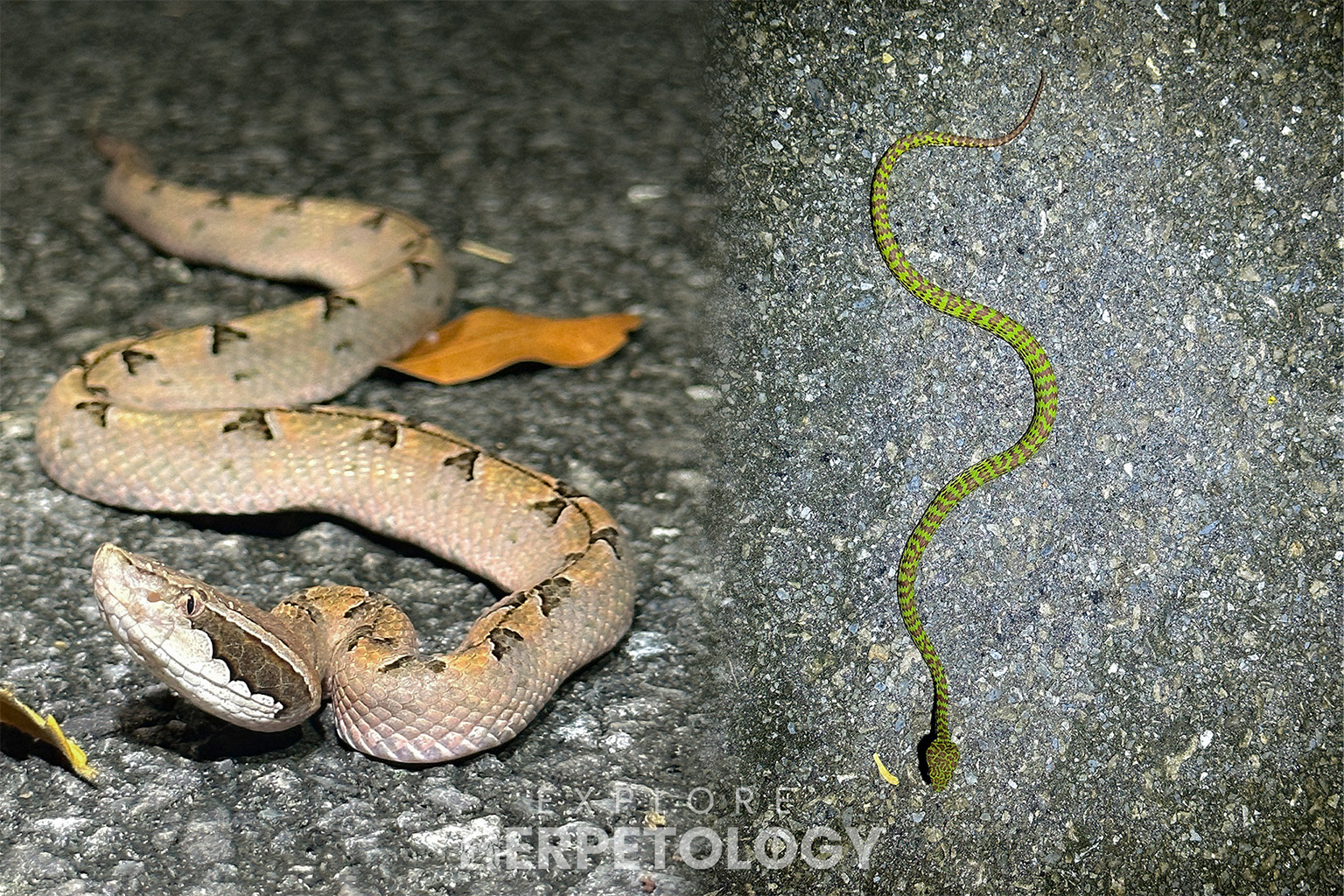
Left: MPV. Right: Trimeresurus venustus).
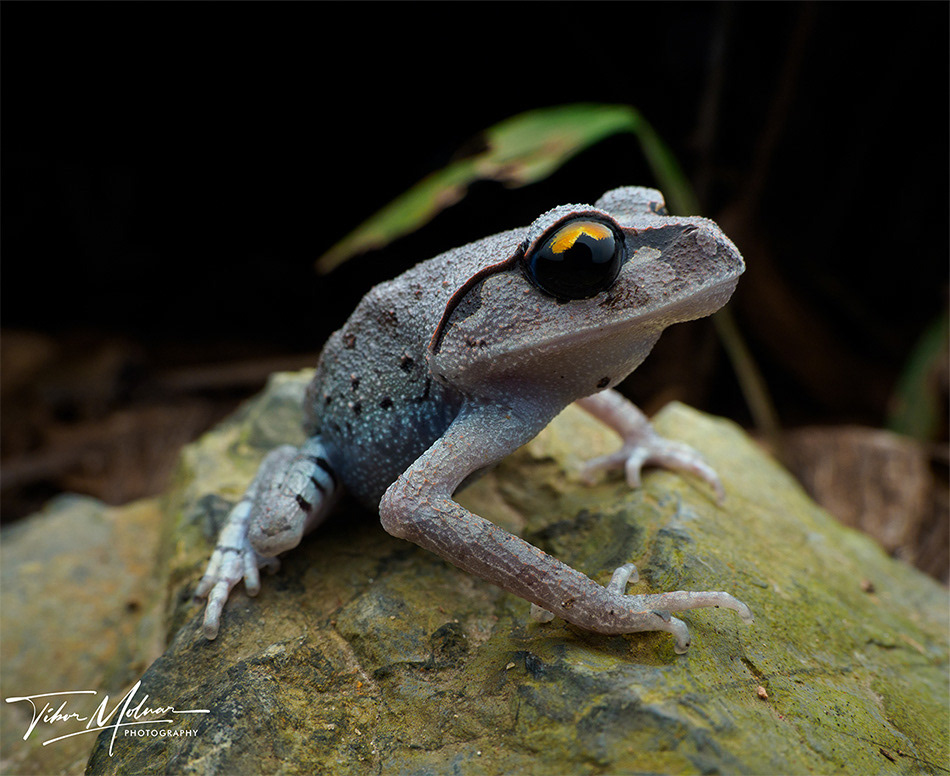
Smith's litter frog (Leptobrachium smithi).
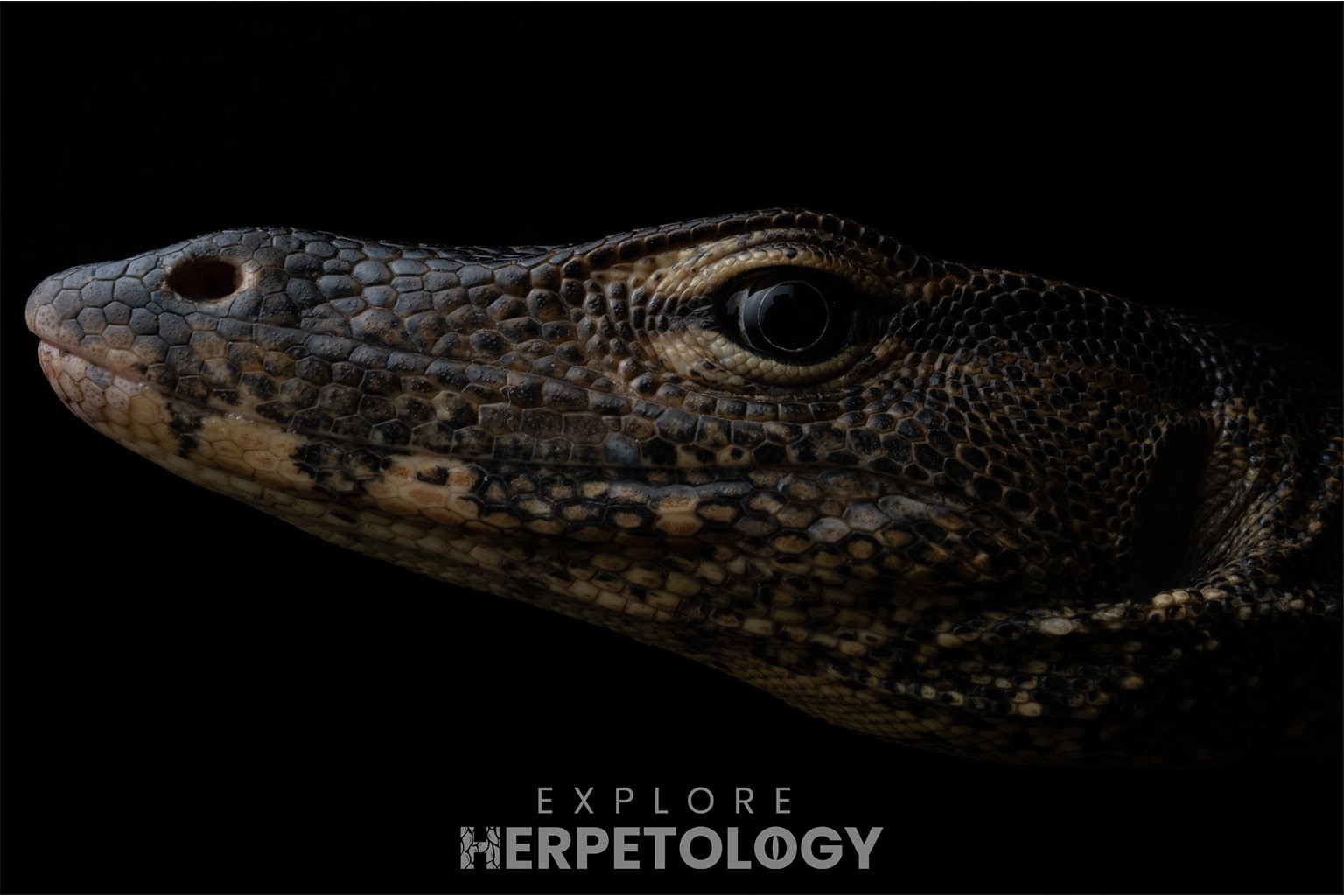
Water monitor (Varanus salvator).
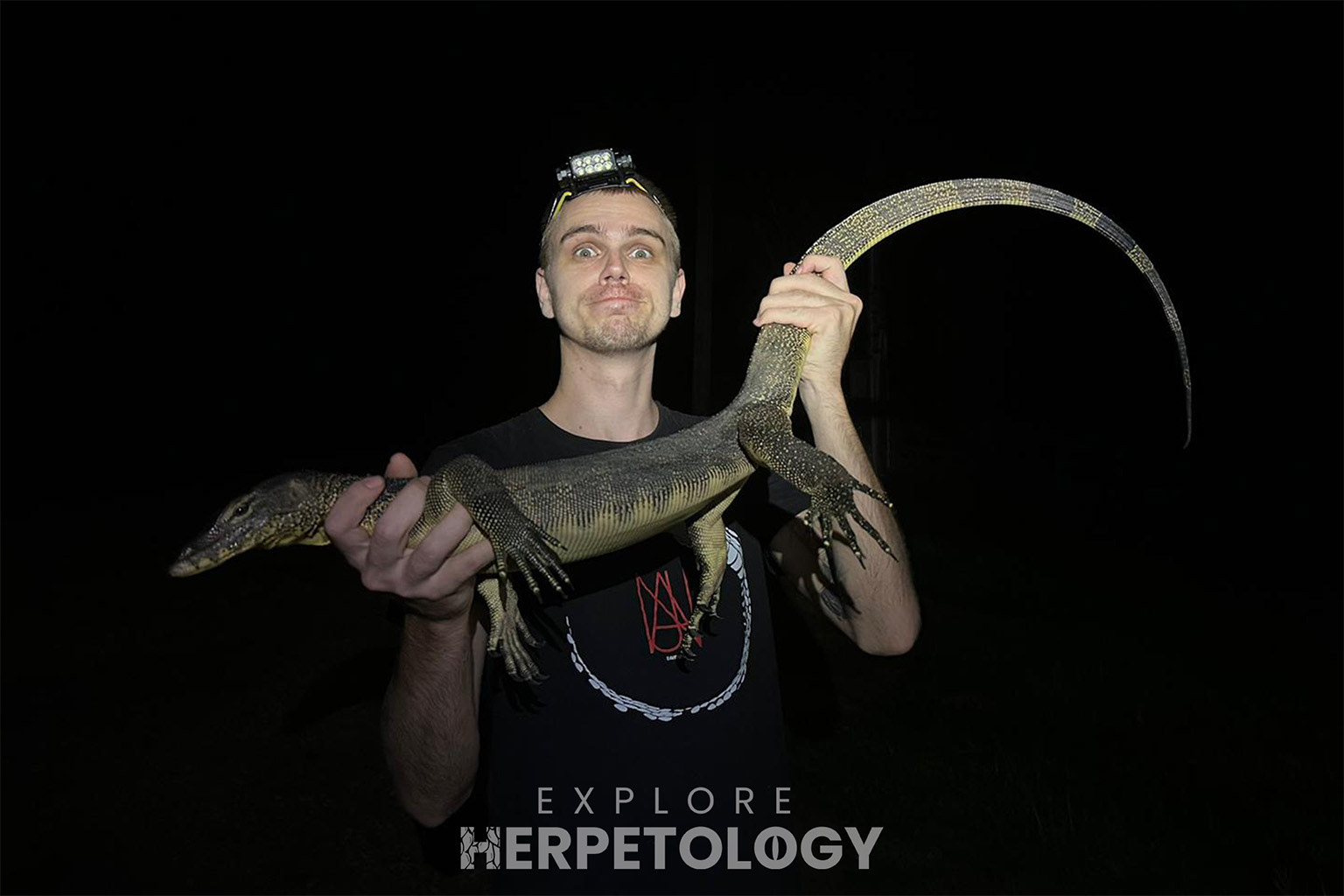
Water monitor (Varanus salvator).
TRANG (1st - 3rd)
After 3 days in Krabi, we said goodbye the the very kind family at Khao Phanom Bencha Mountain Resort and moved a short distance south to Trang province, where we would spend the following 2 nights. En-route, we spotted a clouded monitor lizard (Varanus nebulosus) stuck in the centre-parting of the highway. This was a very sketchy retrieval job but we executed it perfectly and surely saved this lizard from death.
After enjoying the weekend night market, we ventured into an area of primary dipterocarp rainforest for our first proper taste of tropical sunda herping. The biodiversity at this location is absolutely insane, and we were treated to an absolutely giant (almost 3 meter) dog-toothed cat snake (Boiga cynodon) spotted by Justin as soon as we got our of the cars. From here, things were quite slow for a while. Long periods without snakes are typical of these rich lowland rainforests, so we stayed committed and slowly but surely began racking up species.
We caught a juvenile purple kukri snake (Oligodon purpurascens), a Malayan vine snake (Ahaetulla mycterizans), several oriental vine snakes (Ahaetulla prasina), a juvenile white-bellied rat snake (Ptyas fusca), 3 triangle keelbacks (Xenochrophis trianguligerus) and a large bengkulu cat snake (Boiga bengkuluensis). A small but significant find was a "Tenasserim form" collared reed snake (Calamaria cf. pavimentata), the first our team have ever encountered.
However, the best was truly saved for last. While the group were getting back together to share and photograph finds, Rupert was walking slowly back to the cars and spotted a very large red-headed krait (Bungarus flaviceps) crawling on the edge of the path. This was our number one target for the location and arguably the biggest target for many people within our group.
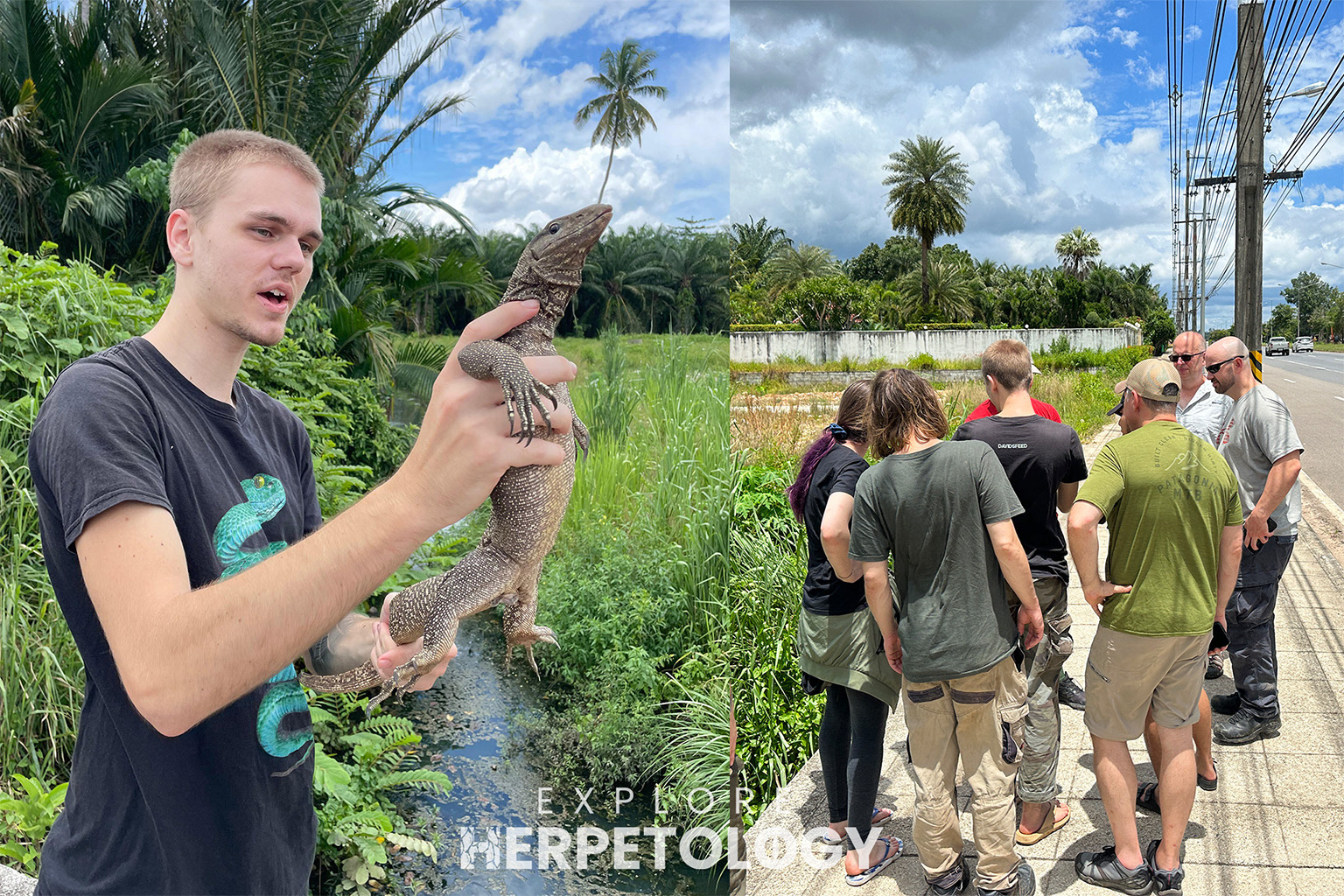
Clouded monitor (Varanus nebulosus).
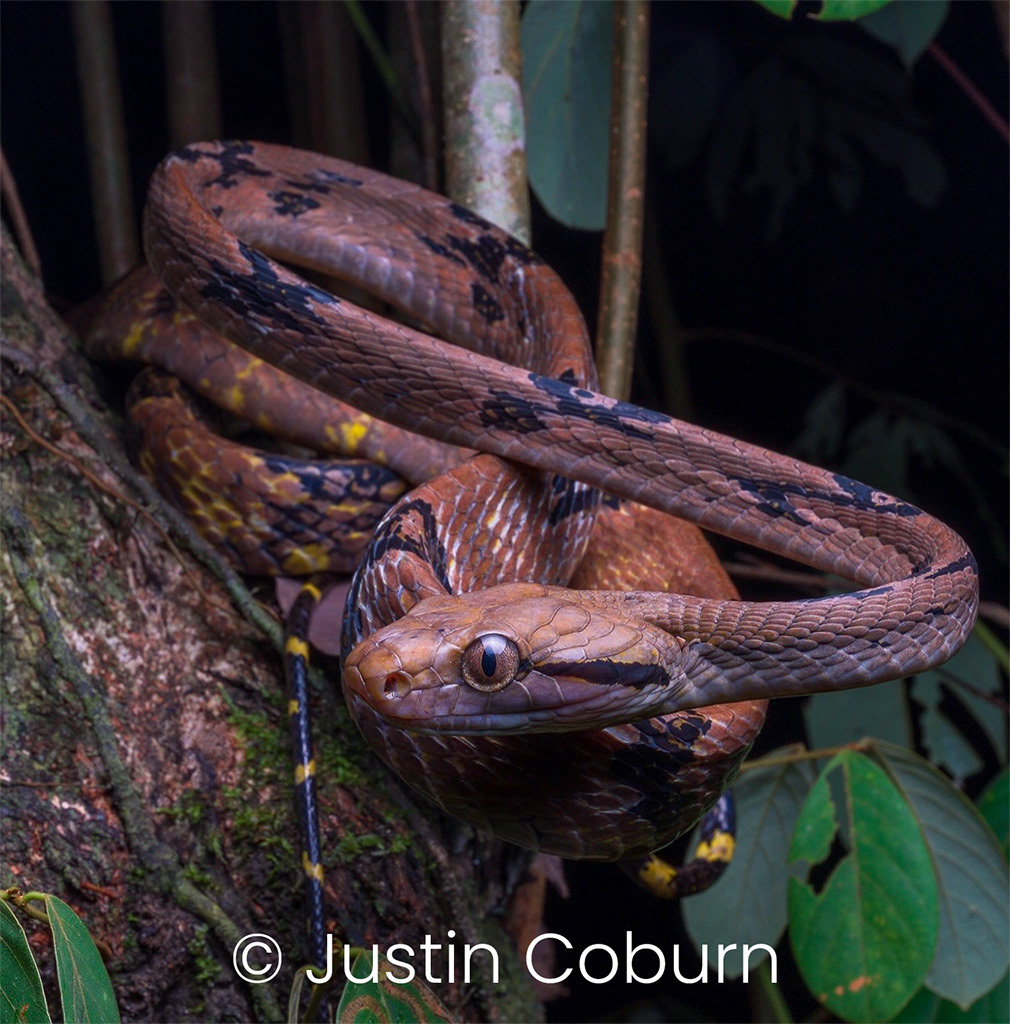
Dog-toothed cat snake (Boiga cynodon).
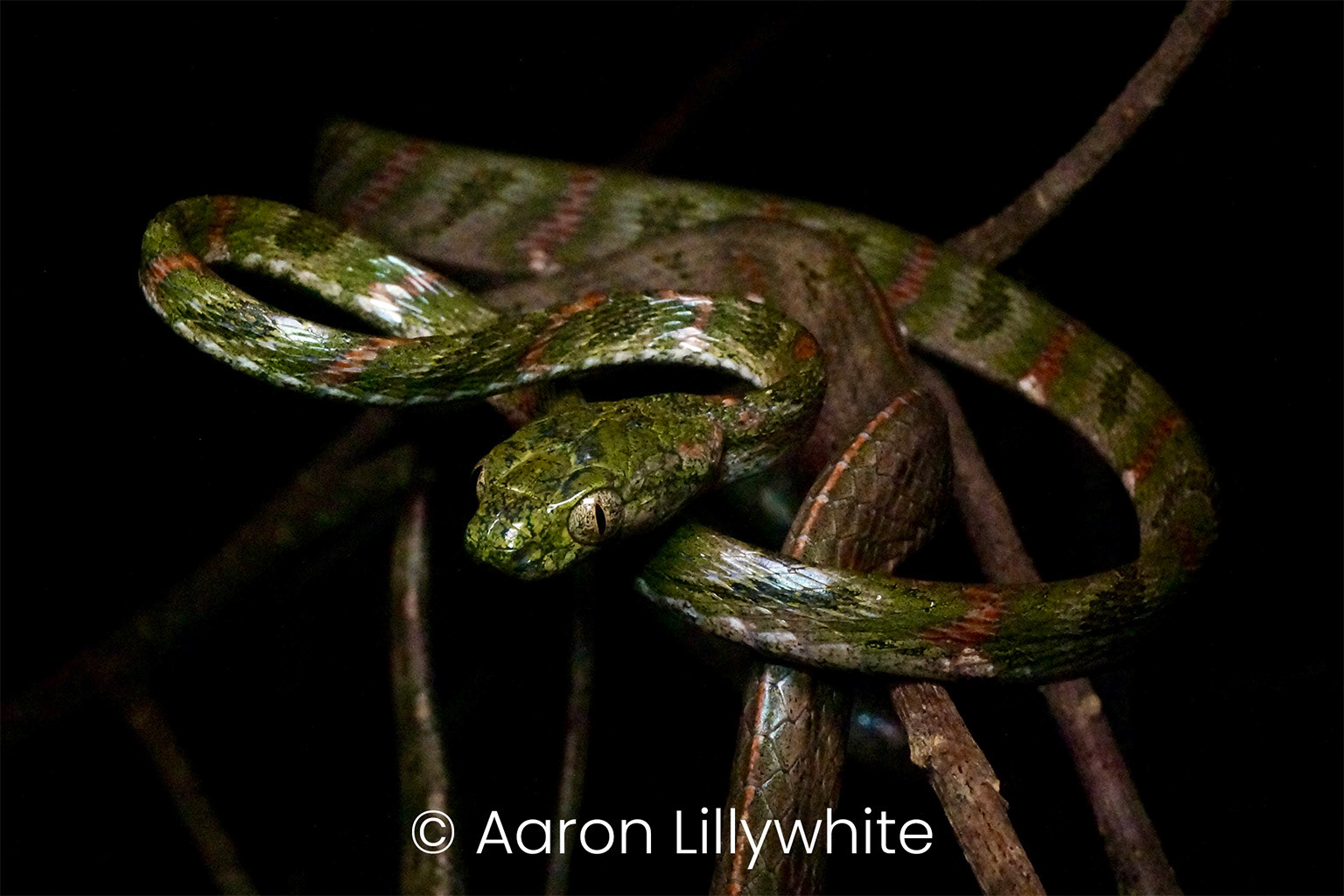
Bengkulu cat snake (Boiga bengkuluensis).
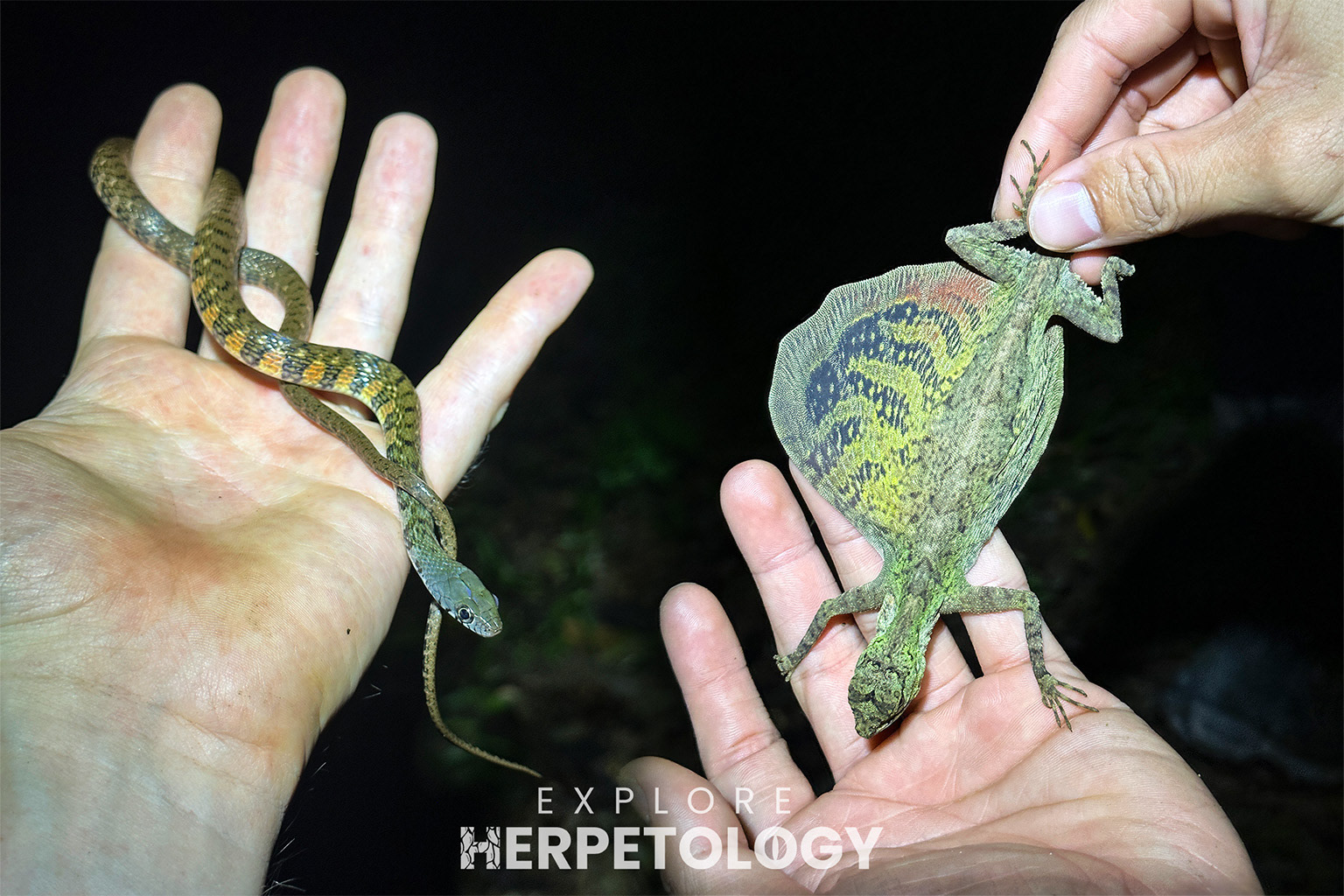
Left: Xenochrophis trianguligerus. Right: Draco blandfordi.
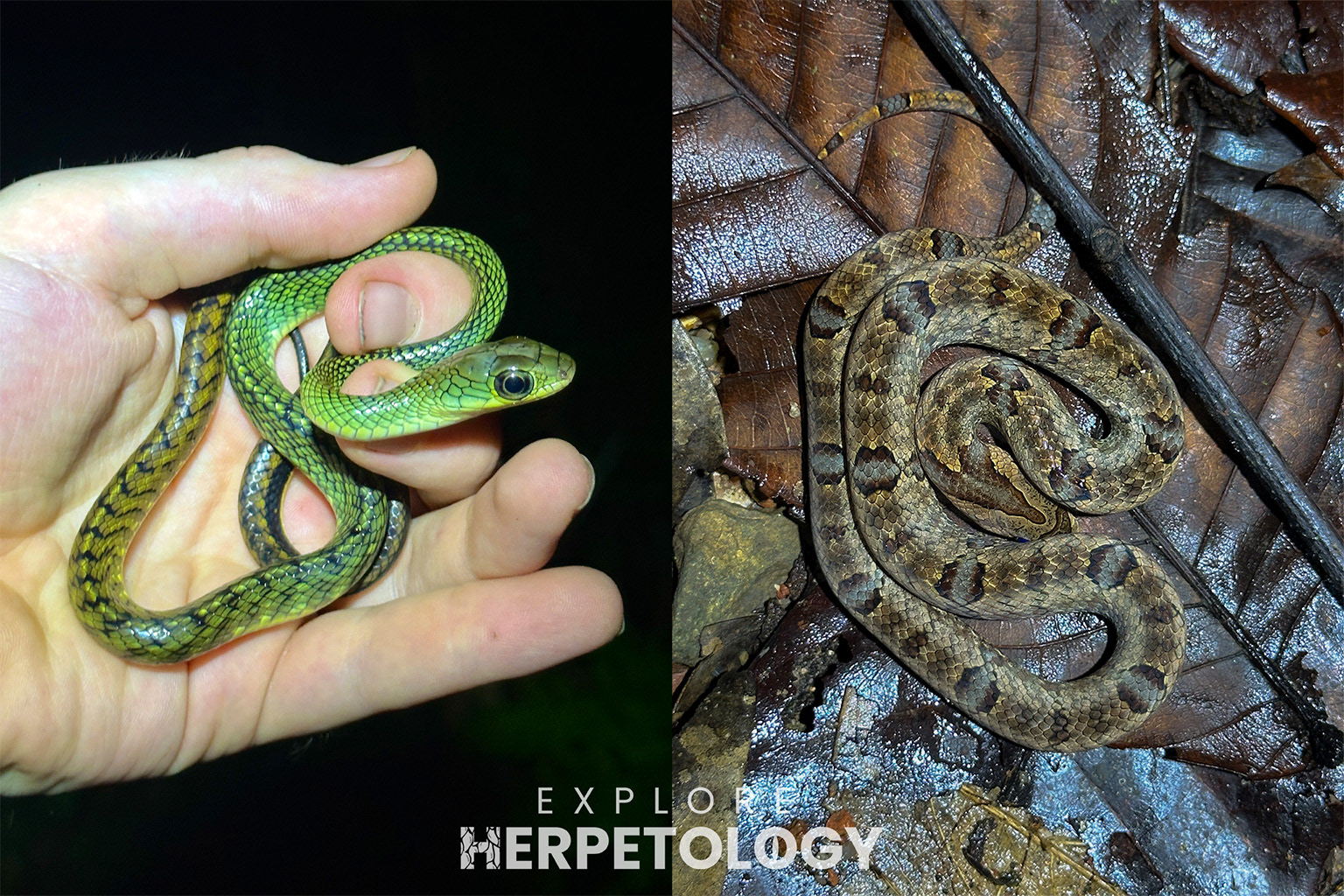
Left: Ptyas fusca. Right: Oligodon purpurascens.
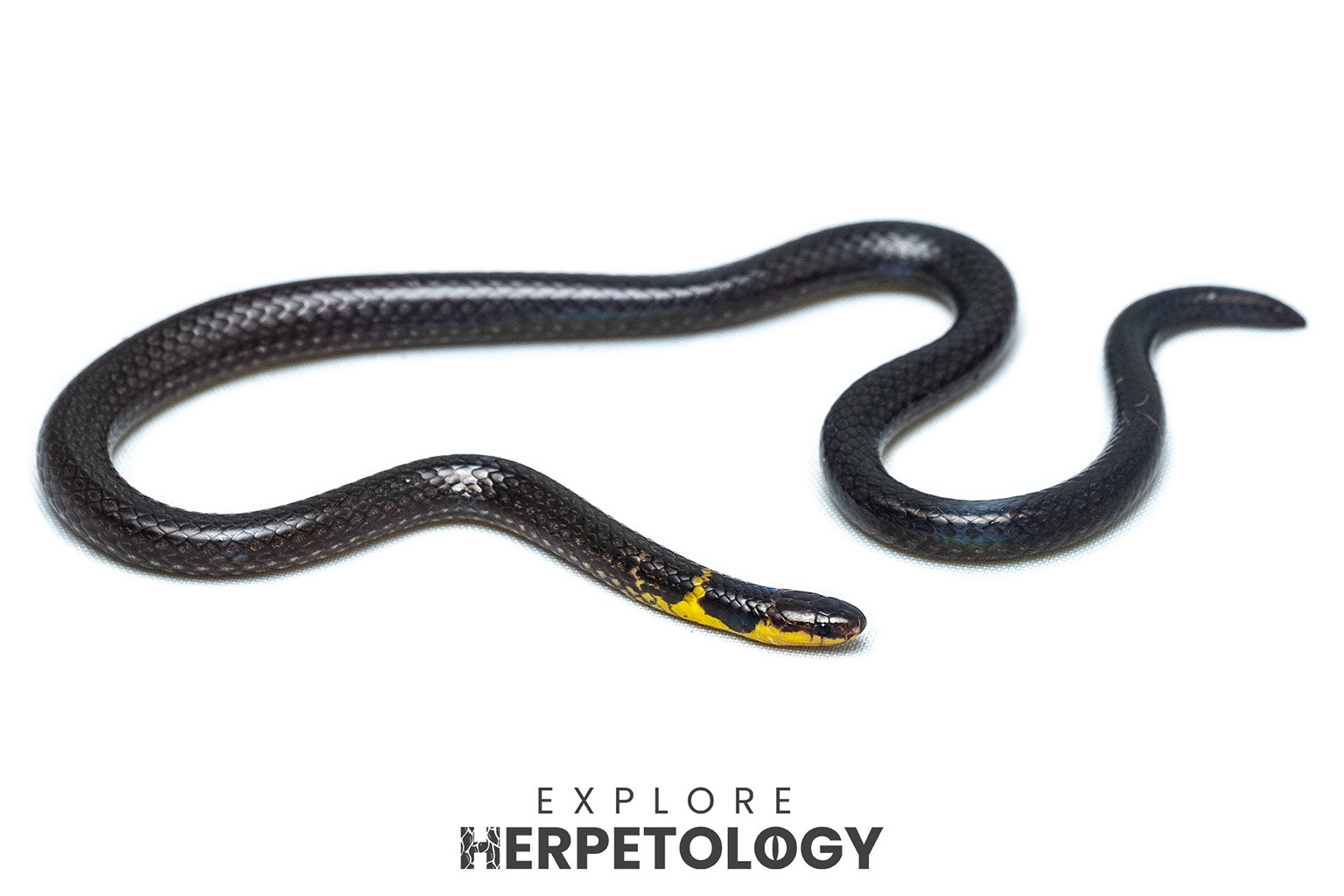
Collared reed snake (Calamaria cf. pavimentata).
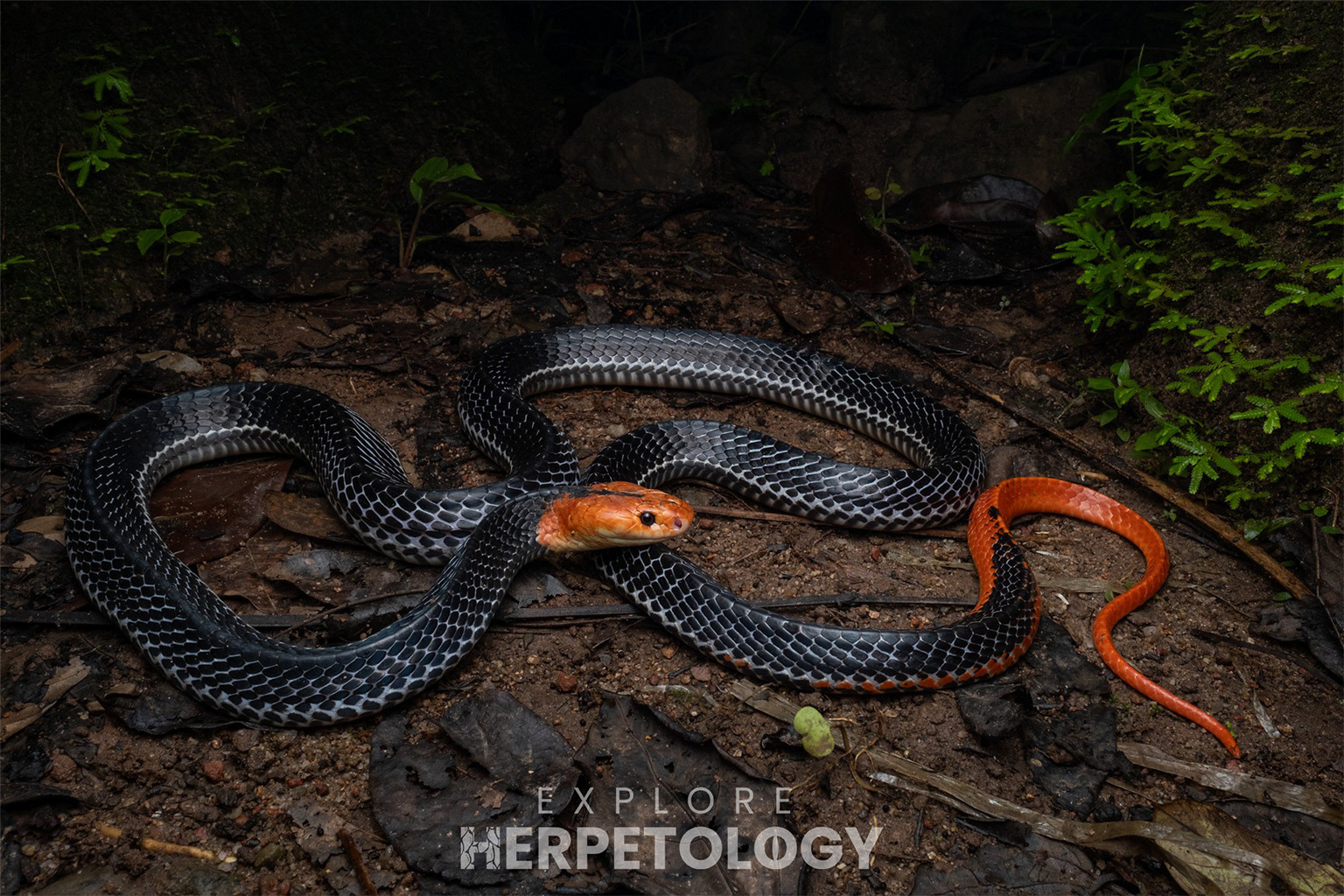
Red-headed krait (Bungarus flaviceps).
For our only full day in Trang, we drove out to a limestone karst area where we have had a lot of daytime success for snakes while herping here in the past. This trend continued, as we road cruised a paradise flying snake (Chryosopelea paradisi) minutes after arriving. After picking it up off the road, we realised that it had been clipped by a car or motorbike. We assessed the injuries and determined that they could be treated. Therefore, instead of photographing the snake, we held onto it and brought it to a veterinarian in Trang city. The injury required open-heart surgery and a long recovery process (we held onto the snake for almost 2 months after the operation), but we are very happy to report that the snake made a full recovery and was released back into the wild at the same location it was caught in late October 2024.
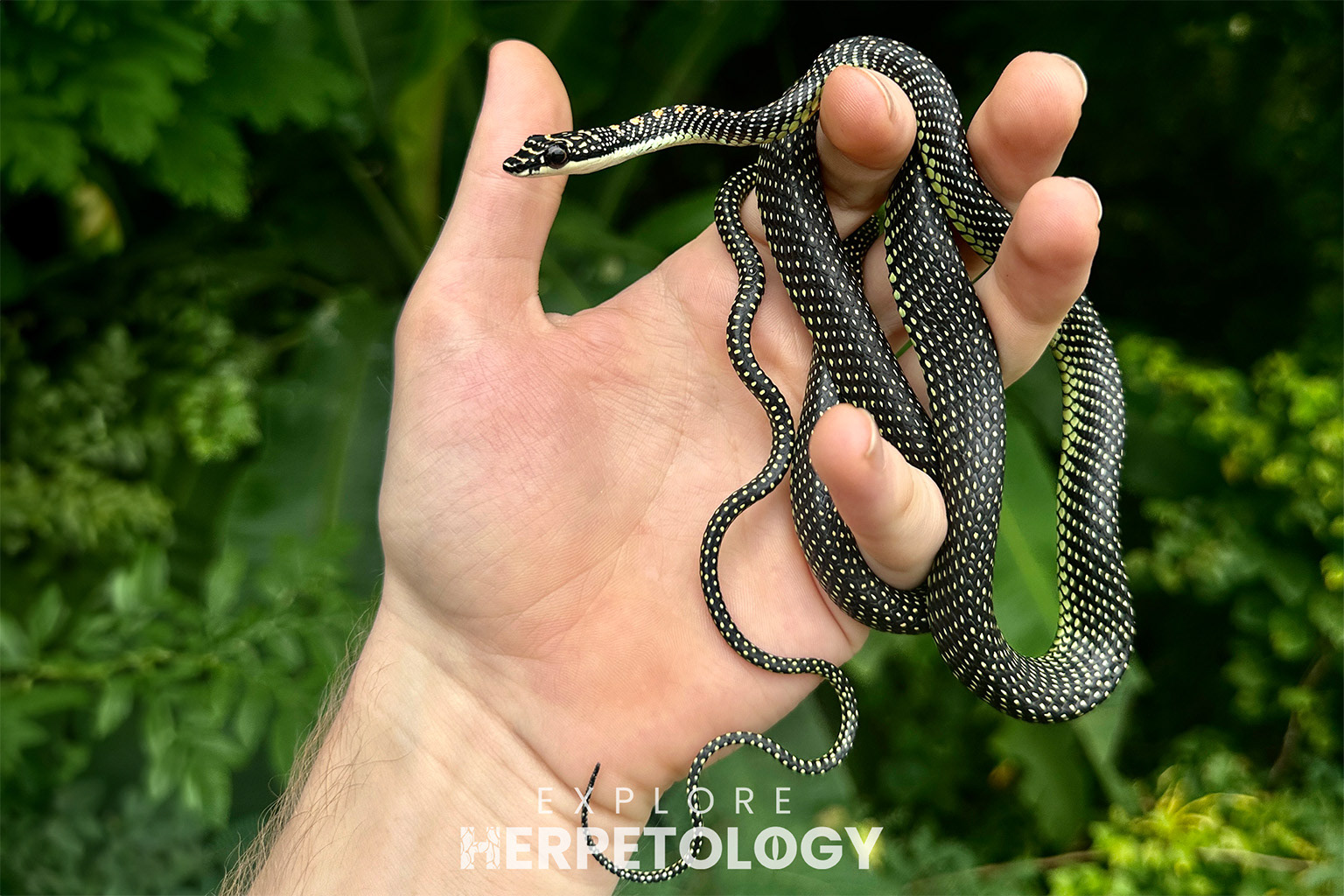
Chrysopelea paradisi moments after capture.
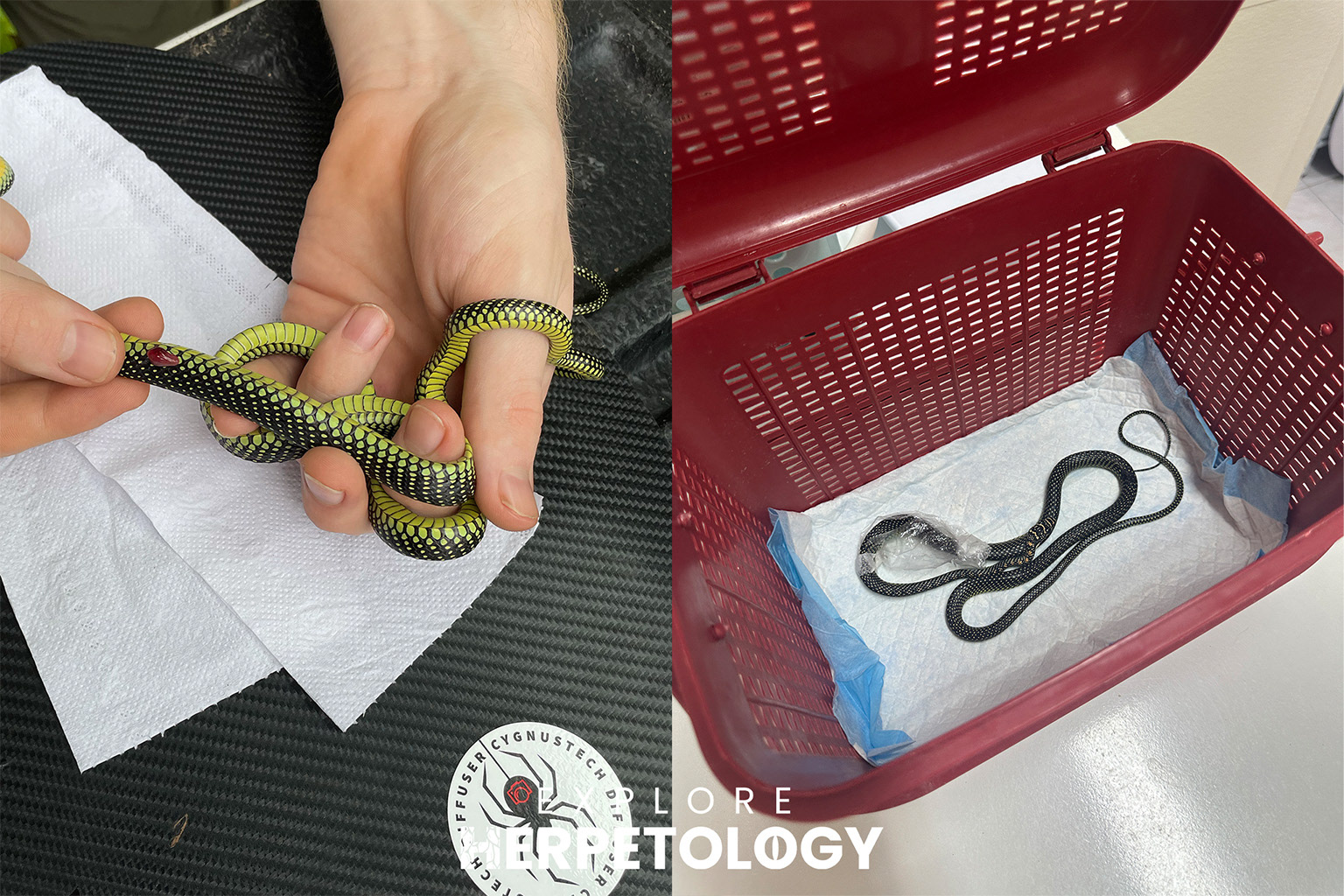
The heart was visibly beating outside the body.
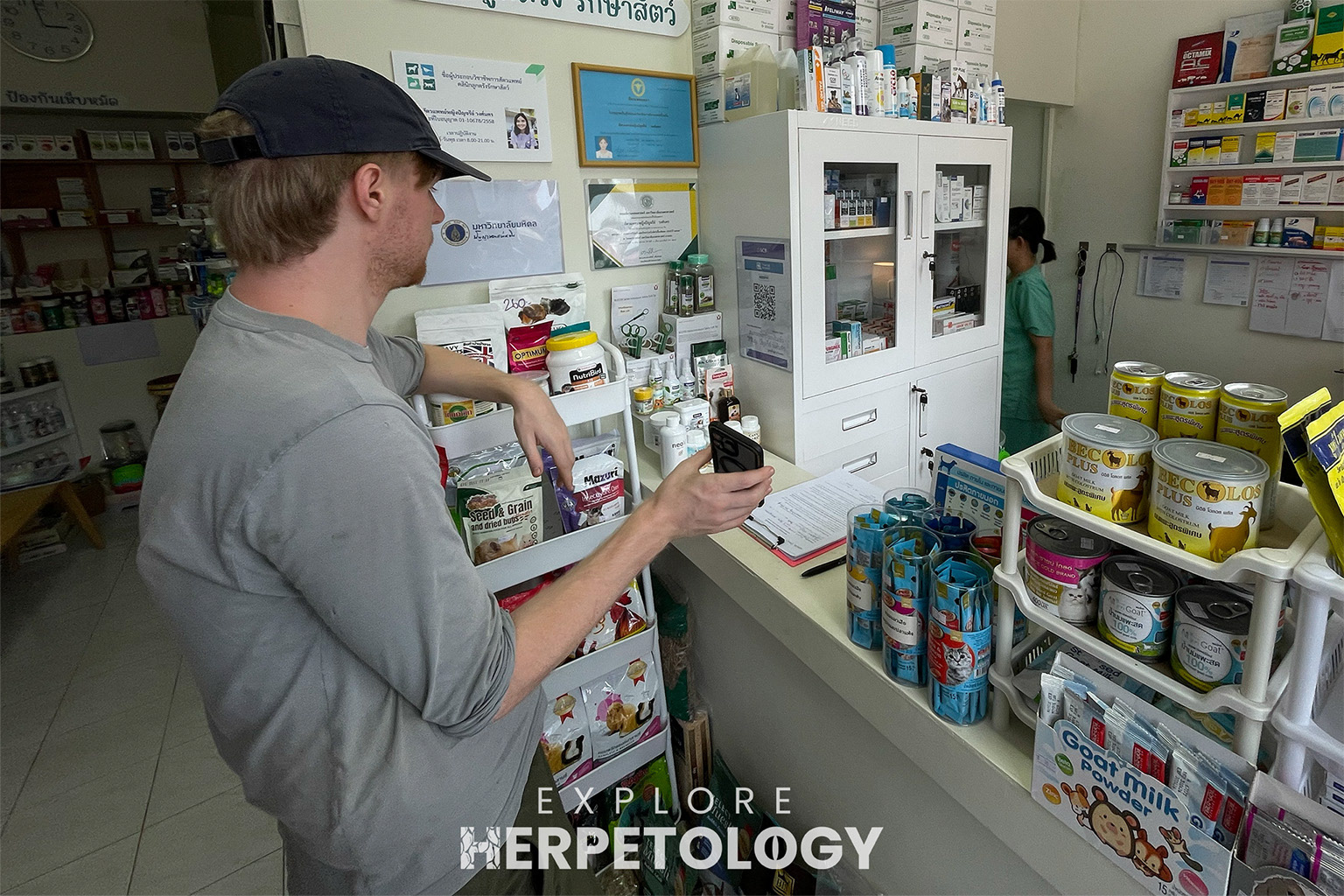
Rupert arranging the handover to the vet.
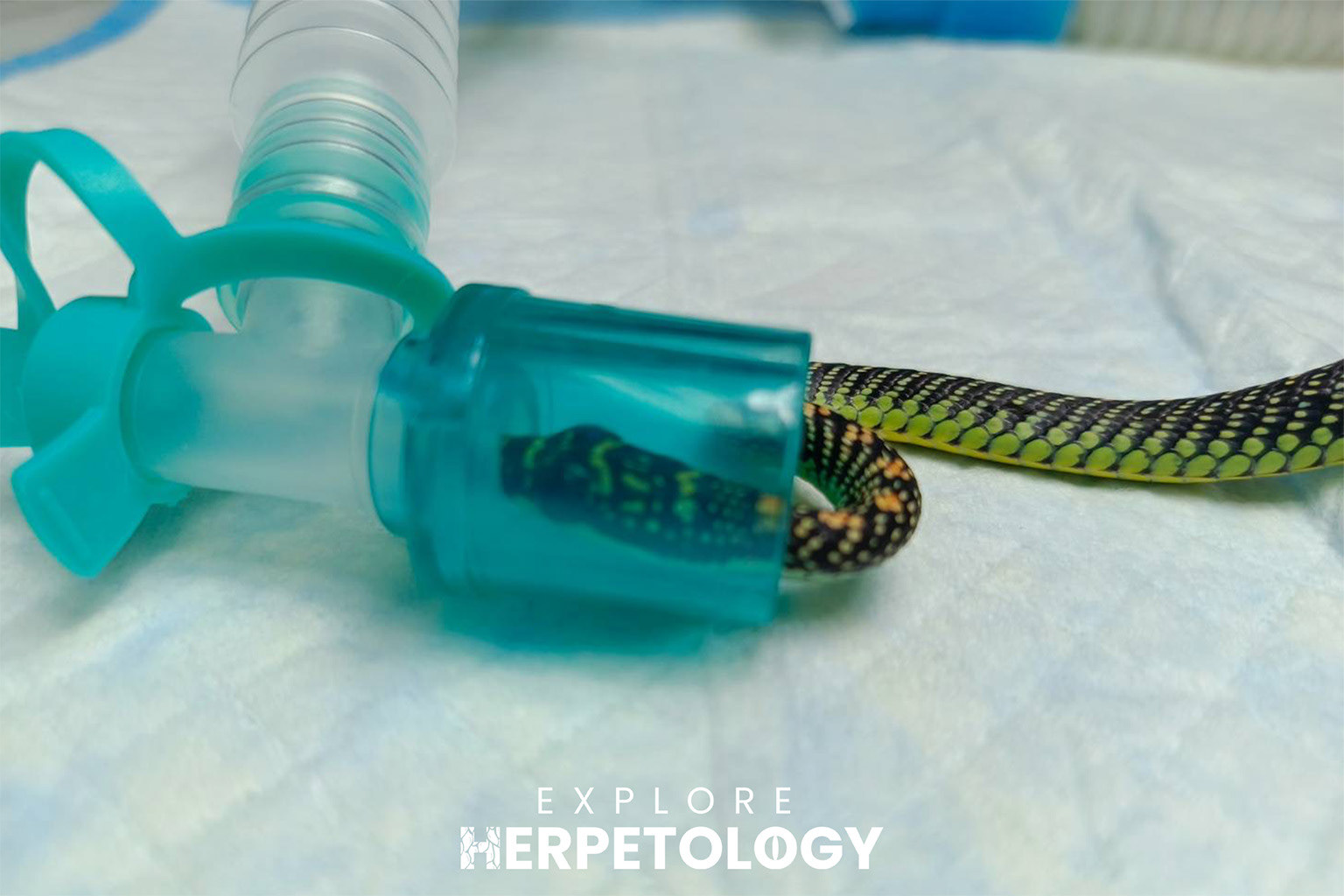
Putting the snake under euthanasia.
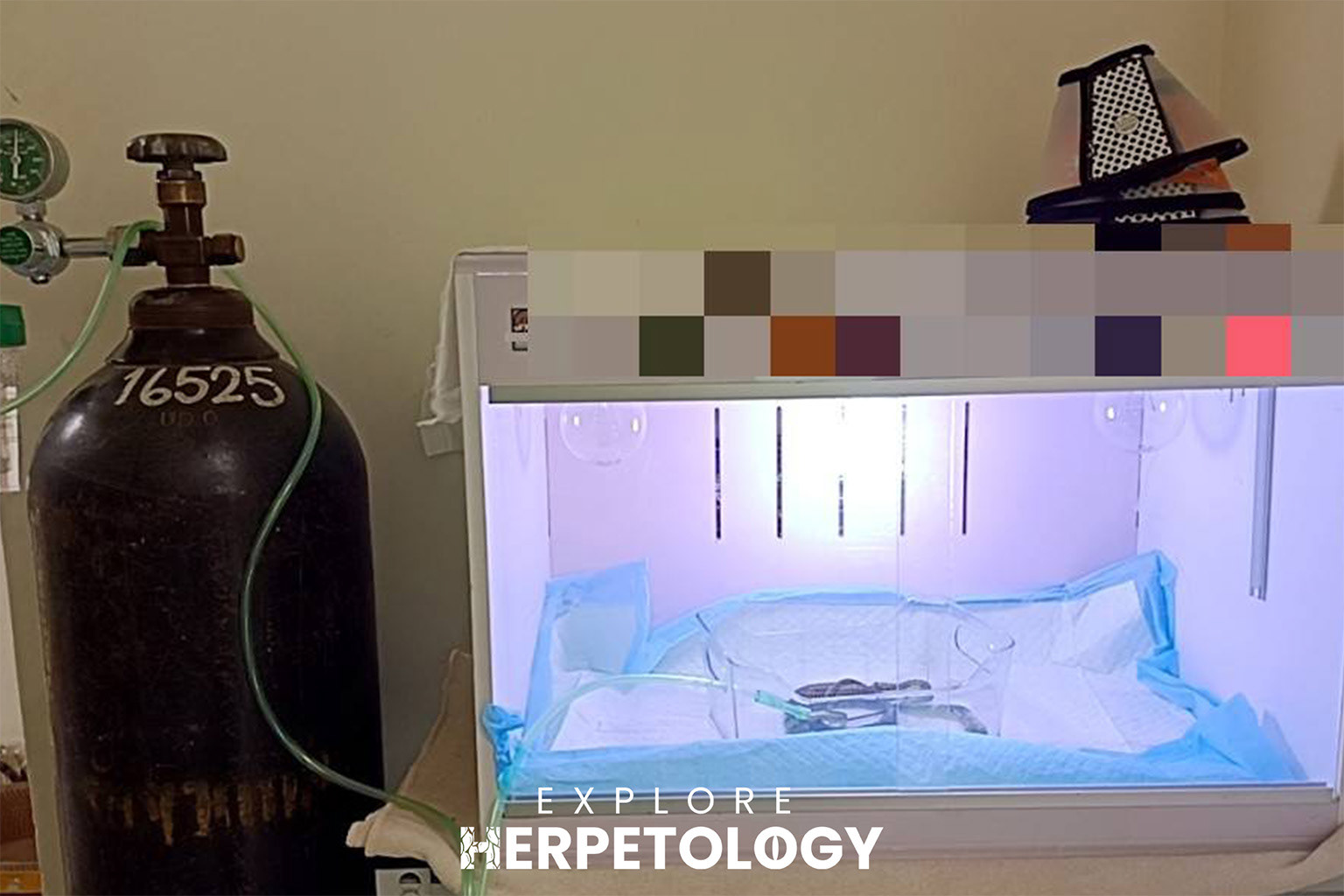
Its recovery station post-surgery.
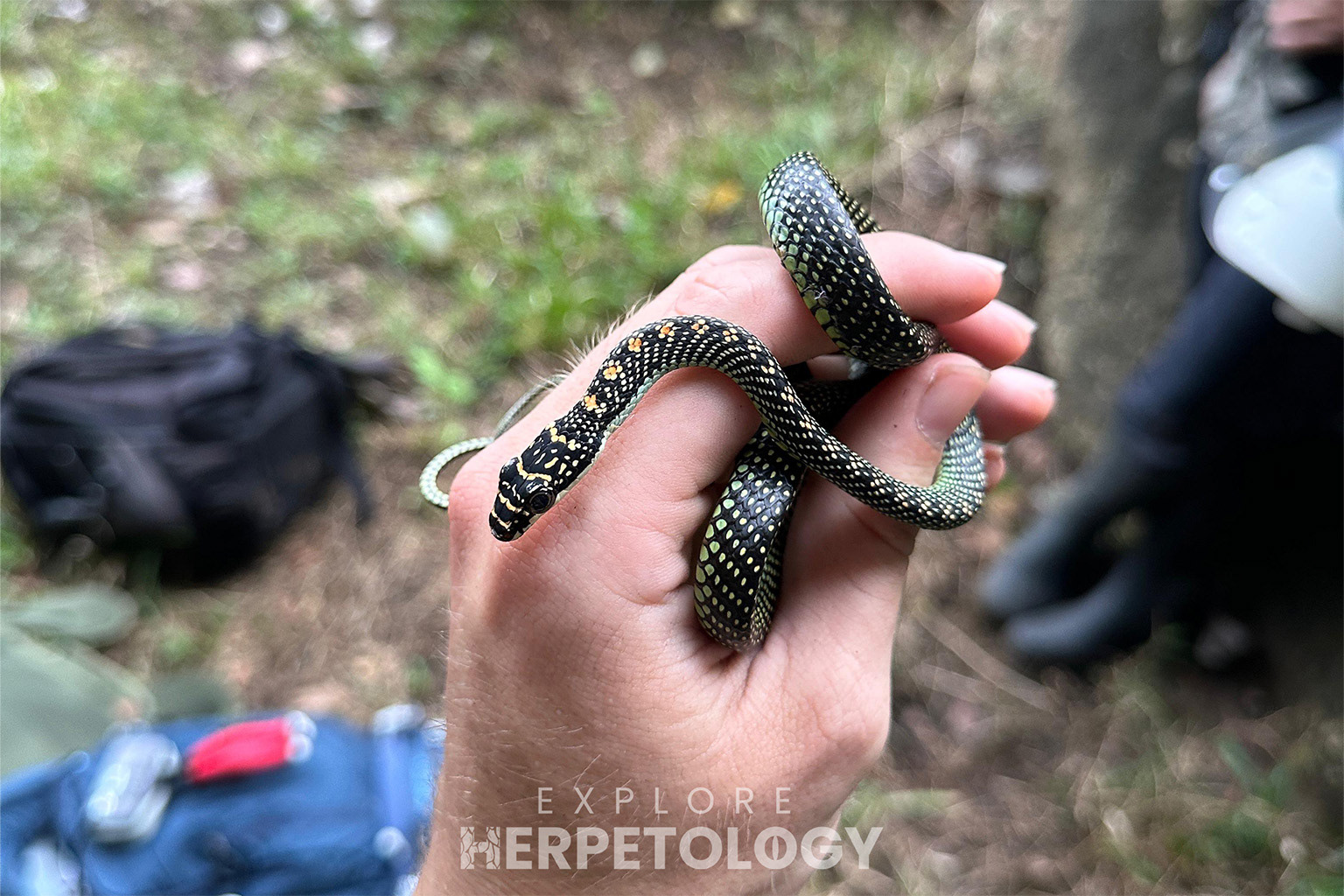
Our final goodbye before release, almost 2 months later.
After taking the paradise flying snake to the vet, we returned to the same limestone karst formation and did some herping on foot. This walk turned up a nice female of the Trang clade beautiful pit viper (Trimeresurus venustus), which we consider the most attractive locality, making up for not seeing any during the day in Krabi.
In previous years, we had hoped to see Hagen's pit viper (Trimeresurus hageni) in Satun province, where they were historically common. However, it seems that they have almost completely disappeared from that area, with no records by us or other herpers for many years now. This led to us missing the species on our previous 2 Expedition Thai Peninsula. This time, we came with a new plan to search for them at a spot in Trang province where our guide Bank had found a large female around 1 year ago. For the first part of the walk, we observed nothing but Malayan vine snake (Ahaetulla mycterizans), but a small detour up a stream valley led to us finding two individuals. A large adult female and an adult male. This was as good as we could have hoped for, and a very significant encounter as Trimeresurus hageni is very rare this far north on the peninsula.
On the way back to the city, we made one more stop at a small limestone karst formation which has a thriving population of white-lipped pit viper (Trimeresurus albolabris). The southern clade of this species has a very patchy distribution and is not commonly encountered, but this particular site has never failed us. As expected, we turned up two individuals within a very short walk, a juvenile and an adult male.
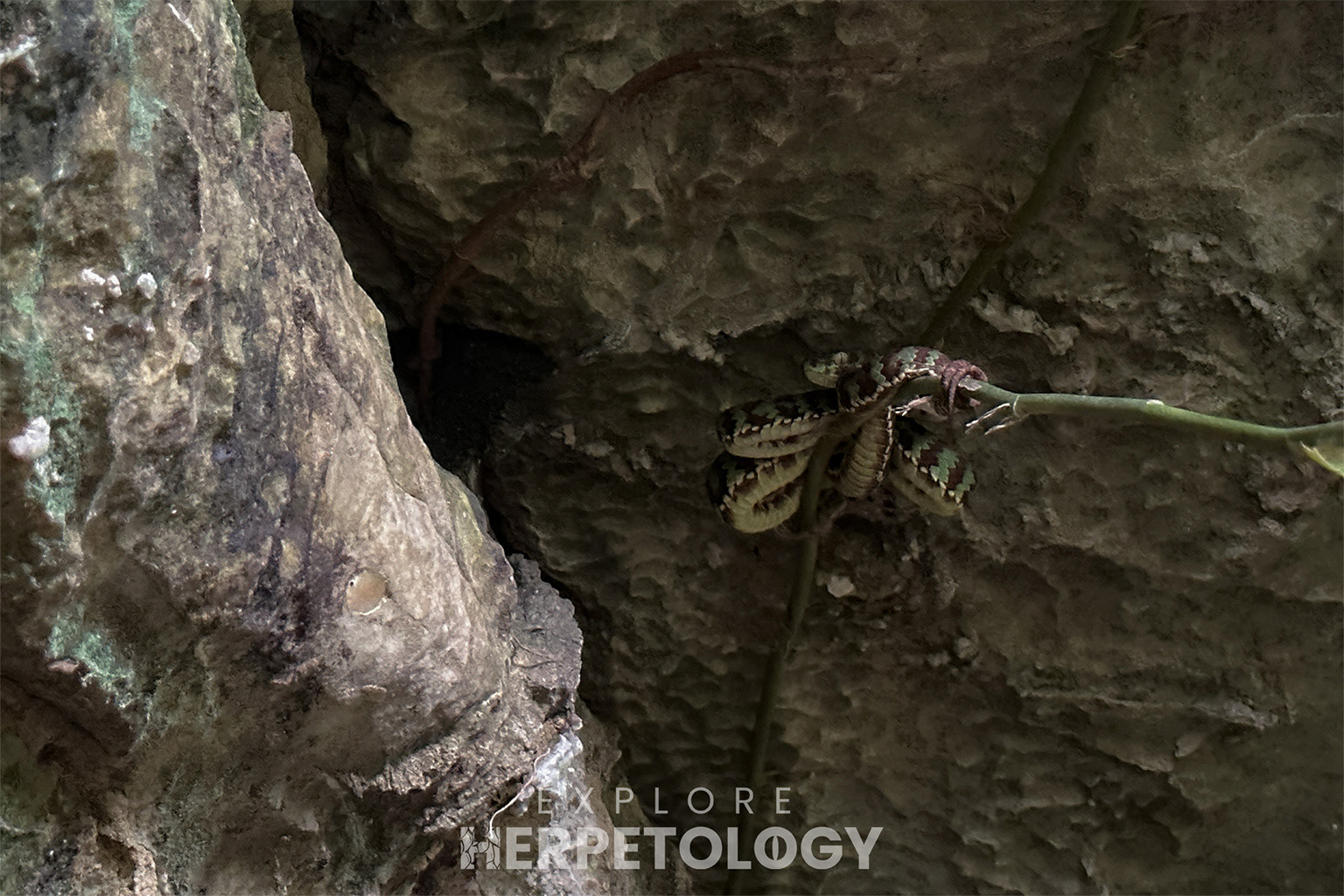
Beautiful pit viper (Trimeresurus venustus) in situ.
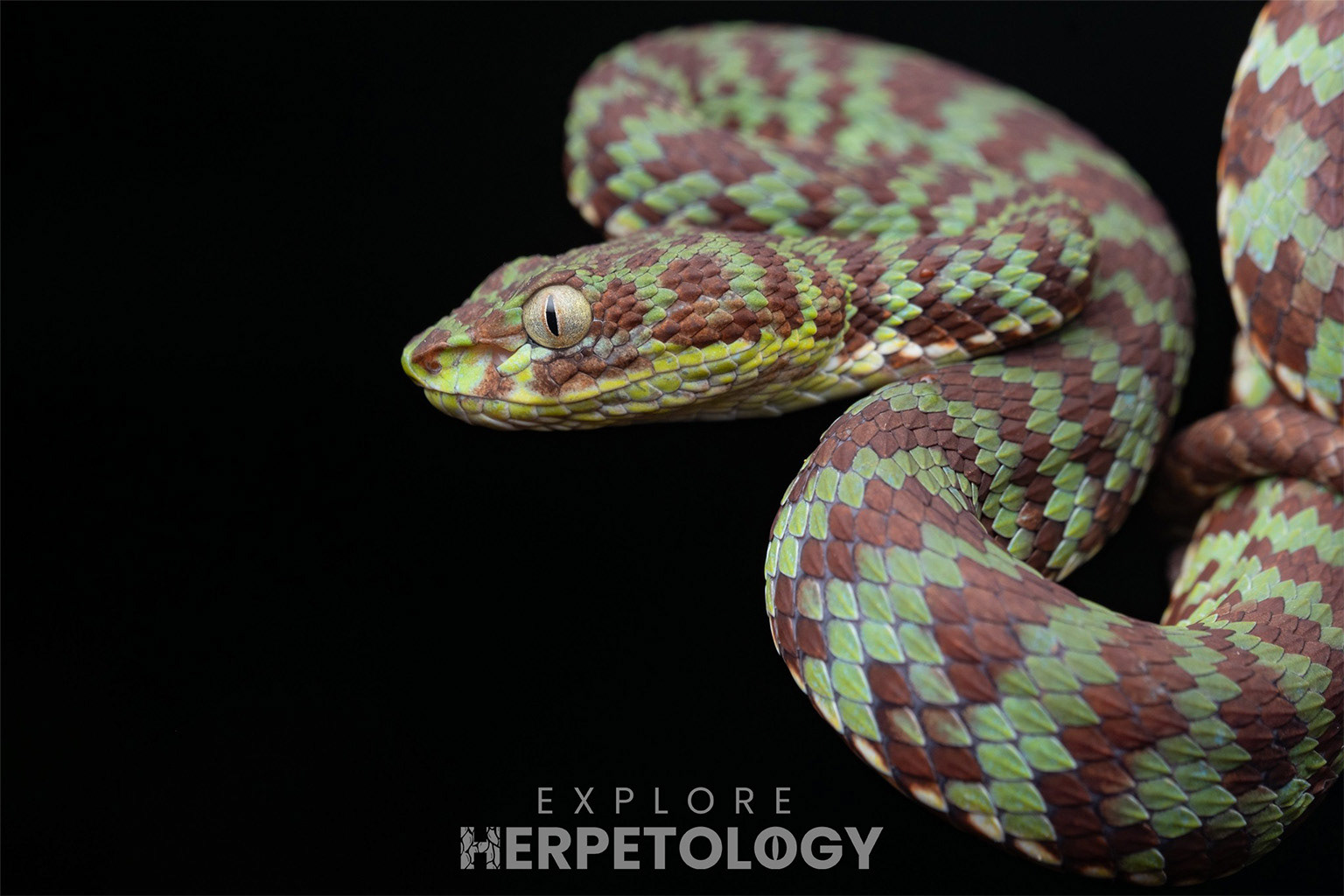
Beautiful pit viper (Trimeresurus venustus).
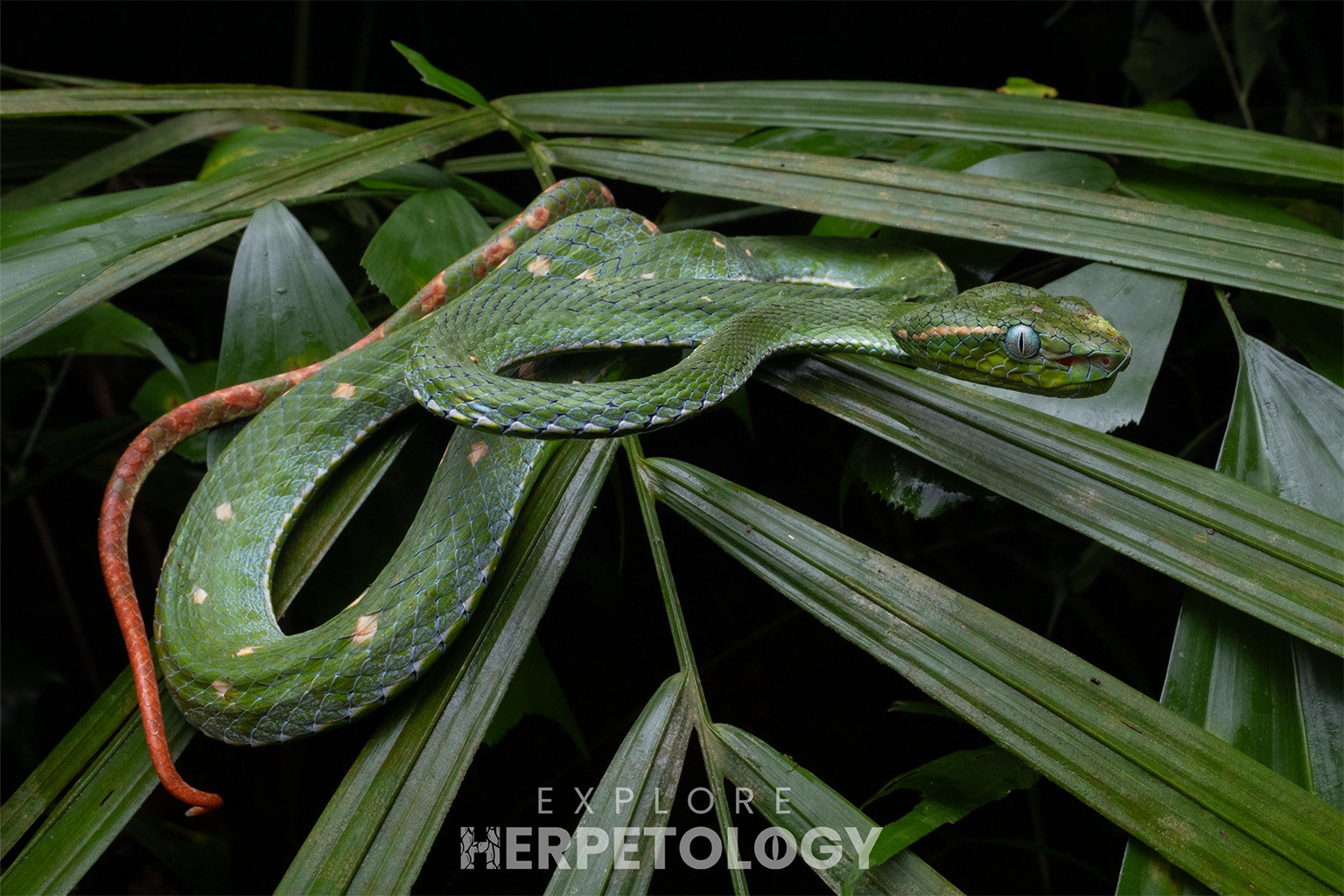
Adult male Hagen's pit viper (Trimeresurus hageni).
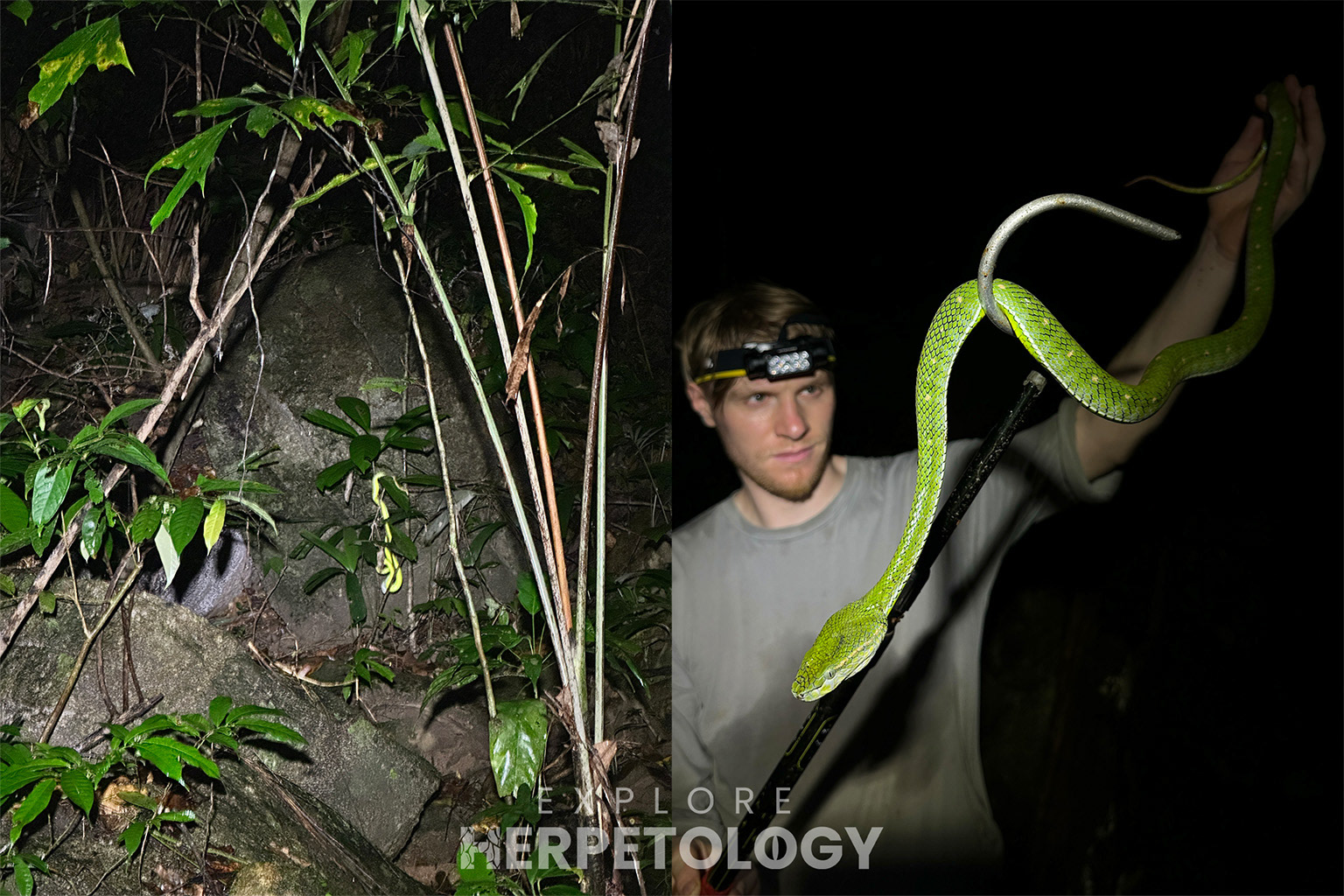
Female T. hageni in-situ and in-hand.
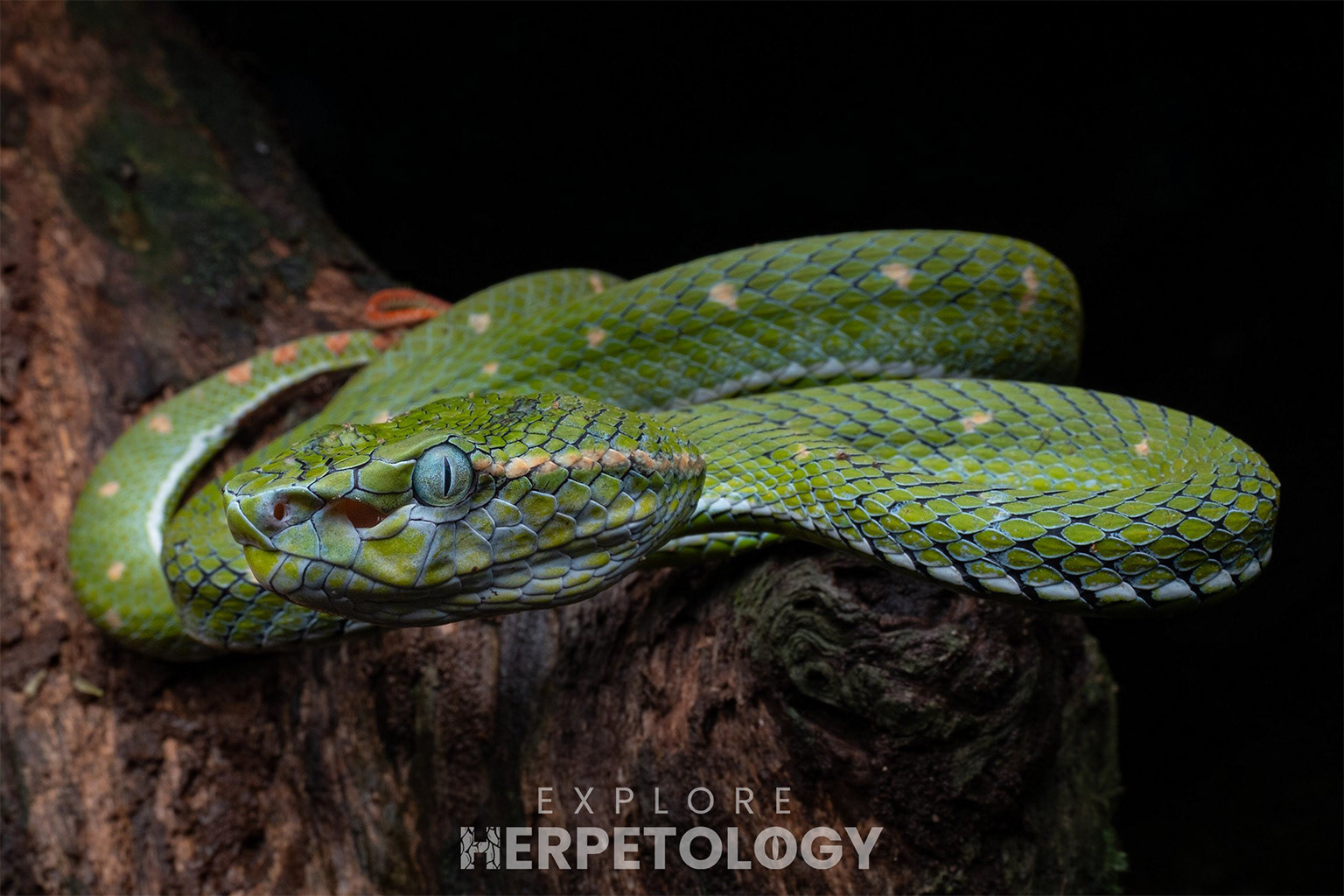
Adult female Hagen's pit viper (Trimeresurus hageni).
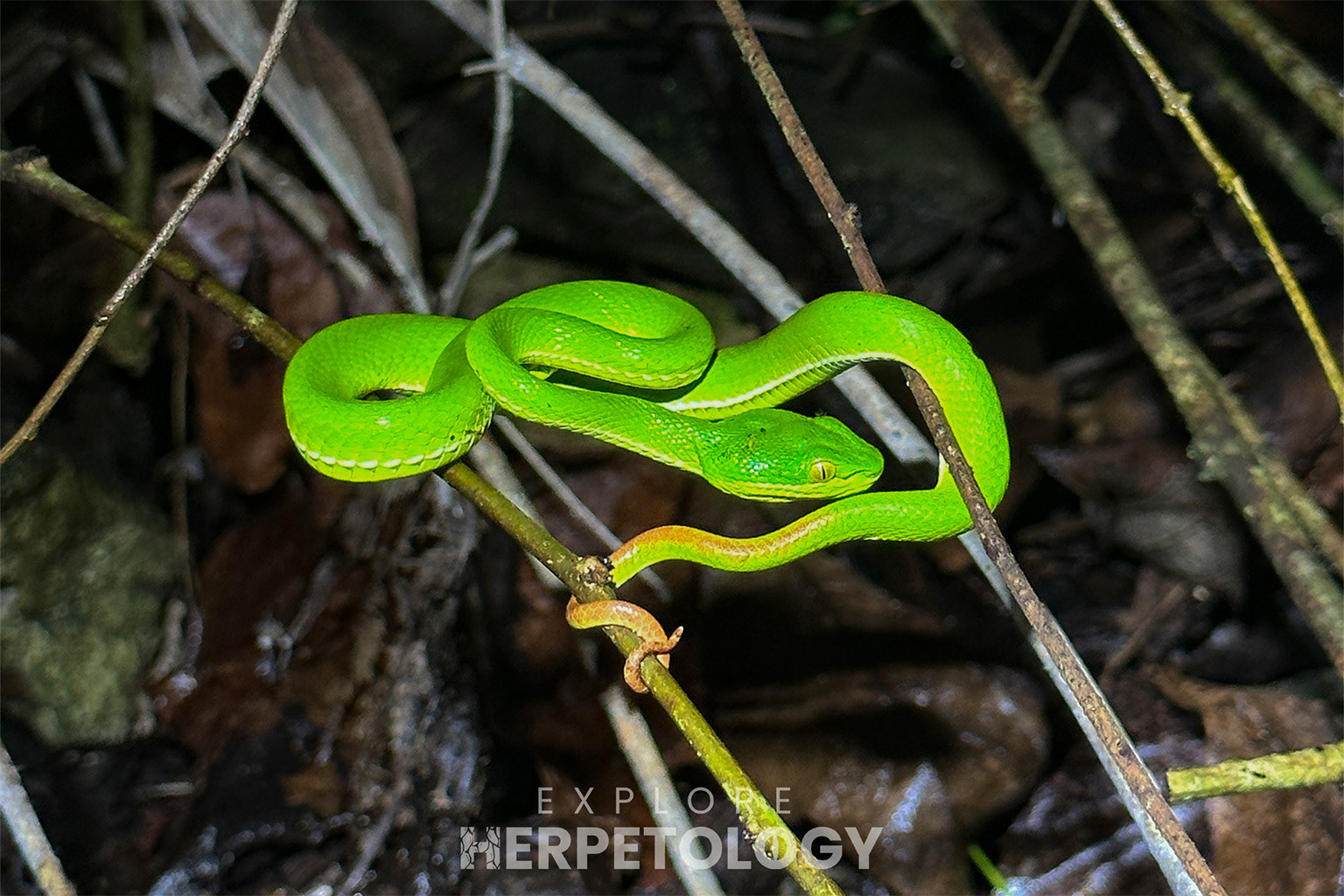
In-situ juvenile Trimeresurus albolabris.
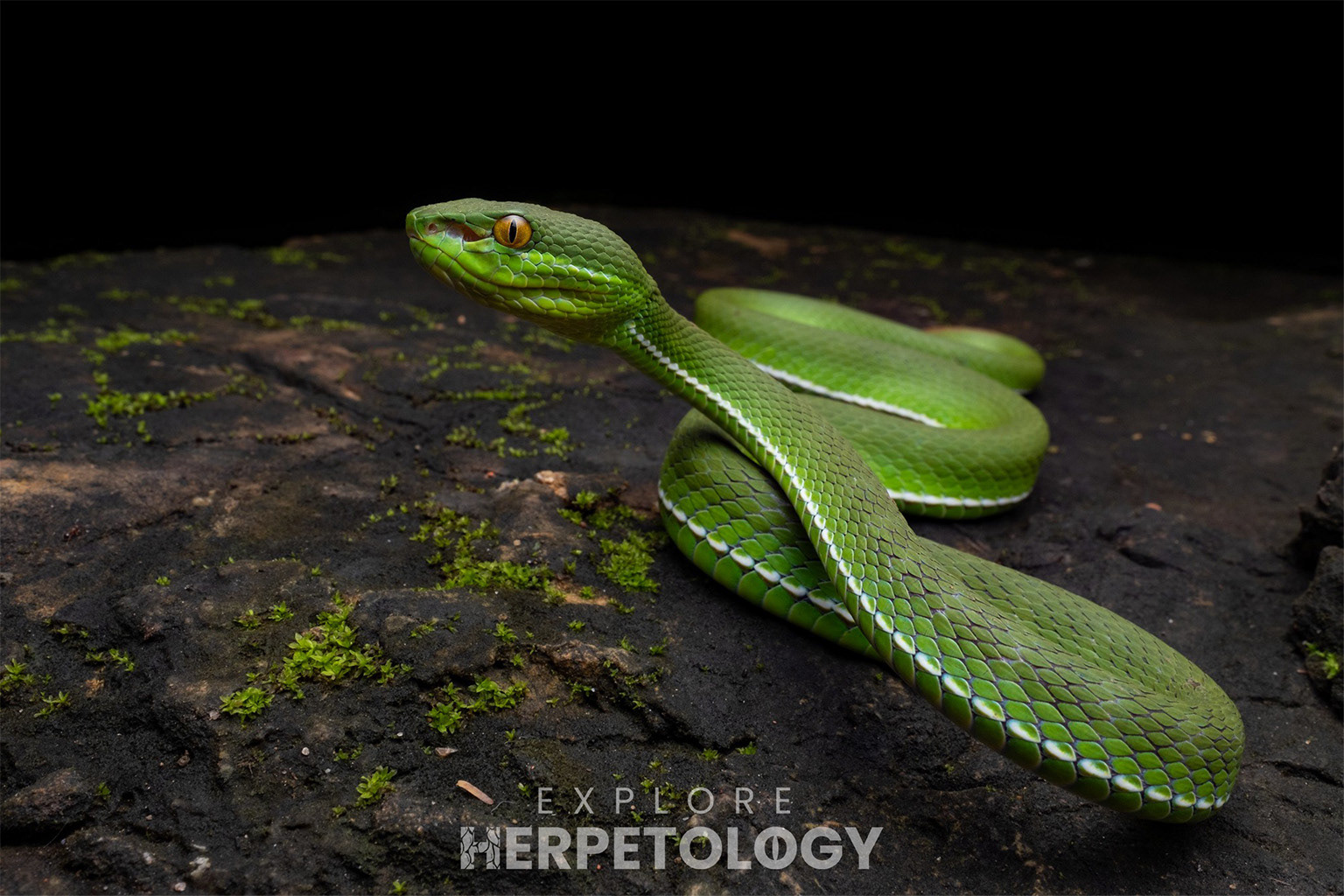
Adult male white-lipped pit viper (Trimeresurus albolabris).
SNAKE ISLAND (3rd - 4th)
We were up early the following morning to take our boat to Snake Island, the only 1 night stop of the trip. The weather was fantastic for travel, with bright blue skies making the island look like a real tropical paradise. Most of us enjoyed snorkelling, fishing and watching the oriental pied hornbills until nightfall, where we got out and began searching along the coast for sea kraits. As usual, we were able to find more than 10 sea kraits (Laticauda colubrina) in a short amount of time. We were also treated to a large mangrove pit viper (Trimeresurus purpureomaculatus) waiting in ambush amongst the rocks and sands of the beach.
When we got bored of walking the rocky headlands, a cross-island hike turned up several more mangrove pit vipers along with a nice variety of other herpetofauna. Lastly, we were all very surprised (and happy) when a beautiful small-spotted coral snake (Calliophis maculiceps) was spotted by Justin amongst on the sandy beach right outside our resort. This species can be very difficult to encounter in the south of Thailand, so we were happy to add this elapid species to our list.
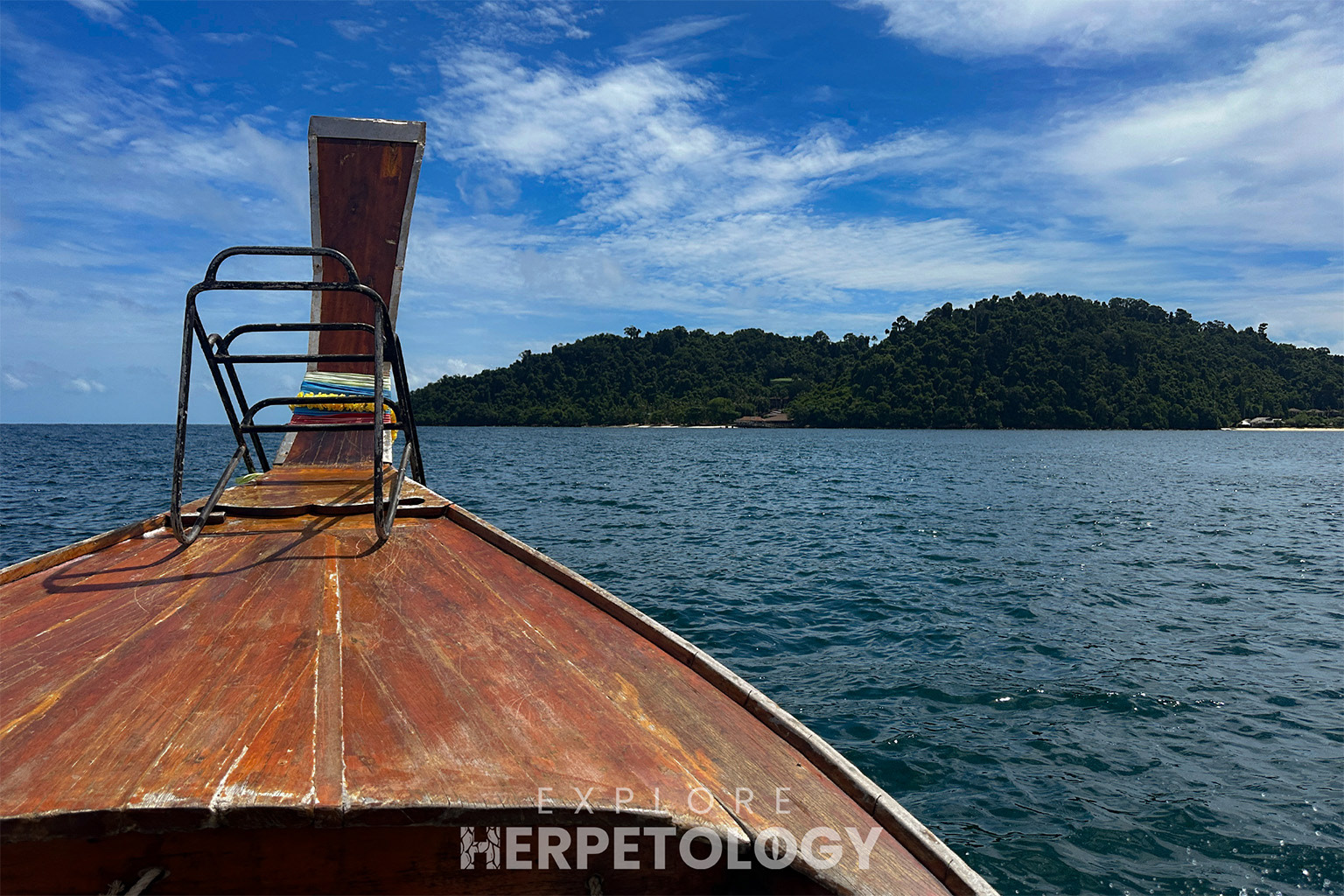
En-route to Snake Island.
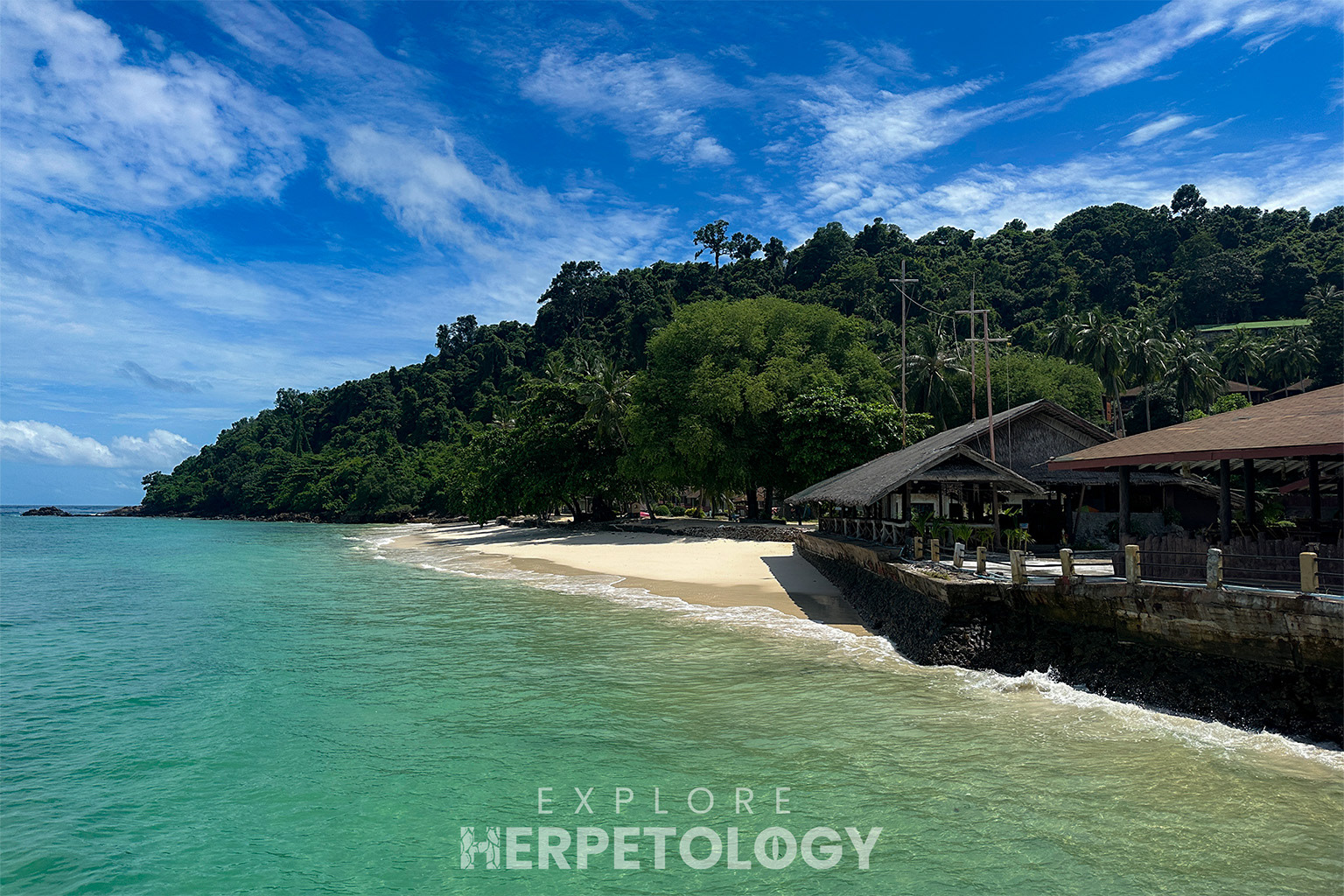
Our private beach within our resort.
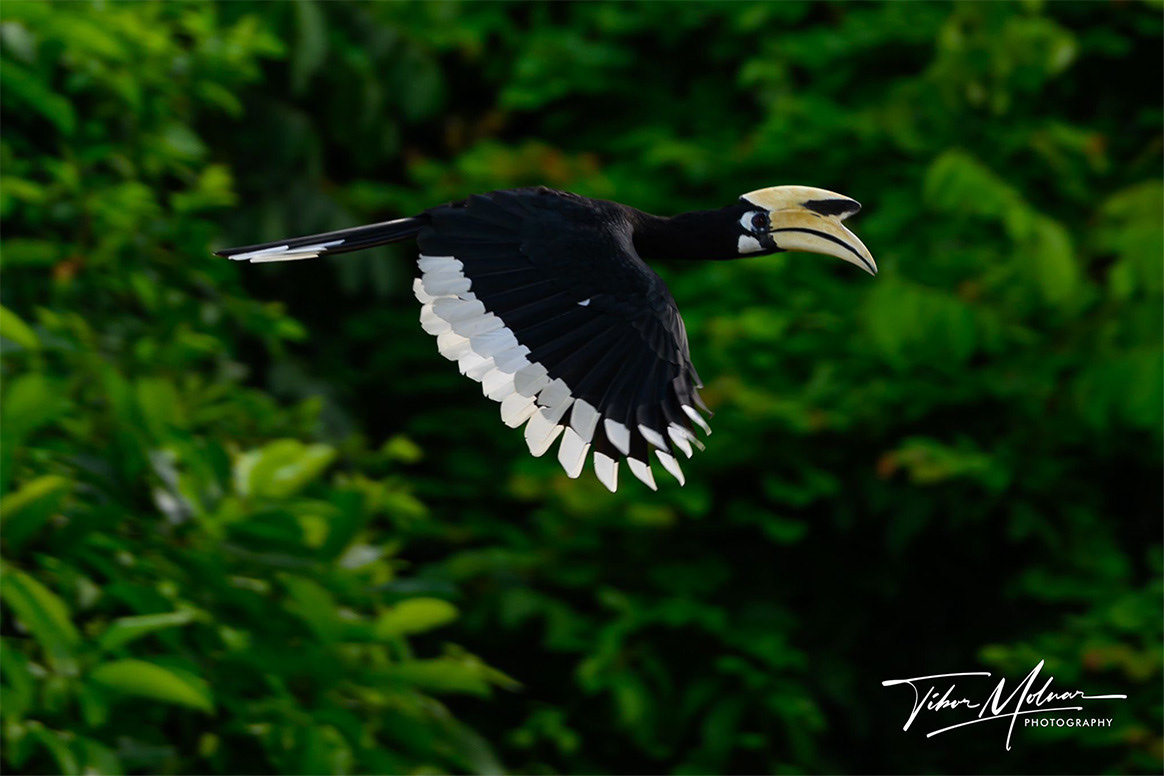
Oriental pied hornbill.
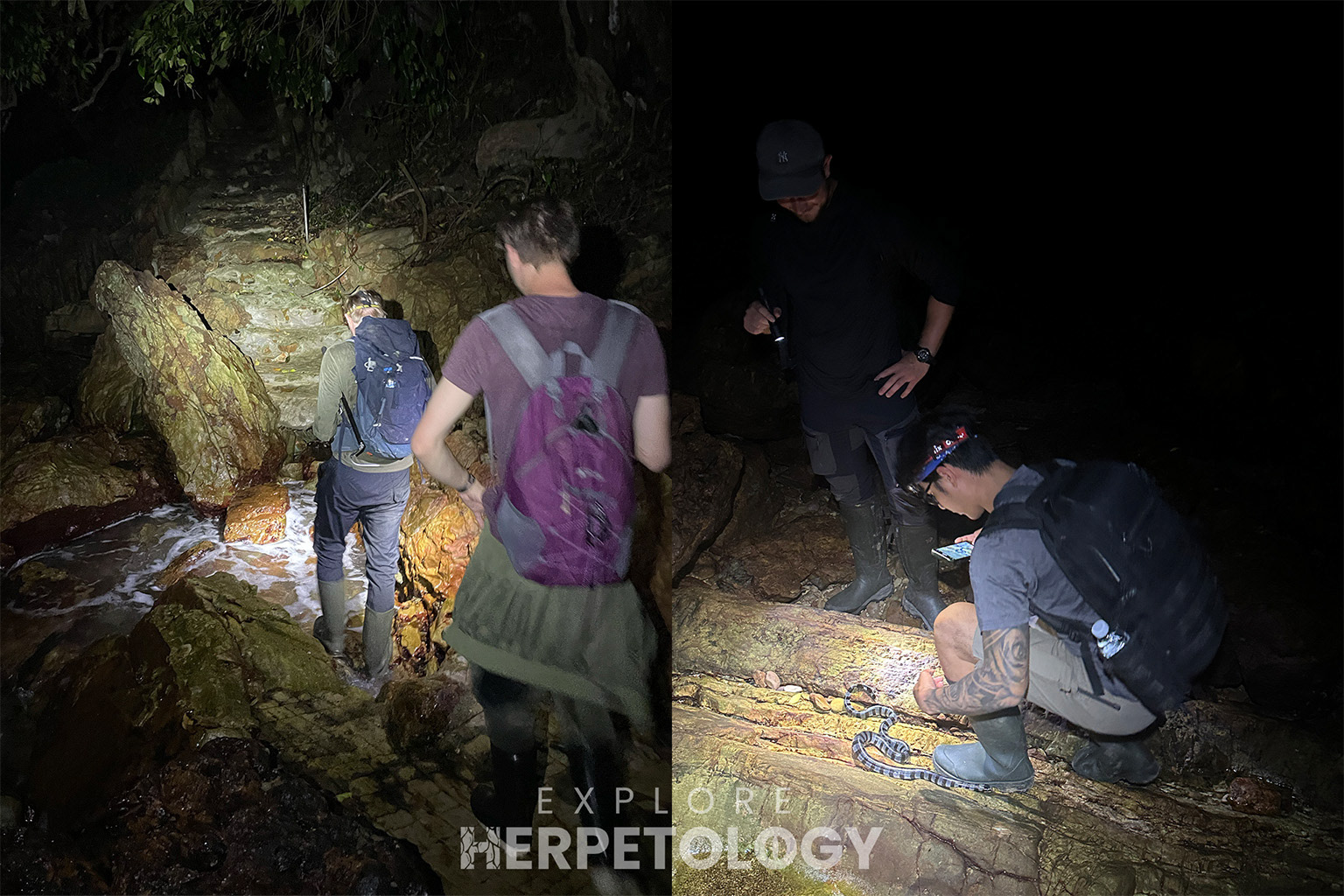
Hiking a coastal trail for sea kraits.
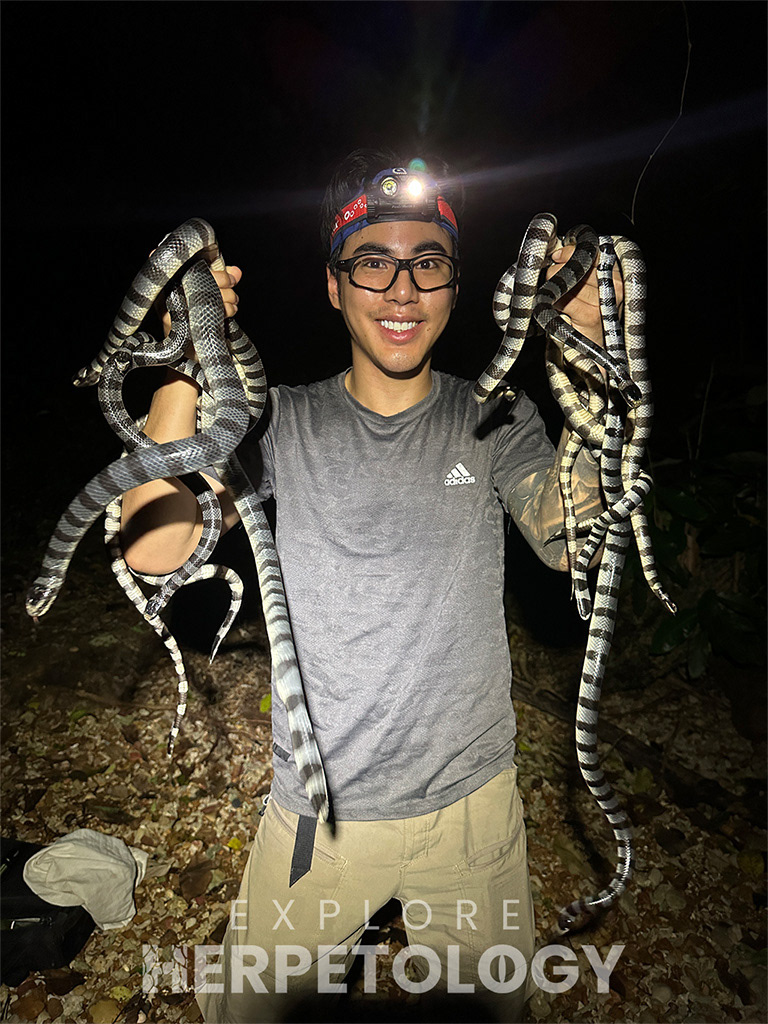
Bank with a handful of highly venomous elapid snakes.
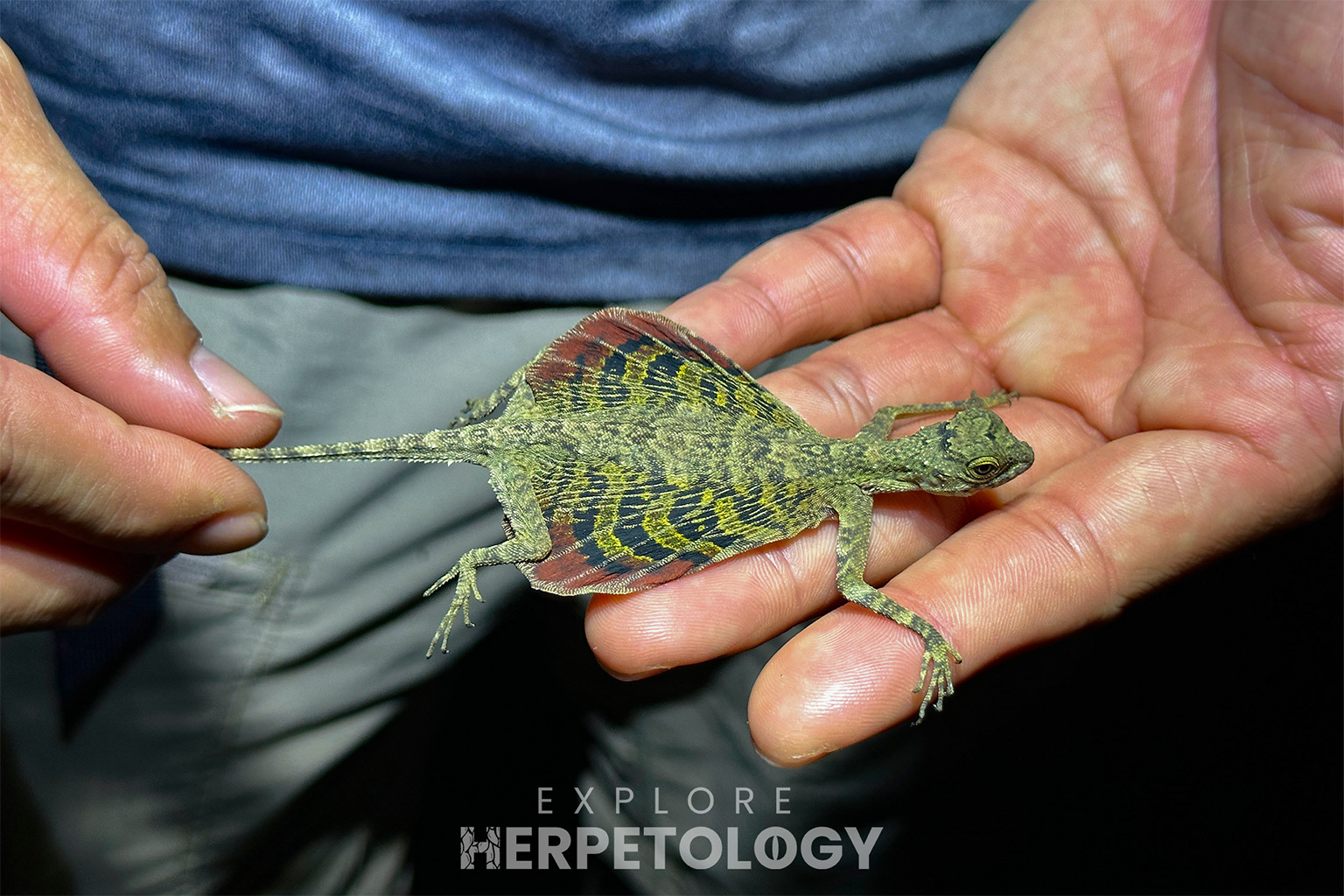
Banded flying lizard (Draco taeniopterus)
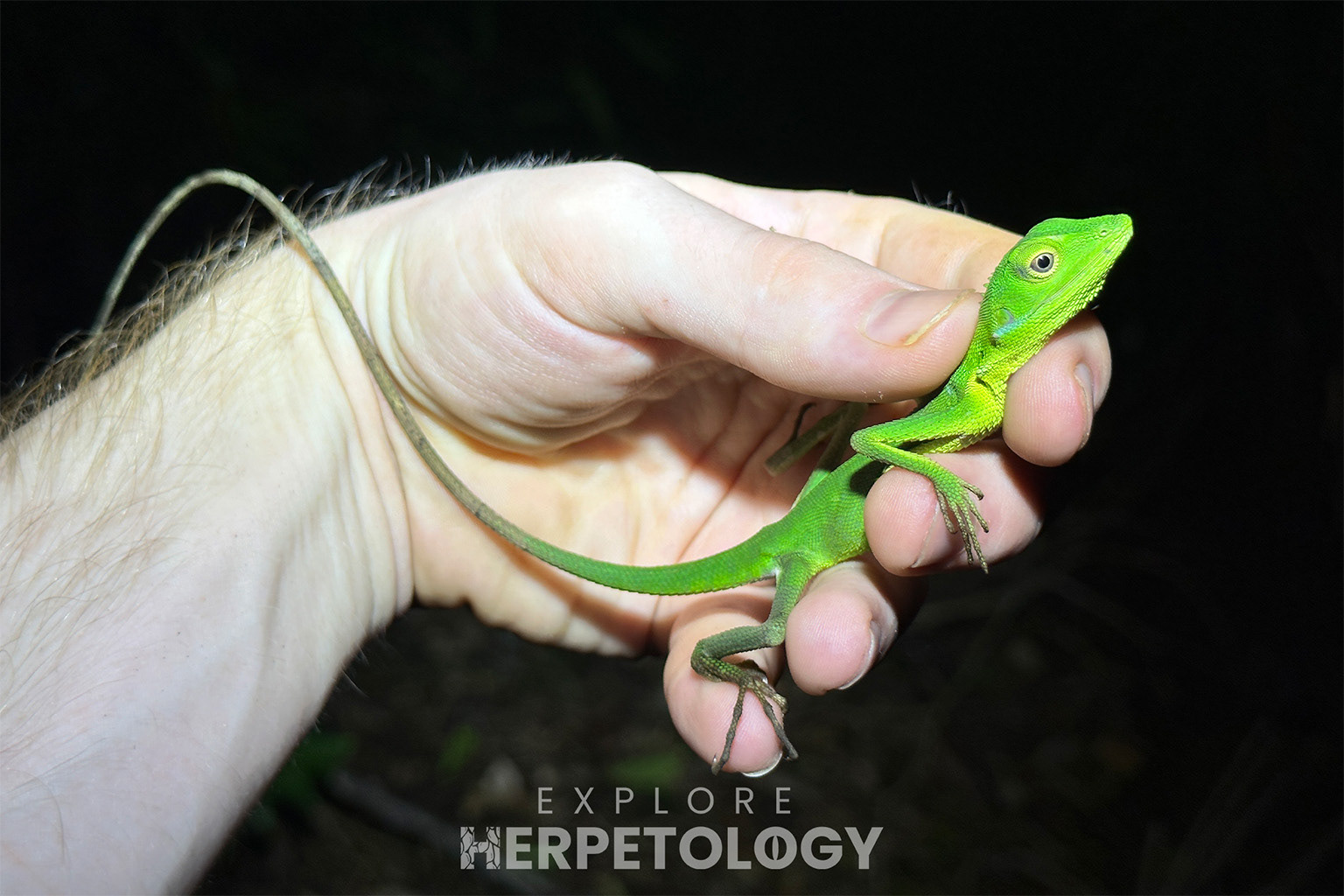
Raya green crested lizard (Brochocela rayanensis).
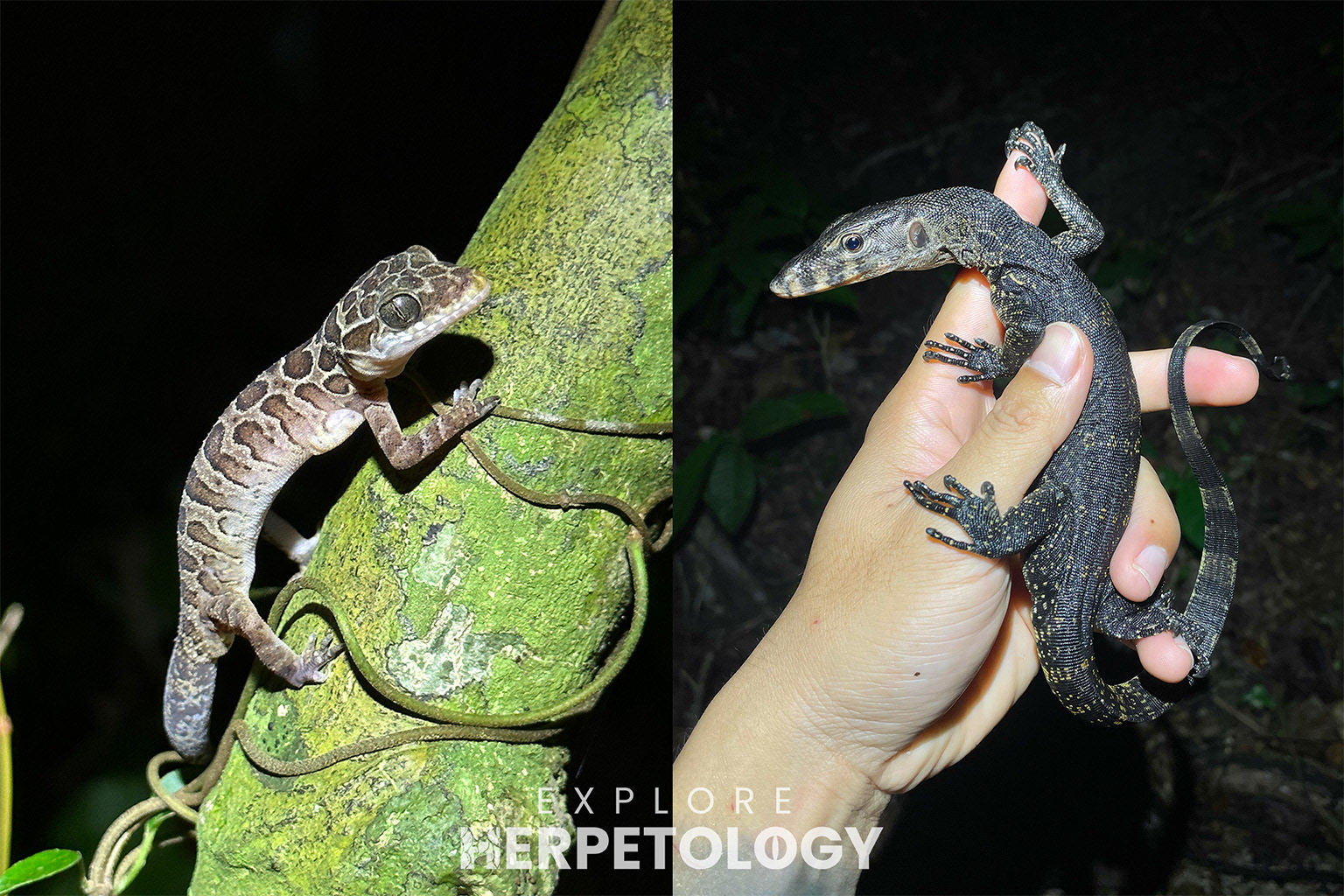
Left: Cyrtodactylus zebraicus. Right: Varanus salvator.
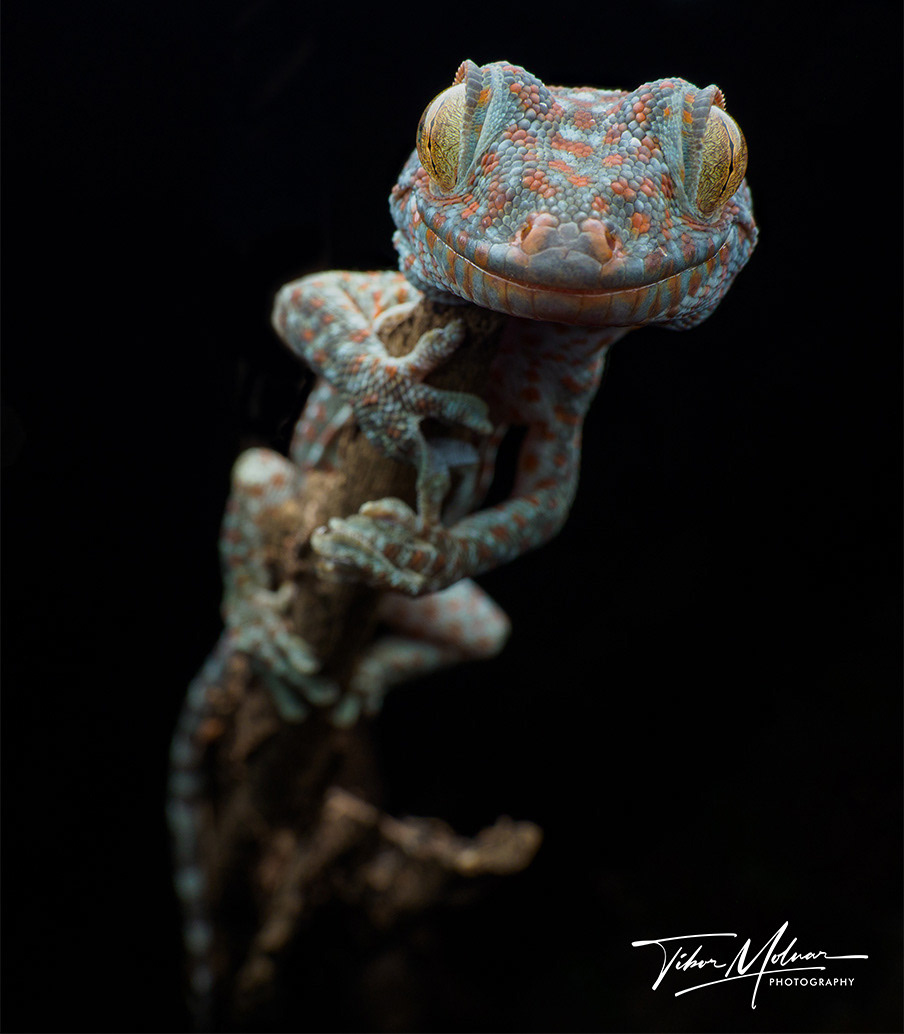
Tokay gecko (Gekko gecko).
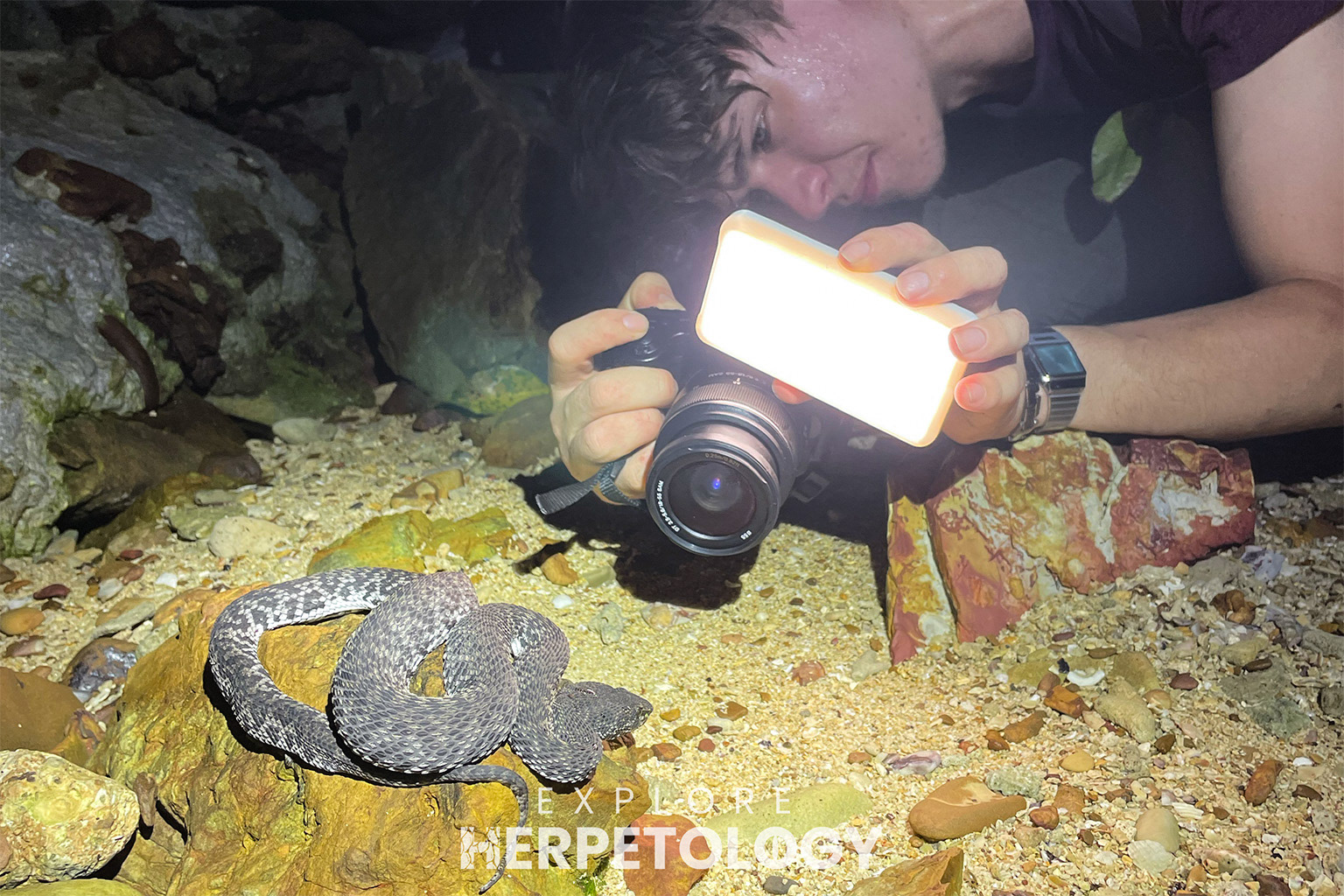
Mangrove pit viper being photographed.

Mangrove pit viper (Trimeresurus purpureomaculatus) in-situ.
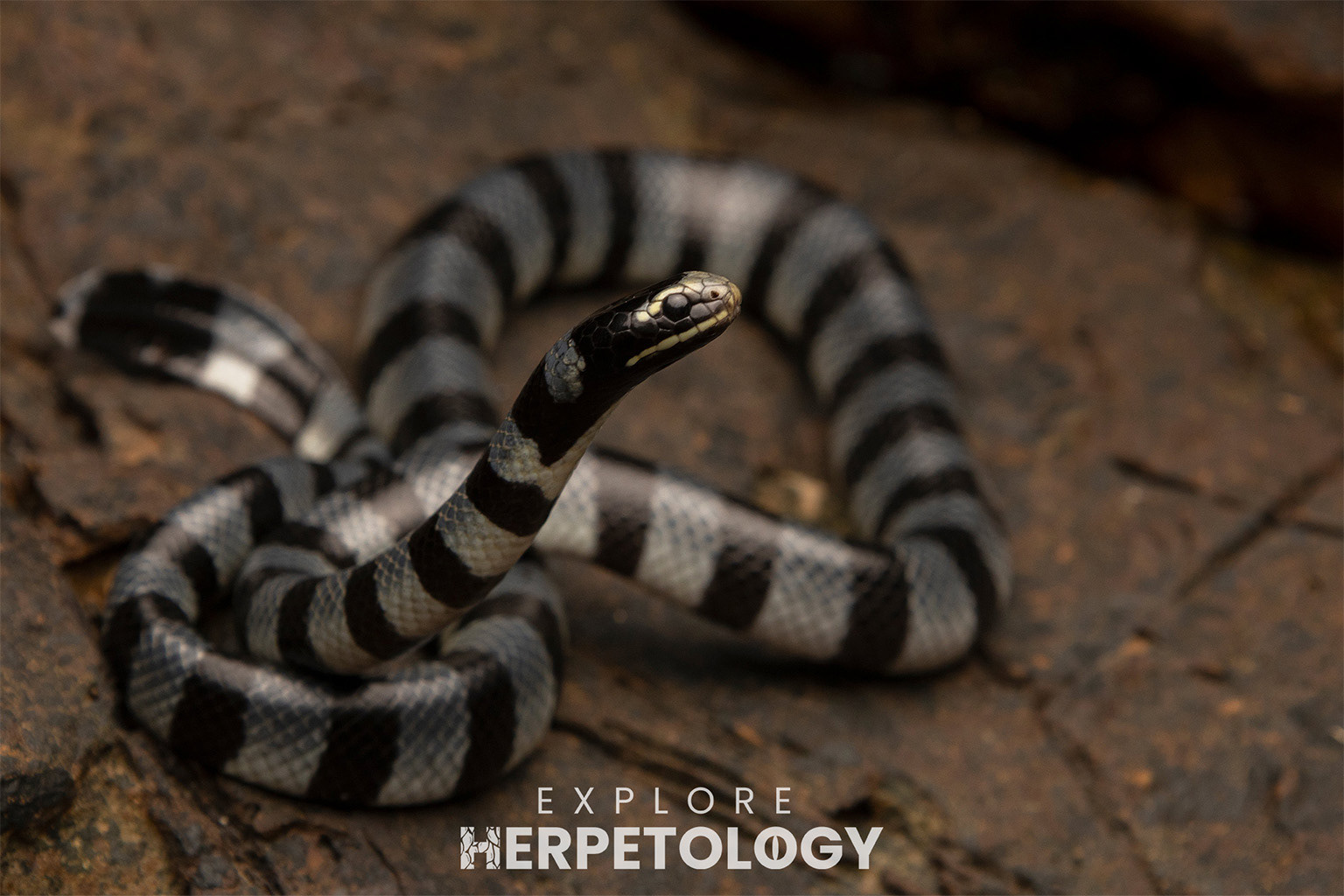
Yellow-lipped sea krait (Laticauda colubrina).
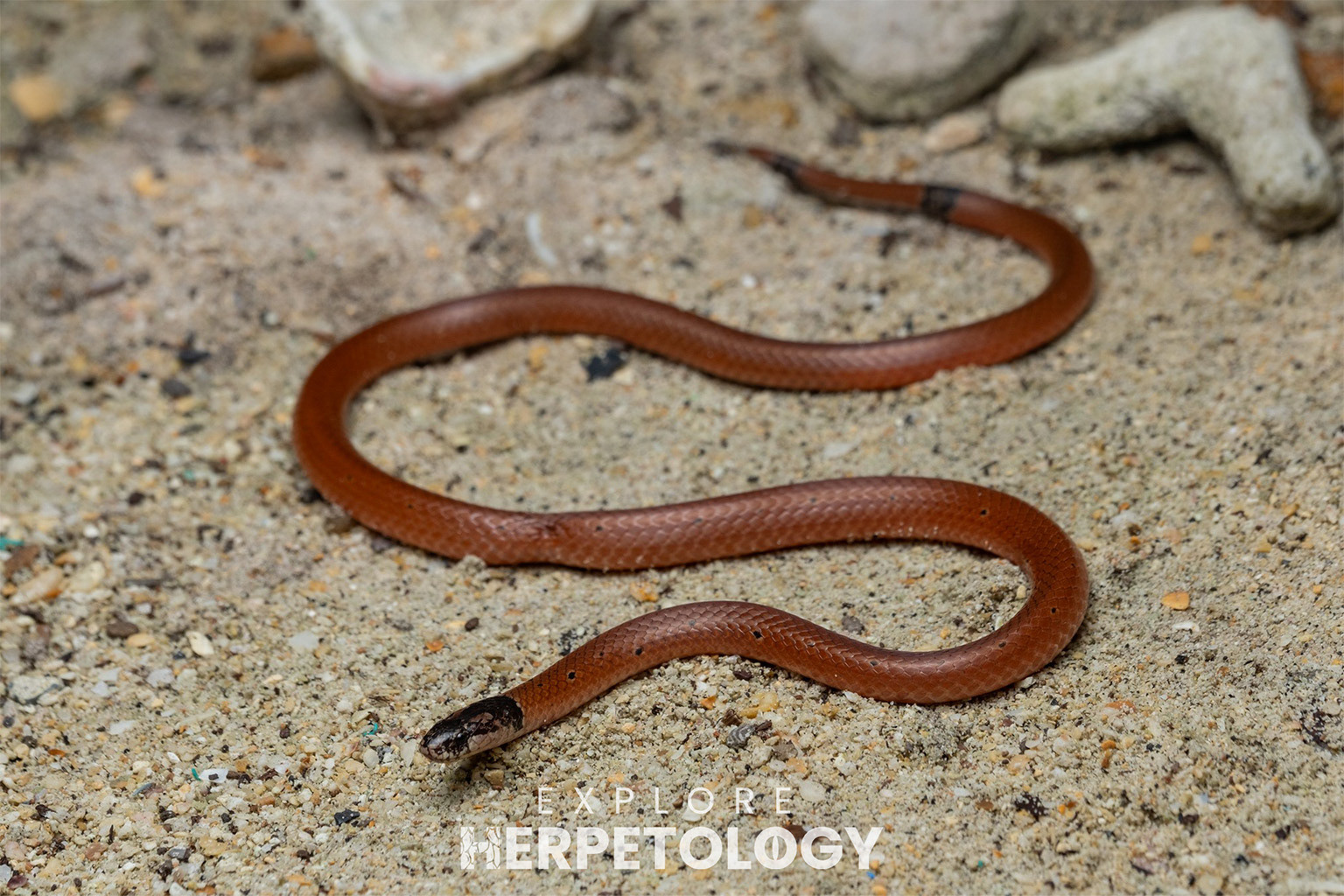
Small-spotted coral snake (Calliophis maculiceps).
SATUN (4th - 6th)
Our journey back to the mainland was not as smooth as our to the island, with some rough seas more than doubling our journey time. However, we all made it in one piece and continued south to Satun, where we stopped at a limestone karst formation to do some daylight searching for the very rare limestone eyelash pit viper (Trimeresurus ciliaris). At the first site, we found two triangle keelbacks (Xenochrophis trianguligerus) within a cave, but David dropped his best flashlight into deep water while trying to catch one of them. Even worse, when we drove around the corner to another location, Rupert slipped off a concrete path up the karst and fell badly on his wrist, fracturing the bone in 3 places. This completely cut our herping dead for the day, as half the group went to the hospital with him while the rest of the group went to check in to our accommodation.
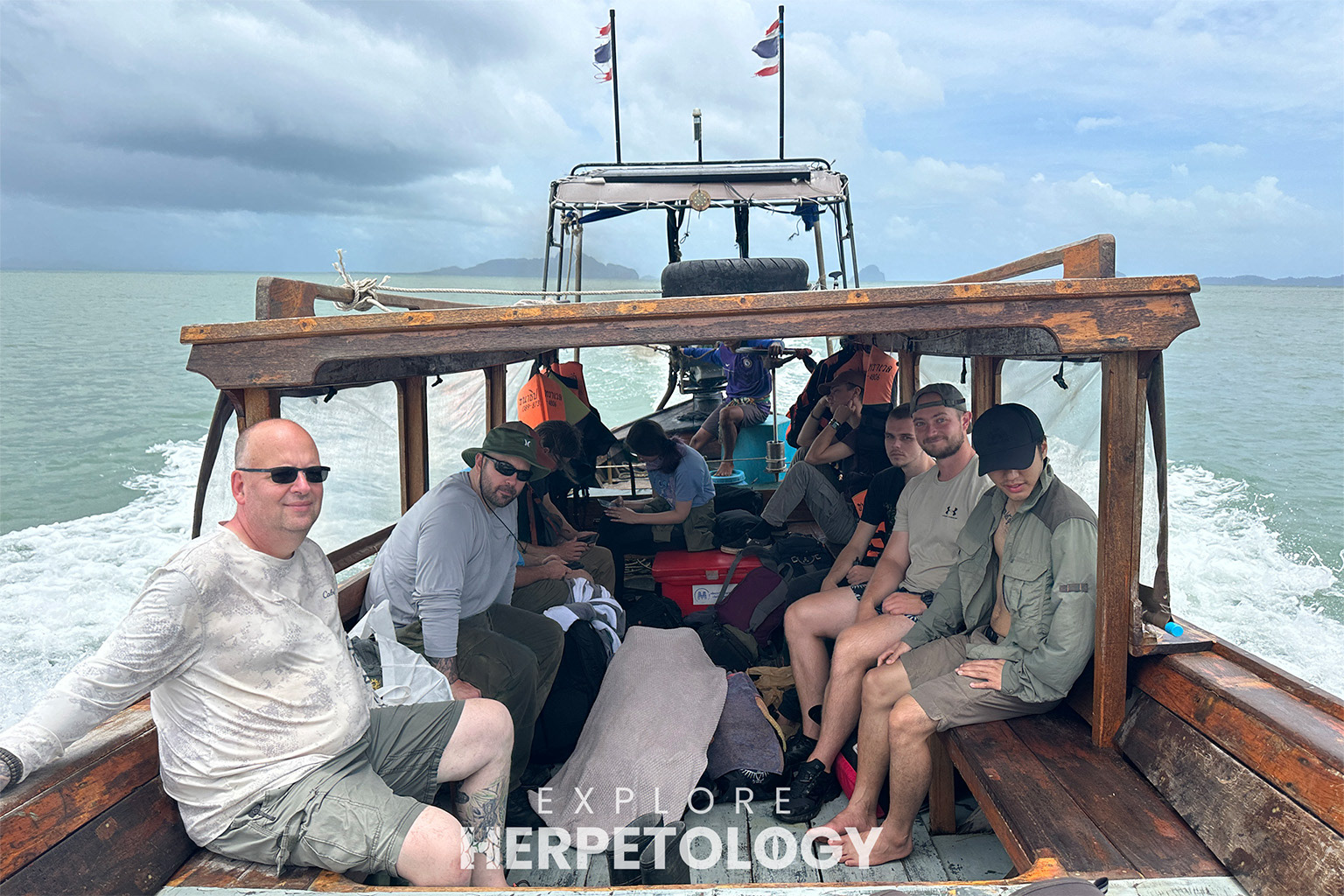
Picture taken as we got closer to shore and the ride was less...bumpy.
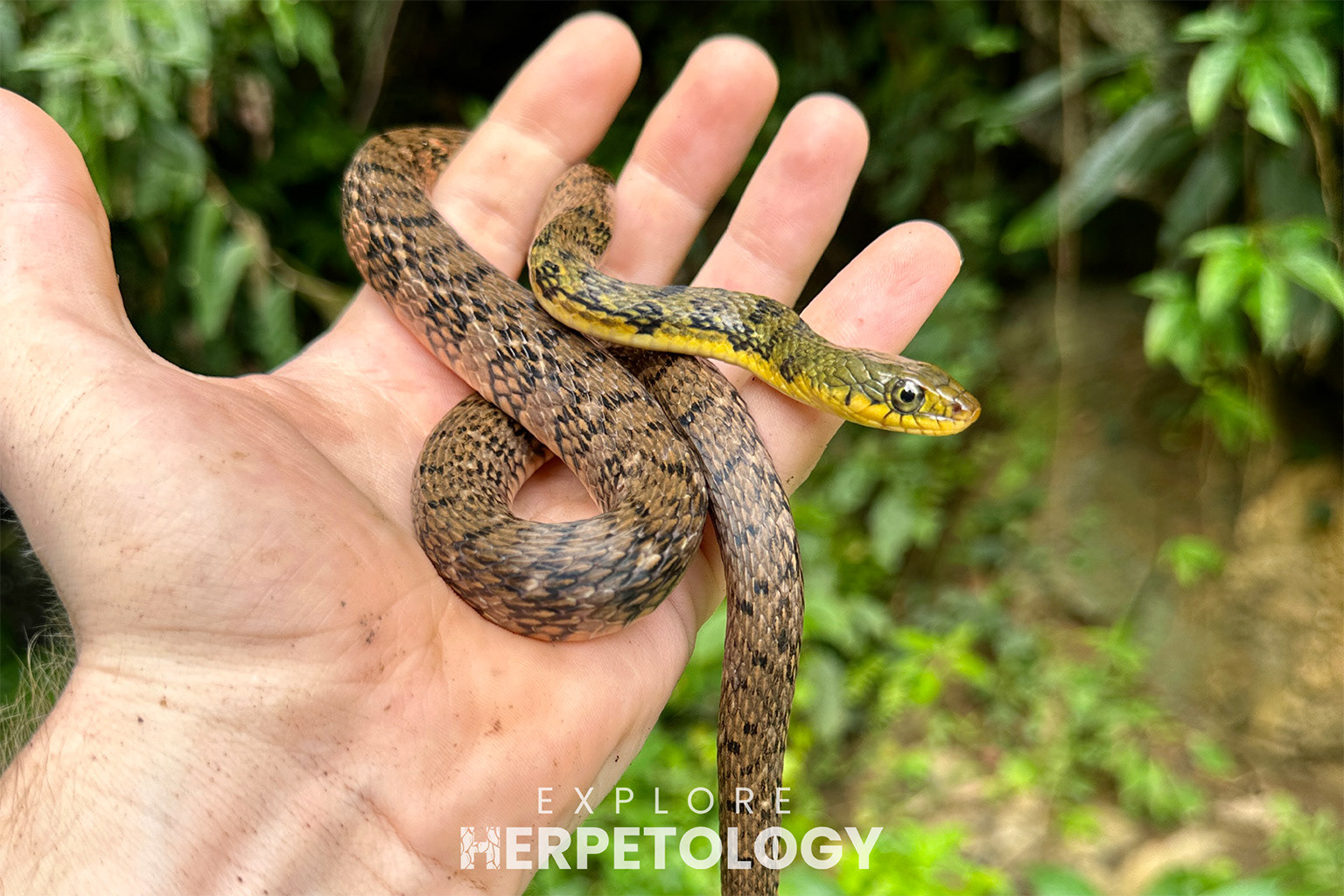
Triangle keelback (Xenochrophis trianguligerus).
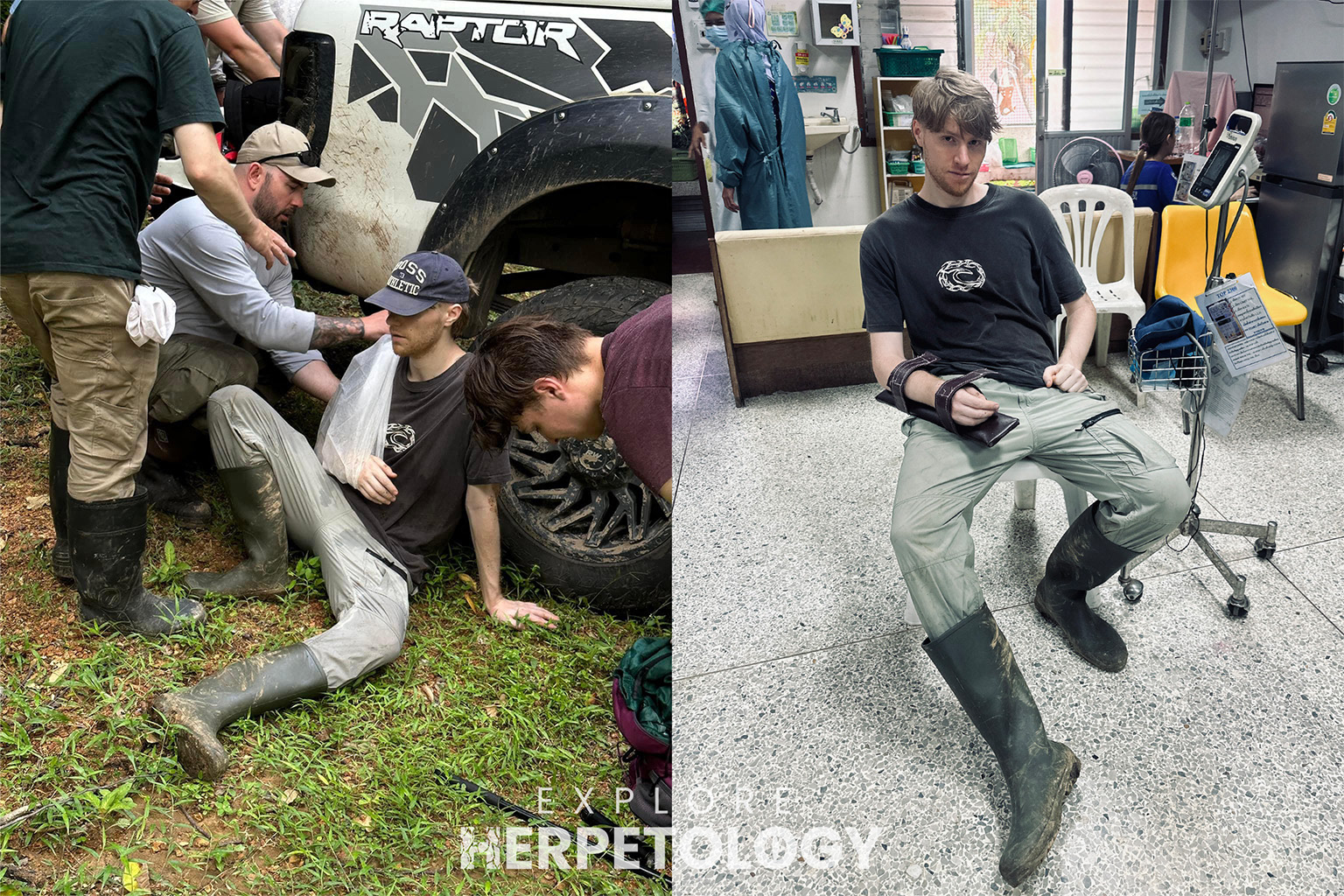
Nightmare situation.
After Rupert was discharged from the hospital (with a comically large karst), we rendezvoused at the national park and immediately got out herping. Similar to Trang, the primary rainforest and freshwater swamps of Satun are often very challenging to find high numbers of snakes. However, just like last year, it was fantastic this time and we were able to find many new species for the trip on our very first night.
It began with an absolutely giant sunbeam snake (Xenopeltis unicolor) right by our accommodation, quickly followed by a large Malayan racer (Coelognathus flavolineatus) which had just eaten another large-bodied snake. Further on, we found a white-spotted cat snake (Boiga drapiezii) right next to a sleeping painted bronzeback (Dendrelaphis pictus). We saw a further 2 individuals of Dendrelaphis pictus, as well as ~2.5 meter white-bellied rat snake (Ptyas fusca), a speckle-bellied keelback (Rhabdophis chrysargos), a juvenile wagler's pit viper (Tropidolaemus wagleri), a malayan bridle snake (Lycodon subannulatus) and our first Indo-Chinese rat snake (Ptyas korros) of the trip. We also found an adult spiny turtle (Heosemys grandis) and a box turtle (Curoa amboinensis).
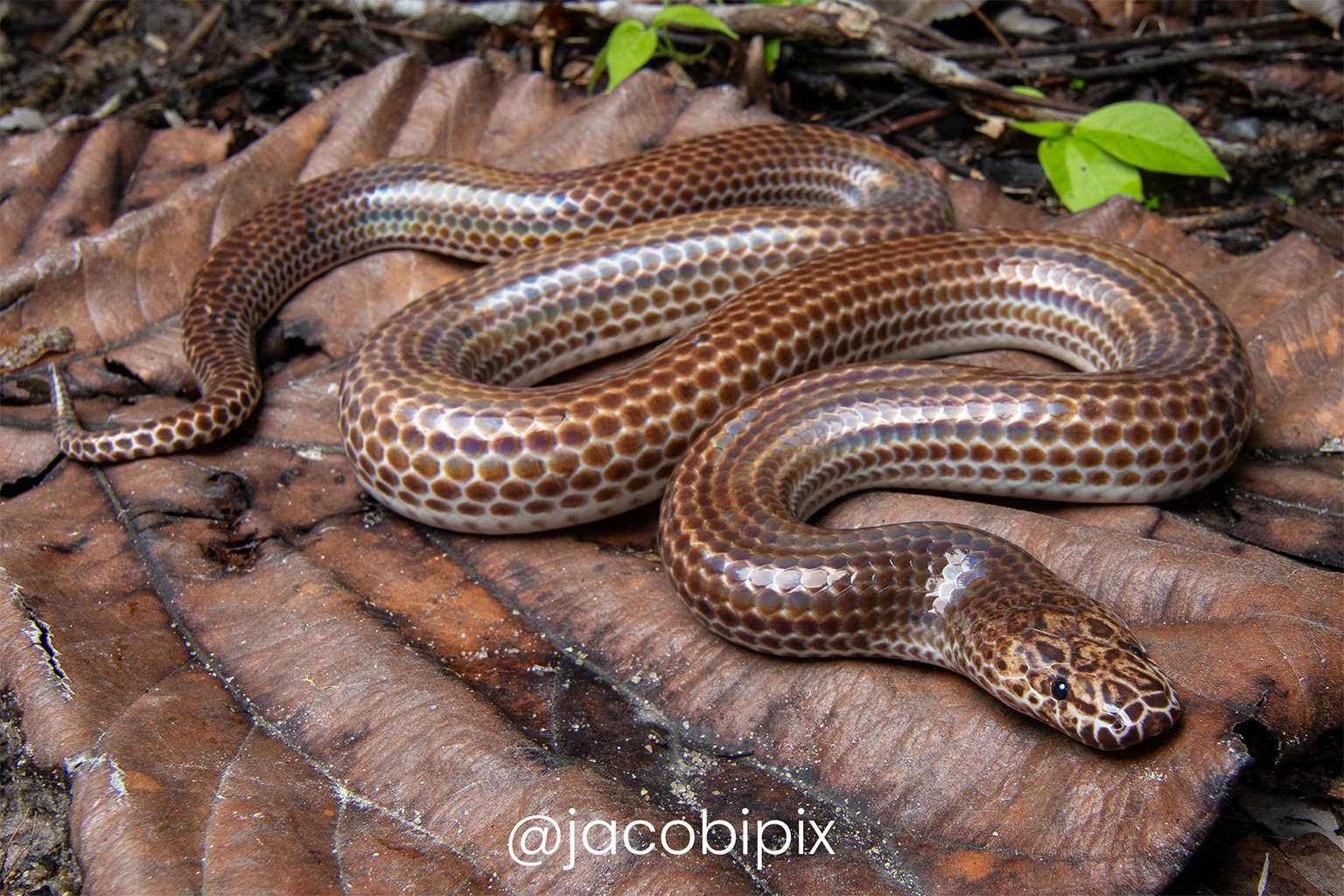
Sunbeam snake (Xenopeltis unicolor).
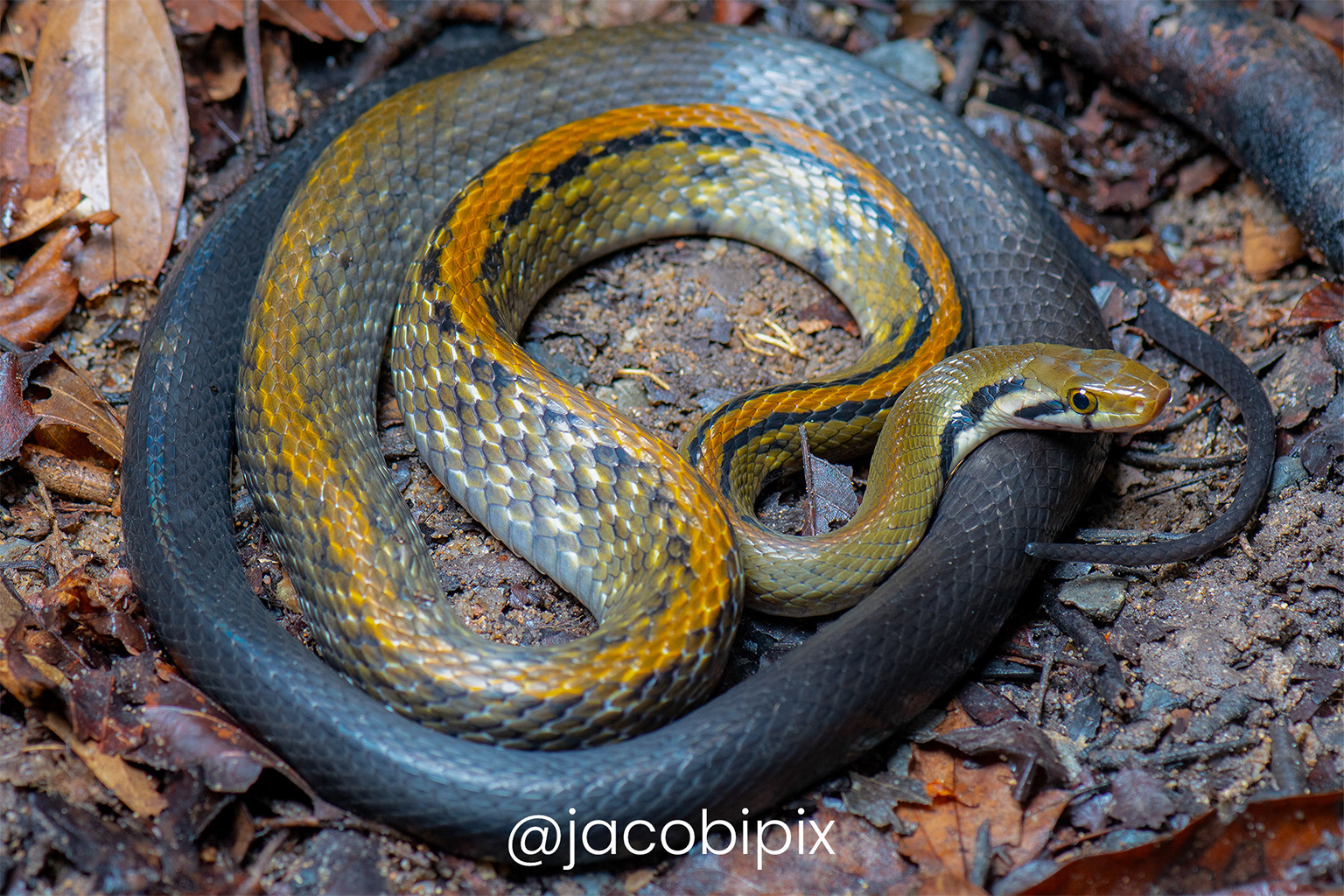
Malayan racer (Coelognathus flavolineatus).
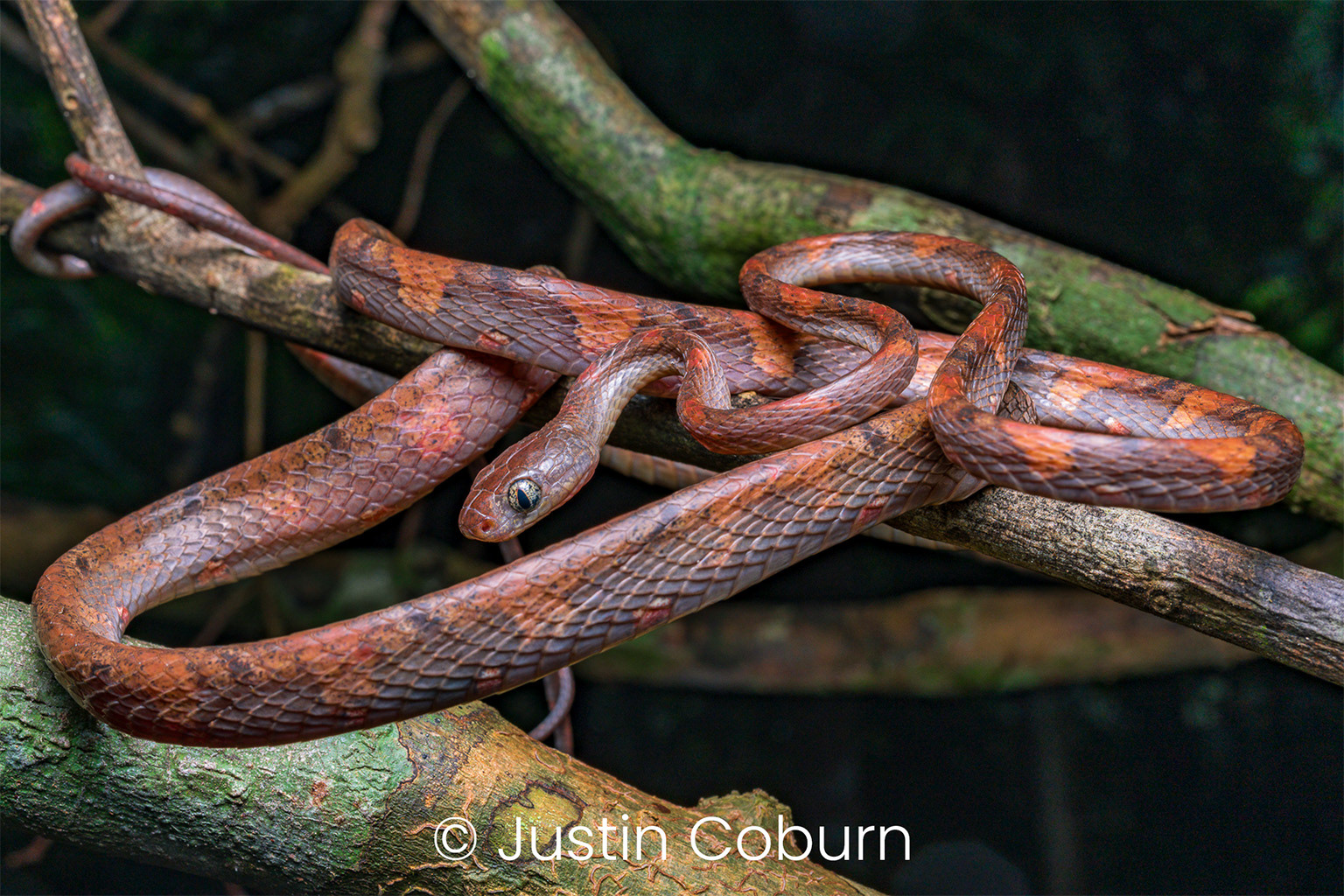
White-spotted cat snake (Boiga drapiezii).
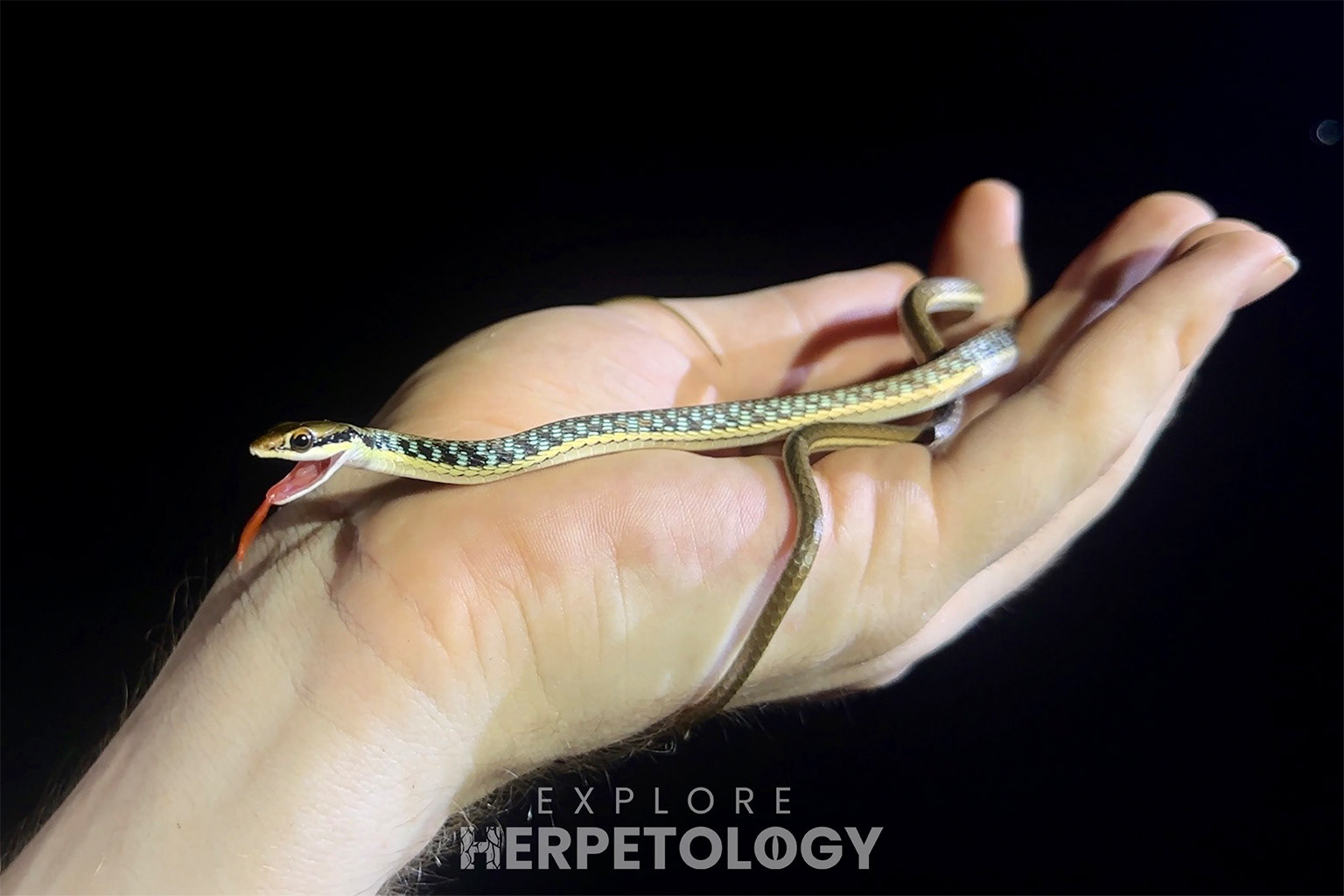
Painted bronzeback (Dendrelaphis pictus).
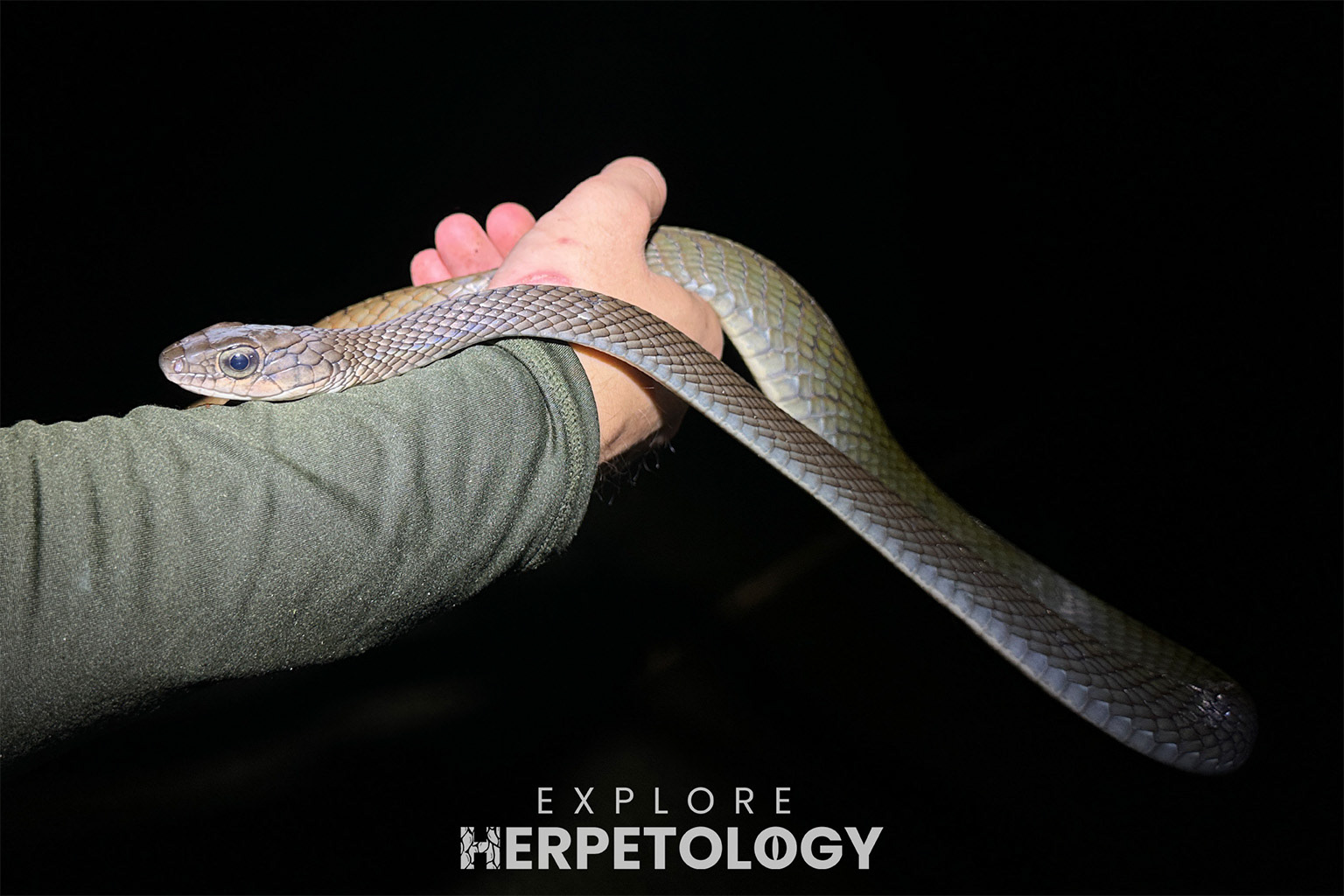
White-bellied rat snake (Ptyas fusca).
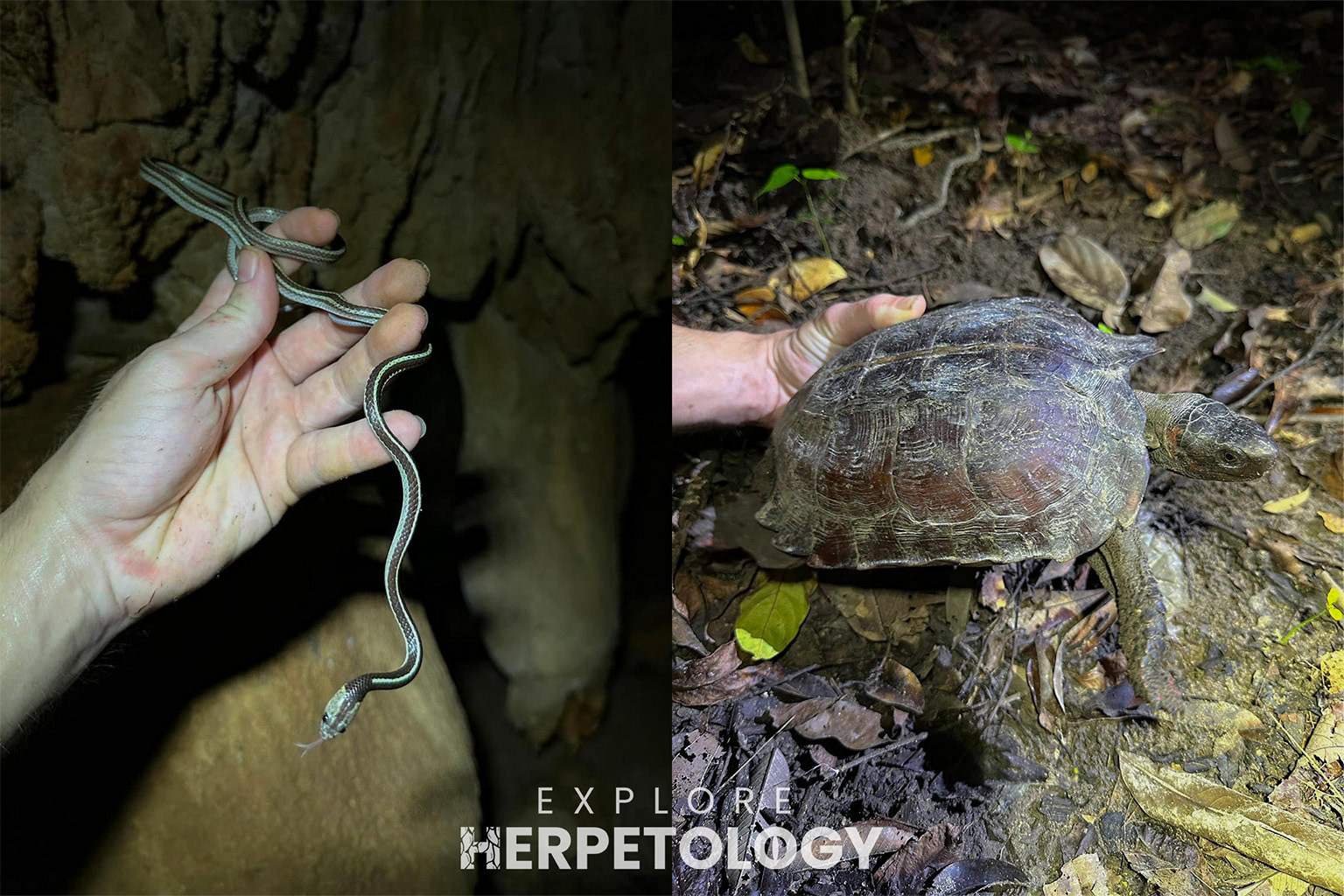
Left: Striped morph Lycodon subannulatus. Right: Heosemys spinosa.
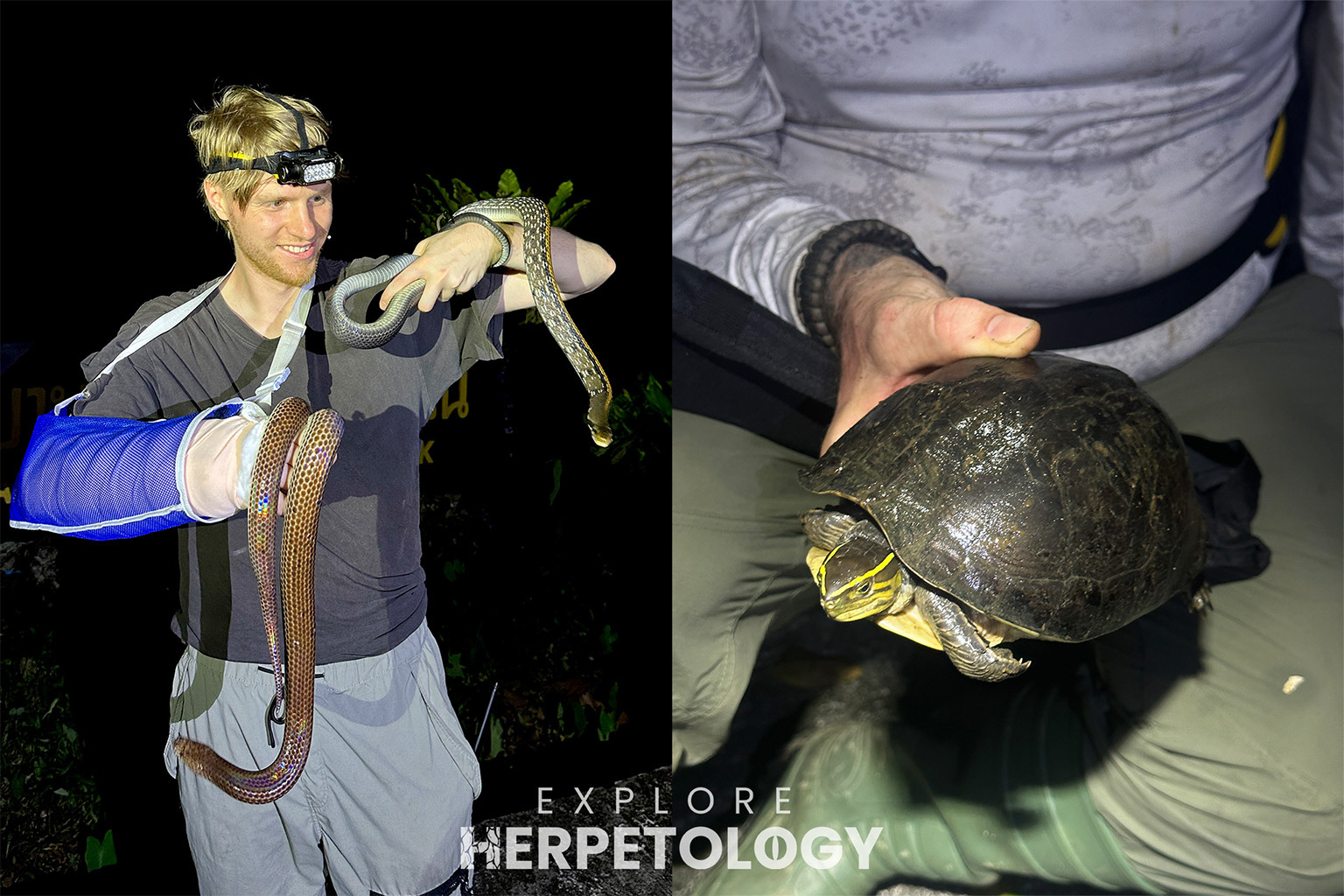
Left: Rupert with the first two snakes. Right: Cuora amboinensis.
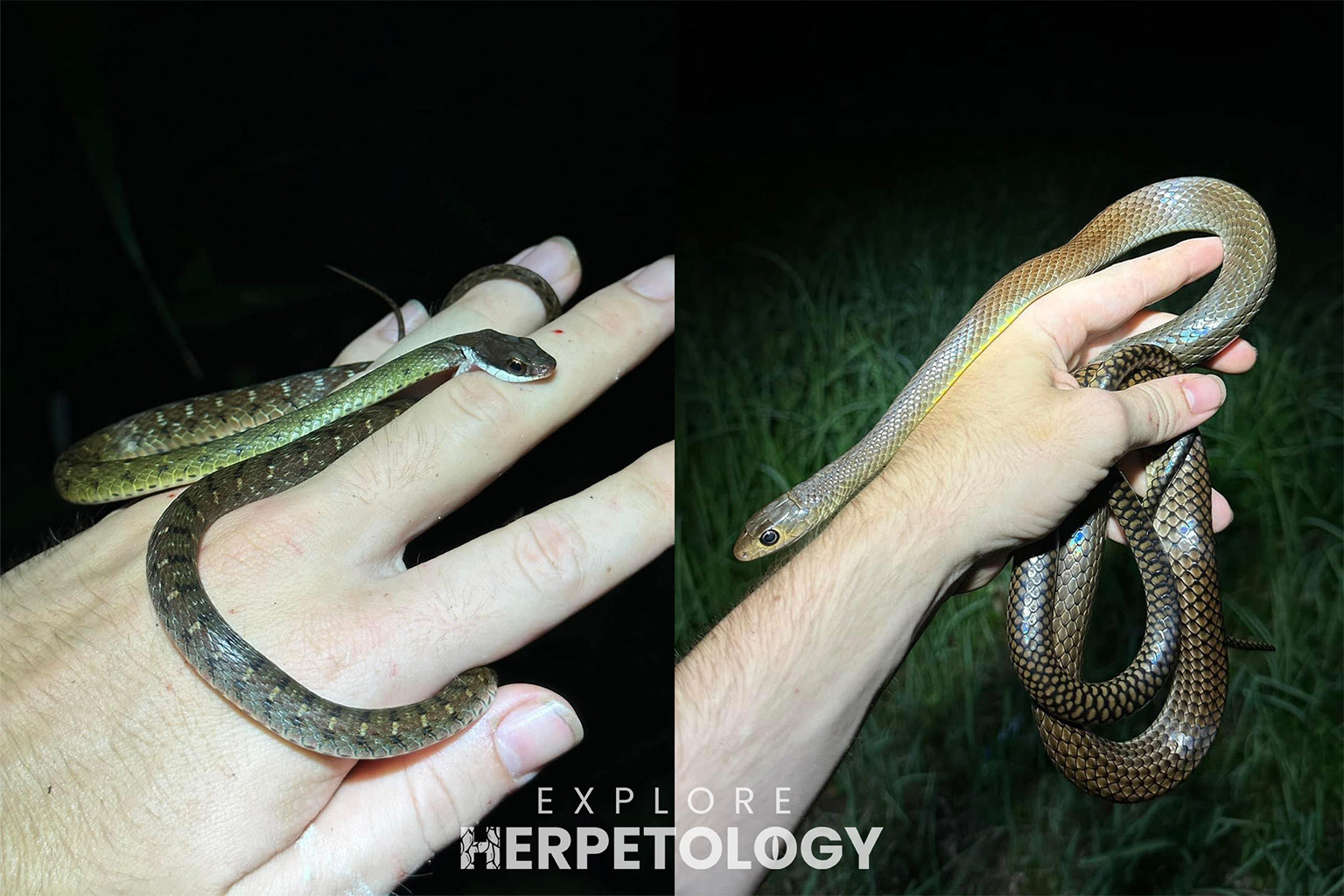
Left: Rhabdophis chrysargos. Right: Ptyas korros.
We tried again for Trimeresurus ciliaris on our second day in Satun, but failed to turn any up in the very short time we had to search. We also saw a keeled rat snake (Ptyas carinata) at the HQ, but it disappeared into some dense vegetation. Come nightfall, we decided to explore some different trails and areas than we usually do when herping in this area. As expected, we turned up significantly less than on the previous night, but the very first snake of the night was another red-headed krait (Bungarus flaviceps). This individual was significantly smaller and harder to photograph, always twitching and trying to flee. After this, our group also encountered a banded morph of the Malayan bridle snake (Lycodon subannulatus) and another juvenile Laotian wolf snake (Lycodon laoensis).
While exploring a slow flowing stream near some houses, we found a giant pond turtle (Heosemys grandis), one of the group's biggest targets for this area. Further along the same trail, we also used calls to locate a very rare frog species, the locally endemic Nakhawan bubble-nest frog (Feihyla marginis) - a lifer for every single person in the group. We also saw several Kuhl's gliding gecko (Gekko kuhli) and another elongated tortoise (Indotestudo elongata). At the very end of the night, David and Aaron went back to where the Ptyas carinata was seen during the daytime and managed to find it sleeping. A great end to our time here.
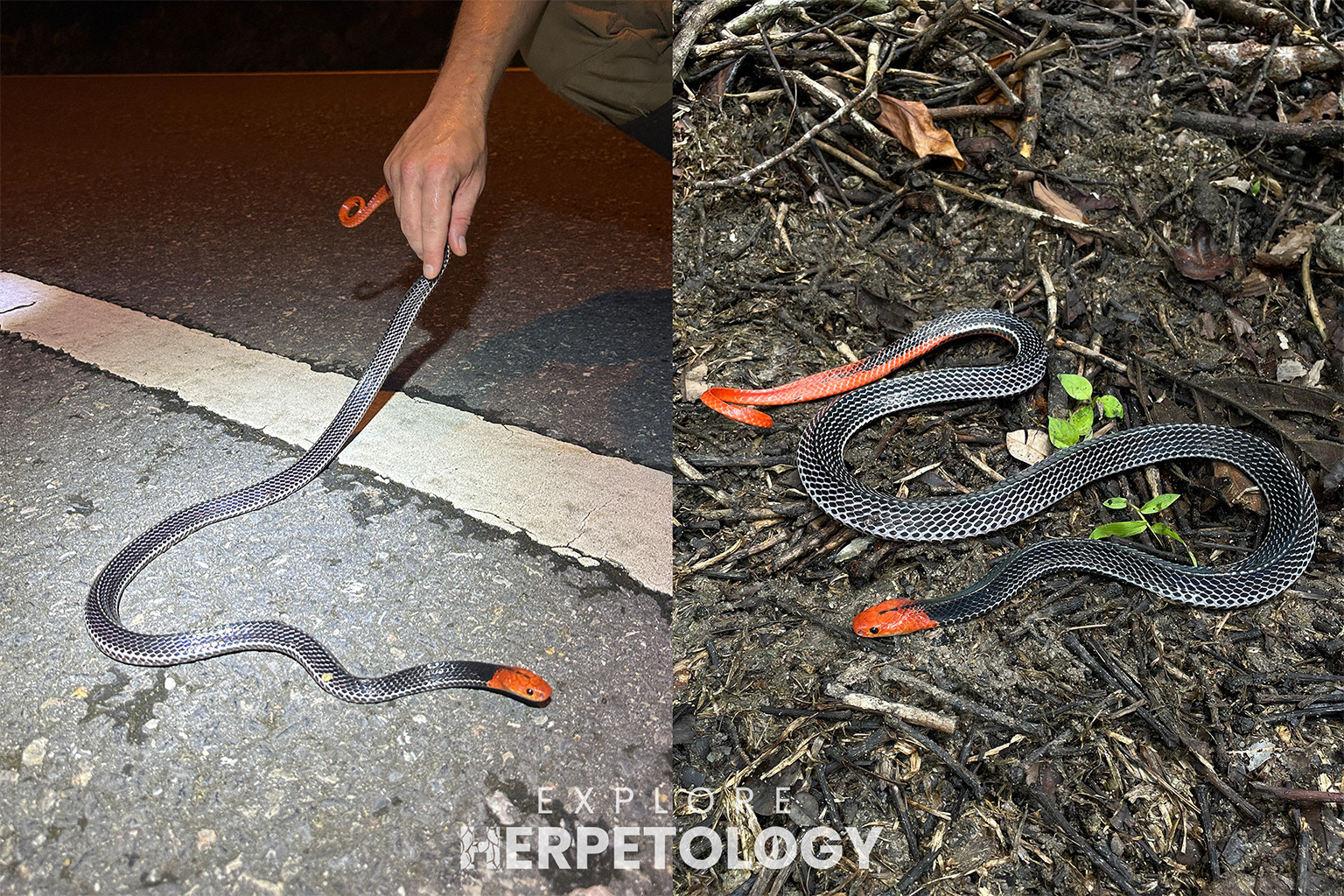
Red-headed krait (Bungarus flaviceps).
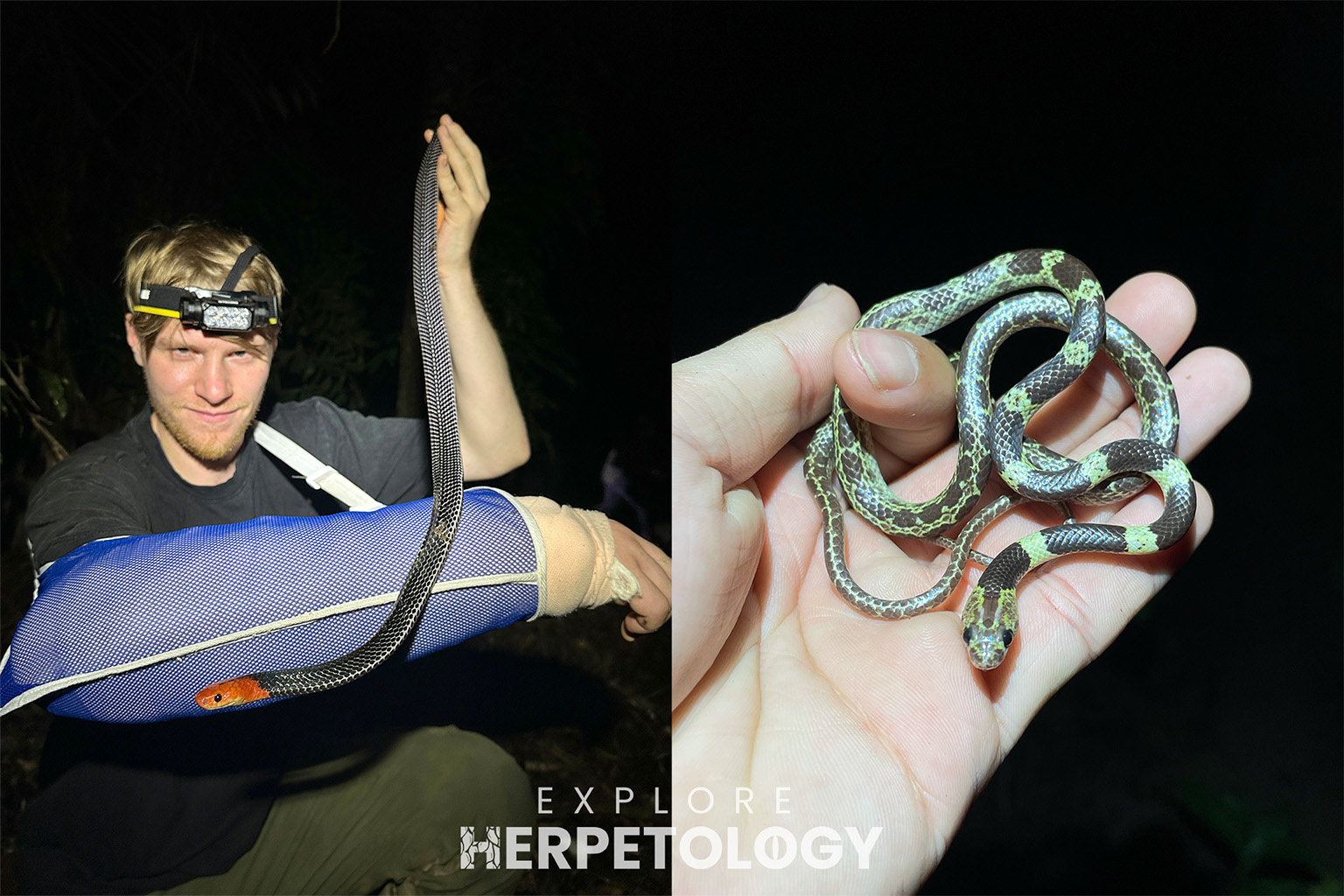
Left: RHK. Right: Lycodon subannulatus (banded morph).
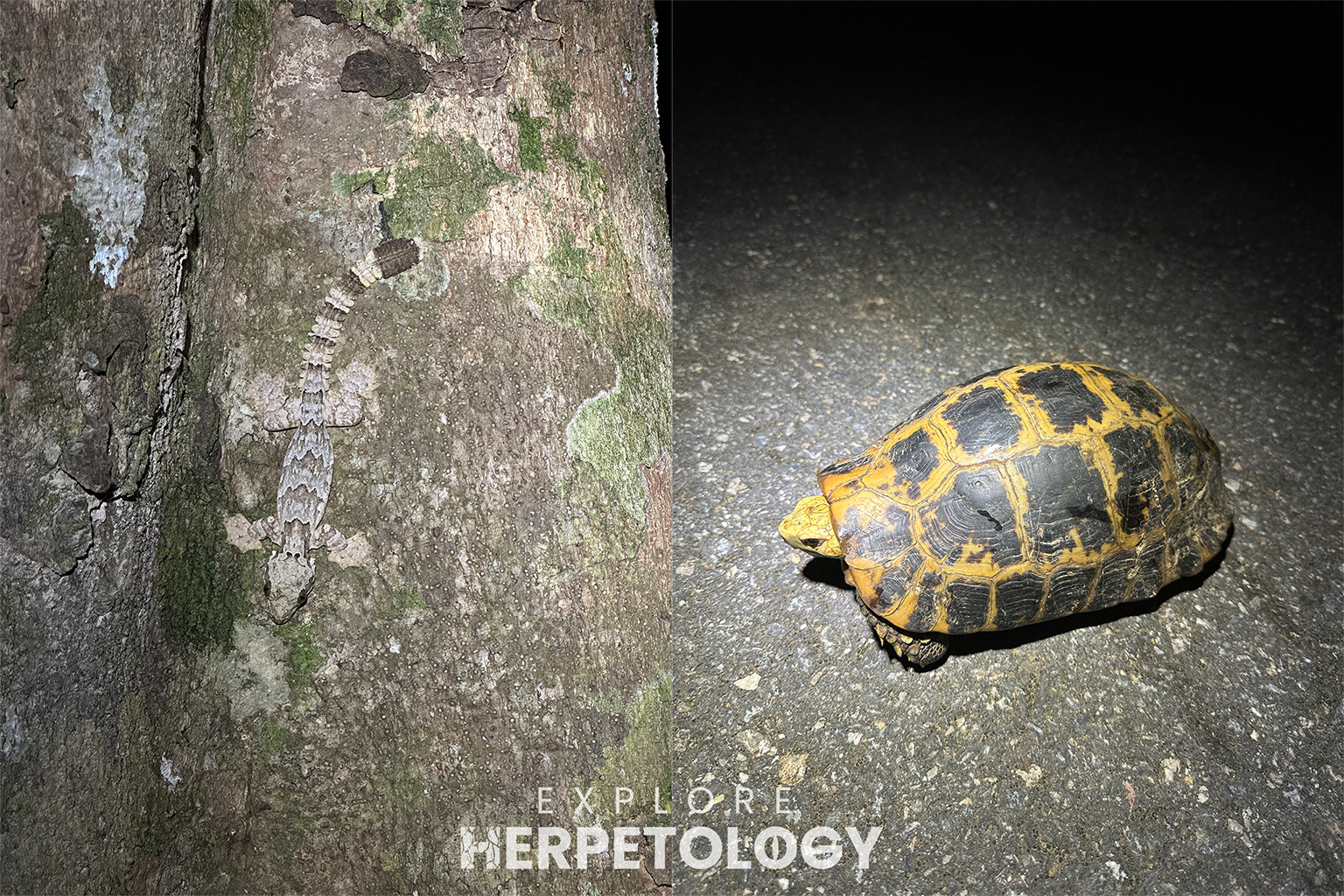
Left: Gekko kuhli. Right: Indotestudo elongata.
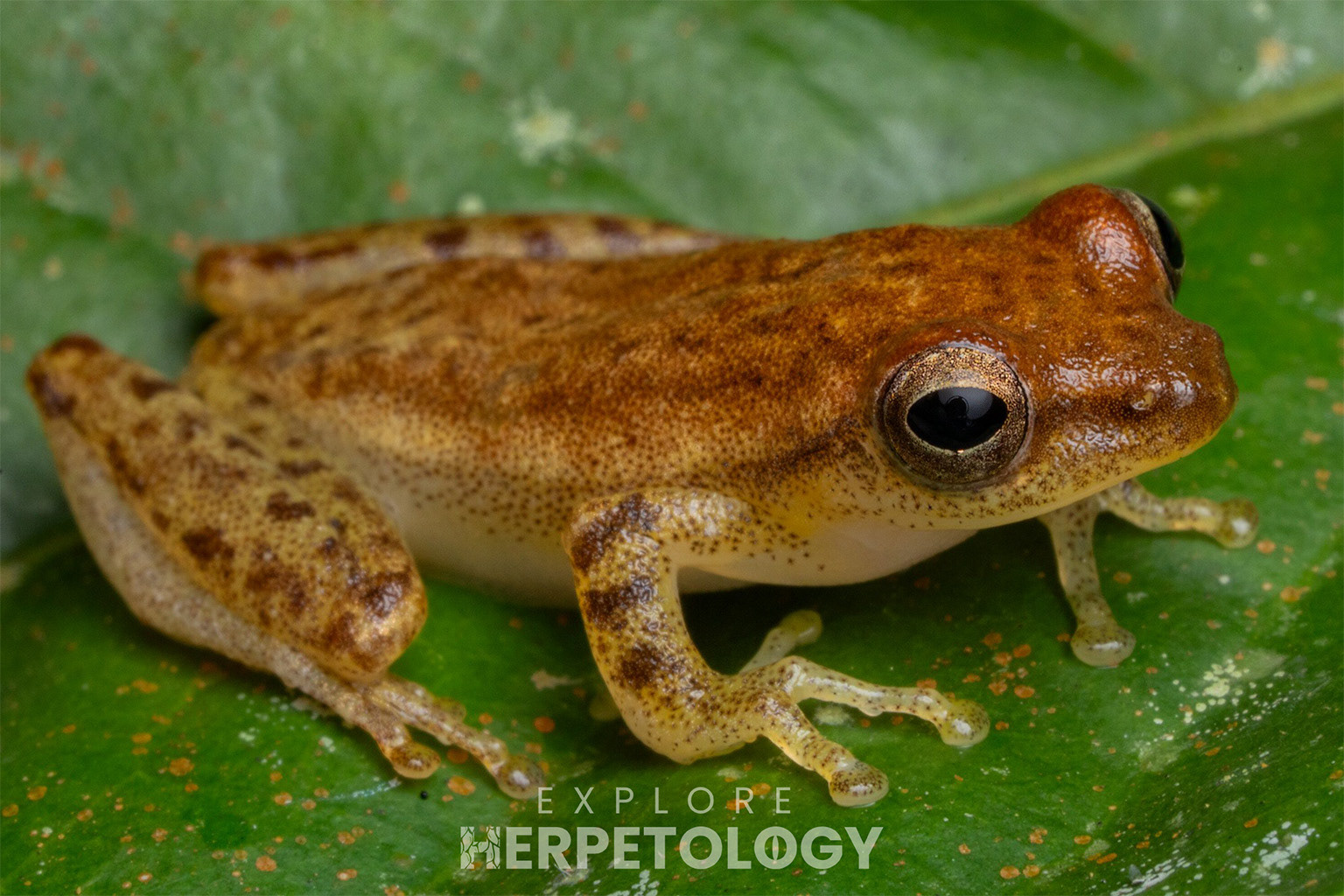
Nakhawan bubble-nest frog (Feihyla marginis).
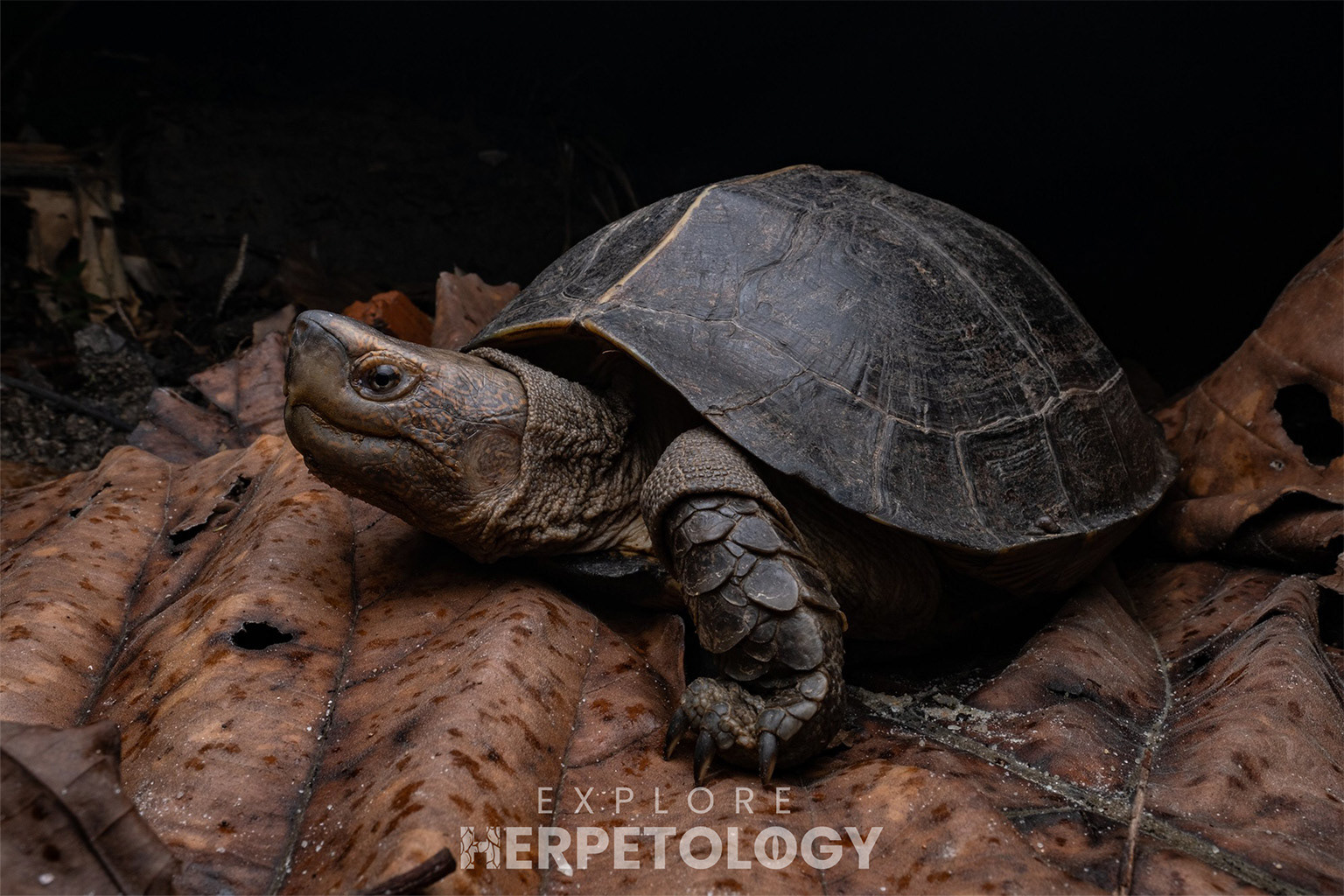
Giant pond turtle (Heosemys grandis).
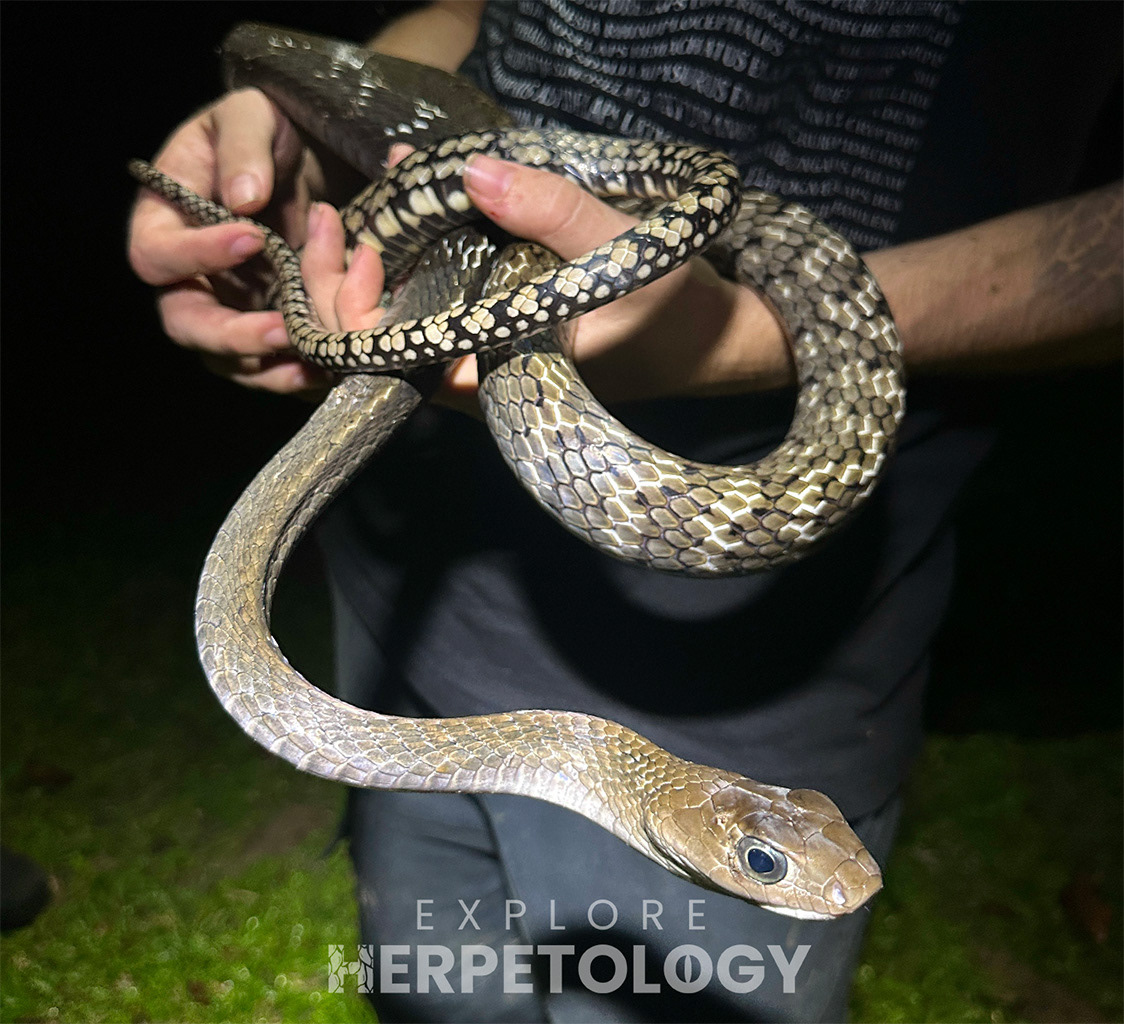
Keeled rat snake (Ptyas carinata).
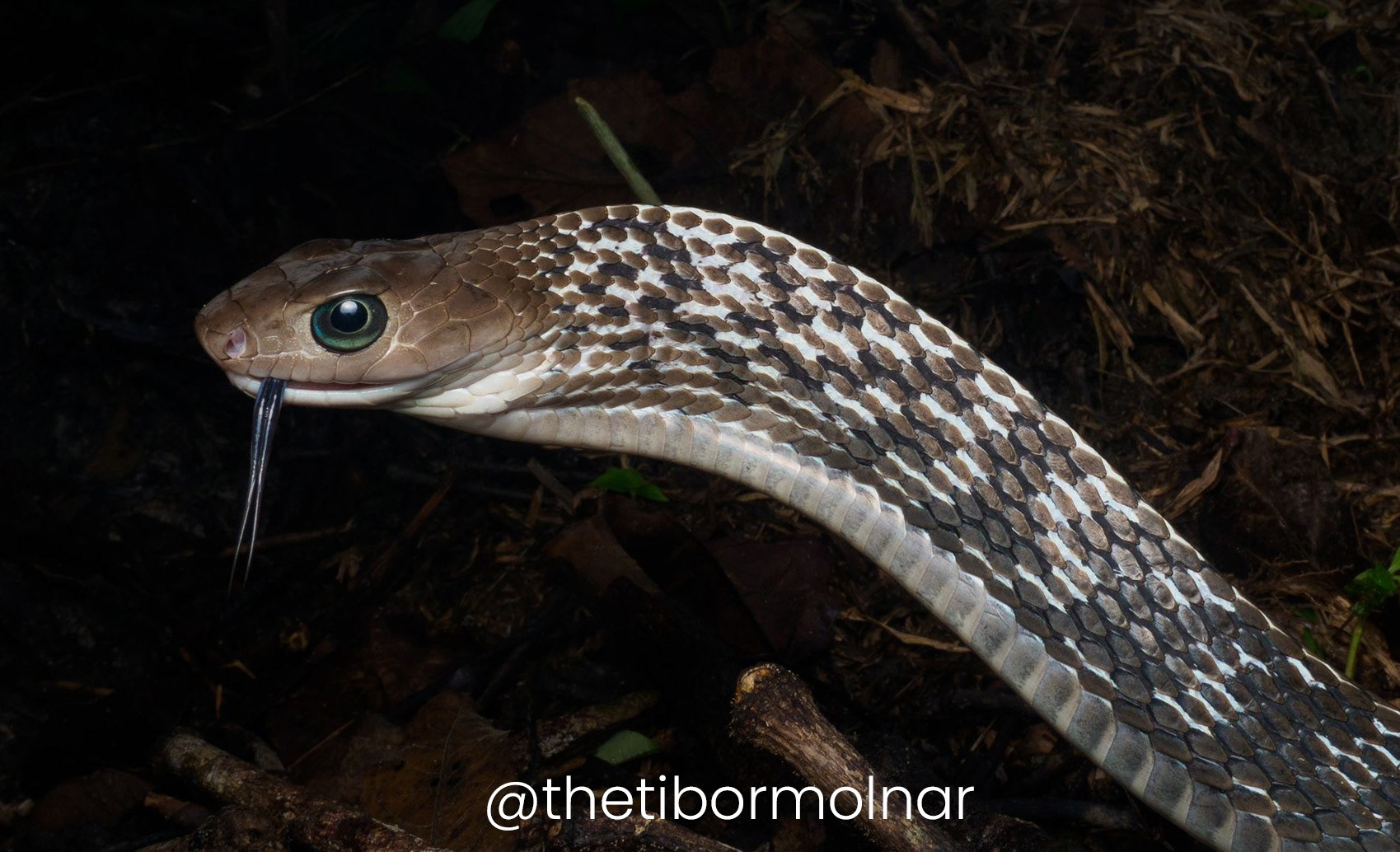
Keeled rat snake (Ptyas carinata).
PHATTHALUNG (6th-9th)
Before leaving Satun, we had breakfast at our favourite restaurant near the national park. Just as we were about to pay, David saw and caught yet another chelonian species at the limestone stream visible from the seating area. It was a tiny juvenile Malayan softshell (Dogania subplana), the 5th chelonian seen in just 2 days at this location.
From here we travelled to our 6th and final location of the trip, Phatthalung. We would be spending 3 days here, extended from 2 as this location had been so incredibly productive for us in previous trips. This time was no different, as we found a large striated bronzeback (Dendrelaphis striatus) right outside our bungalows seconds after leaving the rooms to begin herping. This species is usually very rare, but seems to be locally abundant in Phatthalung.
Further along the same stream, we caught a triangle keelback (Xenochrophis trianguligerus) and a Malayan vine snake (Ahaetulla mycterizans), followed closely by a an awesome Jasper cat snake (Boiga jaspidea), the rarest Boiga species in Southern Thailand. We have seen this species here before, but this was our first time finding one on any 'Expedition Thai Peninsula'. We concluded this particular walk with a visit to one of our all time favourite caves, which had a beautiful cave racer inside as always, this time resting on a steep overhanging wall. On the way back, we found a juvenile white-spotted cat snake (Boiga drapiezii).
After this, we switched up to a nearby waterfall where we found several more snakes, including all three species of vine snake, most notably a grey morph speckle-headed vine snake (Ahaetulla fasciolata), an adult Laotian wolf snake (Lycodon laoensis) and finally our first slug snake of the trip - a humble keeled slug snake snake (Pareas carinatus).
Now that we had finally got our first slug snake, it highlighted even further the biggest missing species on this trip. Where were the mangrove cat snakes? Last year, we had seen these at every single location except Phuket and Snake Island, but this time we were completely skunked at some of our most reliable spots. In Satun, we had seen two individuals which were freshly killed on the road, but an alive Boiga melanota was beginning to weight heavily on us. Aaron in particular had become desperate for this species, and Rupert had promised him one at this location. By almost 2am, we had seen nothing. However, Rupert decided to do one more walk along the stream before bed and finally, at long last, spotted a very large mangrove cat snake (Boiga melanota) swimming in the water.
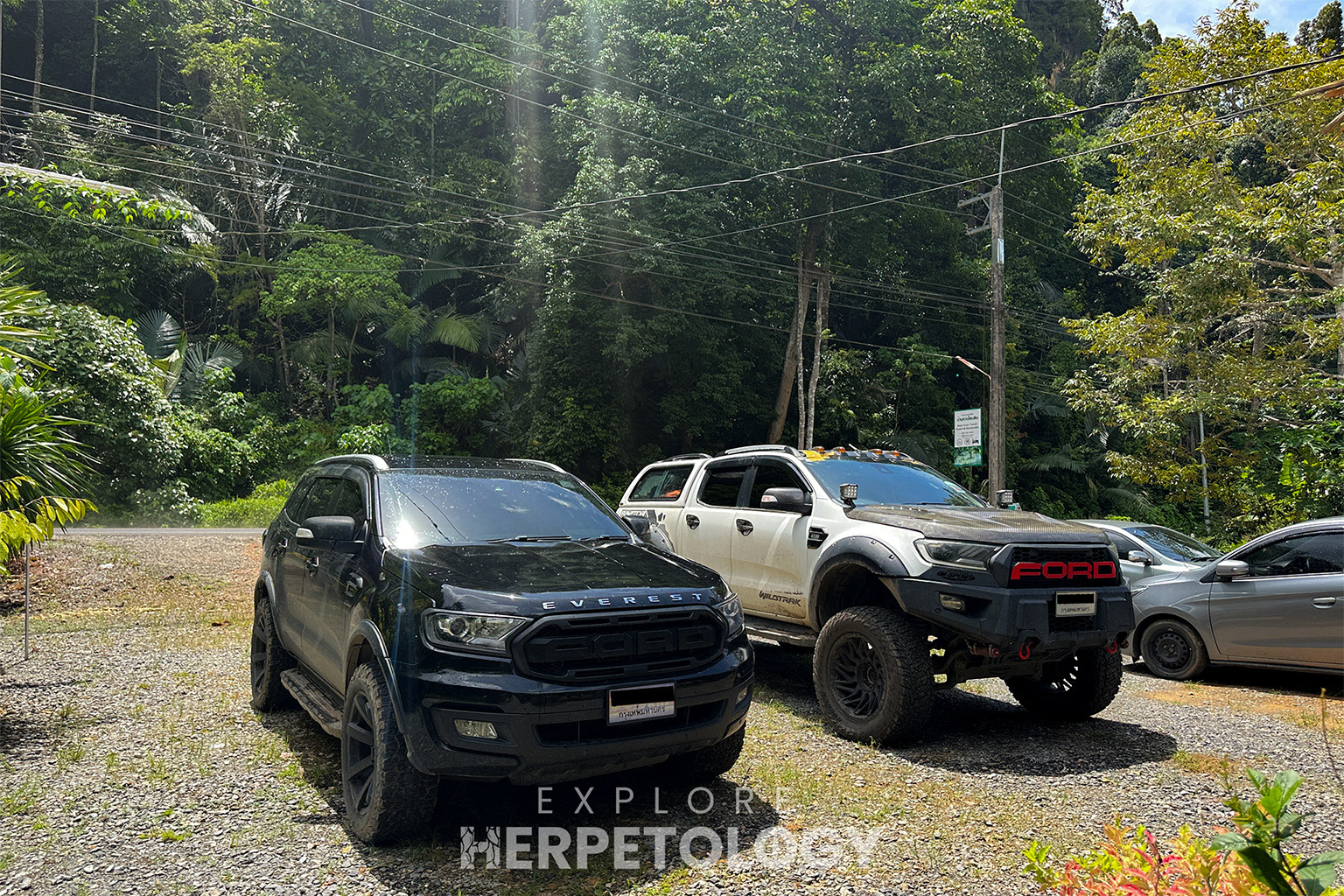
Just before leaving Satun.
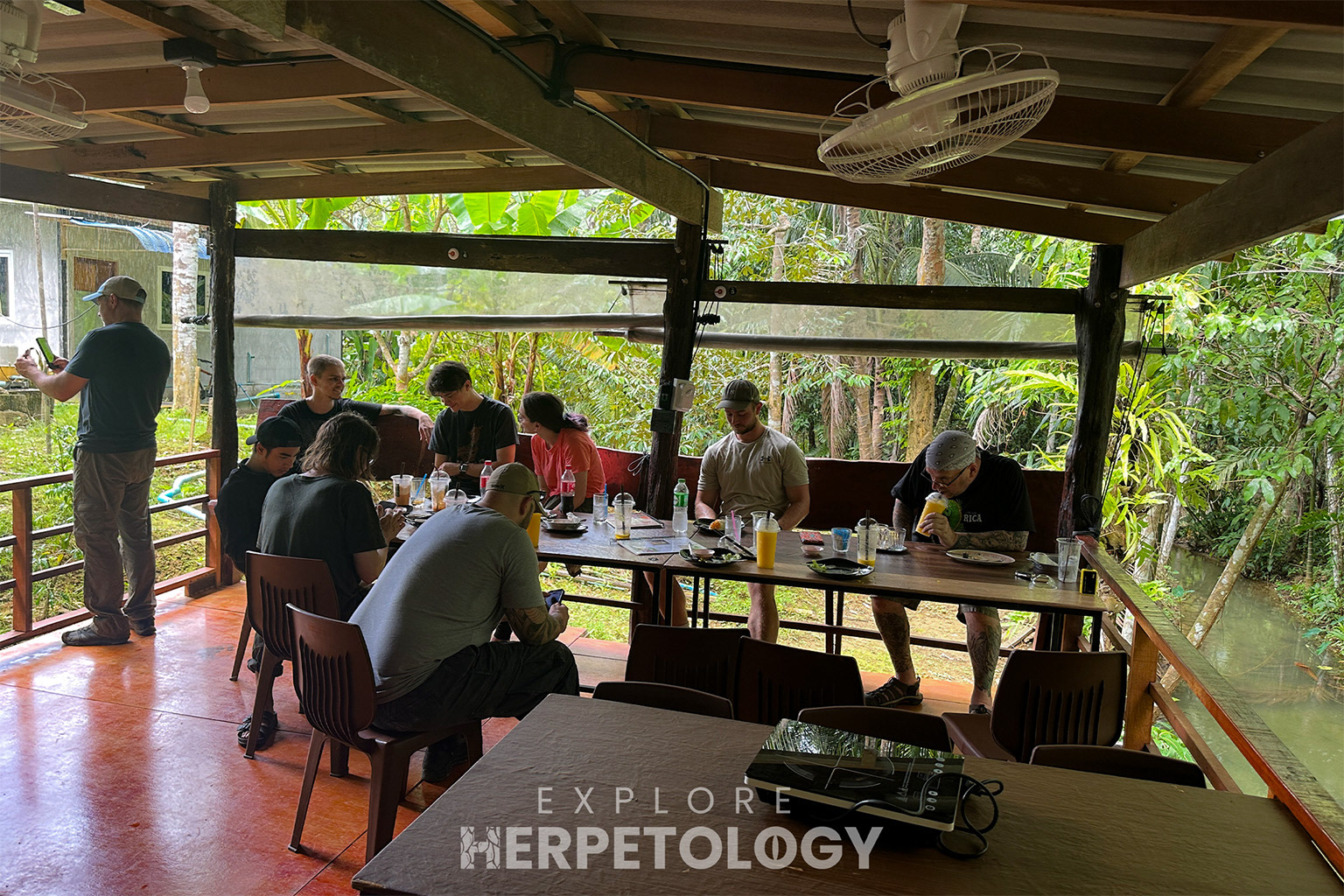
Our favourite restaurant in Satun.
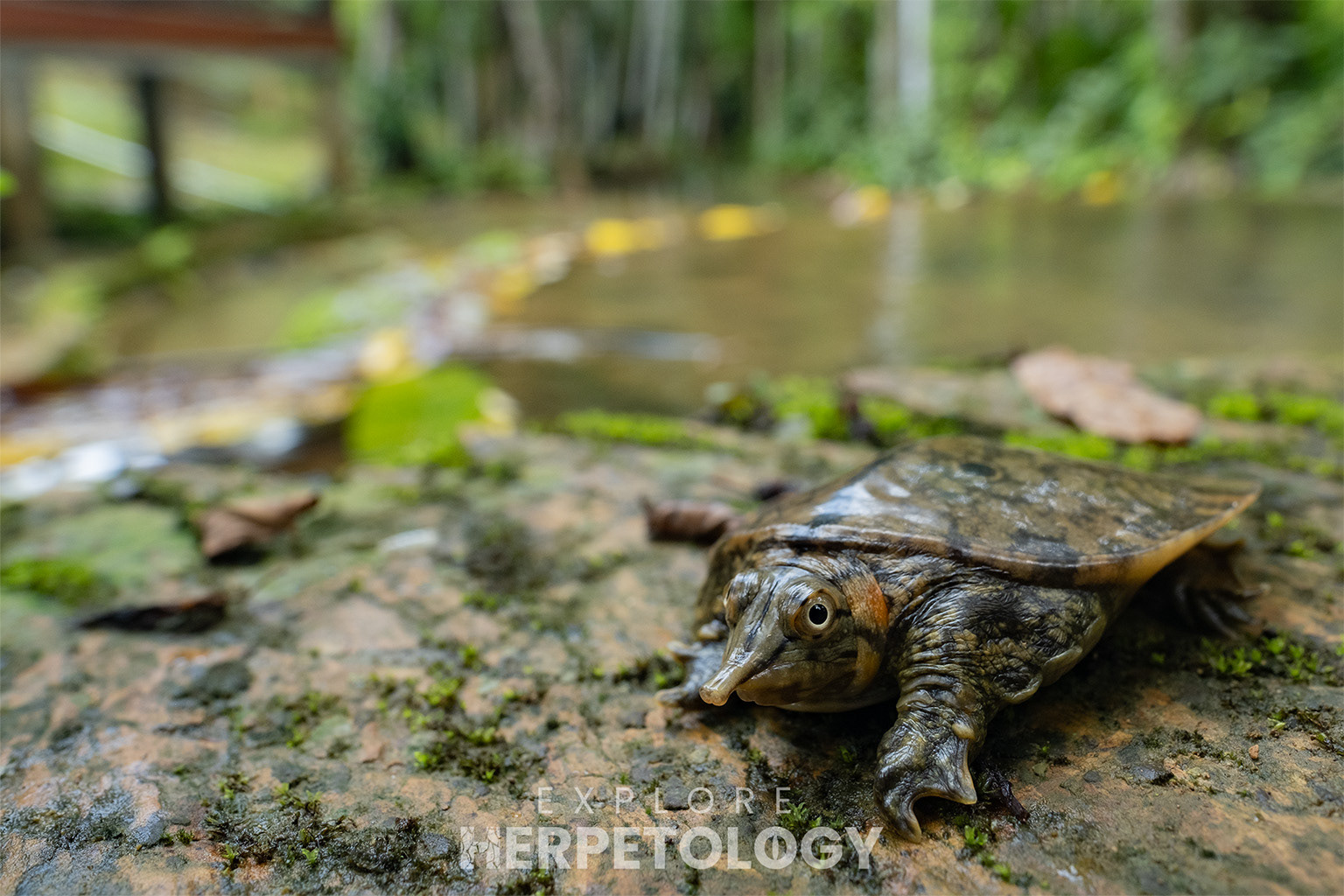
Malayan softshell (Dogania subplana).
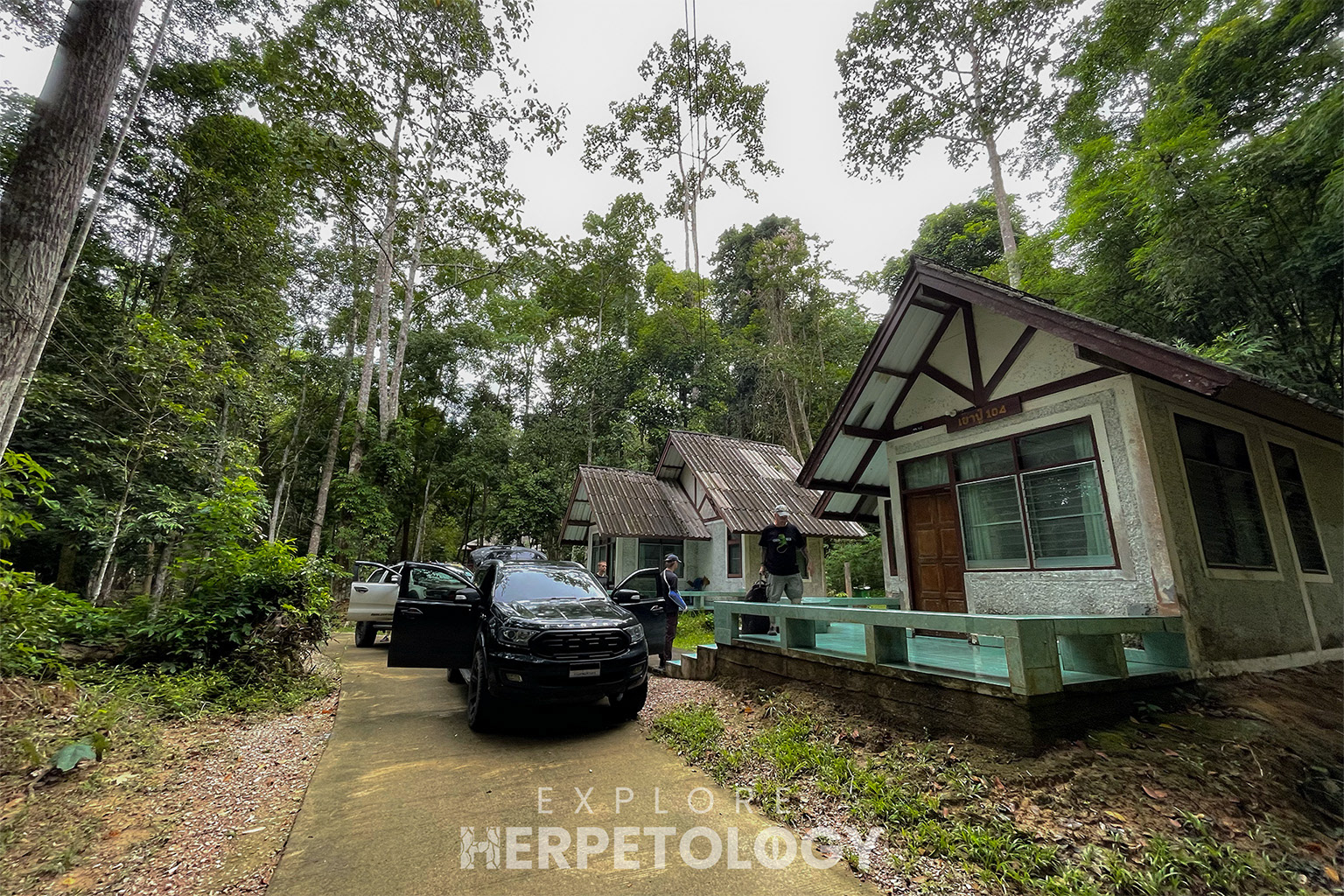
Accommodation in Phatthalung.
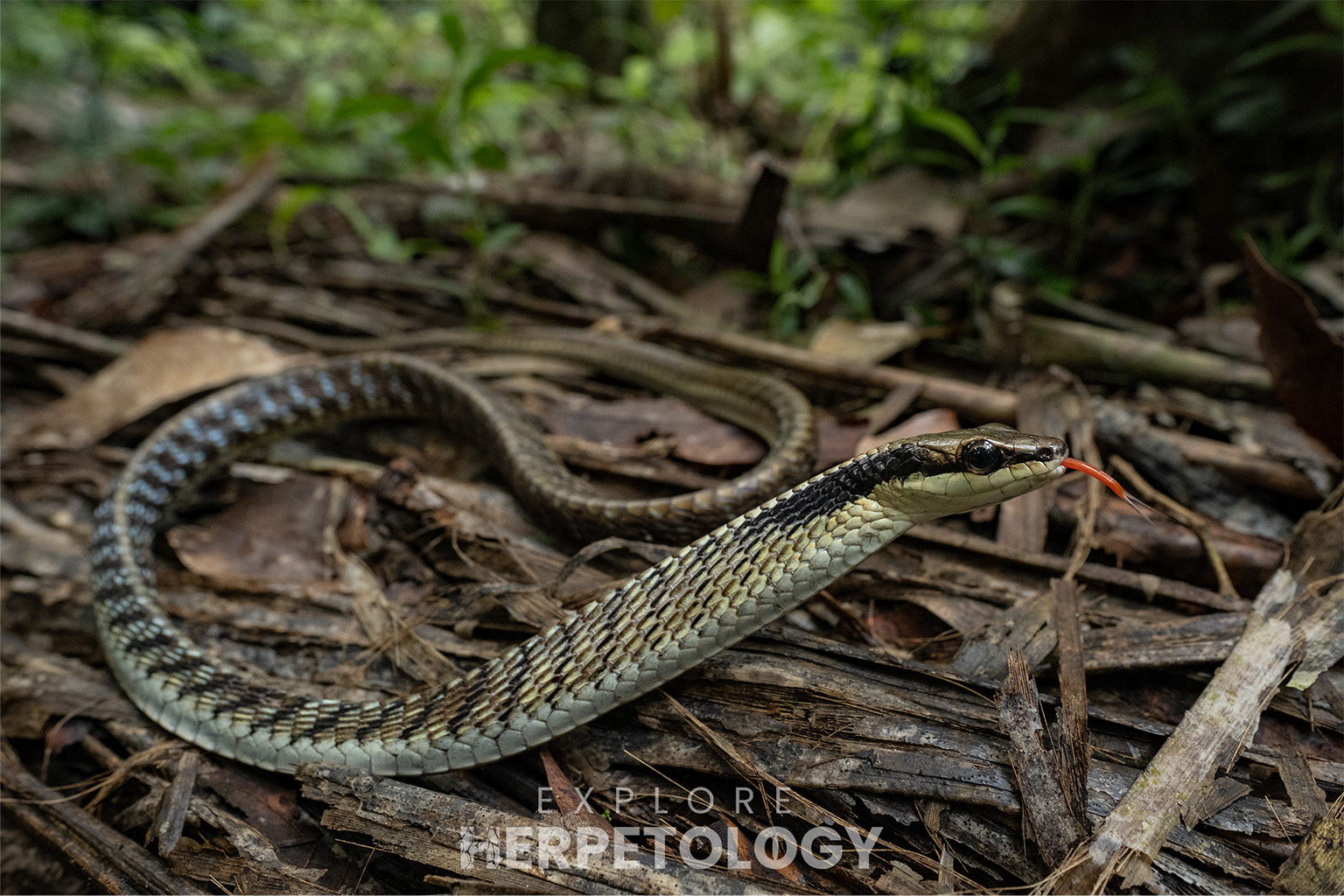
Striated bronzeback (Dendrelaphis striatus).
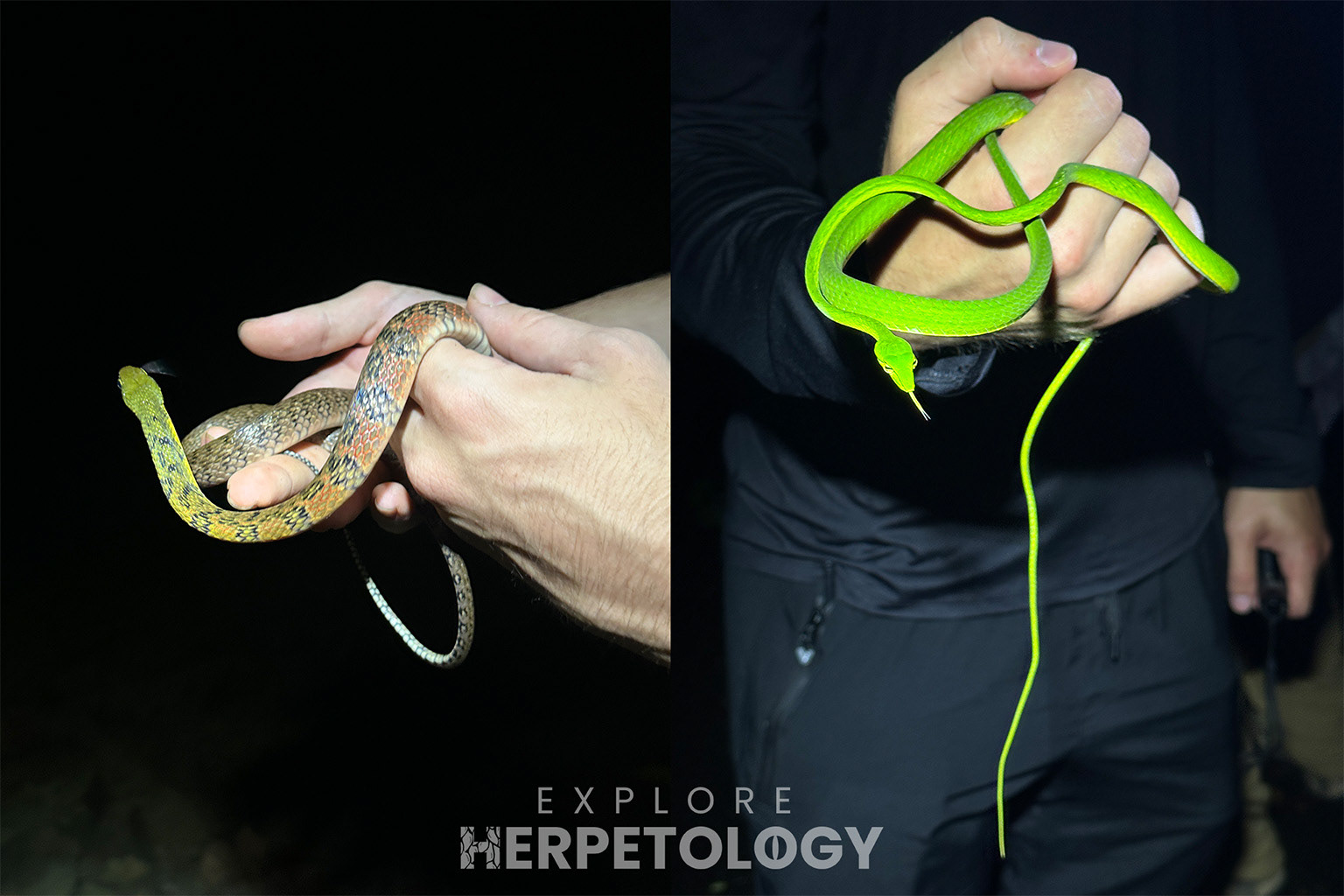
Left: X. trianguligerus. Right: Ahaetulla mycterizans.
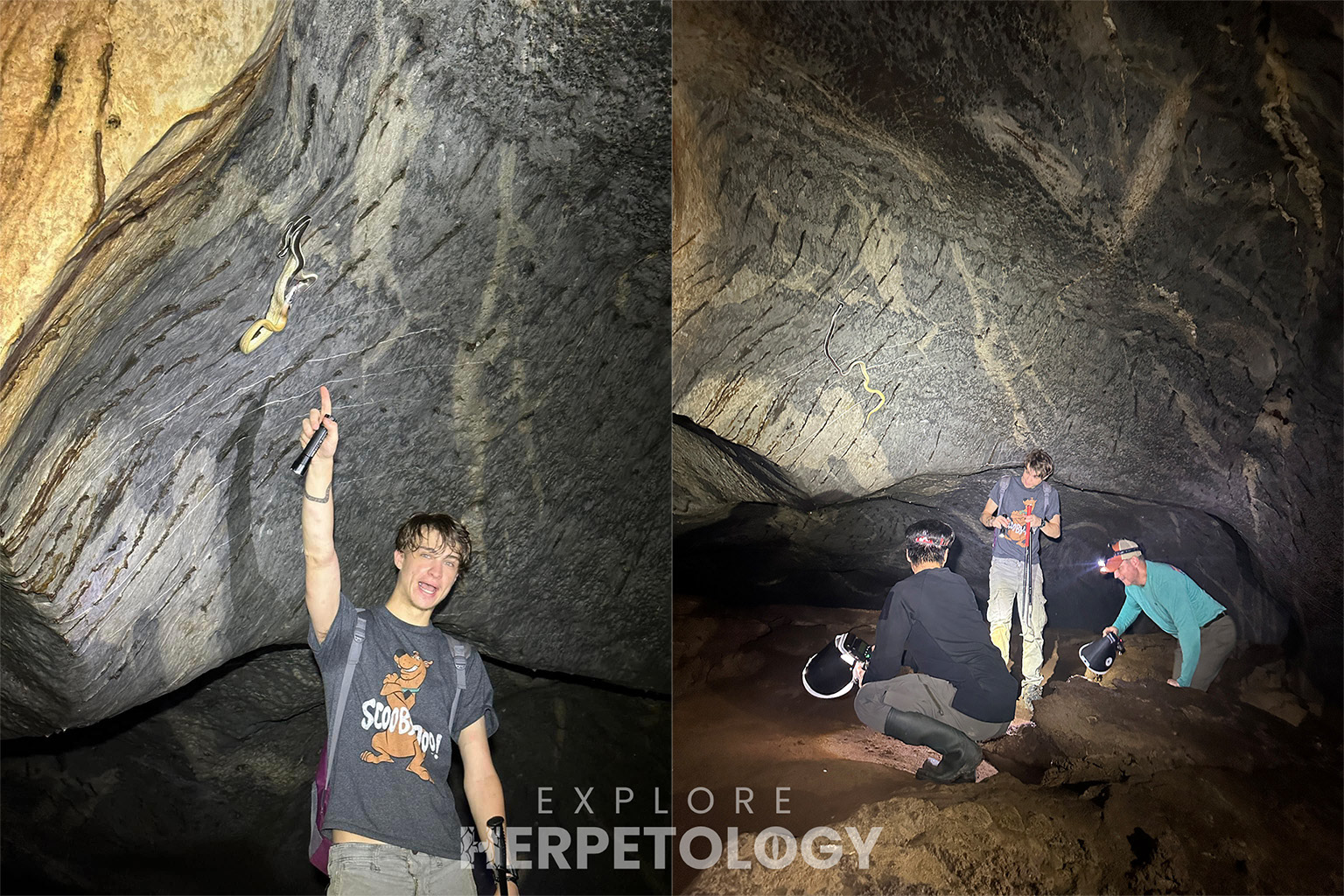
Cave racer (Elaphe taeniura ridleyi).
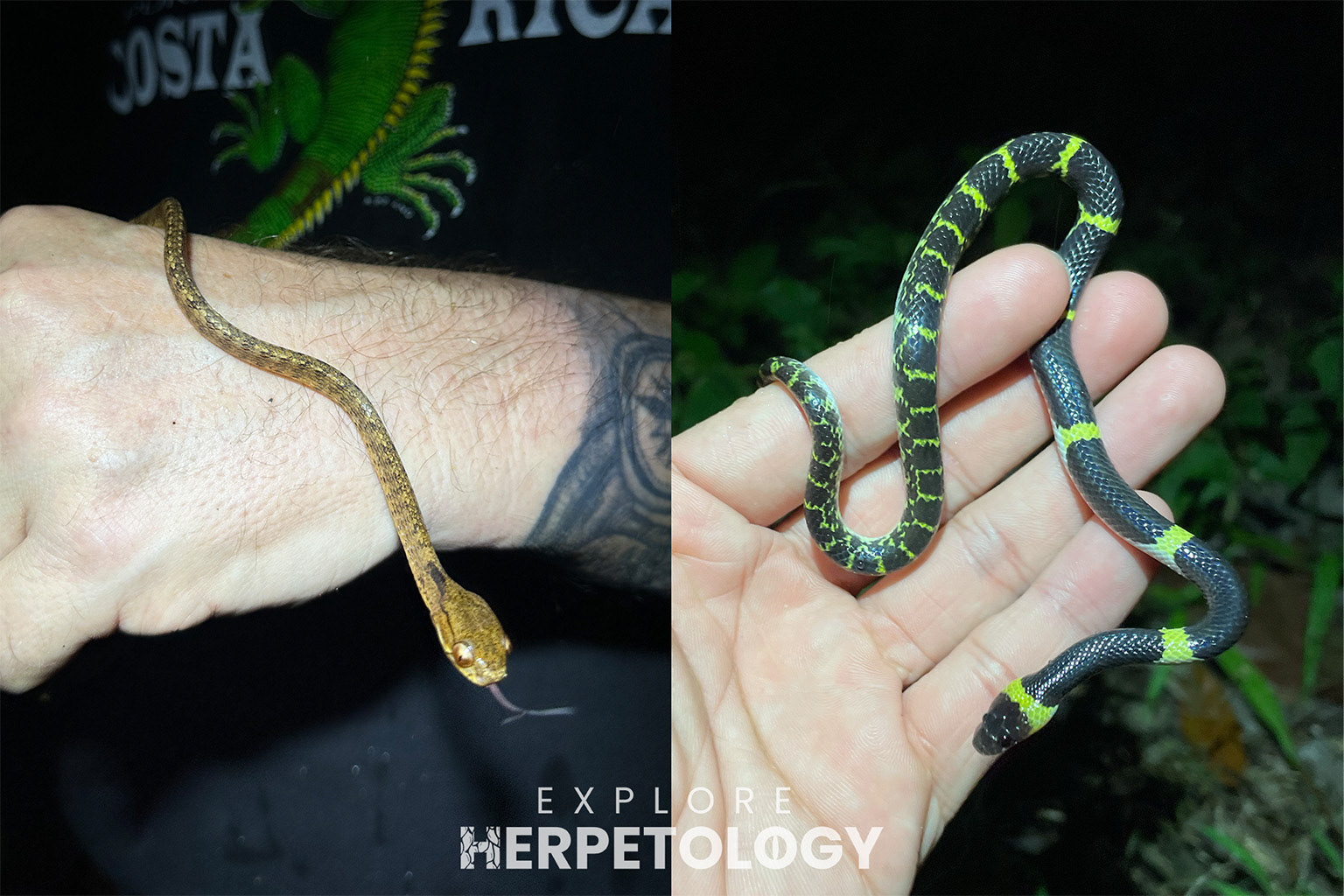
Left: Pareas carinatus. Right: Lycodon laoensis.
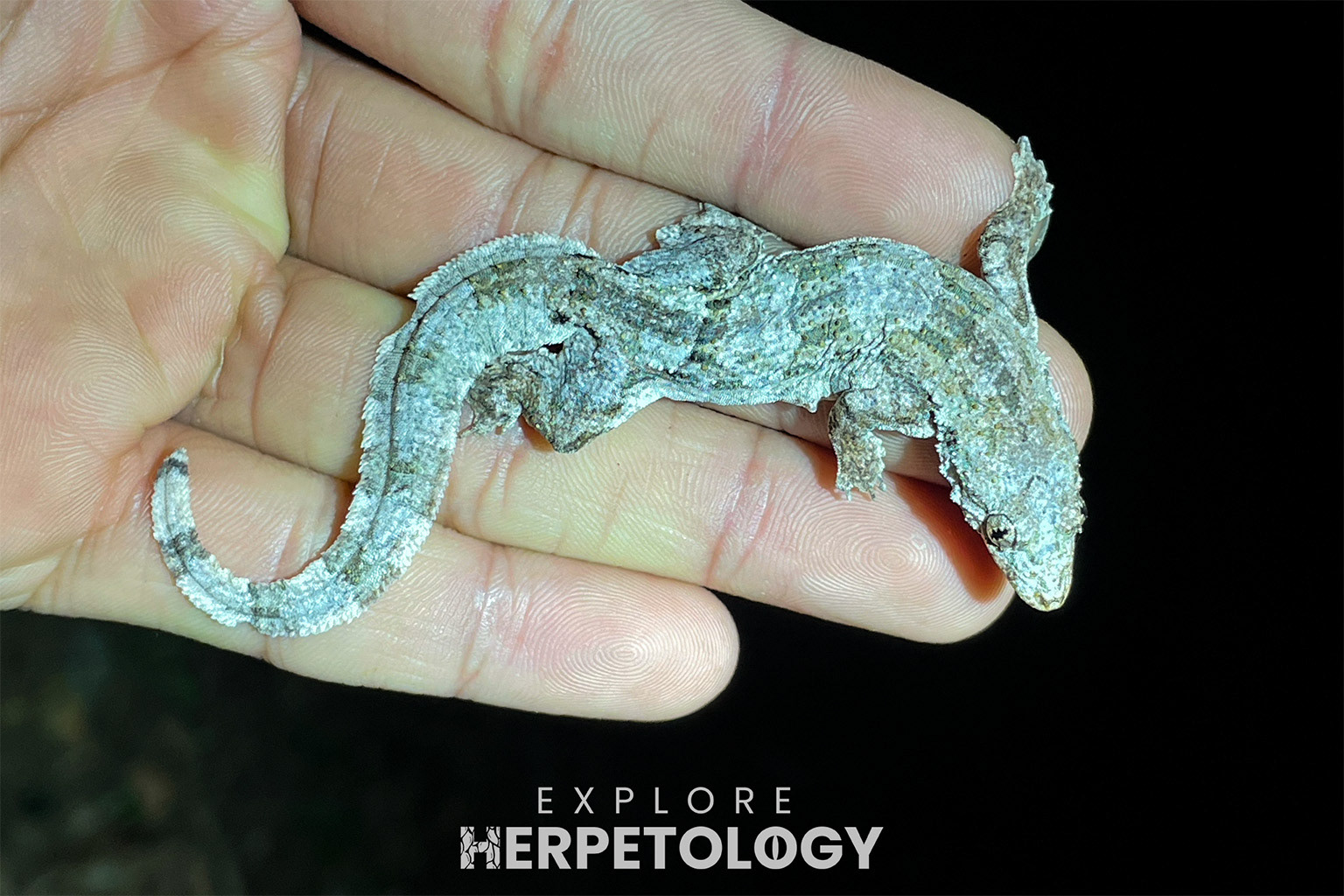
Frilled gecko (Hemidactylus craspedotus).
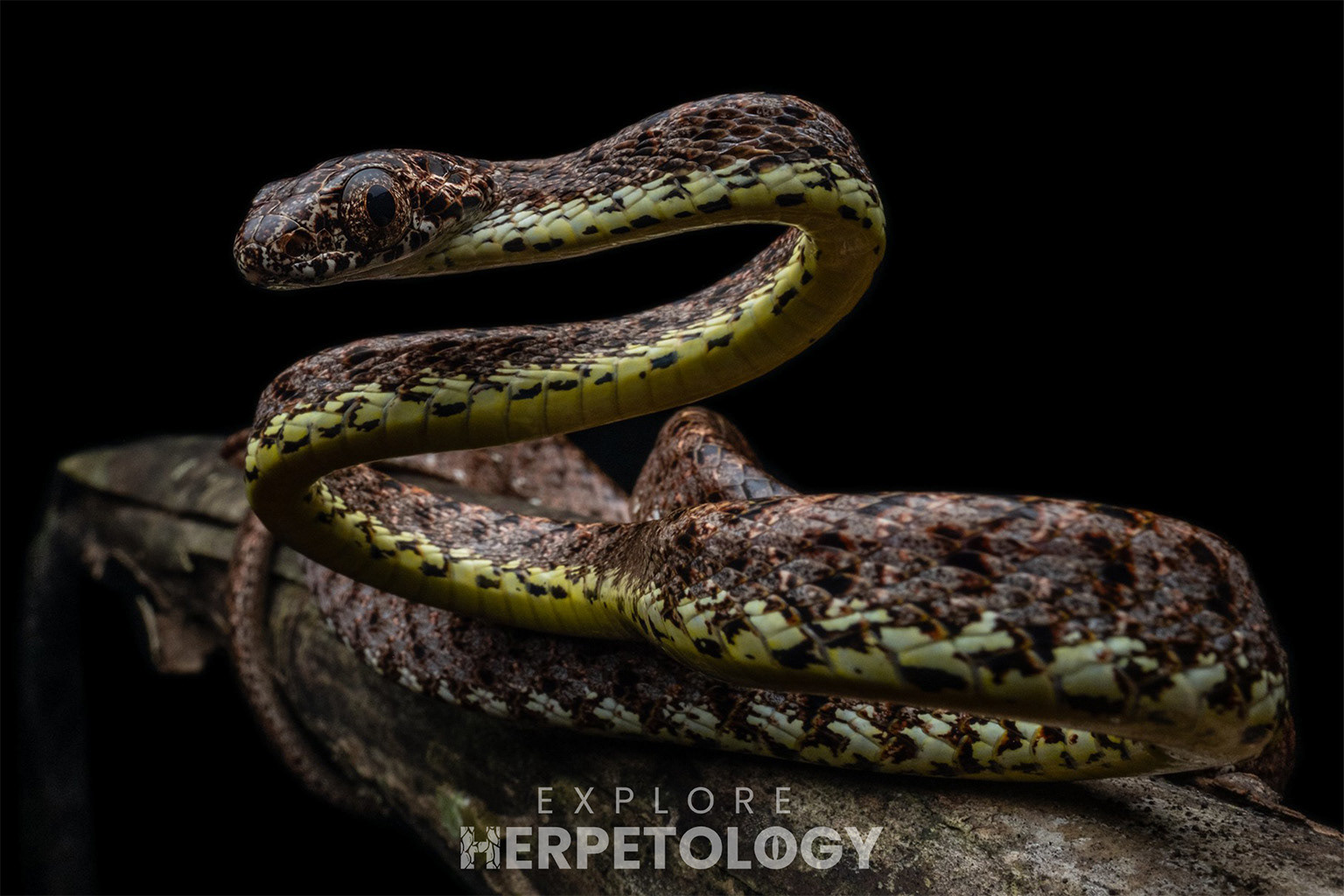
Jasper cat snake (Boiga jaspidea).
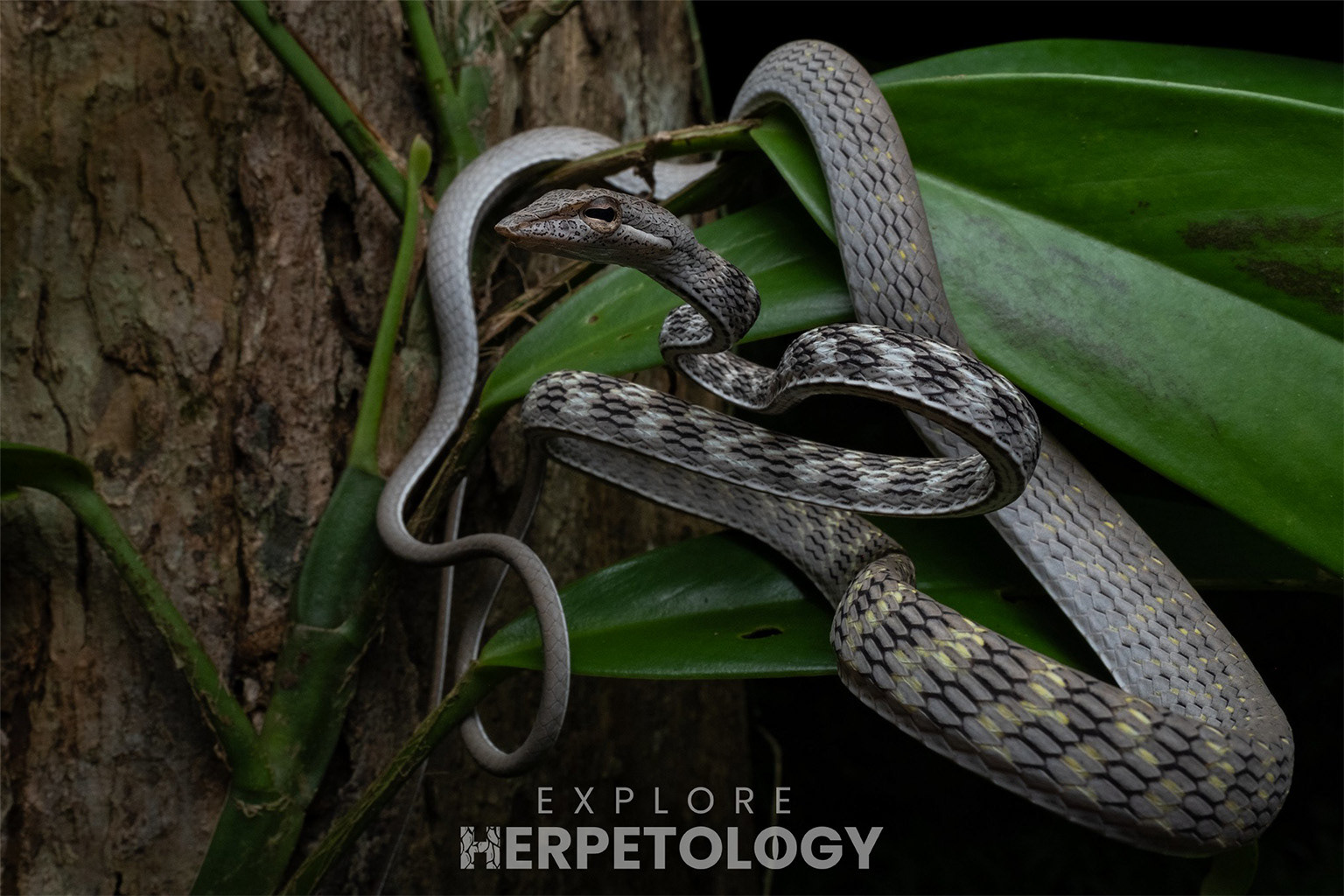
Speckle-headed vine snake (Ahaetulla fasciolata).
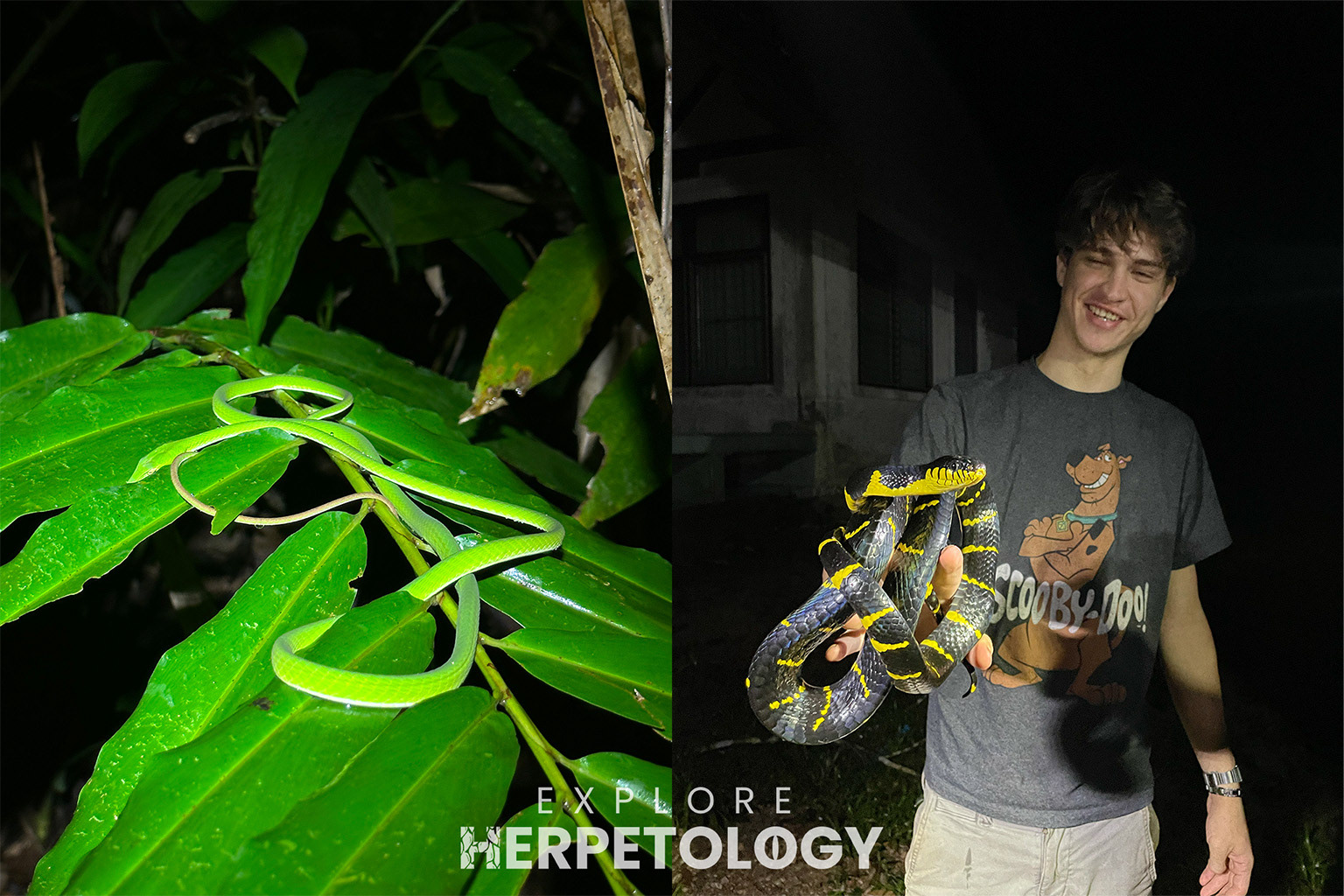
Left: Ahaetulla prasina. Right: Aaron with his long-awaited snake.
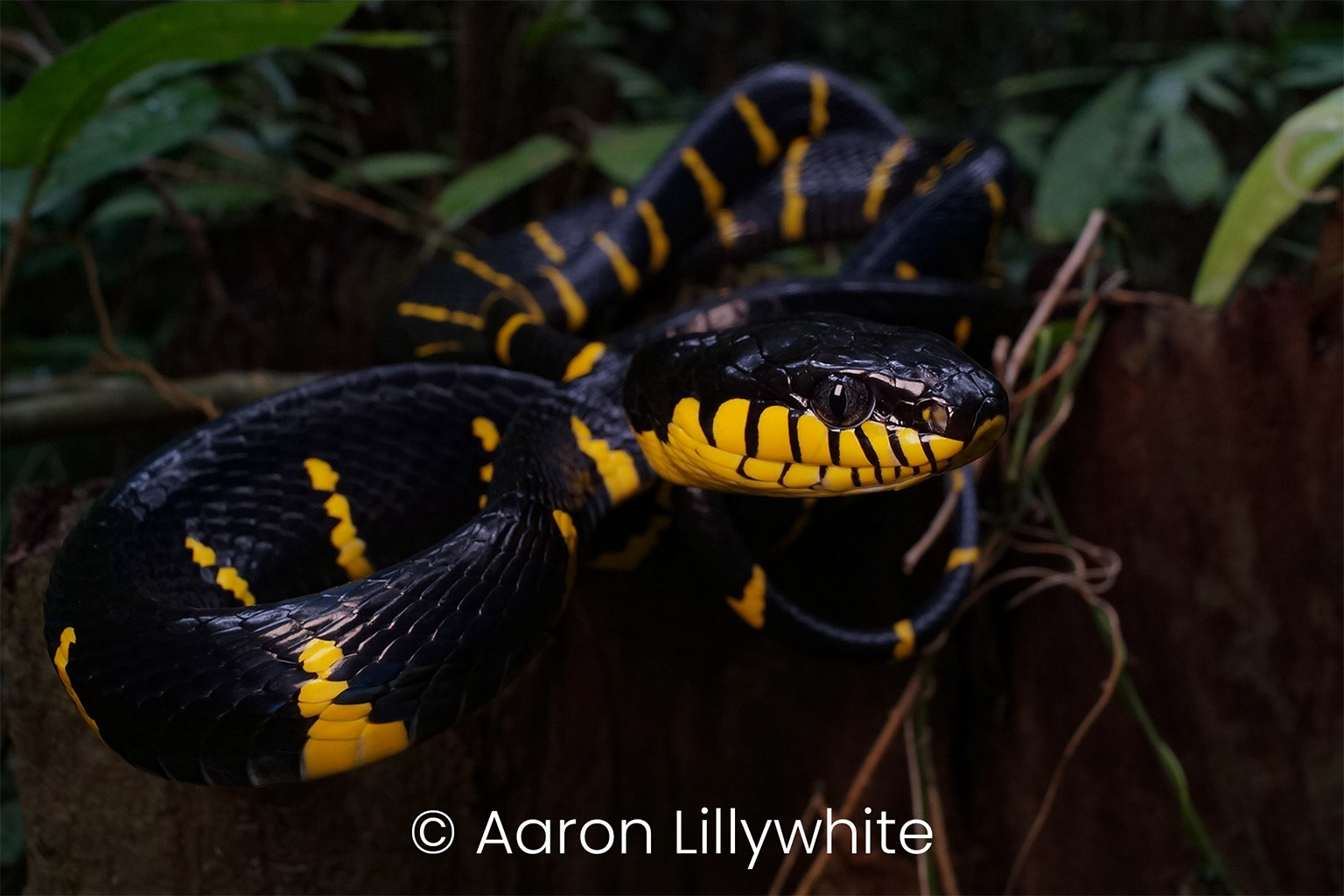
Mangrove cat snake (Boiga melanota).
The next day, we did not even have the opportunity to wake up properly before a showstopper appeared. As we were walking to the cars to drive to breakfast, Magnus spotted a simple incredible juvenile Dumeril's monitor (Varanus dumerilii) crossing the concrete path in front of this bungalow. This species is already rare, let alone the juveniles which have the world-famous striking orange head and bands.
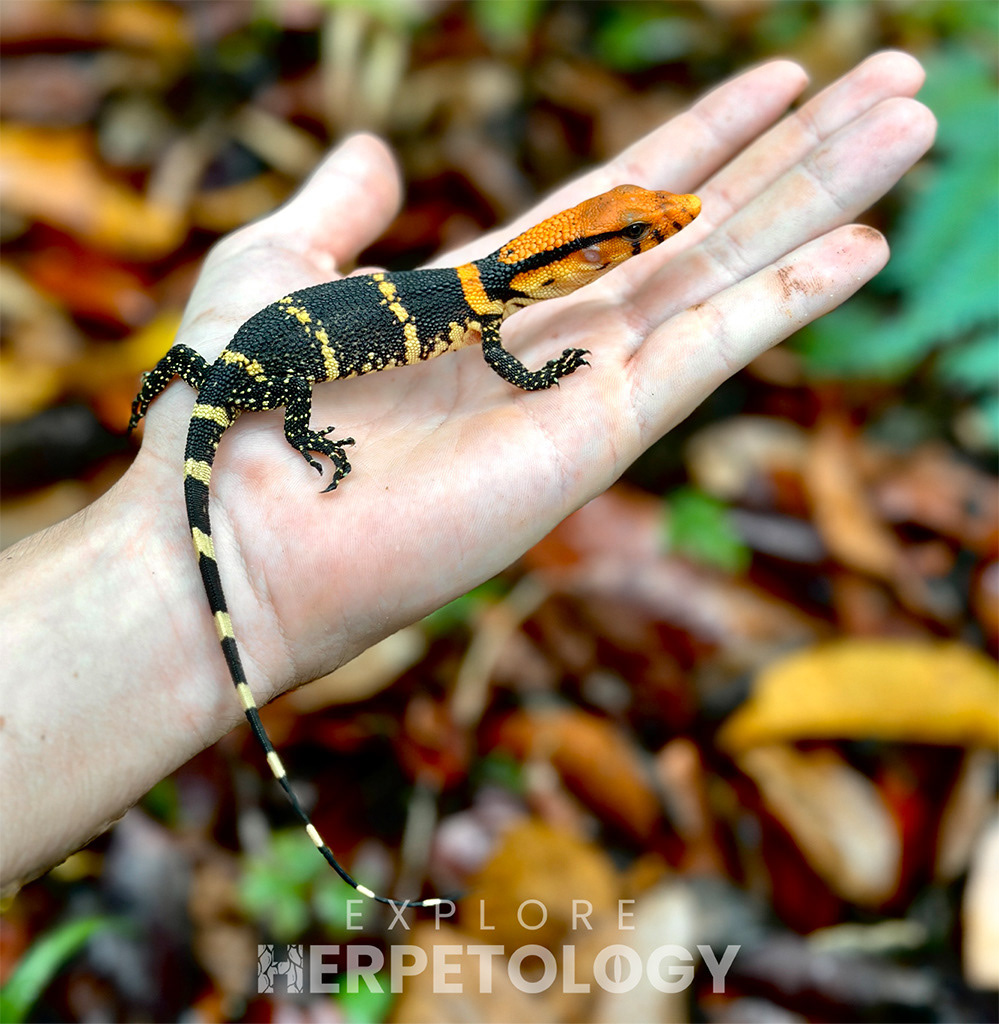
Juvenile Dumeril's monitor (Varanus dumerilii).

Juvenile Dumeril's monitor (Varanus dumerilii).
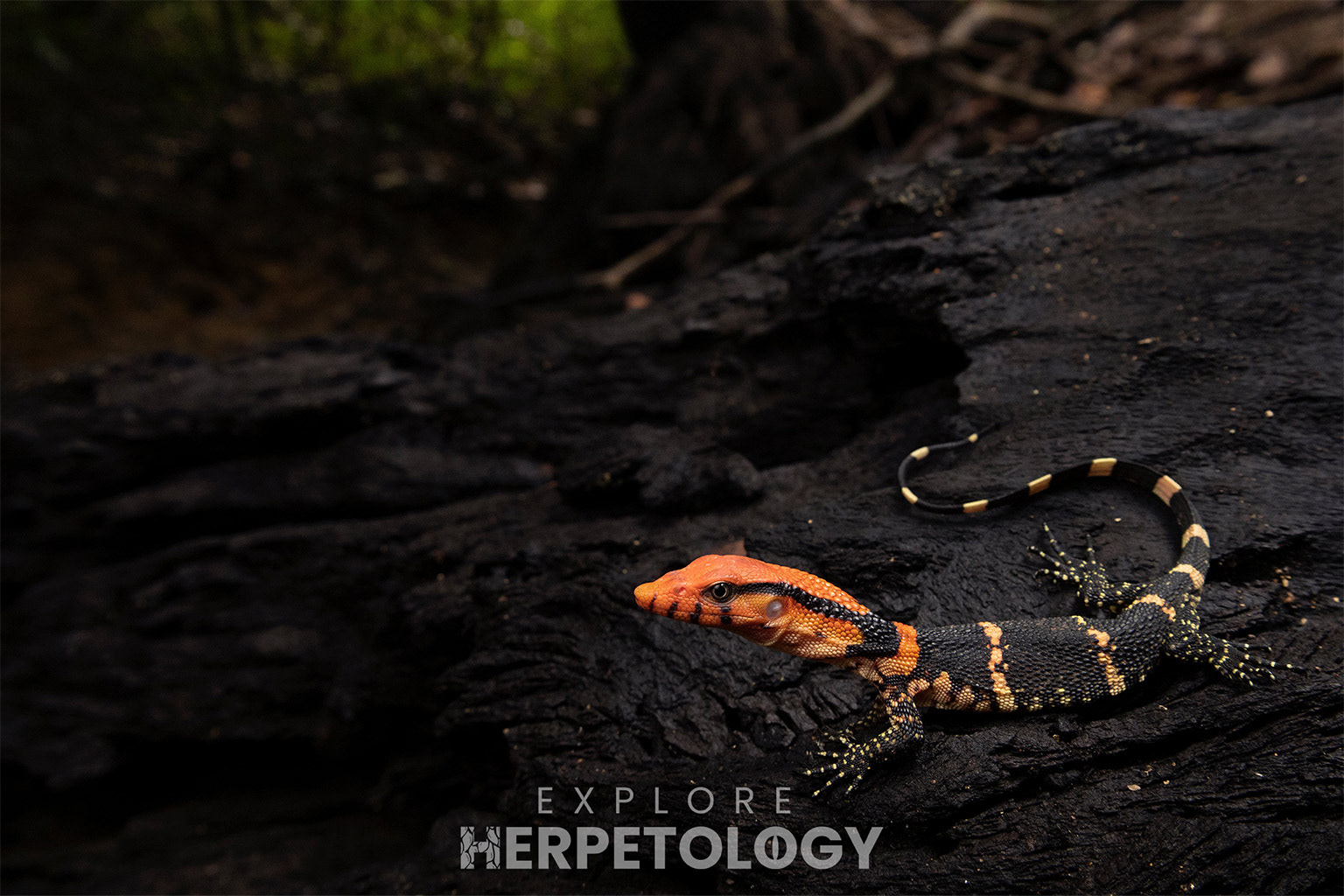
Juvenile Dumeril's monitor (Varanus dumerilii).
We did some more daytime herping around limestone karst formations after breakfast, hoping most of all for a cobra encounter. While we did not have any luck with cobras or kings, we did see an Indo-Chinese rat snake (Ptyas korros) and another large Ridley's cave racer (Elaphe taeniura ridley).
From here we drove out to a freshwater swamp forest bordering a large lake, where we hoped to find tentacled snake and any other homalopsid snakes we had not seen before. Tragically, the forest was almost totally dry and we couldn't find access to any suitable ponds or flooded areas which could have our target species. We still saw multiple mangrove cat snakes (Boiga melanota), a reticulated python (Malayopython reticulatus) and got hands on with several puff-faced water snakes (Homalopsis cf. buccatta), which was nice after being unable to catch all others seen before on the expedition.
Feeling deflated from a relatively unsuccessful night, a small group of us ventured back to the waterfall to hike for another 2 hours and see what we could find. Nothing showed up for a while, but then, all of a sudden, Rupert spotted a large, bright green snake lurking in the undergrowth. It turned out to be exactly what we wanted, an adult female Thai peninsula pit viper (Trimeresurus sabahi ssp. fucatus). This species is very uncommon in this part of Peninsula Thailand and our chances were slim, considering we had come to this waterfall many times in the past and only ever seen one single individual. This lucky find brought our total pit viper species seen to 8 (EIGHT!) on this epedition, surpassing all previous group expeditions to Southern Thailand. Moreover, it brought our total species of snake seen on the expedition to 47, equalling our best ever trip with one more day to go...
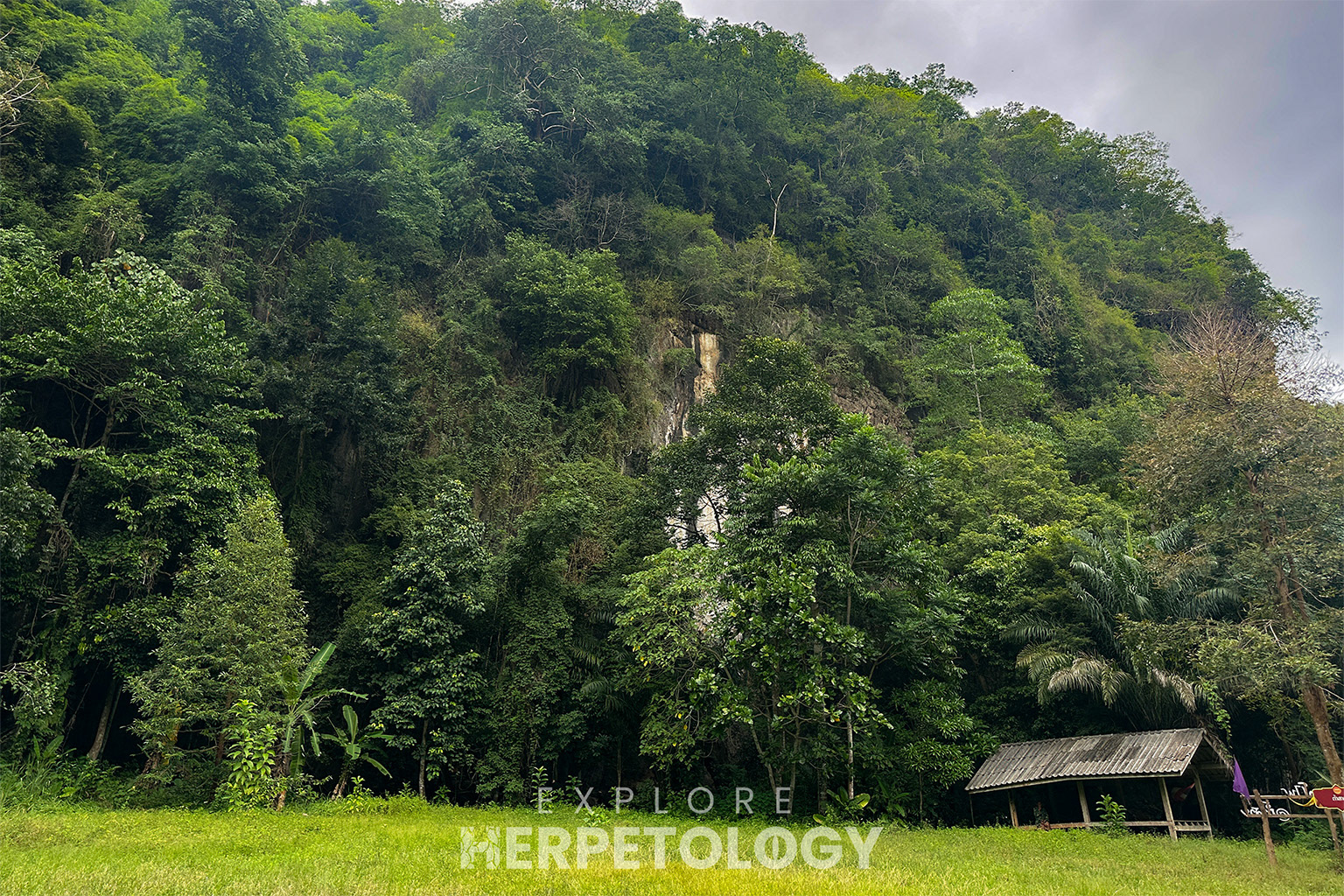
Limestone karst habitat in Phatthalung.
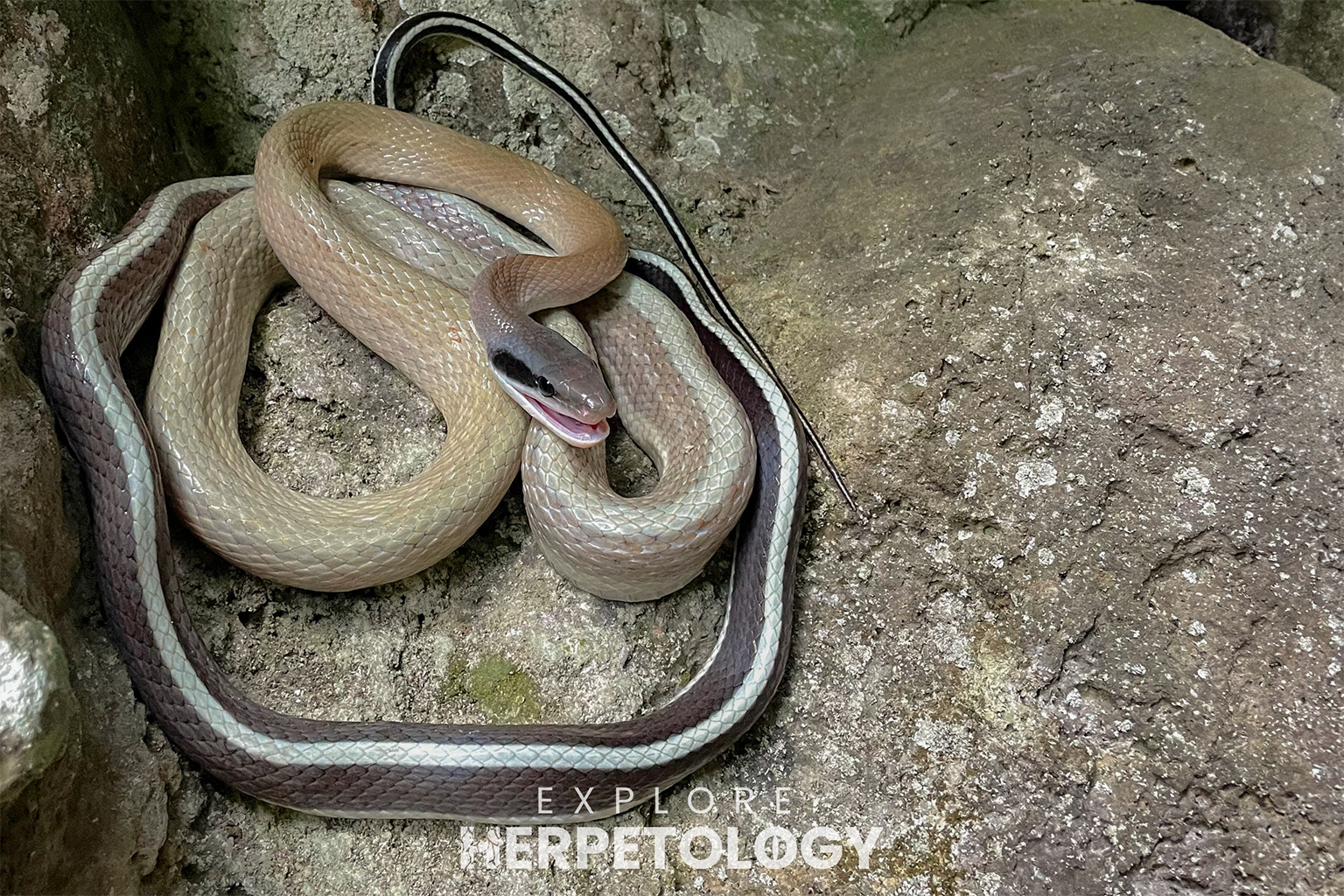
Ridley's cave racer (Elaphe taeniura ridleyi).
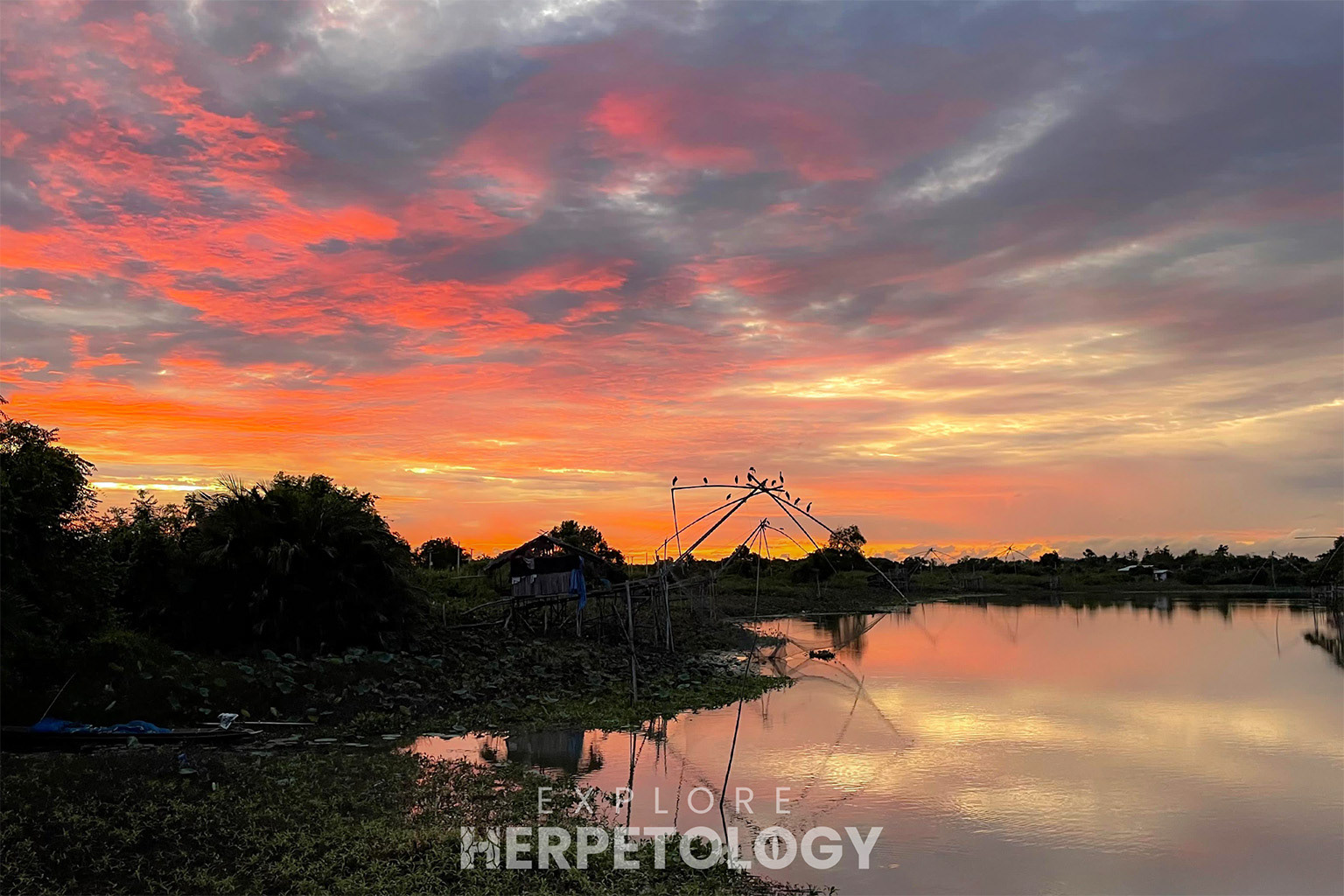
Sunset over Thale Noi.
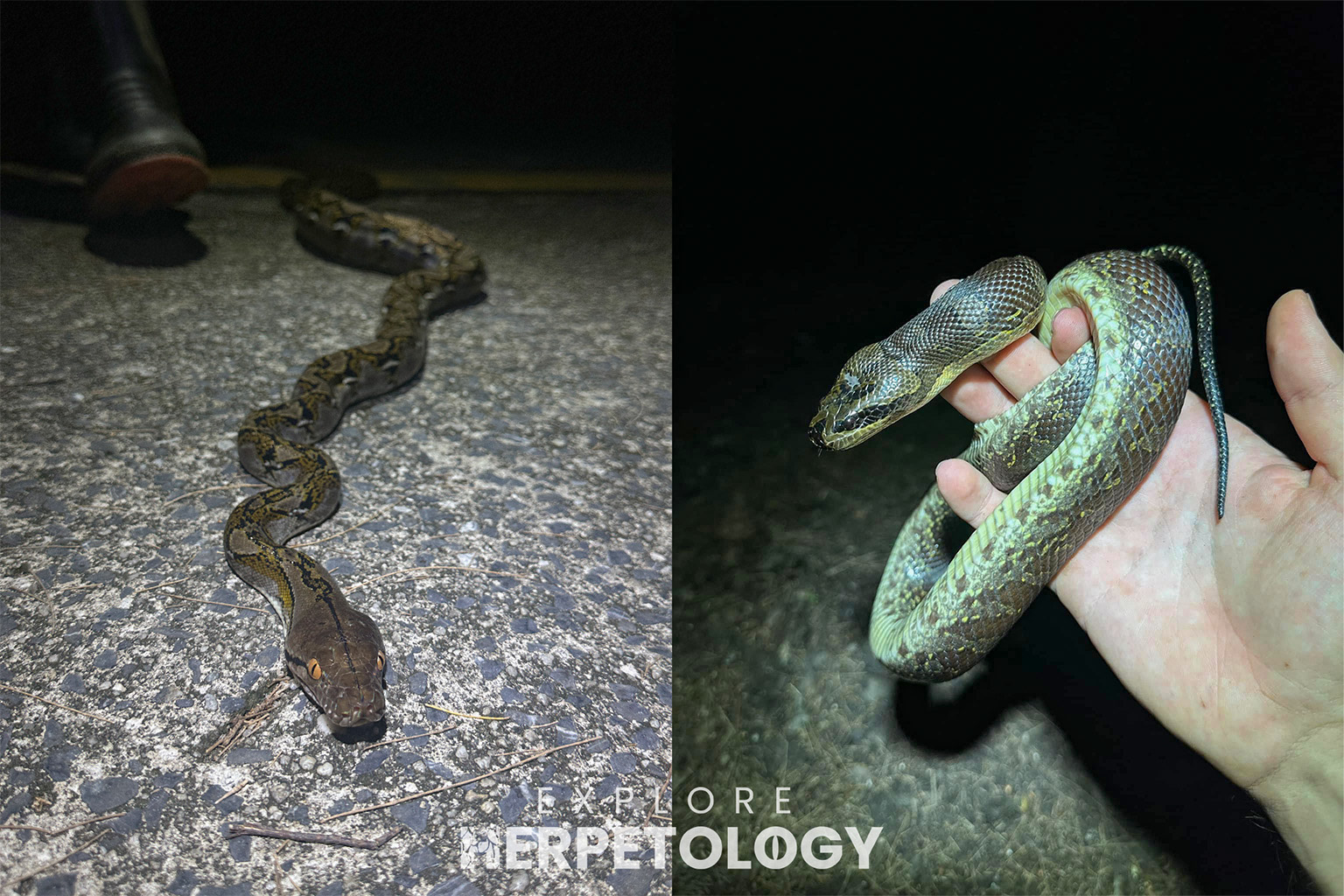
Left: Reticulated python. Right: Homalopsis cf. buccatta.
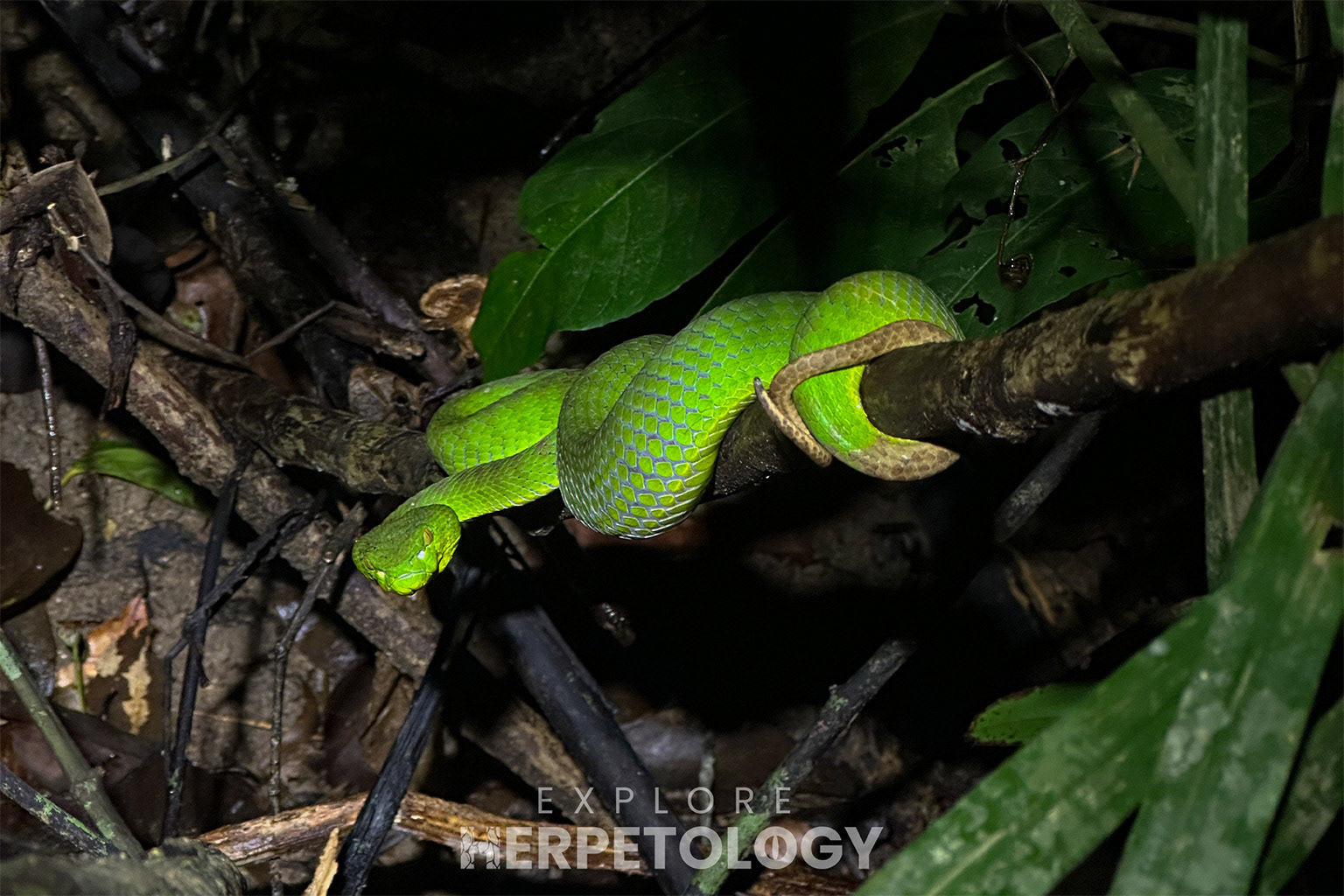
Thai peninsula pit viper (Trimeresurus sabahi ssp. fucatus) in-situ.
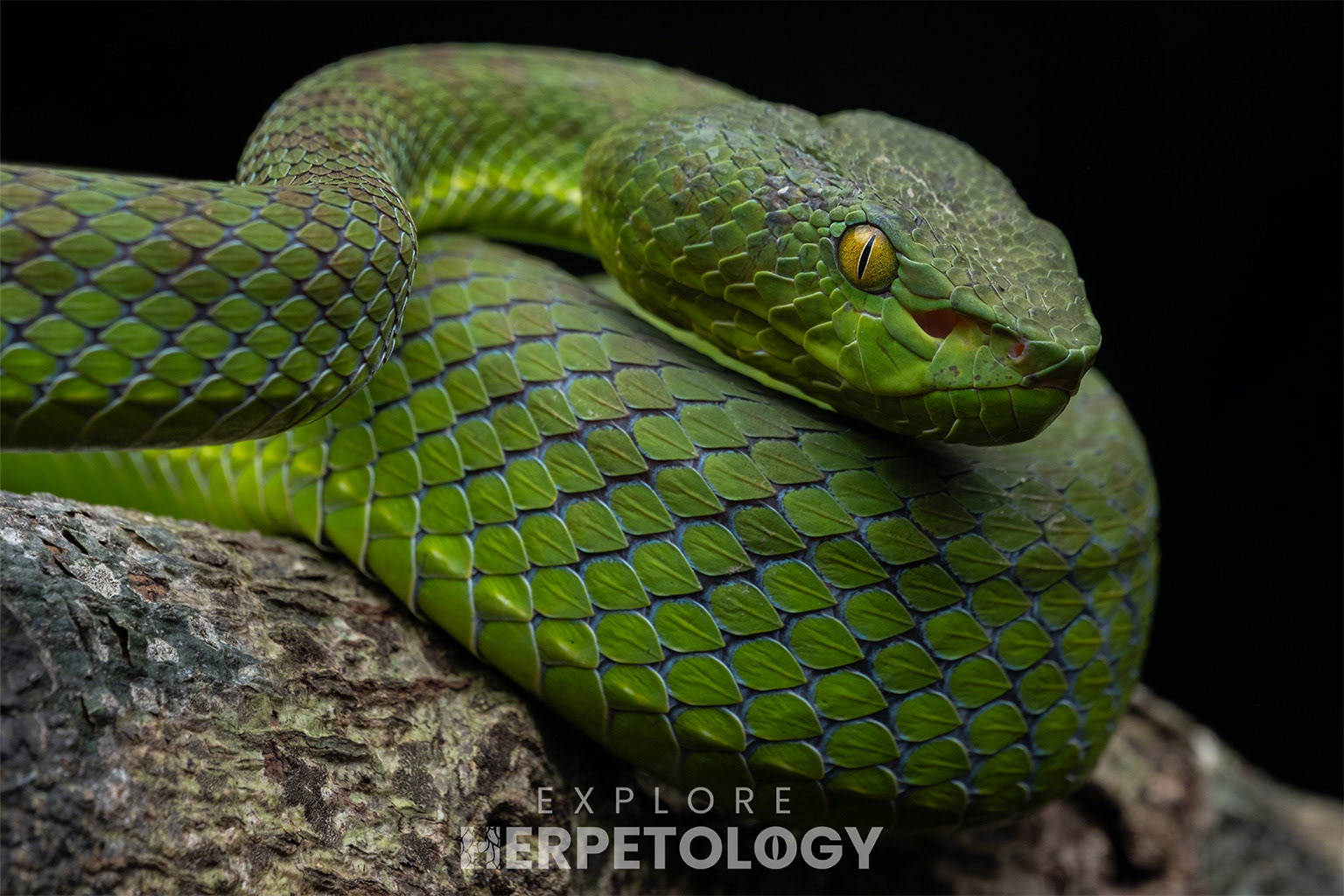
Thai peninsula pit viper (Trimeresurus sabahi ssp. fucatus) in-situ.
On the final day of the trip, we all agreed that our goal was to absolutely smash our species count record and hit 50 species of snake. However, to do this we would need 3 more species in-hand. This is not an easy feat when you have already seen 47 species. That said, there were still a small number of relatively common species which we had not seen all trip, so all we needed was a huge effort and a little luck.
We did not see any snakes during the daytime, but at nightfall finds start coming thick and fast. We found another huge mangrove cat snake (Boiga melanota), shortly followed by two back-to-back new species of snake - an adult dark-headed cat snake (Boiga nigriceps) and a striped bronzeback (Dendrelaphis caudolineatus). Many repeat species followed this, including another Thai-peninsula pit viper (Trimeresurus sabahi fucatus), as we searched as hard as possible at our most productive trails for that elusive 50th species of snake. As we were about to wrap up and go back to photograph our finds with the whole group, Rupert walked one final small trail and caught a blunt-headed slug snake (Aplopeltura boa), consummating a monumental 50 snake species expedition. Notably, this one night also broke our all-time record for "most snake species in a night" with an incredible 15 species encountered.
One last highlight was a pink-morph orchid mantis, which we had been hoping for all trip long and finally showed up right at the death. What an unbelievable way to end the trip!
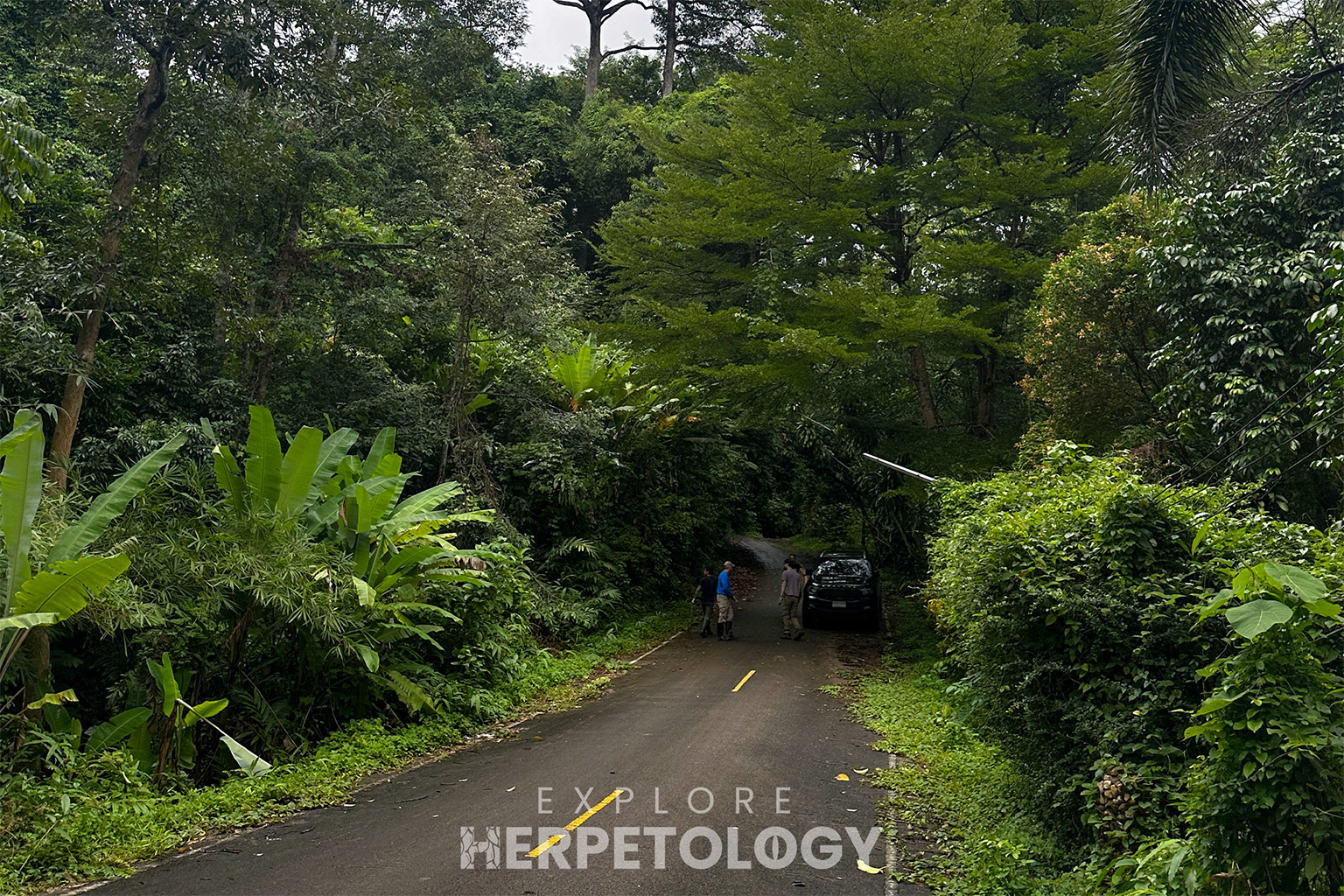
Daytime habitat.
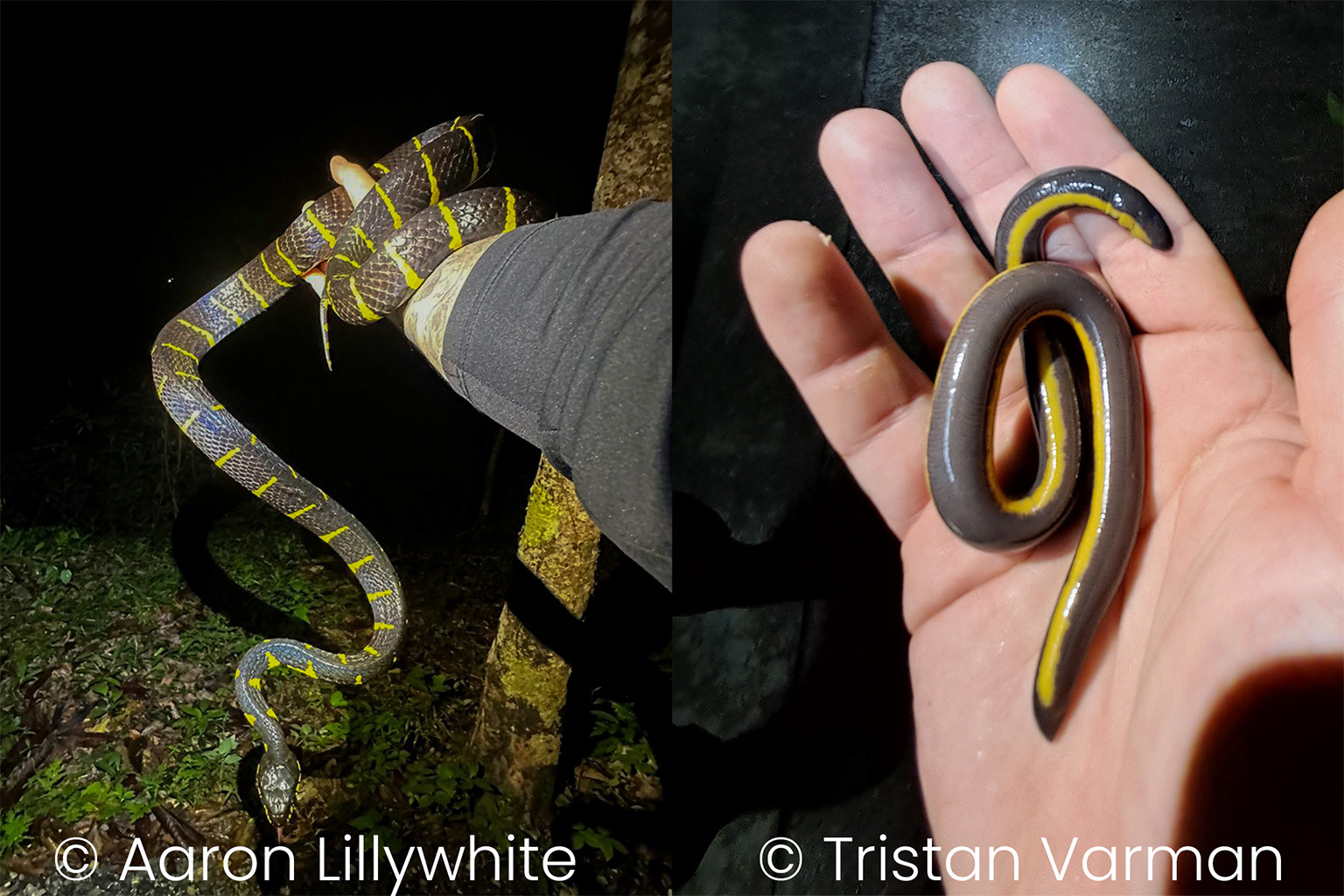
Left: Mangrove cat snake. Right: Caecilian (Ichthyophis sp.).
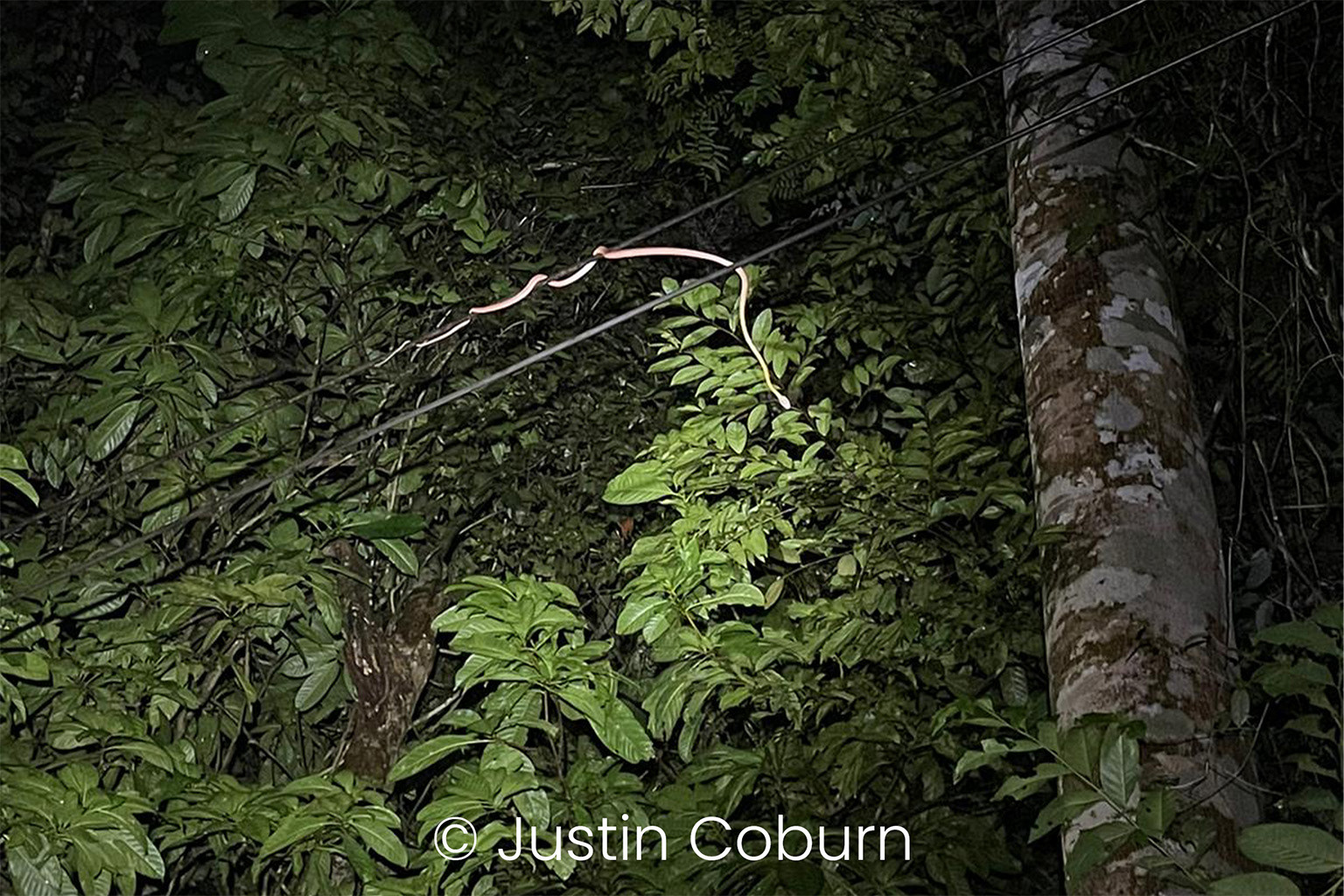
Boiga nigriceps in-situ.
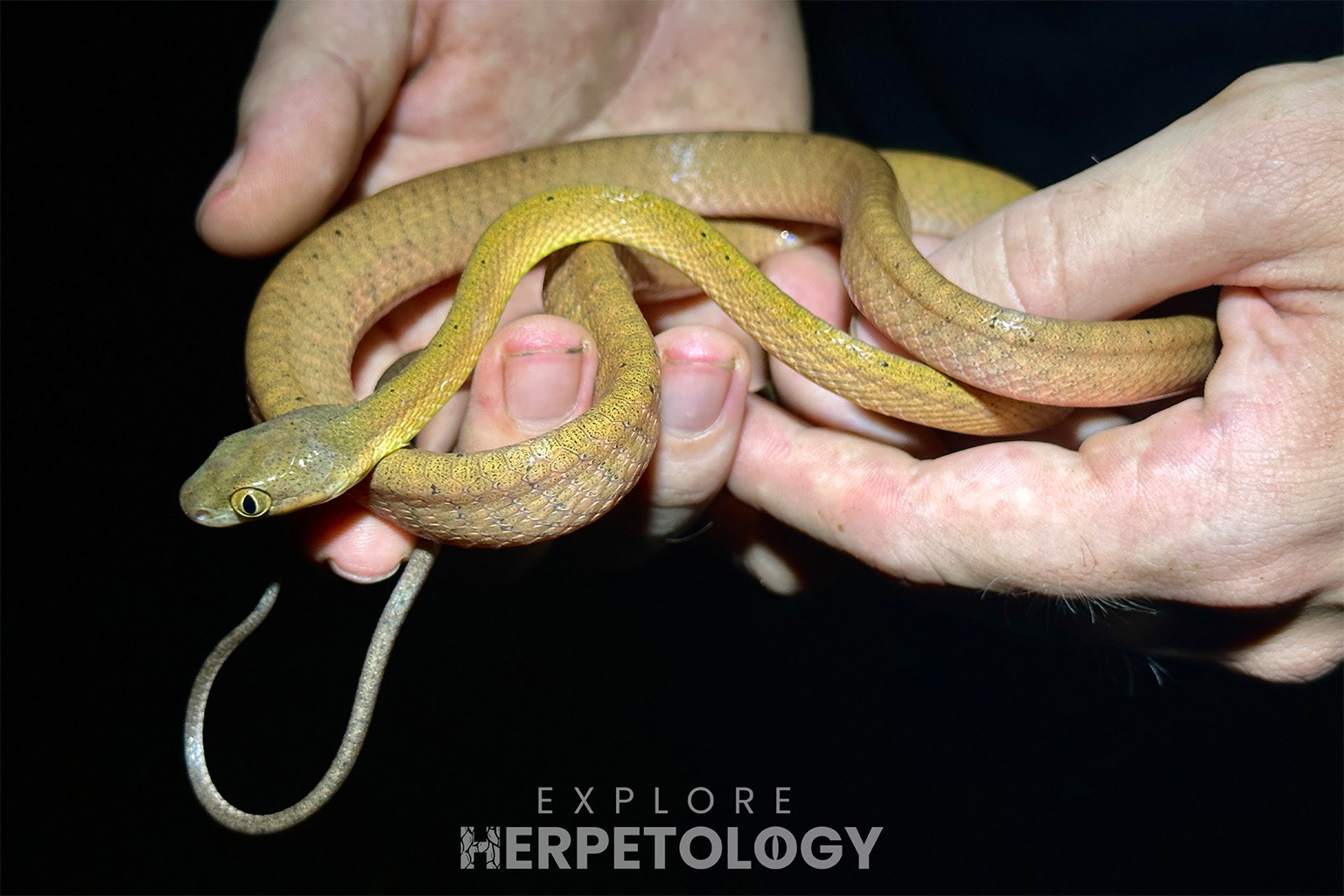
Dark-headed cat snake (Boiga nigriceps).
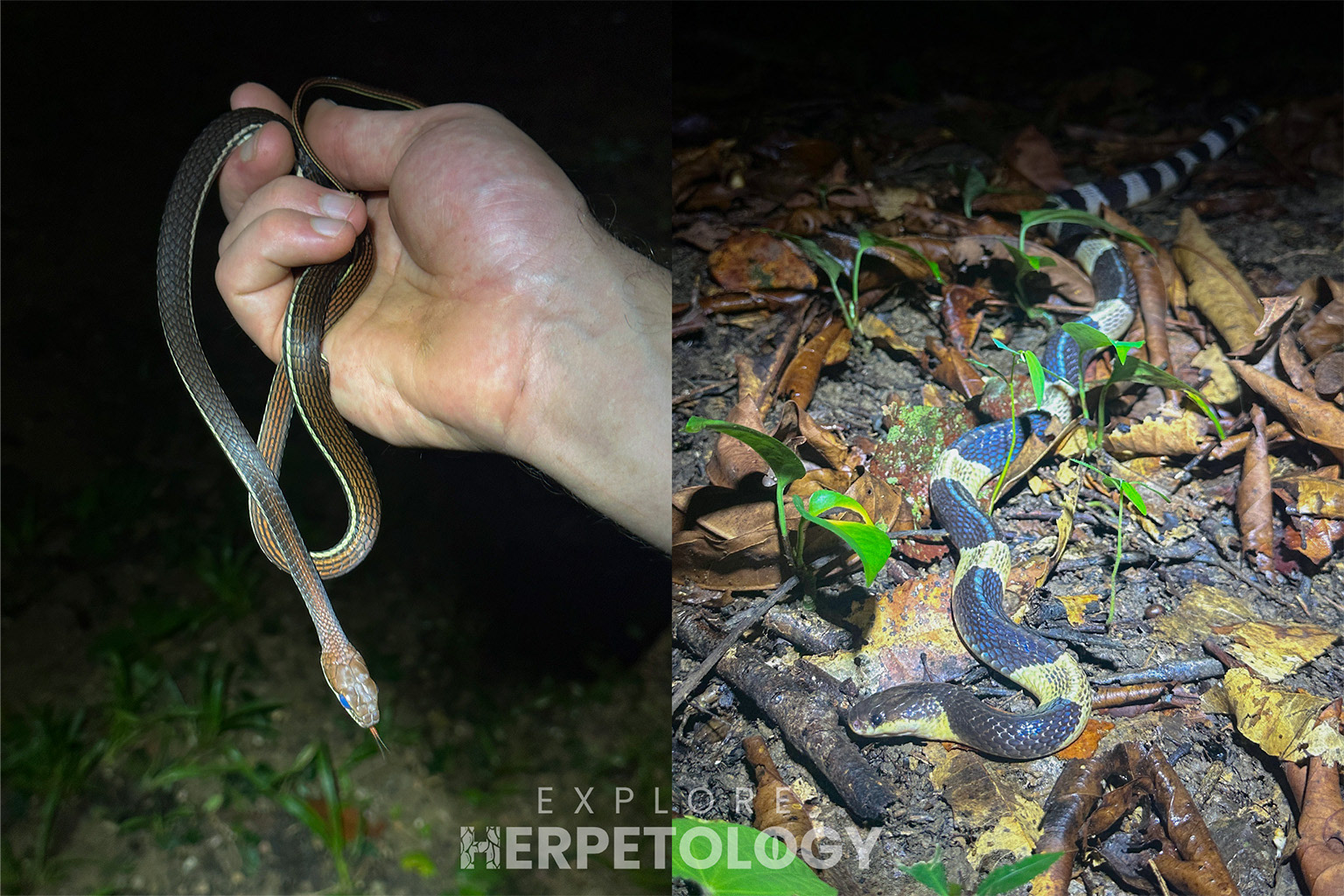
Left: Dendrelaphis caudolineatus. Right: Bungarus candidus.
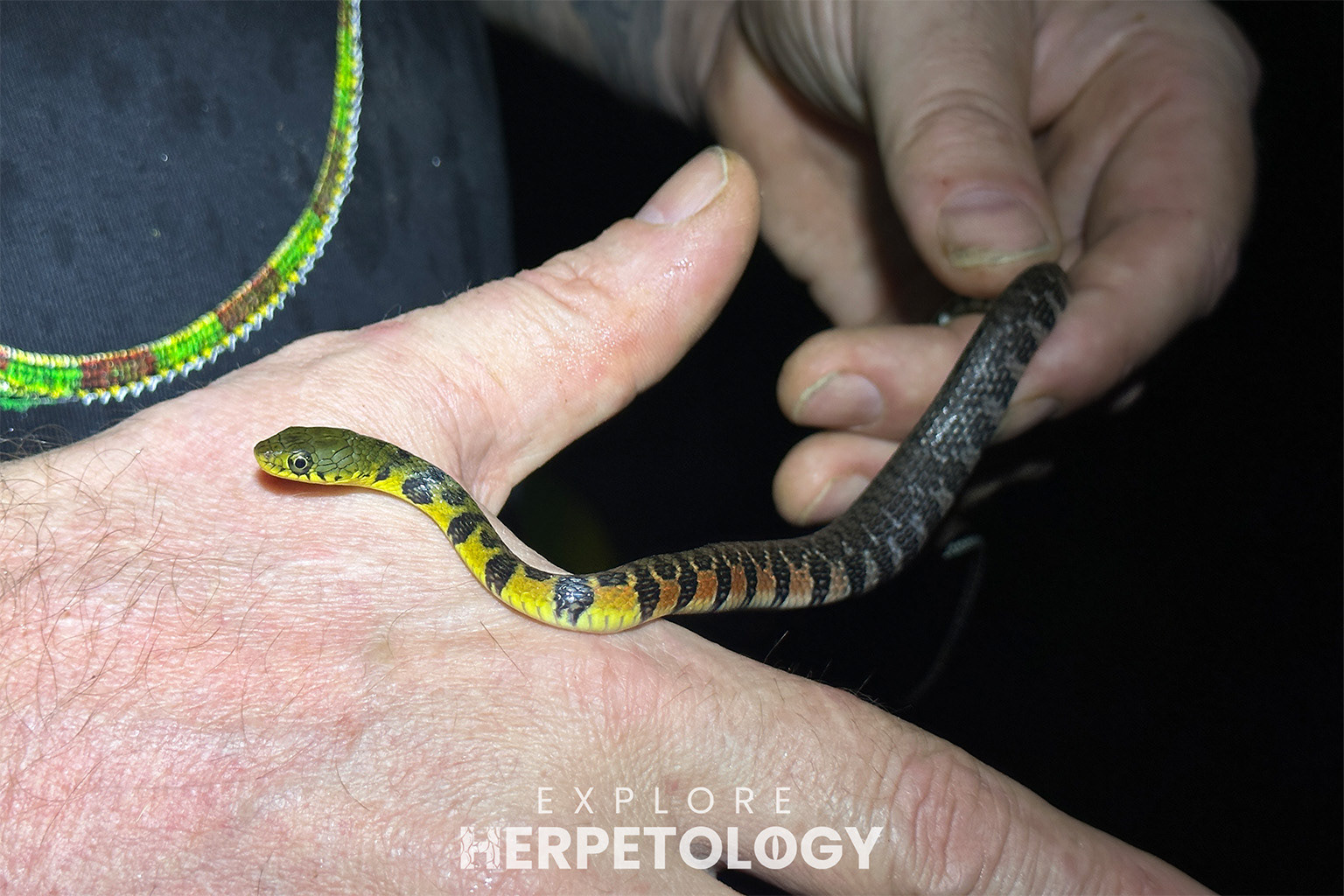
Triangle keelback (Xenochrophis trianguligerus).
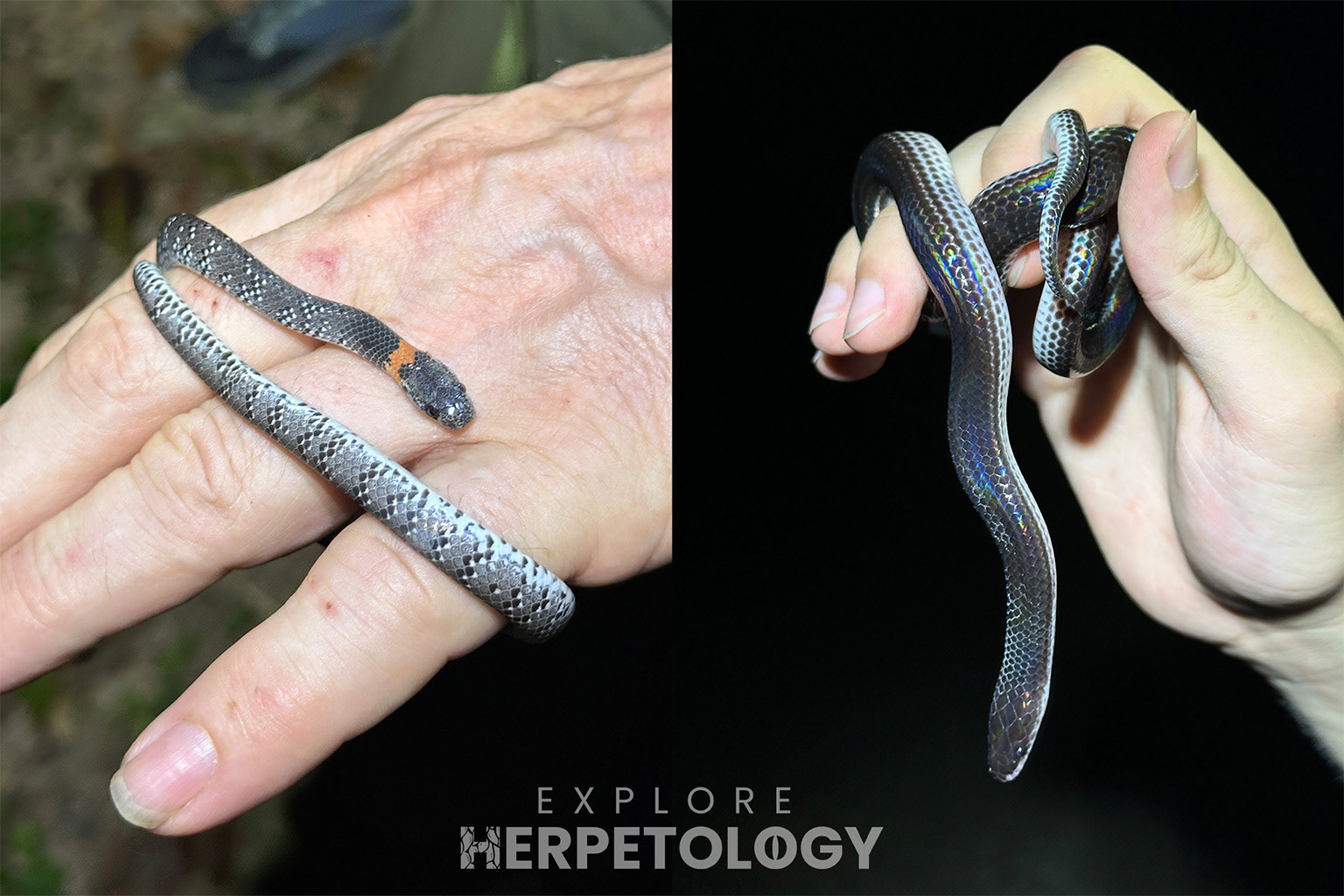
Left: White-spotted slug snake (Pareas margaritophorus). Right: Sunbeam snake (Xenopeltis unicolor).
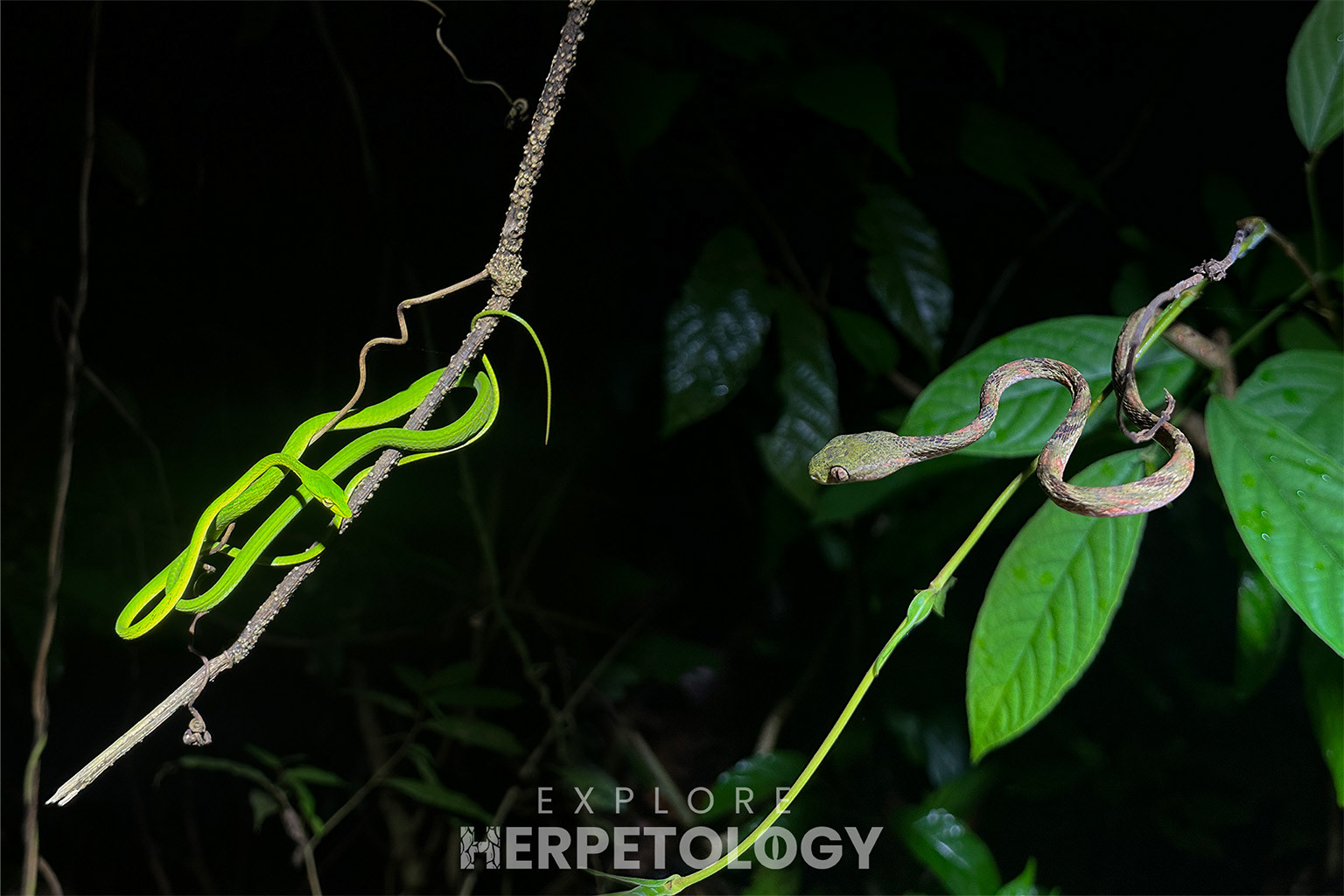
Left: Ahaetulla mycterizans. Right: Boiga bengkuluensis.

Indo-Chinese rat snake (Ptyas korros).
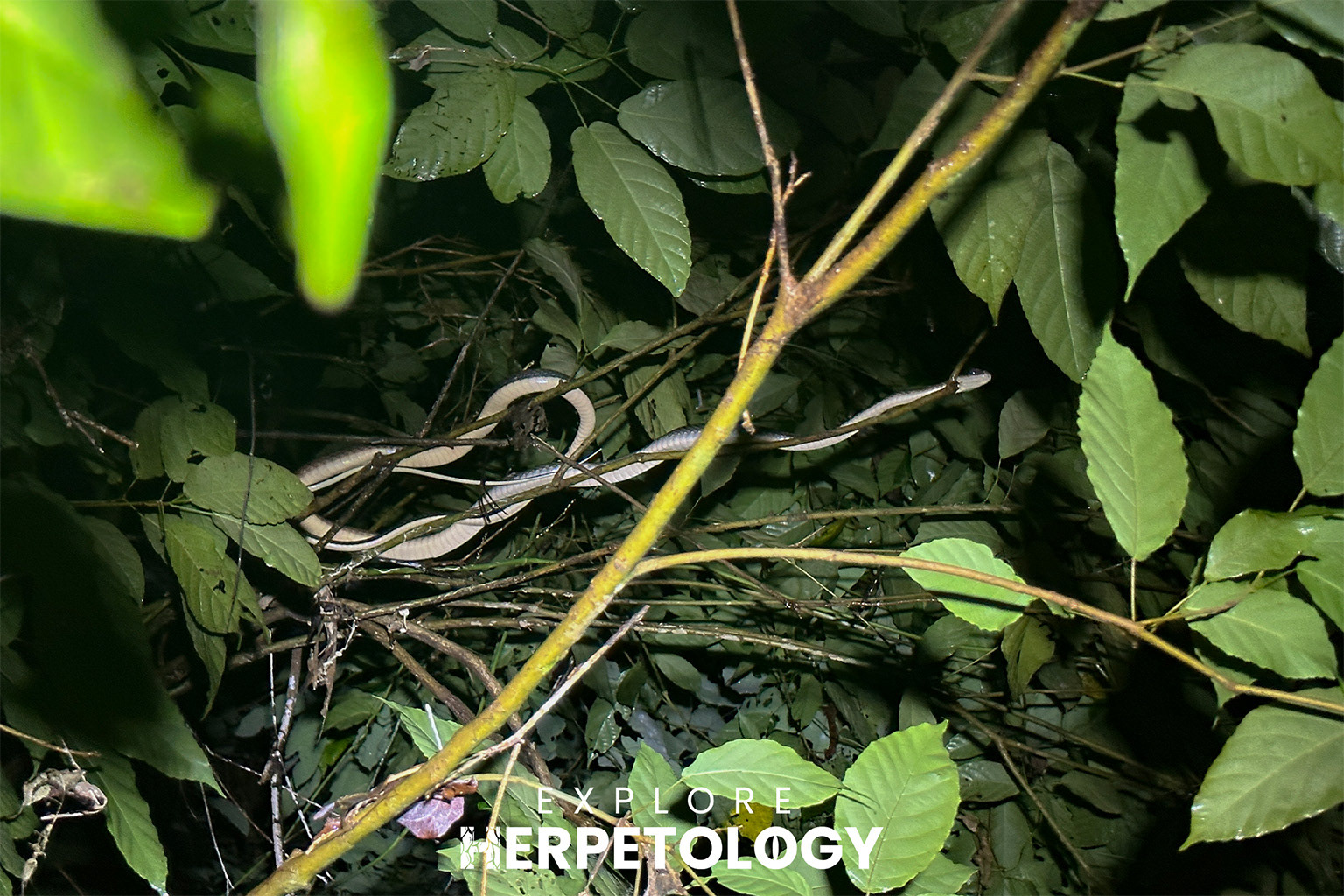
White-bellied rat snake (Ptyas fusca).
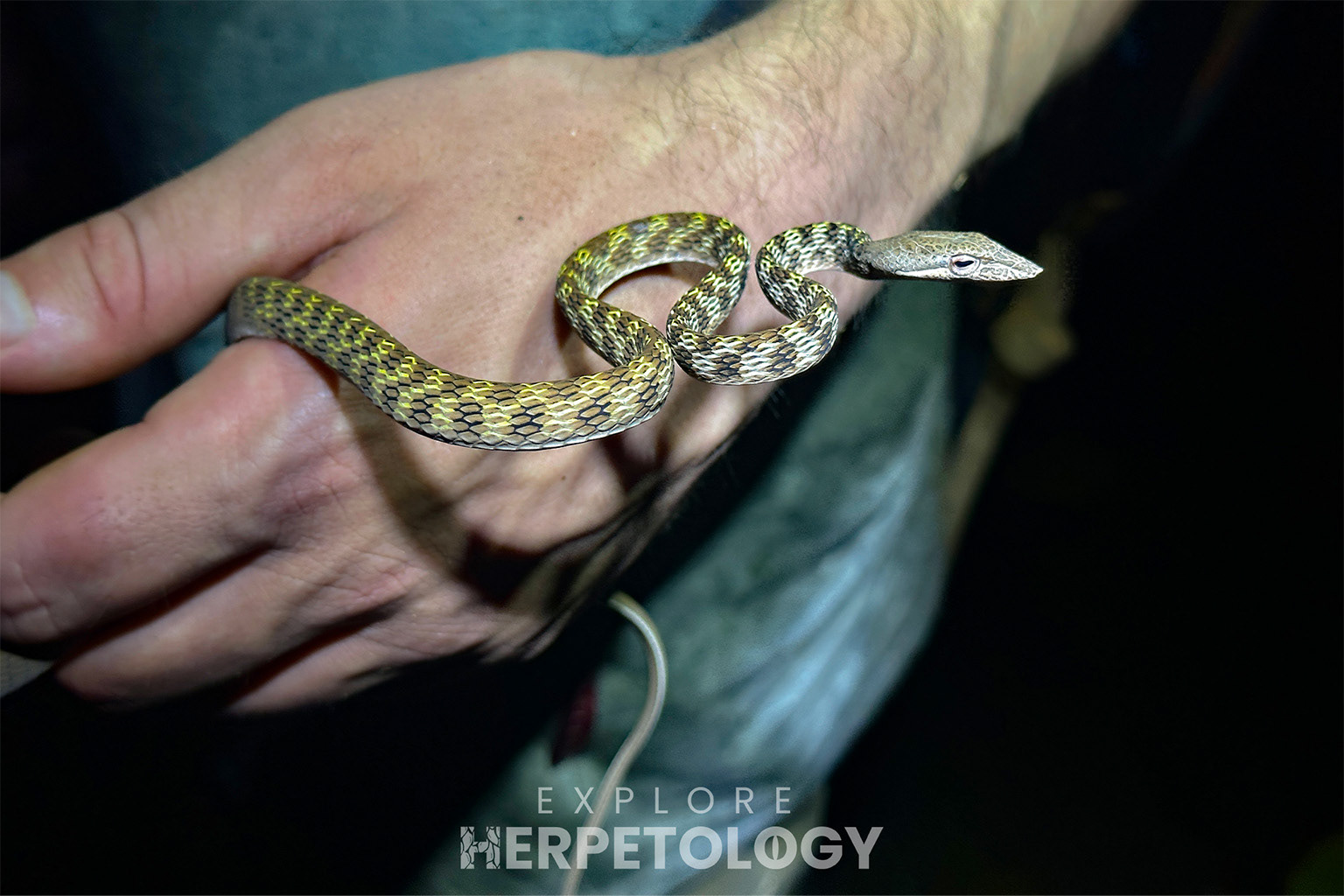
Speckle-headed vine snake (Ahaetulla fasciolata).
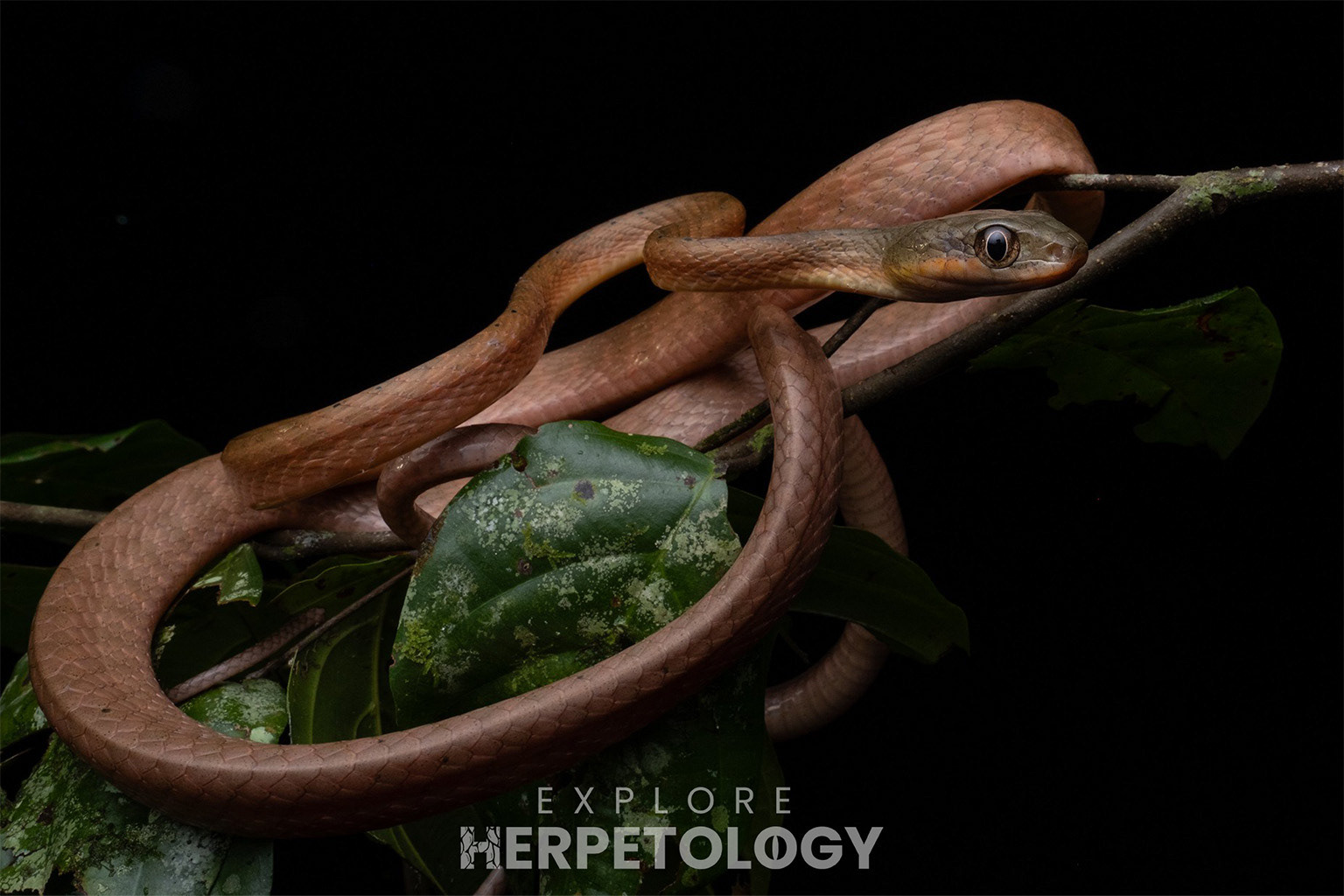
Dark-headed cat snake (Boiga nigriceps).
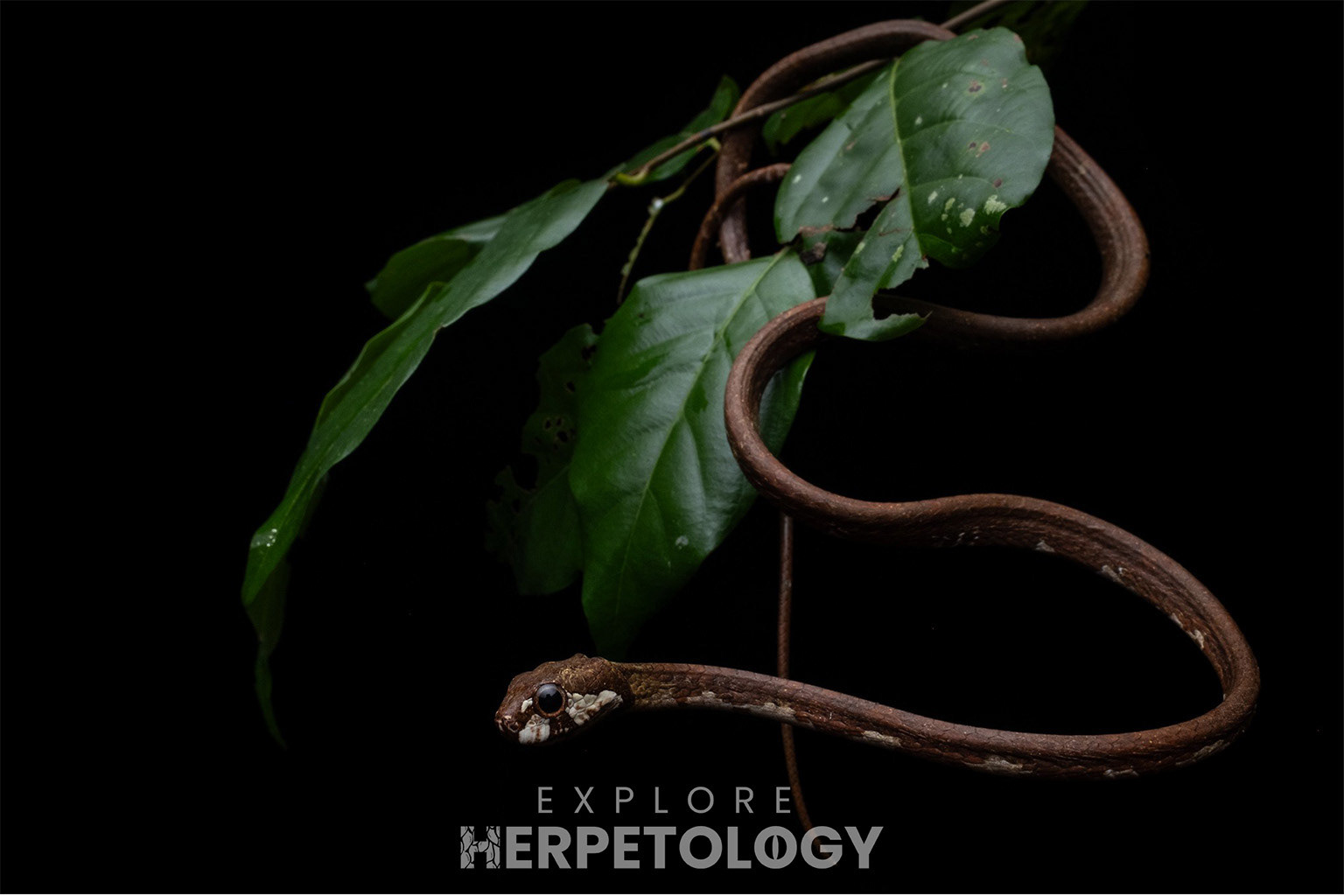
Blunt-headed slug snake (Aplopeltura boa).
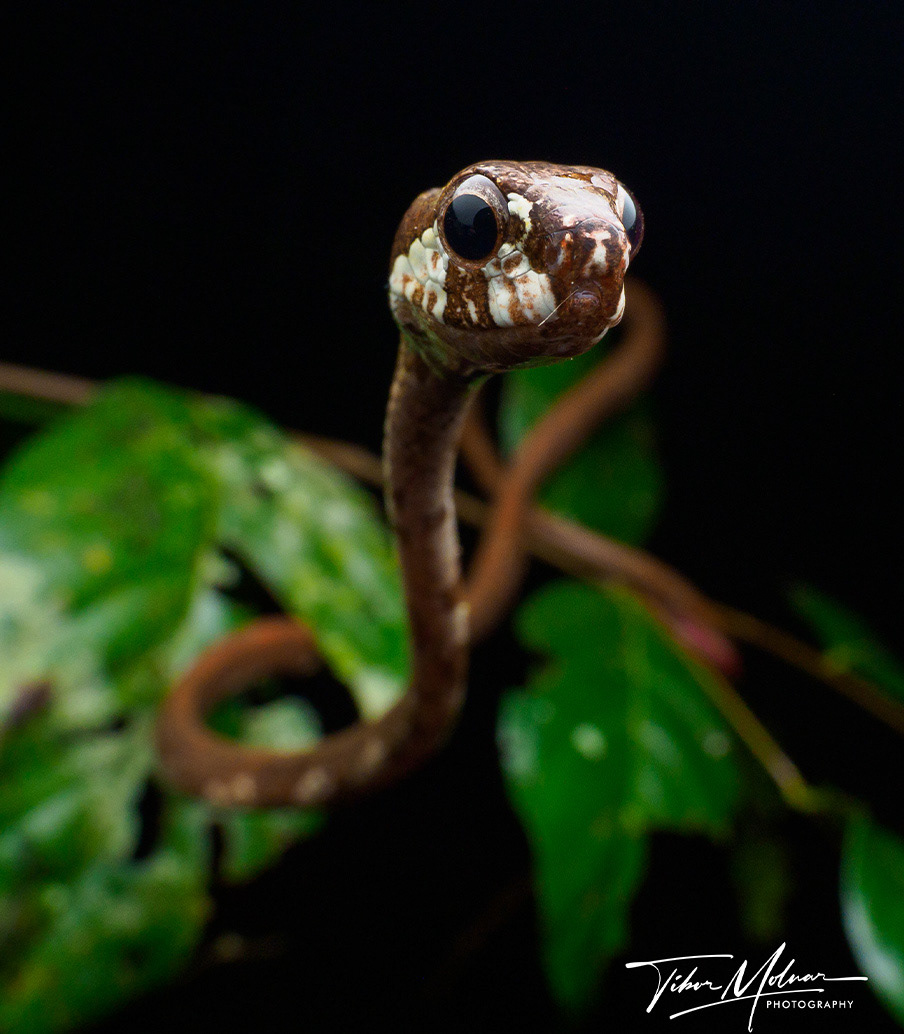
Blunt-headed slug snake (Aplopeltura boa)..
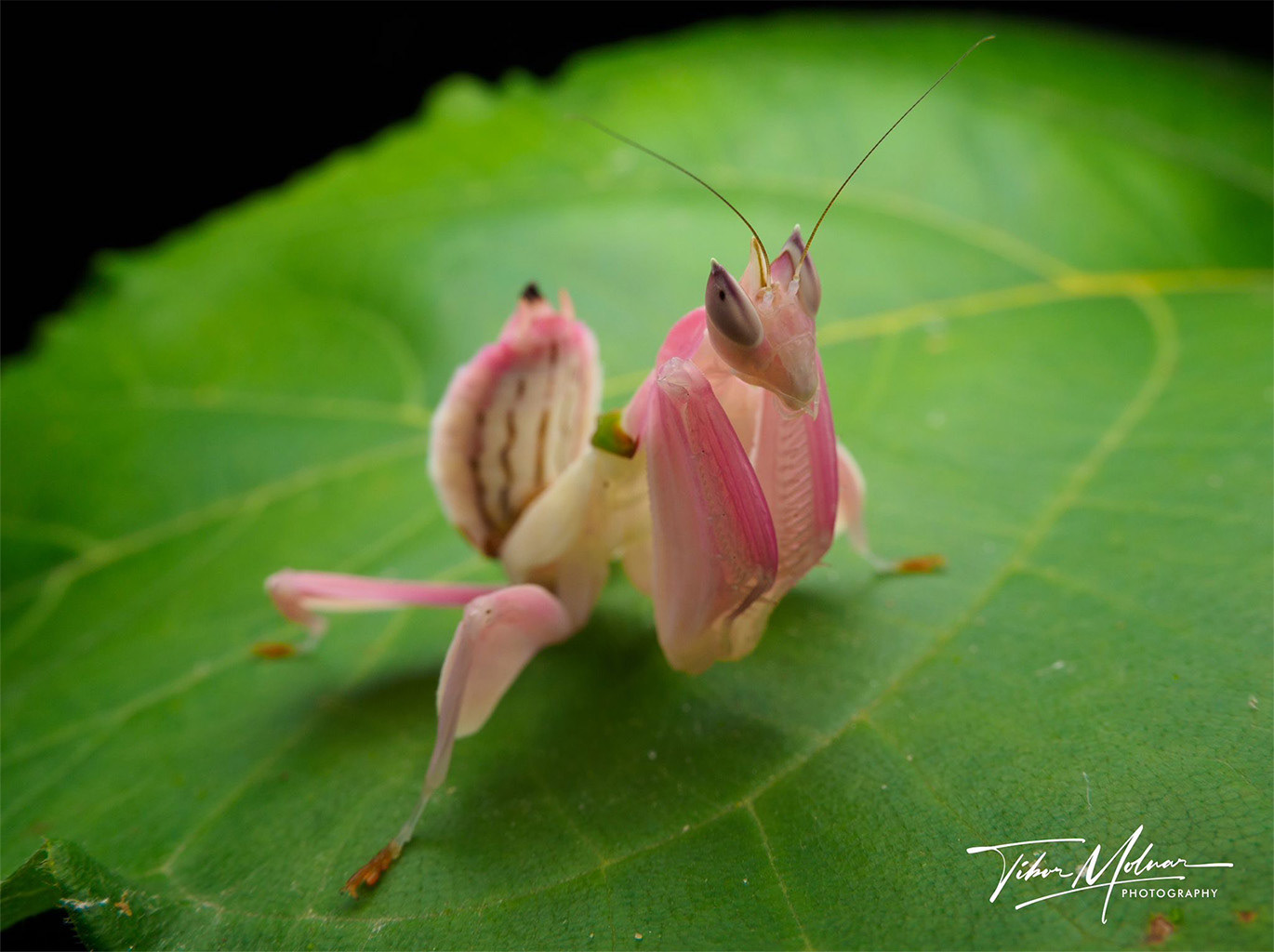
Orchid mantis (Hymenopus coronatus).
And thus concluded yet another wildly successful Explore Herpetology 'Expedition Thai Peninsula', with countless memorable moments, rare species, showstoppers and records broken along the way. We are extremely grateful for our guests and guides for contributing to such a remarkable achievement, and look forward to our next Expedition Thai Peninsula in July 2025. Book here!
Species list (snakes only):
Viperidae:
1. Phuket pit viper (Trimeresurus phuketensis) x7
2. Wagler's pit viper (Tropidolaemus wagleri) x8
3. Beautiful pit viper (Trimeresurus venustus) x5
4. Malayan pit viper (Calloselasma rhodostoma) x6
5. Hagen's pit viper (Trimeresurus hageni) x2
6. White-lipped pit viper (Trimeresurus albolabris) x2
7. Mangrove pit viper (Trimeresurus purpureomaculatus) x6
8. Thai peninsula pit viper (Trimeresurus sabahi ssp. cf. fucatus) x2
1. Phuket pit viper (Trimeresurus phuketensis) x7
2. Wagler's pit viper (Tropidolaemus wagleri) x8
3. Beautiful pit viper (Trimeresurus venustus) x5
4. Malayan pit viper (Calloselasma rhodostoma) x6
5. Hagen's pit viper (Trimeresurus hageni) x2
6. White-lipped pit viper (Trimeresurus albolabris) x2
7. Mangrove pit viper (Trimeresurus purpureomaculatus) x6
8. Thai peninsula pit viper (Trimeresurus sabahi ssp. cf. fucatus) x2
Elapidae:
9. Malayan krait (Bungarus candidus) x4
10. Red-headed krait (Bungarus flaviceps) x2
11. Small-spotted coral snake (Calliophis maculiceps) x1
12. Yellow-lipped sea krait (Laticauda colubrina) x20
9. Malayan krait (Bungarus candidus) x4
10. Red-headed krait (Bungarus flaviceps) x2
11. Small-spotted coral snake (Calliophis maculiceps) x1
12. Yellow-lipped sea krait (Laticauda colubrina) x20
Colubridae:
13. Blunt-headed slug snake (Aplopeltura boa) x1
14. Keeled slug snake (Pareas carinatus) x1
15. White-spotted slug snake (Pareas margaritophorus) x1
16. Ridley's cave racer (Elaphe taeniura ridleyi) x3
17. Malayan racer (Coelognathus flavolineatus) x1
18. Radiated rat snake (Coelognathus radiata) x1
19. Indo-Chinese rat snake (Ptyas korros) x6
20. White-bellied rats snake (Ptyas fusca) x3
21. Keeled rat snake (Ptyas carinata) x1
22. Purple kukri snake (Oligodon purpurascens) x1
23. Collared reed snake (Calamaria pavimentata) x1
24. Golden flying snake (Chrysopelea ornata ornatissima) x1
25. Paradise flying snake (Chrysopelea paradisi) x1
26. Laotian wolf snake (Lycodon laoensis) x3
27. Common wolf snake (Lycodon capucinus) x3
28. Malayan bridle snake (Lycodon subannulatus) x2
29. Davison's bridle snake (Lycodon davisonii) x2
30. Dog-toothed cat snake (Boiga cynodon) x1
31. Dark-headed cat snake (Boiga nigriceps) x3
32. White-spotted cat snake (Boiga drapiezii) x2
33. Bengkulu cat snake (Boiga bengkuluensis) x2
34. Mangrove cat snake (Boiga melanota) x5
35. Jasper cat snake (Boiga jaspidea) x1
36. Oriental vine snake (Ahaetulla prasina) x50+
37. Malayan vine snake (Ahaetulla mycterizans) x19
38. Speckle-headed vine snake (Ahaetulla fasciolata) x3
39. Elegant bronzeback (Dendrelapgis formosus) x1
40. Painted bronzeback (Dendrelaphis pictus) x3
41. Striped bronzeback (Dendrelaphis caudolineatus) x1
42. Striated bronzeback (Dendrelaphis striatus) x1
43. Speckle-bellied keelback (Rhabdophis chrysargos) x2
44. Black-barred keelback (Rhabdophis nigrocinctus) x2
45. Triangle keelback (Xenochrophis trianguligerus) x9
13. Blunt-headed slug snake (Aplopeltura boa) x1
14. Keeled slug snake (Pareas carinatus) x1
15. White-spotted slug snake (Pareas margaritophorus) x1
16. Ridley's cave racer (Elaphe taeniura ridleyi) x3
17. Malayan racer (Coelognathus flavolineatus) x1
18. Radiated rat snake (Coelognathus radiata) x1
19. Indo-Chinese rat snake (Ptyas korros) x6
20. White-bellied rats snake (Ptyas fusca) x3
21. Keeled rat snake (Ptyas carinata) x1
22. Purple kukri snake (Oligodon purpurascens) x1
23. Collared reed snake (Calamaria pavimentata) x1
24. Golden flying snake (Chrysopelea ornata ornatissima) x1
25. Paradise flying snake (Chrysopelea paradisi) x1
26. Laotian wolf snake (Lycodon laoensis) x3
27. Common wolf snake (Lycodon capucinus) x3
28. Malayan bridle snake (Lycodon subannulatus) x2
29. Davison's bridle snake (Lycodon davisonii) x2
30. Dog-toothed cat snake (Boiga cynodon) x1
31. Dark-headed cat snake (Boiga nigriceps) x3
32. White-spotted cat snake (Boiga drapiezii) x2
33. Bengkulu cat snake (Boiga bengkuluensis) x2
34. Mangrove cat snake (Boiga melanota) x5
35. Jasper cat snake (Boiga jaspidea) x1
36. Oriental vine snake (Ahaetulla prasina) x50+
37. Malayan vine snake (Ahaetulla mycterizans) x19
38. Speckle-headed vine snake (Ahaetulla fasciolata) x3
39. Elegant bronzeback (Dendrelapgis formosus) x1
40. Painted bronzeback (Dendrelaphis pictus) x3
41. Striped bronzeback (Dendrelaphis caudolineatus) x1
42. Striated bronzeback (Dendrelaphis striatus) x1
43. Speckle-bellied keelback (Rhabdophis chrysargos) x2
44. Black-barred keelback (Rhabdophis nigrocinctus) x2
45. Triangle keelback (Xenochrophis trianguligerus) x9
Pythonidae:
46. Reticulated python (Malayopython reticulatus) x2
47. Blood python (Python brongersmai) x1
46. Reticulated python (Malayopython reticulatus) x2
47. Blood python (Python brongersmai) x1
Xenopeltidae:
48. Sunbeam snake (Xenopeltis unicolor) x2
48. Sunbeam snake (Xenopeltis unicolor) x2
Acrochordidae:
49. Marine file snake (Acrochordus granulatus) x11
49. Marine file snake (Acrochordus granulatus) x11
Homalopsidae:
50. Puff-faced water snake (Homalopsis cf. buccatta) x10
228 snakes total.
50. Puff-faced water snake (Homalopsis cf. buccatta) x10
228 snakes total.


